
Exhibit 96.8 P a g e 1 | 113 Goldfields.com Technical Report Summary of Mineral reserves and Mineral resources 31 December 2022 For Gold Fields Limited – Cerro Corona Copper and Gold Mine – Peru
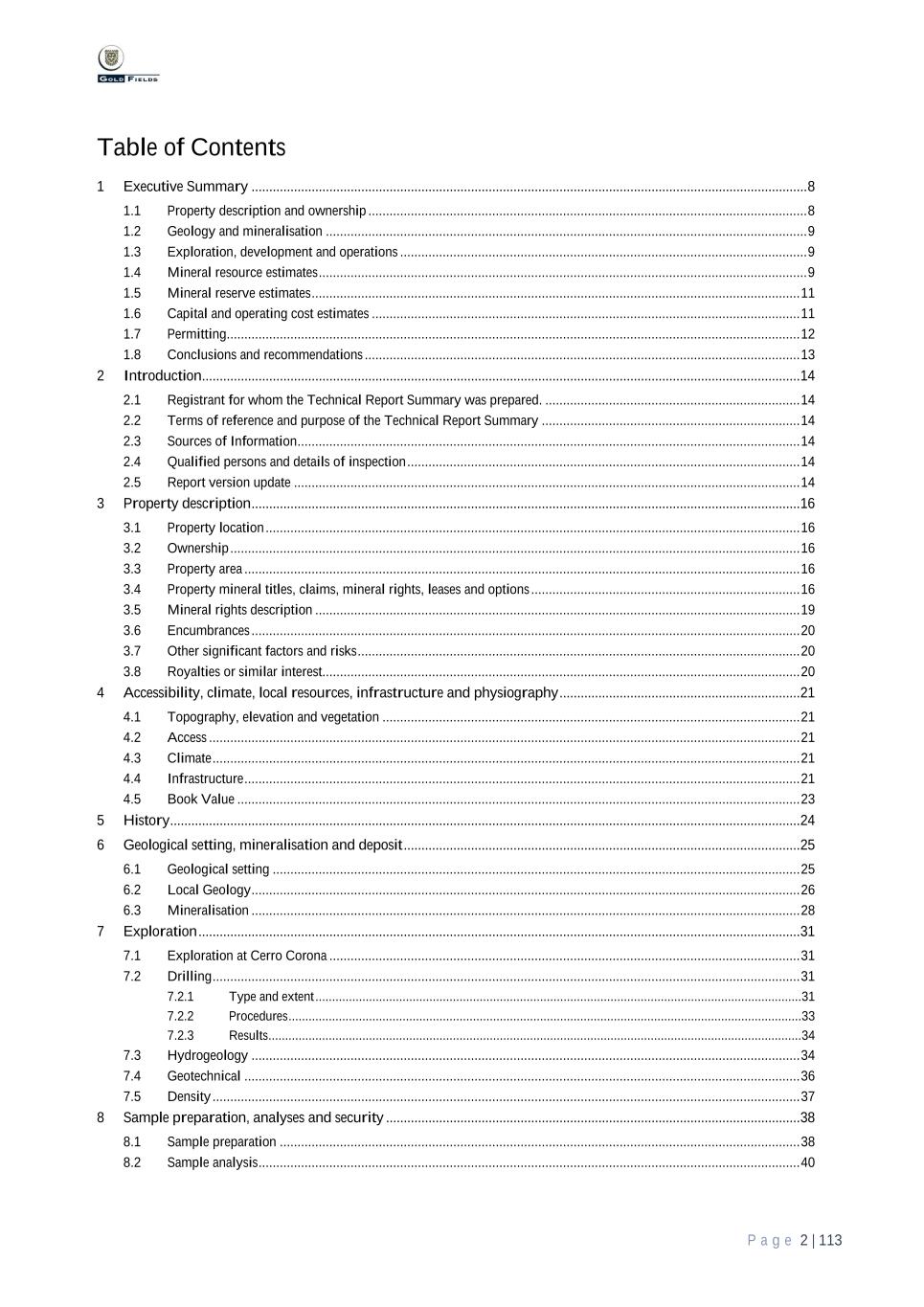
P a g e 2 | 113 Table of Contents 1 Executive Summary ............................................................................................................................................................. 8 1.1 Property description and ownership ............................................................................................................................ 8 1.2 Geology and mineralisation ........................................................................................................................................ 9 1.3 Exploration, development and operations ................................................................................................................... 9 1.4 Mineral resource estimates .......................................................................................................................................... 9 1.5 Mineral reserve estimates .......................................................................................................................................... 11 1.6 Capital and operating cost estimates ......................................................................................................................... 11 1.7 Permitting .................................................................................................................................................................. 12 1.8 Conclusions and recommendations ........................................................................................................................... 13 2 Introduction......................................................................................................................................................................... 14 2.1 Registrant for whom the Technical Report Summary was prepared. ........................................................................ 14 2.2 Terms of reference and purpose of the Technical Report Summary ......................................................................... 14 2.3 Sources of Information .............................................................................................................................................. 14 2.4 Qualified persons and details of inspection ............................................................................................................... 14 2.5 Report version update ............................................................................................................................................... 14 3 Property description ........................................................................................................................................................... 16 3.1 Property location ....................................................................................................................................................... 16 3.2 Ownership ................................................................................................................................................................. 16 3.3 Property area ............................................................................................................................................................. 16 3.4 Property mineral titles, claims, mineral rights, leases and options ............................................................................ 16 3.5 Mineral rights description ......................................................................................................................................... 19 3.6 Encumbrances ........................................................................................................................................................... 20 3.7 Other significant factors and risks ............................................................................................................................. 20 3.8 Royalties or similar interest....................................................................................................................................... 20 4 Accessibility, climate, local resources, infrastructure and physiography .................................................................... 21 4.1 Topography, elevation and vegetation ...................................................................................................................... 21 4.2 Access ....................................................................................................................................................................... 21 4.3 Climate ...................................................................................................................................................................... 21 4.4 Infrastructure ............................................................................................................................................................. 21 4.5 Book Value ............................................................................................................................................................... 23 5 History .................................................................................................................................................................................. 24 6 Geological setting, mineralisation and deposit ................................................................................................................ 25 6.1 Geological setting ..................................................................................................................................................... 25 6.2 Local Geology ........................................................................................................................................................... 26 6.3 Mineralisation ........................................................................................................................................................... 28 7 Exploration .......................................................................................................................................................................... 31 7.1 Exploration at Cerro Corona ..................................................................................................................................... 31 7.2 Drilling ...................................................................................................................................................................... 31 7.2.1 Type and extent ................................................................................................................................................. 31 7.2.2 Procedures ......................................................................................................................................................... 33 7.2.3 Results ............................................................................................................................................................... 34 7.3 Hydrogeology ........................................................................................................................................................... 34 7.4 Geotechnical ............................................................................................................................................................. 36 7.5 Density ...................................................................................................................................................................... 37 8 Sample preparation, analyses and security ..................................................................................................................... 38 8.1 Sample preparation ................................................................................................................................................... 38 8.2 Sample analysis ......................................................................................................................................................... 40

P a g e 3 | 113 8.3 Quality control and quality assurance (QA/QC) ....................................................................................................... 41 9 Data verification ................................................................................................................................................................. 43 9.1 Drilling and sampling ................................................................................................................................................ 43 9.2 Data management ...................................................................................................................................................... 43 10 Mineral processing and metallurgical testing ................................................................................................................. 45 10.1 Testing and procedures ............................................................................................................................................. 45 10.1.1 Background ....................................................................................................................................................... 45 10.1.2 Original feasibility studies ................................................................................................................................ 45 10.1.3 Production control sampling ............................................................................................................................. 45 10.2 Plant sampling and reconciliation ............................................................................................................................. 46 10.3 Relevant results ......................................................................................................................................................... 46 10.3.1 Sample head analyses and mineralogy .............................................................................................................. 46 10.3.2 Metallurgical recoveries .................................................................................................................................... 47 10.3.3 Ore hardness / mill throughput .......................................................................................................................... 50 10.4 Plant Results.............................................................................................................................................................. 52 10.5 Deleterious elements ................................................................................................................................................. 52 10.6 Metallurgical risks ..................................................................................................................................................... 52 11 Mineral resource estimates ................................................................................................................................................ 53 11.1 Mineral resource estimation criteria .......................................................................................................................... 53 11.1.1 Geological database .......................................................................................................................................... 53 11.1.2 Core recovery .................................................................................................................................................... 53 11.1.3 Domain classification ........................................................................................................................................ 53 11.1.4 Geological modelling ........................................................................................................................................ 53 11.1.5 Assay compositing ............................................................................................................................................ 53 11.1.6 Evaluation of outliers ........................................................................................................................................ 53 11.1.7 Variography ...................................................................................................................................................... 54 11.1.8 Selective mining units ....................................................................................................................................... 54 11.1.9 Grade estimation ............................................................................................................................................... 54 11.1.10 Model validation ............................................................................................................................................... 55 11.1.11 Cutoff grades ..................................................................................................................................................... 56 11.1.12 Reasonable prospects of economic extraction ................................................................................................... 57 11.1.13 Classification criteria ........................................................................................................................................ 57 11.2 Mineral resources as of 31 December 2022 .............................................................................................................. 57 11.3 Basis for establishing the prospects of economic extraction for Mineral resources .................................................. 59 11.4 Audits and reviews .................................................................................................................................................... 59 11.5 Comparison with 31 December 2021 to 31 December 2022 Mineral resource ......................................................... 59 12 Mineral reserve estimates .................................................................................................................................................. 60 12.1 Level of assessment .................................................................................................................................................. 60 12.2 Mineral reserve estimation criteria ............................................................................................................................ 61 12.2.1 Recent mine performance .................................................................................................................................. 61 12.2.2 Key assumptions and parameters ...................................................................................................................... 62 12.2.3 Cutoff grades ..................................................................................................................................................... 62 12.2.4 Mine design ....................................................................................................................................................... 63 12.2.5 Mining schedule ................................................................................................................................................ 63 12.2.6 Classification criteria ........................................................................................................................................ 64 12.2.7 Economic assessment ........................................................................................................................................ 64 12.3 Mineral reserves as of 31 December 2022 ................................................................................................................ 64 12.4 Audits and reviews .................................................................................................................................................... 65 12.5 Comparison December 2022 with 31 December 2021 Mineral reserve .................................................................... 65 13 Mining Methods .................................................................................................................................................................. 67 13.1 Methods .................................................................................................................................................................... 67
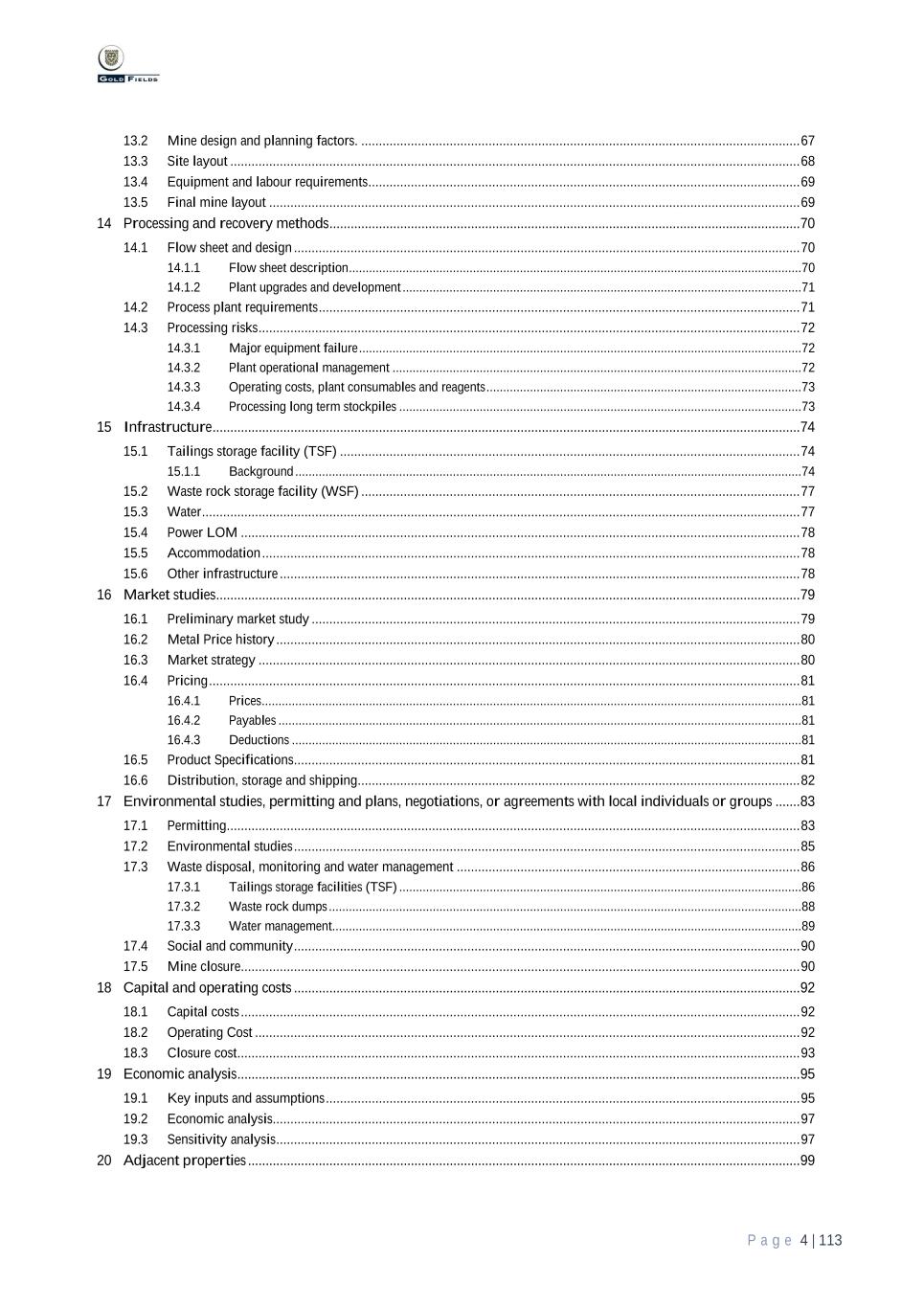
P a g e 4 | 113 13.2 Mine design and planning factors. ............................................................................................................................ 67 13.3 Site layout ................................................................................................................................................................. 68 13.4 Equipment and labour requirements .......................................................................................................................... 69 13.5 Final mine layout ...................................................................................................................................................... 69 14 Processing and recovery methods ..................................................................................................................................... 70 14.1 Flow sheet and design ............................................................................................................................................... 70 14.1.1 Flow sheet description ....................................................................................................................................... 70 14.1.2 Plant upgrades and development ....................................................................................................................... 71 14.2 Process plant requirements ........................................................................................................................................ 71 14.3 Processing risks ......................................................................................................................................................... 72 14.3.1 Major equipment failure .................................................................................................................................... 72 14.3.2 Plant operational management .......................................................................................................................... 72 14.3.3 Operating costs, plant consumables and reagents .............................................................................................. 73 14.3.4 Processing long term stockpiles ........................................................................................................................ 73 15 Infrastructure ...................................................................................................................................................................... 74 15.1 Tailings storage facility (TSF) .................................................................................................................................. 74 15.1.1 Background ....................................................................................................................................................... 74 15.2 Waste rock storage facility (WSF) ............................................................................................................................ 77 15.3 Water ......................................................................................................................................................................... 77 15.4 Power LOM .............................................................................................................................................................. 78 15.5 Accommodation ........................................................................................................................................................ 78 15.6 Other infrastructure ................................................................................................................................................... 78 16 Market studies ..................................................................................................................................................................... 79 16.1 Preliminary market study .......................................................................................................................................... 79 16.2 Metal Price history .................................................................................................................................................... 80 16.3 Market strategy ......................................................................................................................................................... 80 16.4 Pricing ....................................................................................................................................................................... 81 16.4.1 Prices ................................................................................................................................................................. 81 16.4.2 Payables ............................................................................................................................................................ 81 16.4.3 Deductions ........................................................................................................................................................ 81 16.5 Product Specifications ............................................................................................................................................... 81 16.6 Distribution, storage and shipping............................................................................................................................. 82 17 Environmental studies, permitting and plans, negotiations, or agreements with local individuals or groups ....... 83 17.1 Permitting .................................................................................................................................................................. 83 17.2 Environmental studies ............................................................................................................................................... 85 17.3 Waste disposal, monitoring and water management ................................................................................................. 86 17.3.1 Tailings storage facilities (TSF) ........................................................................................................................ 86 17.3.2 Waste rock dumps ............................................................................................................................................. 88 17.3.3 Water management............................................................................................................................................ 89 17.4 Social and community ............................................................................................................................................... 90 17.5 Mine closure.............................................................................................................................................................. 90 18 Capital and operating costs ............................................................................................................................................... 92 18.1 Capital costs .............................................................................................................................................................. 92 18.2 Operating Cost .......................................................................................................................................................... 92 18.3 Closure cost ............................................................................................................................................................... 93 19 Economic analysis ............................................................................................................................................................... 95 19.1 Key inputs and assumptions ...................................................................................................................................... 95 19.2 Economic analysis ..................................................................................................................................................... 97 19.3 Sensitivity analysis .................................................................................................................................................... 97 20 Adjacent properties ............................................................................................................................................................ 99
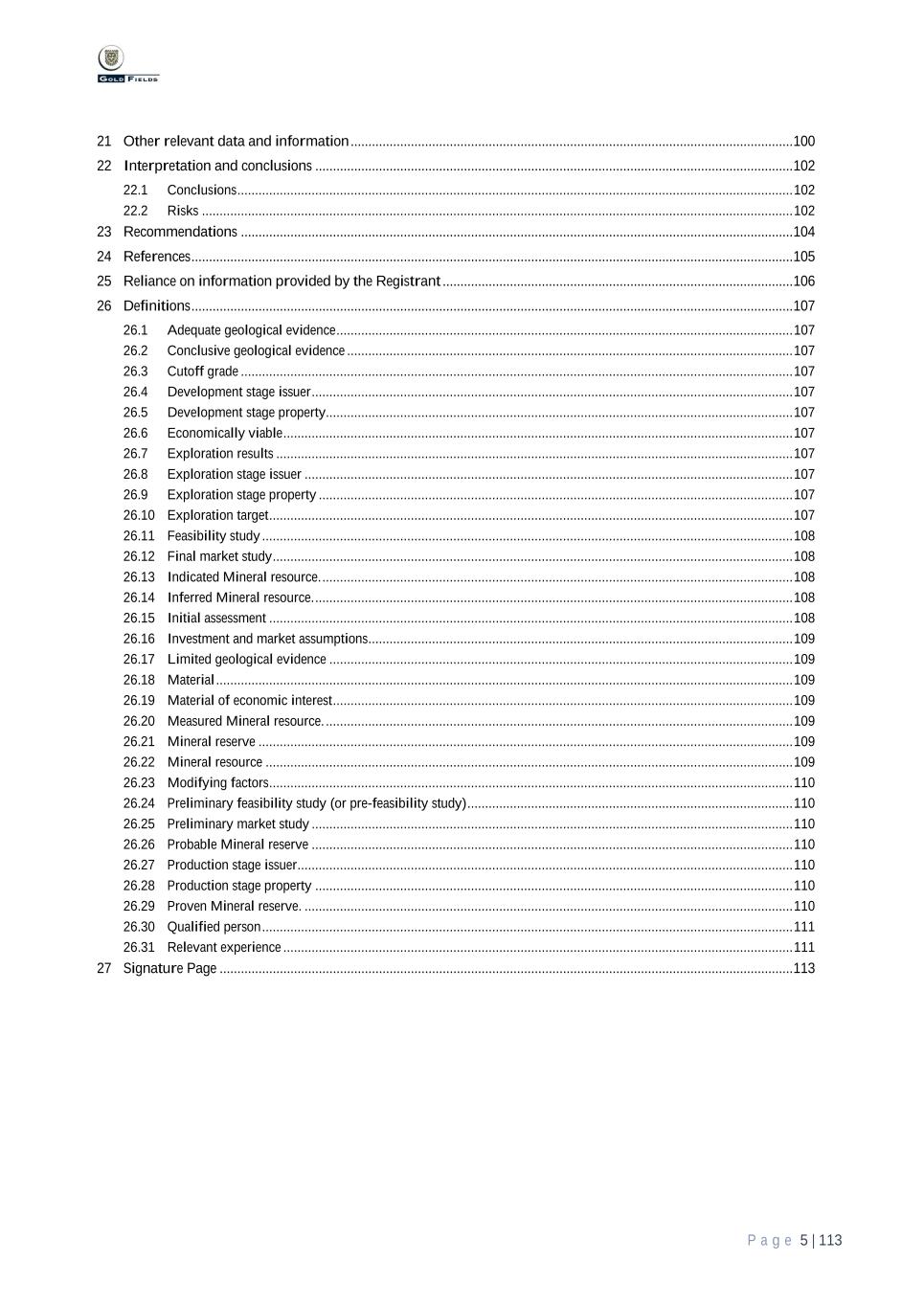
P a g e 5 | 113 21 Other relevant data and information ............................................................................................................................. 100 22 Interpretation and conclusions ....................................................................................................................................... 102 22.1 Conclusions ............................................................................................................................................................. 102 22.2 Risks ....................................................................................................................................................................... 102 23 Recommendations ............................................................................................................................................................ 104 24 References .......................................................................................................................................................................... 105 25 Reliance on information provided by the Registrant ................................................................................................... 106 26 Definitions .......................................................................................................................................................................... 107 26.1 Adequate geological evidence ................................................................................................................................. 107 26.2 Conclusive geological evidence .............................................................................................................................. 107 26.3 Cutoff grade ............................................................................................................................................................ 107 26.4 Development stage issuer ........................................................................................................................................ 107 26.5 Development stage property.................................................................................................................................... 107 26.6 Economically viable ................................................................................................................................................ 107 26.7 Exploration results .................................................................................................................................................. 107 26.8 Exploration stage issuer .......................................................................................................................................... 107 26.9 Exploration stage property ...................................................................................................................................... 107 26.10 Exploration target .................................................................................................................................................... 107 26.11 Feasibility study ...................................................................................................................................................... 108 26.12 Final market study ................................................................................................................................................... 108 26.13 Indicated Mineral resource. ..................................................................................................................................... 108 26.14 Inferred Mineral resource. ....................................................................................................................................... 108 26.15 Initial assessment .................................................................................................................................................... 108 26.16 Investment and market assumptions ........................................................................................................................ 109 26.17 Limited geological evidence ................................................................................................................................... 109 26.18 Material ................................................................................................................................................................... 109 26.19 Material of economic interest .................................................................................................................................. 109 26.20 Measured Mineral resource. .................................................................................................................................... 109 26.21 Mineral reserve ....................................................................................................................................................... 109 26.22 Mineral resource ..................................................................................................................................................... 109 26.23 Modifying factors .................................................................................................................................................... 110 26.24 Preliminary feasibility study (or pre-feasibility study) ............................................................................................ 110 26.25 Preliminary market study ........................................................................................................................................ 110 26.26 Probable Mineral reserve ........................................................................................................................................ 110 26.27 Production stage issuer ............................................................................................................................................ 110 26.28 Production stage property ....................................................................................................................................... 110 26.29 Proven Mineral reserve. .......................................................................................................................................... 110 26.30 Qualified person ...................................................................................................................................................... 111 26.31 Relevant experience ................................................................................................................................................ 111 27 Signature Page .................................................................................................................................................................. 113
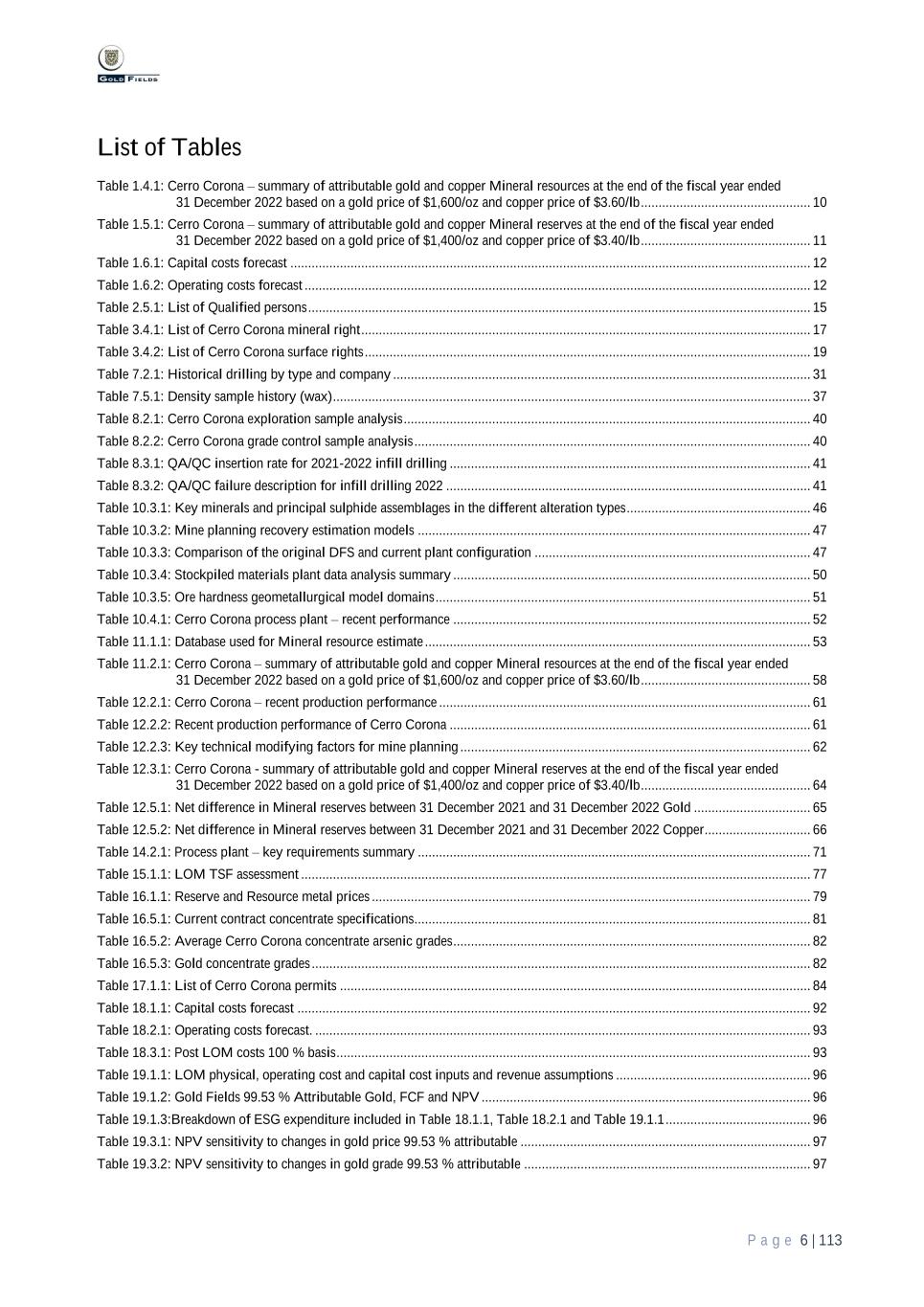
P a g e 6 | 113 List of Tables Table 1.4.1: Cerro Corona – summary of attributable gold and copper Mineral resources at the end of the fiscal year ended 31 December 2022 based on a gold price of $1,600/oz and copper price of $3.60/lb ................................................ 10 Table 1.5.1: Cerro Corona – summary of attributable gold and copper Mineral reserves at the end of the fiscal year ended 31 December 2022 based on a gold price of $1,400/oz and copper price of $3.40/lb ................................................ 11 Table 1.6.1: Capital costs forecast ................................................................................................................................................... 12 Table 1.6.2: Operating costs forecast ............................................................................................................................................... 12 Table 2.5.1: List of Qualified persons .............................................................................................................................................. 15 Table 3.4.1: List of Cerro Corona mineral right ............................................................................................................................... 17 Table 3.4.2: List of Cerro Corona surface rights .............................................................................................................................. 19 Table 7.2.1: Historical drilling by type and company ...................................................................................................................... 31 Table 7.5.1: Density sample history (wax) ....................................................................................................................................... 37 Table 8.2.1: Cerro Corona exploration sample analysis ................................................................................................................... 40 Table 8.2.2: Cerro Corona grade control sample analysis ................................................................................................................ 40 Table 8.3.1: QA/QC insertion rate for 2021-2022 infill drilling ...................................................................................................... 41 Table 8.3.2: QA/QC failure description for infill drilling 2022 ....................................................................................................... 41 Table 10.3.1: Key minerals and principal sulphide assemblages in the different alteration types .................................................... 46 Table 10.3.2: Mine planning recovery estimation models ............................................................................................................... 47 Table 10.3.3: Comparison of the original DFS and current plant configuration .............................................................................. 47 Table 10.3.4: Stockpiled materials plant data analysis summary ..................................................................................................... 50 Table 10.3.5: Ore hardness geometallurgical model domains .......................................................................................................... 51 Table 10.4.1: Cerro Corona process plant – recent performance ..................................................................................................... 52 Table 11.1.1: Database used for Mineral resource estimate ............................................................................................................. 53 Table 11.2.1: Cerro Corona – summary of attributable gold and copper Mineral resources at the end of the fiscal year ended 31 December 2022 based on a gold price of $1,600/oz and copper price of $3.60/lb ................................................ 58 Table 12.2.1: Cerro Corona – recent production performance ......................................................................................................... 61 Table 12.2.2: Recent production performance of Cerro Corona ...................................................................................................... 61 Table 12.2.3: Key technical modifying factors for mine planning ................................................................................................... 62 Table 12.3.1: Cerro Corona - summary of attributable gold and copper Mineral reserves at the end of the fiscal year ended 31 December 2022 based on a gold price of $1,400/oz and copper price of $3.40/lb ................................................ 64 Table 12.5.1: Net difference in Mineral reserves between 31 December 2021 and 31 December 2022 Gold ................................. 65 Table 12.5.2: Net difference in Mineral reserves between 31 December 2021 and 31 December 2022 Copper .............................. 66 Table 14.2.1: Process plant – key requirements summary ............................................................................................................... 71 Table 15.1.1: LOM TSF assessment ................................................................................................................................................ 77 Table 16.1.1: Reserve and Resource metal prices ............................................................................................................................ 79 Table 16.5.1: Current contract concentrate specifications ................................................................................................................ 81 Table 16.5.2: Average Cerro Corona concentrate arsenic grades ..................................................................................................... 82 Table 16.5.3: Gold concentrate grades ............................................................................................................................................. 82 Table 17.1.1: List of Cerro Corona permits ..................................................................................................................................... 84 Table 18.1.1: Capital costs forecast ................................................................................................................................................. 92 Table 18.2.1: Operating costs forecast. ............................................................................................................................................ 93 Table 18.3.1: Post LOM costs 100 % basis ...................................................................................................................................... 93 Table 19.1.1: LOM physical, operating cost and capital cost inputs and revenue assumptions ....................................................... 96 Table 19.1.2: Gold Fields 99.53 % Attributable Gold, FCF and NPV ............................................................................................. 96 Table 19.1.3:Breakdown of ESG expenditure included in Table 18.1.1, Table 18.2.1 and Table 19.1.1 ......................................... 96 Table 19.3.1: NPV sensitivity to changes in gold price 99.53 % attributable .................................................................................. 97 Table 19.3.2: NPV sensitivity to changes in gold grade 99.53 % attributable ................................................................................. 97
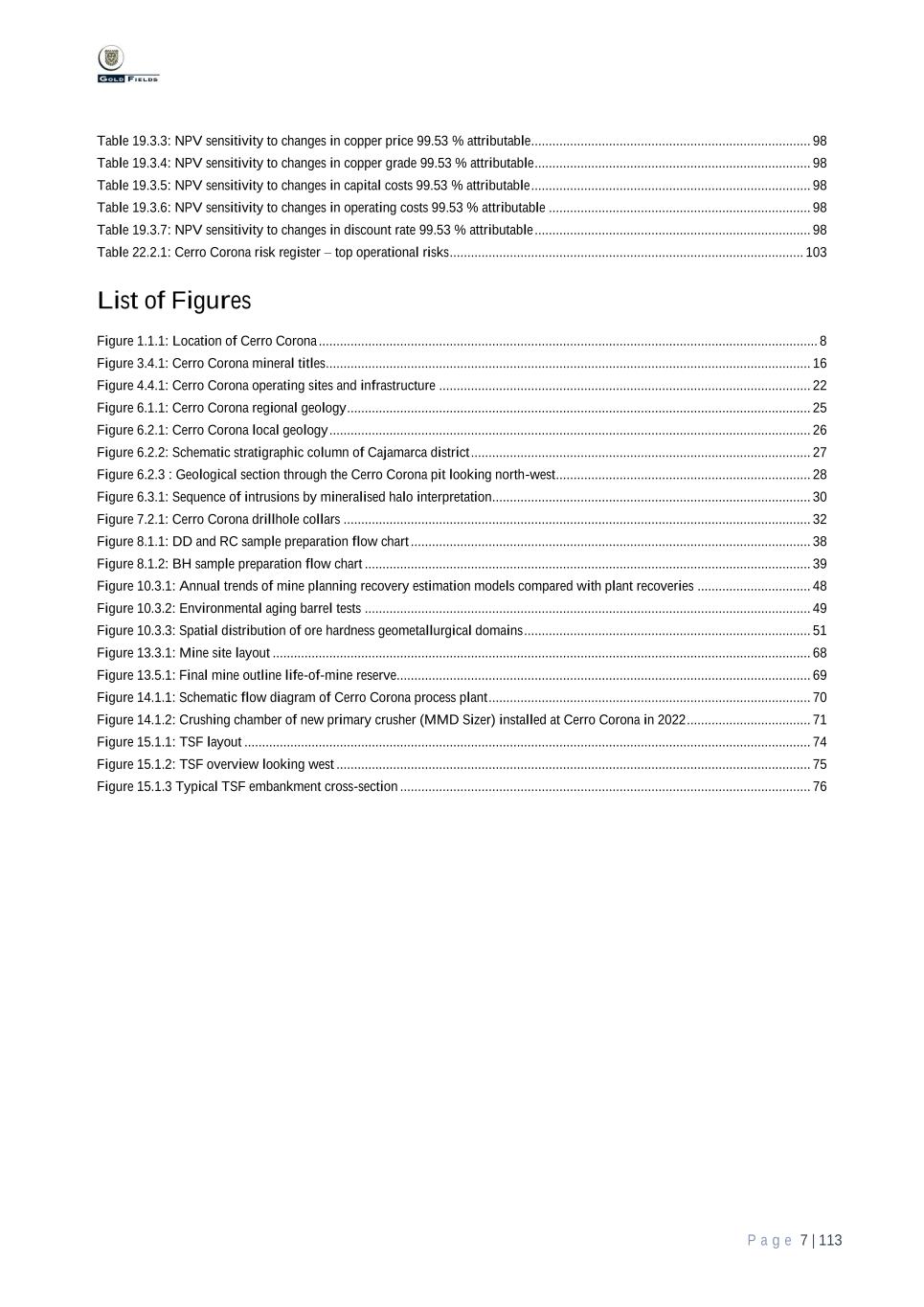
P a g e 7 | 113 Table 19.3.3: NPV sensitivity to changes in copper price 99.53 % attributable ............................................................................... 98 Table 19.3.4: NPV sensitivity to changes in copper grade 99.53 % attributable .............................................................................. 98 Table 19.3.5: NPV sensitivity to changes in capital costs 99.53 % attributable ............................................................................... 98 Table 19.3.6: NPV sensitivity to changes in operating costs 99.53 % attributable .......................................................................... 98 Table 19.3.7: NPV sensitivity to changes in discount rate 99.53 % attributable .............................................................................. 98 Table 22.2.1: Cerro Corona risk register – top operational risks .................................................................................................... 103 List of Figures Figure 1.1.1: Location of Cerro Corona ............................................................................................................................................. 8 Figure 3.4.1: Cerro Corona mineral titles ......................................................................................................................................... 16 Figure 4.4.1: Cerro Corona operating sites and infrastructure ......................................................................................................... 22 Figure 6.1.1: Cerro Corona regional geology ................................................................................................................................... 25 Figure 6.2.1: Cerro Corona local geology ........................................................................................................................................ 26 Figure 6.2.2: Schematic stratigraphic column of Cajamarca district ................................................................................................ 27 Figure 6.2.3 : Geological section through the Cerro Corona pit looking north-west ........................................................................ 28 Figure 6.3.1: Sequence of intrusions by mineralised halo interpretation.......................................................................................... 30 Figure 7.2.1: Cerro Corona drillhole collars .................................................................................................................................... 32 Figure 8.1.1: DD and RC sample preparation flow chart ................................................................................................................. 38 Figure 8.1.2: BH sample preparation flow chart .............................................................................................................................. 39 Figure 10.3.1: Annual trends of mine planning recovery estimation models compared with plant recoveries ................................ 48 Figure 10.3.2: Environmental aging barrel tests .............................................................................................................................. 49 Figure 10.3.3: Spatial distribution of ore hardness geometallurgical domains ................................................................................. 51 Figure 13.3.1: Mine site layout ........................................................................................................................................................ 68 Figure 13.5.1: Final mine outline life-of-mine reserve..................................................................................................................... 69 Figure 14.1.1: Schematic flow diagram of Cerro Corona process plant ........................................................................................... 70 Figure 14.1.2: Crushing chamber of new primary crusher (MMD Sizer) installed at Cerro Corona in 2022 ................................... 71 Figure 15.1.1: TSF layout ................................................................................................................................................................ 74 Figure 15.1.2: TSF overview looking west ...................................................................................................................................... 75 Figure 15.1.3 Typical TSF embankment cross-section .................................................................................................................... 76

P a g e 8 | 113 1 Executive Summary This Technical Report Summary (TRS) was prepared for Gold Fields Limited (Gold Fields or the Company or the Registrant), a production stage issuer. The purpose of this TRS is to support the disclosure of exploration results, Mineral resources and Mineral reserves for the Cerro Corona Copper and Gold Mine (Cerro Corona), a production stage property located in Peru, in accordance with the disclosure requirements for mining registrants as specified in Subpart 1300 of Regulation S-K under the Securities Act of 1933 (SK 1300). The effective date of this Technical Report Summary is 31 December 2022. Unless otherwise specified, all units of currency are in United States Dollars ($). All measurements are metric with the exception of troy ounces (oz) and pounds (lb). 1.1 Property description and ownership Cerro Corona is approximately 600 km north-northwest of Lima and approximately 80 km north by road from the departmental capital of Cajamarca (Figure 1.1.1). Figure 1.1.1: Location of Cerro Corona Source: Cerro Corona CPR, 2022 Cerro Corona comprises mining concessions covering a total area of 4,804 ha and surface rights covering 1,291 ha held by Gold Fields La Cima S.A. (GFLC), a Peruvian-registered company. Gold Fields holds a 100 % interest in Gold Fields Corona (BVI) Limited, which in turn holds a 99.53 % interest in GFLC.

P a g e 9 | 113 The major components of the Cerro Corona mining and processing operation are: • Open pit mine. • Waste storage facility (WSF). • 6.7 Mt/a flotation process plant. • Tailings storage facility (TSF). • Centralised administrative office and engineering workshops. • Permanent camp. • Power substation. 1.2 Geology and mineralisation The Cerro Corona copper-gold deposit is associated with a Mid-Miocene diorite to quartz-diorite intrusive primarily emplaced along sub-vertical faults within Mid-Cretaceous limestone units. The deposit is typical of porphyry-style mineralisation, comprising an upper gold-only leached cap, underlain by mixed and supergene enriched copper zones, which overlay the variably altered hypogene portion of the deposit. The hypogene zone mineralisation is characterised by sulphide mineralisation as disseminated nodes, small patches, infill in fractures and within stockwork quartz veins. The mineralisation within the stockwork is mainly pyrite-marcasite-chalcopyrite + bornite + covellite + hematite + magnetite. 1.3 Exploration, development and operations Contract mining is employed in the open pit applying conventional drill, blast, load and haul methods. Accelerated mining based on nine separate pit stages exceeds the processing rate allowing tailings generated in the future to be placed back in the pit. Ore is stockpiled during the accelerated mining phase. Further exploration at Cerro Corona will focus on geological and geotechnical characterization, lithological continuity and structural complexity of the East Wall. 1.4 Mineral resource estimates The Cerro Corona Mineral resources exclusive of Mineral reserves as of 31 December 2022 are summarised in Table 1.4.1. The Mineral resources are 99.53 % attributable to Gold Fields and are net of production depletion up to 31 December 2022. All grades and tonnages reported are in-situ without any modifying factors applied.

P a g e 10 | 113 Table 1.4.1: Cerro Corona – summary of attributable gold and copper Mineral resources at the end of the fiscal year ended 31 December 2022 based on a gold price of $1,600/oz and copper price of $3.60/lb Resources (exclusive of Mineral reserves) NSR Cutoff Metallurgical recovery Amount/ Grade Amount Grade Amount (kt) Au/ (g/t) Au/ (koz) Cu/ (%) Cu/ (Mlbs) ($/t) Au/ (%) Cu/ (%) Open pit Mineral resources OP measured Mineral resources 33,250 0.51 547 0.34 249 16.4 75.9 88.5 OP indicated Mineral resources 7,265 0.48 113 0.31 50 16.4 76.1 88.2 OP measured + indicated Mineral resources 40,515 0.51 660 0.34 300 16.4 75.9 – 76.1 88.2 – 88.5 OP inferred Mineral resources 145 0.38 2 0.33 1 16.4 76.0 88.4 Stockpile Mineral resources SP measured Mineral resources – oxides SP measured Mineral resources – sulphide SP indicated Mineral resources SP measured + indicated Mineral resources SP inferred Mineral resources Total Cerro Corona Mineral resources Total measured Mineral resources 2022 33,250 0.51 547 0.34 249 Total indicated Mineral resources 2022 7,265 0.48 113 0.31 50 Total measured + indicated Mineral resources 2022 40,515 0.51 660 0.34 300 Total inferred Mineral resources 2022 145 0.38 2 0.33 1 Total M+I Mineral resources 2021 37,454 0.46 557 0.32 264 Total Inferred Mineral resources 2021 300 0.37 4 0.30 2 Total M+I Year on year difference (%) 8 % 10 % 19 % 5 % 13 % Total Inferred Year on year difference (%) -52 % 1 % -51 % 12 % -46 % Notes: a) Mineral resources are exclusive of Mineral reserves. Rounding of figures may result in minor computational discrepancies. b) Mineral resources categories are assigned with consideration given to geological complexity, grade variance, drillhole intersection spacing and proximity of mining development. c) Mineral resources quoted as diluted in-situ metric tonnes and grades. Metallurgical recovery factors have not been applied to the estimates. The approximate metallurgical recovery factors are 89 % to copper and 76 % to gold. The metallurgical recovery is the ratio, expressed as a percentage, of the mass of the specific mineral product recovered from ore treated at the process plant to its total specific mineral content before treatment. Cerro Corona mining operations vary according to the mix of the source material (e.g., oxide, transitional, fresh and ore type blend). d) The metal prices used for the 2022 Mineral resources are based on a gold price of $1,600 per ounce and a copper price of $3.60 per pound. Open pit Mineral resources at the South American operations are similarly based on revenue factor 1.0 pits, appropriate mine design and extraction schedules. The gold price used for Mineral resources approximates 14 % higher than the selected Mineral reserve price. e) The cutoff grade may vary per mine, depending on the respective costs, depletion schedule, ore type, expected mining dilution and expected mining recovery. The average cutoff grade value applied to the Mineral resources is: $16.4/t. f) The Mineral resources are based on initial assessments at the resource gold price of $1,600/oz and copper price of $3.60/lb consider estimates of all Cerro Corona costs, the impact of modifying factors such as mining dilution and mining recovery, processing recovery and royalties. Mineral resources are also tested through the application of Environmental, Social and Governance (ESG) criteria to demonstrate reasonable prospects for economic extraction. g) The Mineral resources are estimated at a point in time and can be affected by changes in the gold price, US Dollar currency exchange rates, permitting, legislation, costs and operating parameters. h) Cerro Corona is 99.53 % attributable to Gold Fields and is entitled to mine all declared material located within the property’s mineral leases and all necessary statutory mining authorisations and permits are in place or have reasonable expectation of being granted. Source: Cerro Corona CPR, 2022

P a g e 11 | 113 1.5 Mineral reserve estimates The Cerro Corona Mineral reserves as of 31 December 2022 are summarised in Table 1.5.1. The Mineral reserves are 99.53 % attributable to Gold Fields and are net of production depletion up to 31 December 2022. The Mineral reserves are reported in terms of run-of-mine (RoM) grades and tonnages delivered to the processing facility and are therefore fully diluted. Table 1.5.1: Cerro Corona – summary of attributable gold and copper Mineral reserves at the end of the fiscal year ended 31 December 2022 based on a gold price of $1,400/oz and copper price of $3.40/lb Amount/ Grade Amount Grade Amount Cutoff grades/ Metallurgical recovery (Kt) Au/ (g/t) Au/ (koz) Cu/ (%) Cu/ (Mlb) ($/t NSR) Au/ (%) Cu/ (%) Open Pit Mineral reserves OP proven Mineral reserves 34,705 0.56 623 0.37 284 16.4 75.8 88.8 OP probable Mineral reserves 2,006 0.47 30 0.33 14 16.4 76.0 88.3 OP total Mineral reserves 36,711 0.55 653 0.37 298 16.4 75.8 – 76.0 88.3 – 88.8 Stockpile Mineral reserves SP proven Mineral reserves 13,185 0.52 219 0.34 100 16.4 75.9 88.5 SP probable Mineral reserves SP total Mineral reserves 13,185 0.52 219 0.34 100 16.4 75.9 88.5 Total Mineral reserves Total proven Mineral reserves 47,890 0.55 842 0.36 384 Total probable Mineral reserves 2,006 0.47 30 0.33 14 Total Cerro Corona Mineral reserves 2022 49,896 0.54 872 0.36 398 Total Cerro Corona Mineral reserves 2021 58,020 0.59 1,103 0.37 474 Year-on-year difference (%) -14 % -8 % -21 % -2 % -16 % Notes: a) Rounding of figures may result in minor computational discrepancies. b) Refer to Table 12.5.1 for year-on-year Mineral reserve comparison. c) Mineral reserve quoted as mill delivered metric tonnes and RoM grades, inclusive of all mining dilutions and gold losses except mill recovery. Metallurgical recovery factors have not been applied to the Mineral reserve figures. The approximate metallurgical recovery factors are 76 % for gold and 89 % for copper. The metallurgical recovery is the ratio, expressed as a percentage, of the mass of the specific mineral product recovered from ore treated at the process plant to its total specific mineral content before treatment. The recoveries for Cerro Corona vary according to the mix of the source material (e.g., oxide, transitional fresh and ore type blend) and method of treatment. d) The metal prices used for the 2022 life-of-mine (LoM) Mineral reserves are based on a gold price of $1,400/ounce and $3.40/lb copper. Open pit Mineral reserves at Cerro Corona are based on optimised pits and appropriate mine design and extraction schedules. The gold price and copper price used for Mineral reserves is detailed in Chapter 16, Marketing. e) Dilution relates to planned and unplanned waste and/or low-grade material being mined and delivered to the process plant. Ranges are given for those operations that have multiple orebody styles and mining methodologies. The mine dilution factors are 0 %. f) The mining recovery factor relates to the proportion or percentage of ore mined from the defined orebody at the gold price used for the declaration of Mineral reserves. This percentage will vary from mining area to mining area and reflects planned and scheduled reserves against actual tonnes, grade and metal mined, with all modifying factors and mining constraints applied. The mining recovery factors are 98 %. g) The cutoff grade may vary per mine, depending on the respective costs, depletion schedule, ore type, expected mining dilution and expected mining recovery. The average NSR cutoff value applied in the planning process is $16.4/t. h) An ounces-based Mine Call Factor (metal called for over metal accounted for) determined primarily on historic performance but also on realistic planned improvements where appropriate, is applied to the Mineral reserves. A Mine Call Factor of 100 % has been applied at Cerro Corona. i) Cerro Corona is 99.53 % attributable to Gold Fields. Source: Cerro Corona CPR, 2022 1.6 Capital and operating cost estimates Major capital expenses at Cerro Corona are related to the ongoing raising of the TSF, construction of containment blankets, the WSF and the in-pit tailings facility. The total capital expenditure requirement over the life-of-mine (LOM) is estimated at $93.2 million, of this, $86.2 million (92 %) will be spent from 2023 to 2025. From 2026 onwards there only sustaining capex is planned. The capital forecast over the LOM is summarised in Table 1.6.1.

P a g e 12 | 113 Table 1.6.1: Capital costs forecast Cost item Units 2023 2024 2025 2026 2027 2028 2029 2030 Capital $ million 44.5 16.9 24.8 3.0 1.4 1.7 0.8 0.2 Note: a) The detailed capital cost schedule is presented in Table 18.1.1. b) This capital summary estimate is for the Mineral reserve LOM schedule and is on a 100 % basis. c) Closure costs are included in operating costs. Source: Cerro Corona CPR, 2022 Operating costs are prepared based on the approved mining plan schedule, with mining in the pit until 2025 and processing ore at the plant until 2030, from 2026 onwards low-grade stocks will be treated. In general, figures have been prepared based on the 2022 actual costs and the approved budget for 2023, with escalations applied and including pit closure. Mining cost estimates have been built from approved contractor rates as well as actual costs from 2022. LOM operating costs are summarised in Table 1.6.2. Table 1.6.2: Operating costs forecast Description Units 2023 2024 2025 2026 2027 2028 2029 2030 Operating costs $ million 219.1 201.9 179.9 127.3 124.1 119.9 121.4 60.5 Note: a) The detailed operating cost schedule is presented in Table 18.2.1. b) This operating cost summary estimate is for the Mineral reserve LOM schedule and is on a 100 % basis. Source: Cerro Corona CPR, 2022 The closure cost as at the end of December 2022 is estimated at $152.1 million, and has been prepared in coordination with a specialist, Ausenco. 1.7 Permitting Cerro Corona’s Environmental Impact Assessment (EIA) was approved in December 2005 allowing development activities until the approval of the operation permit (“Concesión de beneficio”) by the General Mining Bureau (GMB). The construction permit was approved in February 2006 and the Certificate of Mining issued in December 2007. The process plant and ancillary facilities were constructed, inspected and approved by GMB. Several components of the Cerro Corona construction and operations plans were modified from the plans submitted to the EIA and GMB. Eight modifications to the original EIA and thirteen Supporting Technical Reports (STR) applicable for new components or modifications that do not involve significant environmental impacts were submitted to and approved by the regulators. The eighth modification to the EIA (EIA 8) was approved by the authorities during Q4 2019, allowing an increase in the footprint of the open pit, expansion of the TSF to 3,803 masl and expansion of WSF at Arpon and Ana. An in-pit TSF will be included in the ninth modification of the EIA (EIA 9) for approval before construction commences. Compliance with EIA 9 and other permits derived from it is required before March 2026 when the first tailings material will be deposited into the open pit and is supported by a comprehensive permit application process to the regulator. The EIA modification process has already commenced, including the implementation of public participation mechanisms in the area of influence before and during EIA preparation (2021 – 2022). In addition, throughout 2021- 2022 Gold Fields carried out field work around Cerro Corona to gather environmental and social data for the EIA preparation. Gold Fields was also required to submit an additional public participation plan because of new regulations published in 2022, and the plan was approved in January 2023. Execution of this plan will begin once the EIA is admitted by the regulator for evaluation, around Q3 2023.

P a g e 13 | 113 1.8 Conclusions and recommendations The Mineral reserves currently support an 8 year LOM plan and values the Cerro Corona operation NPV at $192 million, at a gold price of $1,400/oz and copper price of $3.40/lb and a discount rate of 8.1 %. In comparison to the previous year valuation ($250 million), there has been a significant reduction, mainly due to mining depletion of reserves and higher costs in 2022 due to global inflationary pressures and an increased discount rate from 4.8 % to 8.1 %; these effects were partially offset by higher gold and copper price planning assumptions. Consequently, there has been an impairment of $63 million of the Cerro Corona CGU, $44 million after tax. The impairment calculation is based on the FVLCOD calculated using a combination of the market (resource value) and income approach using level 3 of the fair value hierarchy, in comparison to the carrying value. The main changes between 2022 and 2021 Reserves numbers are due to mining depletion during 2022, with contributions from mining cost inflation and changes in the pit design for the west wall due to definition of non- competent limestone. This has been mitigated by a pit expansion towards the northeast but has a higher stripping ratio than the west wall. Gold Fields’ commitment to materiality, transparency and competency in its Mineral resources and Mineral reserves disclosure to regulators and in the public domain is of paramount importance to the Qualified person and the Registrants Executive Committee and Board of Directors continue to endorse the company’s internal and external review and audit assurance protocols. The Qualified person is of the opinion that this report meets these requirements and there are no further recommendations regarding this disclosure. This Technical Report Summary should be read in totality to gain a full understanding of Cerro Corona’s Mineral resource and Mineral reserve estimation and reporting process, including data integrity, estimation methodologies, modifying factors, mining and processing capacity and capability, confidence in the estimates, economic analysis, risk and uncertainty and overall projected property value.

P a g e 14 | 113 2 Introduction 2.1 Registrant for whom the Technical Report Summary was prepared. This Technical Report Summary was prepared by Gold Fields La Cima S.A. representatives for Gold Fields Limited. 2.2 Terms of reference and purpose of the Technical Report Summary The purpose of this TRS is to support the disclosure of Mineral resources and Mineral reserves for the Cerro Corona Copper and Gold Mine (Cerro Corona or the Property), a production stage property located in Peru, in accordance with the disclosure requirements for mining registrants as specified in SK 1300. The Cerro Corona Technical report summary was first disclosed in 2022 with an effective date of 31 December 2021. This Technical Report Summary is effective of 31 December 2022 and is being updated primarily due to changes in the valuation of the project which have necessitated an impairment. The Mineral resources and Mineral reserves disclosed in this Technical Report Summary are reported in accordance with the South African Code for the Reporting of Exploration Results, Mineral Resources and Mineral Reserves (SAMREC Code 2016). SAMREC is based on the Committee for Mineral Reserves International Reporting Standards (CRIRSCO) Reporting Template November 2019. Mineral resources and Mineral reserves as reported in this Technical Report Summary are also in accordance with SK 1300. 2.3 Sources of Information This Technical Report Summary is principally based on information disclosed in the “Competent Person’s Report on the Material Assets of Cerro Corona Copper and Gold Mine as of 31 December 2022” prepared by Cerro Corona management on behalf of the Company. The Competent Person’s Report (CPR) was supplemented by technical reports and studies prepared by the Company and third-party specialists engaged by the Company as cited throughout this Technical Report Summary and listed in Section 24. Reliance was also placed on certain economic, marketing and legal information beyond the expertise of the Qualified persons used in the determination of modifying factors. This information provided by the Company is cited throughout this Technical Report Summary and is listed in Section 25. All units of currency are in United States Dollars ($). All measurements are metric except for troy ounces (oz) for gold/silver and pounds (lb) for copper. 2.4 Qualified persons and details of inspection The Qualified persons responsible for the preparation of this Technical Report Summary are listed in Table 2.5.1. All the Qualified persons are eligible members in good standing of a recognised professional organisation (RPO) within the mining industry and have at least five years of relevant experience in the type of mineralisation and type of deposit under consideration and in the specific type of activity that the Qualified person is undertaking on behalf of the Company at the time this Technical Report Summary was prepared. The recognised professional organisation affiliation in good standing has been reviewed by Gold Fields. The Qualified persons have been appointed by Gold Fields. 2.5 Report version update This is the first update of the Technical Report Summary filed by Gold Fields on the Cerro Corona property in Peru, superseding the maiden TRS filed in 2022, effective date 31 December 2021.

P a g e 15 | 113 Table 2.5.1: List of Qualified persons Incumbent Employer Position Affiliation in good standing Relevant experience (years) Details of inspection Responsibility for which chapters Dr Julian Verbeek Gold Fields VP Geology and Mineral resources. Group QP FAusIMM – 207994 35 Has not attended site This document has been prepared under the supervision of and reviewed by Julian Verbeek. Chapters 1-26 Jason Sander Gold Fields VP Mining FAusIMM – 111818 27 Has not attended site Overview and review of document. Chapters 1-5, 12-13 & 15-26 Dr Winfred Assibey- Bonsu Gold Fields Group Geostatistician and Evaluator FSAIMM – 400112/00 36 Has attended site Review of Resources and Reserves. Chapters 1 – 9 & 11 & 20-26 (excluding 1.6 and 1.7) Andrew Engelbrecht Gold Fields Group Geologist MAusIMM – 224997 23 Has attended site Geology and Resources. Chapters 1 – 9 & 11 & 20-26 Peter Andrews Gold Fields VP: Geotechnical MAusIMM CP – 302255 25 Has attended site Geotechnical review. Chapters 7.4, 15.2, 17.3.2 Daniel Hillier Gold Fields VP: Metallurgy FAusIMM CP – 227106 32 Has not attended site Chapters 10 & 14 Johan Boshoff Gold Fields Group Head of Tailings FAusIMM – 1007564 27 Has attended site Tailings Review. Chapters 15.1 & 17.3.1 Andre Badenhorst Gold Fields Group Technical and Reporting Governance Manager MAusIMM – 309882 42 Has not attended site Chapters 1-26 Paul Gomez Gold Fields VP: Technical Services MAusIMM – 330373 23 Has attended site, is a Gold Fields regional Lead QP Overall conduct and standard of technical work for the purposes of estimating and reporting resources and reserves for the Americas region. Chapters 1-26 Julio Torres Gold Fields Technical Services Manager MAusIMM – 3053967 21 Has attended site is a Gold Fields employee and site Lead QP Overall conduct and standard of technical work for the purposes of estimating and reporting resources and reserves for the Cerro Corona mine. Chapters 1-26 Jony Yupa Gold Fields Mine Planning Superintendent MAusIMM – 3055128 16 Has attended site is a Gold Fields employee and site QP Responsible for Pit optimization declaration to resources, reserves, scheduling mine plan. Chapters 1-26 Joel Mejia Gold Fields Resources Geologist Supervisor AusIMM – 317107 16 Has attended site is a Gold Fields employee and site QP Responsible for the compilation of this declaration as well as resource evaluation and modelling. Chapters 6-9 & 11 Notes: a) The Qualified persons where not all able to attend site in 2022 for Mineral reserve and Mineral resource reviews, however, the Mineral reserve and Mineral resource were reviewed according to the Chapter 21 description (virtual reviews). Some Qualified persons have attended historically. Source: Cerro Corona CPR, 2022
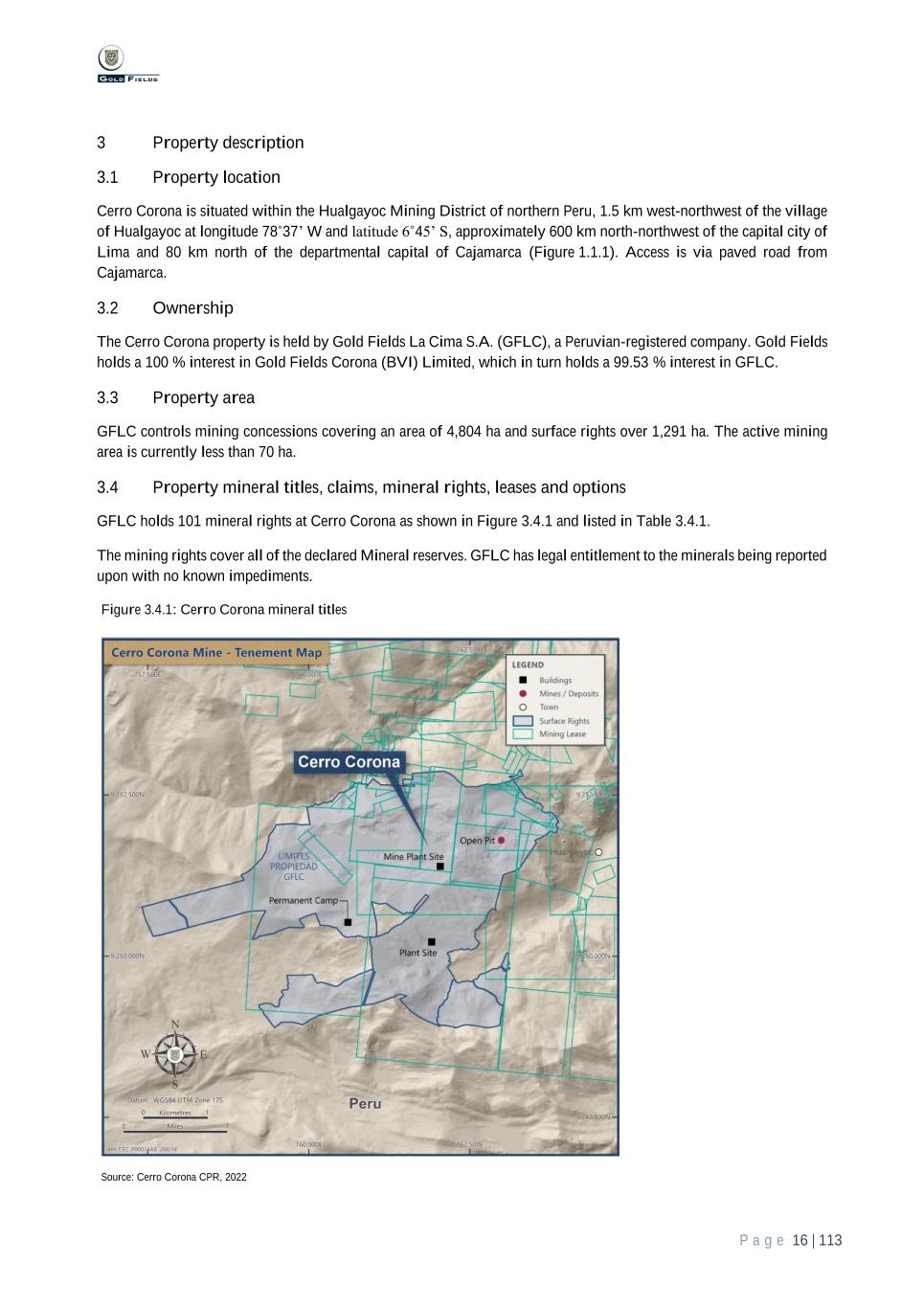
P a g e 16 | 113 3 Property description 3.1 Property location Cerro Corona is situated within the Hualgayoc Mining District of northern Peru, 1.5 km west-northwest of the village of Hualgayoc at longitude 78˚37’ W and latitude 6˚45’ S, approximately 600 km north-northwest of the capital city of Lima and 80 km north of the departmental capital of Cajamarca (Figure 1.1.1). Access is via paved road from Cajamarca. 3.2 Ownership The Cerro Corona property is held by Gold Fields La Cima S.A. (GFLC), a Peruvian-registered company. Gold Fields holds a 100 % interest in Gold Fields Corona (BVI) Limited, which in turn holds a 99.53 % interest in GFLC. 3.3 Property area GFLC controls mining concessions covering an area of 4,804 ha and surface rights over 1,291 ha. The active mining area is currently less than 70 ha. 3.4 Property mineral titles, claims, mineral rights, leases and options GFLC holds 101 mineral rights at Cerro Corona as shown in Figure 3.4.1 and listed in Table 3.4.1. The mining rights cover all of the declared Mineral reserves. GFLC has legal entitlement to the minerals being reported upon with no known impediments. Figure 3.4.1: Cerro Corona mineral titles Source: Cerro Corona CPR, 2022

P a g e 17 | 113 Table 3.4.1: List of Cerro Corona mineral right No. Code Name Title Year Available ha. License fee Minimum production Penalty Minimum investment (USD) (PEN) (PEN) (PEN) 1 03000223X01 22 DE ENERO 1966 2.00 6.00 8,800 175.96 1,759.6 2 010001701L ACUMULACION CHELITA 2002 210.38 631.15 925,672 18,513.66 185,136.6 3 03003400X01 ALEJANDRITO MP 1991 7.74 23.23 34,056 681.44 6,814.4 4 03000715Y01 ALFA 23-I (accumulate) 1985 107.06 321.19 471,064 - - 5 03000716Y01 ALFA 23-II (accumulate) 1985 24.77 74.30 108,988 - - 6 03000721Y01 ALFA 23-III (accumulate) 1986 46.98 140.93 206,712 4,134.07 41,340.7 7 03003205X01 ALFA 23-IV (accumulate) 1986 4.97 14.91 21,868 437.43 4,374.3 8 03002892X01 ALFA -G 200 0.13 0.39 572 11.34 113.4 9 03001066X01 ALFA VEINTITRES 1983 79.98 239.93 351,912 - - 10 03002889X01 ALFA-C 1991 1.64 4.93 7,216 - - 11 03002896X01 ALFA-D 1991 0.19 0.58 836 - - 12 03002890X01 ALFA-E 2000 0.14 0.43 616 - - 13 03002891X01 ALFA-F 1991 0.71 2.14 3,124 62.83 628.3 14 03002897X01 ALFA-H 1991 0.78 2.35 3,432 - - 15 03002893X01 ALFA-J 1991 1.54 4.61 6,776 135.19 1,351.9 16 03002900X01 ALFA-M 2000 0.08 0.23 352 6.87 68.7 17 010231904 AMANECER MINERO GF 2004 0.57 1.71 2,508 50.06 500.6 18 03002283X01 ANCLA 2000 1.56 4.69 6,864 137.51 1,375.1 19 0302283AX01 ANCLA A-4 (fraccionado) 2000 3.89 11.68 17,116 342.74 3,427.4 20 0302283BX01 ANCLA A-5 (fraccionado) 2000 12.86 38.59 56,584 1,132.01 11,320.1 21 03003206X01 ARPON 19-I (accumulate) 1988 55.56 166.69 244,464 - - 22 03002887X01 ARPON -A 1995 4.61 13.84 20,284 - - 23 03003101X01 ARPON C 1998 0.84 2.52 3,696 - - 24 03001067X01 ARPON DIECINUEVE 1981 89.97 269.91 395,868 - - 25 03000376X01 BELLA UNION 1966 49.99 149.97 219,956 4399.08 43,990.8 26 03001366X01 CALIZA 1998 32.83 98.48 144,452 2,888.73 28,887.3 27 03001629X01 CAÑON 1975 89.98 269.95 395,912 - - 28 03001700X01 CAPRICORNIO 2000 2.64 7.93 11,616 232.56 2,325.6 29 010265003 CAROLINA UNO 2003 2004 7.24 21.72 31,856 - - 30 03000907X01 CASUALIDAD 1969 284.98 854.95 1,253,912 25,078.42 250,784.2 31 03002064X01 CERRO 1995 166.63 499.88 733,172 - - 32 03002438X01 CERRO-A 1994 129.97 389.90 571,868 11,437.01 114,370.1 33 03001014X02 CHELA VEINTIDOS 1968 10.00 29.99 44,000 - - 34 03002144X01 CORDILLERA 2000 442.40 1327.19 1,946,560 38,930.90 389,309.0 35 03002153X01 CORDILLERA – B 1999 375.89 1127.68 1,653,916 33,078.67 330,786.7 36 010050310 CORONA NW 2011 1.19 3.58 5,236 104.97 1,049.7 37 03002331X01 DEMASIA PAMPA DE NAVAS 2000 0.01 0.03 44 - - 38 03001043X01 DON PACO 1968 38.99 116.98 171,556 3,431.28 34,312.8 39 03002145X01 DOS AMIGOS 1999 14.99 44.98 65,956 1,319.54 13,195.4 40 0302146AX01 EL MANJAR N°2-A3 (fraccionado) 2000 1.60 4.79 7,040 140.50 1,405.00 41 0302146BX01 EL MANJAR N°2-A4 (fraccionado) 2000 44.16 132.49 194,304 3,886.34 38,863.4 42 0302146CX01 EL MANJAR N°2-A6 (fraccionado) 2000 6.87 20.60 30,228 604.30 6,043.0 43 0302146DX01 EL MANJAR N°2-A7 (fraccionado) 2000 3.96 11.89 17,424 348.68 3,486.8 44 0302146EX01 EL MANJAR N°2-A8 (fraccionado) 2000 217.25 651.74 955,900 19,117.62 191,176.2 45 03001926X01 EL MESIAS 1978 |167.96 503.89 739,024 14,780.80 147,808.0 46 0302960BX01 ENSENADA-MC 2001 0.36 1.07 1,584 31.39 313.9 47 0302964BX01 FORTUNA I-M.C. 2000 7.80 23.40 34,320 686.45 6,864.5 48 03001916X01 FUMISA N°1 2000 74.70 224.11 328,68 6573.86 65,738.6 49 03001917X01 FUMISA N°2 2000 62.64 187.91 275,616 5,512.13 55,121.3 50 03001918X01 FUMISA N°3 2000 19.99 59.98 87,956 - - 51 03002736X01 FUMISA N°3-A 2000 4.51 13.53 19,844 - - 52 03002737X01 FUMISA N°3-B 1998 2.00 5.99 8,800 - -

P a g e 18 | 113 No. Code Name Title Year Available ha. License fee Minimum production Penalty Minimum investment (USD) (PEN) (PEN) (PEN) 53 03002746X01 FUMISA N°3-H 2000 0.58 1.73 2,552 - - 54 0302746AX01 FUMISA N°3-H-A2 (fraccionado) 2000 1.77 5.30 7,788 - - 55 03003451X01 GEMELA DERECHA M.R. 2000 0.11 0.33 484 9.72 97.20 56 0303451AX01 GEMELA DERECHA M.R. -A4 (fraccionado) 2000 1.08 3.25 4,752 95.43 954.3 57 03001228X01 JAPON TRECE 1999 6.00 18.00 26,400 527.89 5,278.9 58 03003661X01 JUAN XXIII 2001 0.19 0.58 836 - - 59 03002199X01 LA INCREIBLE 2000 1.94 5.82 8,536 170.76 1,707.6 60 0302212DX01 LAGO AL-4 (fraccionado) 2000 6.38 19.15 28,072 561.70 5,617.00 61 03000950X01 LUCIA N°1 1983 12.00 35.99 52,800 1,055.74 10,557.4 62 03000023X01 MARUJA 1A 1967 1.66 4.99 7,304 146.24 1,462.4 63 0303613AX01 MILAGRITOS G.A.-A1 (fraccionado) 2000 1.52 4.55 6,688 133.58 1,335.8 64 03003613X01 MILAGRITOS-G.A. 2000 0.27 0.81 1,188 23.85 238.5 65 03000479X01 NANCY 1967 12.00 35.99 52,800 - - 66 03000078X01 NILDA 1968 10.00 29.99 44,000 - - 67 03003324X01 OLVIDADA 2000 0.39 1.16 1,716 33.99 339.9 68 03000267X01 ORLANDITO 1964 17.99 53.98 79,156 1583.49 15,834.9 69 03000144X01 ORLANDO 1964 23.99 71.98 105,556 2,111.35 21,113.5 70 03000151X01 ORLANDO I 1961 43.99 131.96 193,556 3,870.70 38,707 71 03000152X01 ORLANDO II 1961 17.99 53.98 79,156 1,583.44 15,834.4 72 03000156X01 ORLANDO III 1961 6.00 17.99 26,400 527.84 5,278.4 73 0303236CX01 PATY M.C. (fraccionado) 2000 49.68 149.04 218,592 4,371.73 43,717.3 74 0303236AX01 PATY-M.C. 2000 0.06 0.18 264 5.34 53.4 75 03000943X01 PORCIA N°1 1967 3.00 9.00 13,200 - - 76 03002213X01 PORCIA N°2 2000 0.33 1.00 1,452 29.39 293.9 77 0302213AX01 PORCIA N°2-A1 (fraccionado) 2000 3.47 10.42 15,268 305.72 3,057.2 78 03002211X01 PORCIA N°3 2000 3.65 10.94 16,060 320.94 3,209.4 79 03001206X01 PREDILECTA 1956 6.00 18.00 26,400 - - 80 010070004 PROYECTO 2004 2004 16.59 49.77 72,996 - - 81 03000403X01 PUNTO VICTORIA SEIS 1968 29.99 89.98 131,956 2,639.38 26,393.8 82 03001032X01 QUIJOTE 2000 0.28 0.85 1,232 24.94 249.4 83 03001824X01 QUIJOTE N°2 2000 9.00 27.00 39,600 791.97 7,919.7 84 0301032AX01 QUIJOTE-A1 2000 47.20 141.61 207,680 4,154.00 41,540 85 03002204X01 REDENCION 1998 2.92 8.76 12,848 - - 86 03000158X01 RULITO 1965 39.99 119.96 175,956 3,518.87 35,188.7 87 010236794 SAN JOSE N° 1 2003 102.32 306.95 450,208 9,003.98 90,039.8 88 010778195 SAN JOSE N°1-A 2002 153.85 461.55 676,940 13,538.89 135,388.9 89 03000176X01 SAN RAMON 1985 5.63 16.90 24,772 - - 90 03001022X01 SANTA BARBARA 1936 4.00 12.00 17,600 352.00 3520.00 91 010164412 SENECA 2013 2.69 8.06 11,836 - - 92 03000135X01 SYLVITA 1961 19.99 59.98 87,956 - - 93 03002284X01 TARA 2000 0.37 1.11 1628 - - 94 0302284AX01 TARA A-1 (fraccionado) 2000 7.24 21.73 31,856 637.27 6,372.70 95 0302284BX01 TARA A-2 (fraccionado) 2000 25.34 76.01 111,496 2,229.61 22.296.1 96 0302284CX01 TARA-A-3 (fraccionado) 2000 9.22 27.66 40,568 811.32 8,113.2 97 0302284DX01 TARA-A-4 (fraccionado) 2000 1.22 3.65 5,368 107.07 1,070.7 98 03002219X01 TRINITARIA V 2000 0.35 1.05 1,540 30.74 307.4 99 03002471X01 VALE 2000 533.73 1601.19 2,348,412 - - 100 03002085X01 VALLE 1994 615.83 1847.50 2,709,652 - - 101 03002350X01 VALLE -A 1997 23.79 71.38 104,676 - - Total (ha) 4,804.06 Notes: a) The Qualified persons opinion is that licenses and tenements are in good standing to enable execution of the life-of-mine plan and can be renewed or extended as required. Source: Cerro Corona CPR, 2022
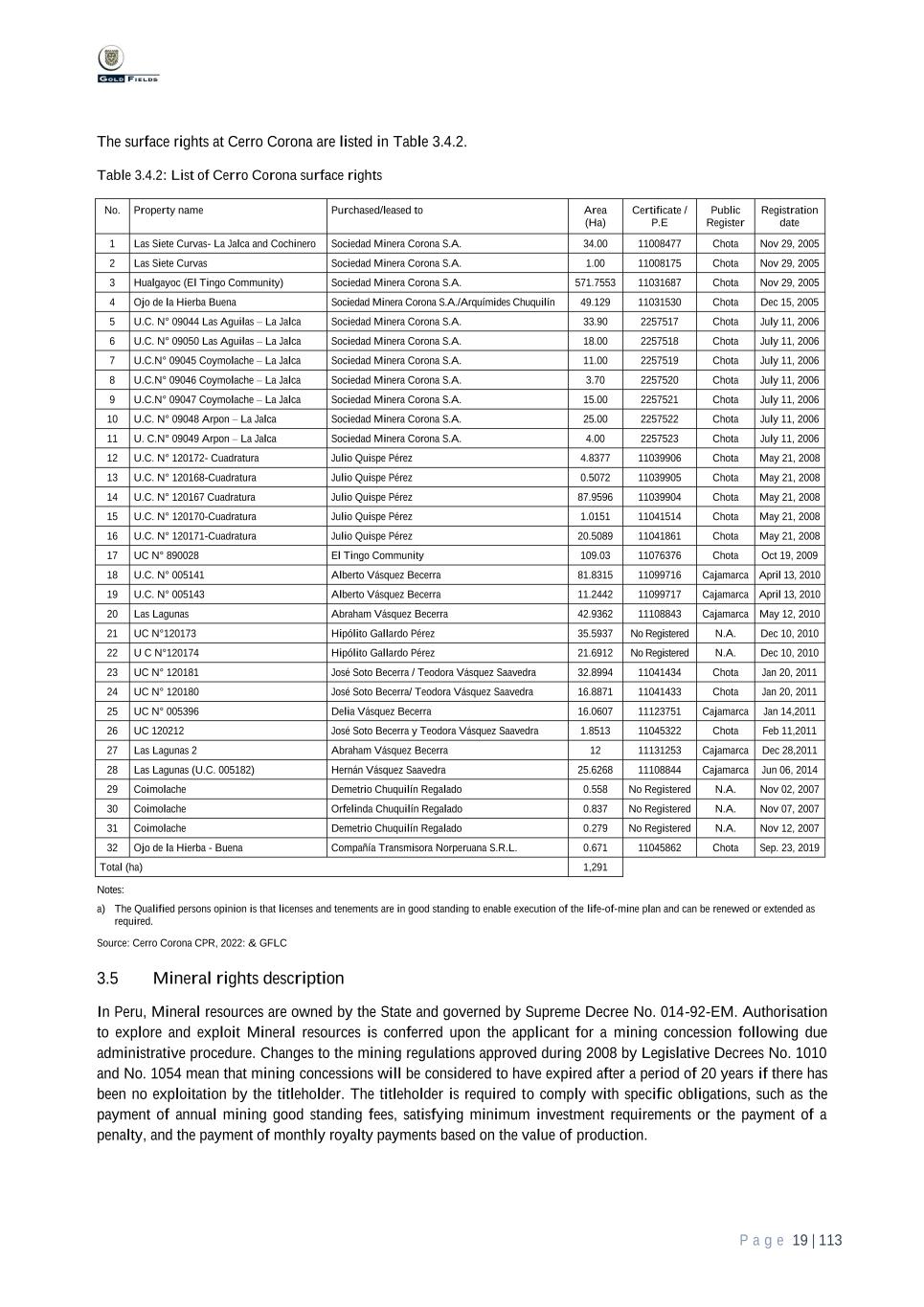
P a g e 19 | 113 The surface rights at Cerro Corona are listed in Table 3.4.2. Table 3.4.2: List of Cerro Corona surface rights No. Property name Purchased/leased to Area (Ha) Certificate / P.E Public Register Registration date 1 Las Siete Curvas- La Jalca and Cochinero Sociedad Minera Corona S.A. 34.00 11008477 Chota Nov 29, 2005 2 Las Siete Curvas Sociedad Minera Corona S.A. 1.00 11008175 Chota Nov 29, 2005 3 Hualgayoc (El Tingo Community) Sociedad Minera Corona S.A. 571.7553 11031687 Chota Nov 29, 2005 4 Ojo de la Hierba Buena Sociedad Minera Corona S.A./Arquímides Chuquilín 49.129 11031530 Chota Dec 15, 2005 5 U.C. N° 09044 Las Aguilas – La Jalca Sociedad Minera Corona S.A. 33.90 2257517 Chota July 11, 2006 6 U.C. N° 09050 Las Aguilas – La Jalca Sociedad Minera Corona S.A. 18.00 2257518 Chota July 11, 2006 7 U.C.N° 09045 Coymolache – La Jalca Sociedad Minera Corona S.A. 11.00 2257519 Chota July 11, 2006 8 U.C.N° 09046 Coymolache – La Jalca Sociedad Minera Corona S.A. 3.70 2257520 Chota July 11, 2006 9 U.C.N° 09047 Coymolache – La Jalca Sociedad Minera Corona S.A. 15.00 2257521 Chota July 11, 2006 10 U.C. N° 09048 Arpon – La Jalca Sociedad Minera Corona S.A. 25.00 2257522 Chota July 11, 2006 11 U. C.N° 09049 Arpon – La Jalca Sociedad Minera Corona S.A. 4.00 2257523 Chota July 11, 2006 12 U.C. N° 120172- Cuadratura Julio Quispe Pérez 4.8377 11039906 Chota May 21, 2008 13 U.C. N° 120168-Cuadratura Julio Quispe Pérez 0.5072 11039905 Chota May 21, 2008 14 U.C. N° 120167 Cuadratura Julio Quispe Pérez 87.9596 11039904 Chota May 21, 2008 15 U.C. N° 120170-Cuadratura Julio Quispe Pérez 1.0151 11041514 Chota May 21, 2008 16 U.C. N° 120171-Cuadratura Julio Quispe Pérez 20.5089 11041861 Chota May 21, 2008 17 UC N° 890028 El Tingo Community 109.03 11076376 Chota Oct 19, 2009 18 U.C. N° 005141 Alberto Vásquez Becerra 81.8315 11099716 Cajamarca April 13, 2010 19 U.C. N° 005143 Alberto Vásquez Becerra 11.2442 11099717 Cajamarca April 13, 2010 20 Las Lagunas Abraham Vásquez Becerra 42.9362 11108843 Cajamarca May 12, 2010 21 UC N°120173 Hipólito Gallardo Pérez 35.5937 No Registered N.A. Dec 10, 2010 22 U C N°120174 Hipólito Gallardo Pérez 21.6912 No Registered N.A. Dec 10, 2010 23 UC N° 120181 José Soto Becerra / Teodora Vásquez Saavedra 32.8994 11041434 Chota Jan 20, 2011 24 UC N° 120180 José Soto Becerra/ Teodora Vásquez Saavedra 16.8871 11041433 Chota Jan 20, 2011 25 UC N° 005396 Delia Vásquez Becerra 16.0607 11123751 Cajamarca Jan 14,2011 26 UC 120212 José Soto Becerra y Teodora Vásquez Saavedra 1.8513 11045322 Chota Feb 11,2011 27 Las Lagunas 2 Abraham Vásquez Becerra 12 11131253 Cajamarca Dec 28,2011 28 Las Lagunas (U.C. 005182) Hernán Vásquez Saavedra 25.6268 11108844 Cajamarca Jun 06, 2014 29 Coimolache Demetrio Chuquilín Regalado 0.558 No Registered N.A. Nov 02, 2007 30 Coimolache Orfelinda Chuquilín Regalado 0.837 No Registered N.A. Nov 07, 2007 31 Coimolache Demetrio Chuquilín Regalado 0.279 No Registered N.A. Nov 12, 2007 32 Ojo de la Hierba - Buena Compañía Transmisora Norperuana S.R.L. 0.671 11045862 Chota Sep. 23, 2019 Total (ha) 1,291 Notes: a) The Qualified persons opinion is that licenses and tenements are in good standing to enable execution of the life-of-mine plan and can be renewed or extended as required. Source: Cerro Corona CPR, 2022: & GFLC 3.5 Mineral rights description In Peru, Mineral resources are owned by the State and governed by Supreme Decree No. 014-92-EM. Authorisation to explore and exploit Mineral resources is conferred upon the applicant for a mining concession following due administrative procedure. Changes to the mining regulations approved during 2008 by Legislative Decrees No. 1010 and No. 1054 mean that mining concessions will be considered to have expired after a period of 20 years if there has been no exploitation by the titleholder. The titleholder is required to comply with specific obligations, such as the payment of annual mining good standing fees, satisfying minimum investment requirements or the payment of a penalty, and the payment of monthly royalty payments based on the value of production.
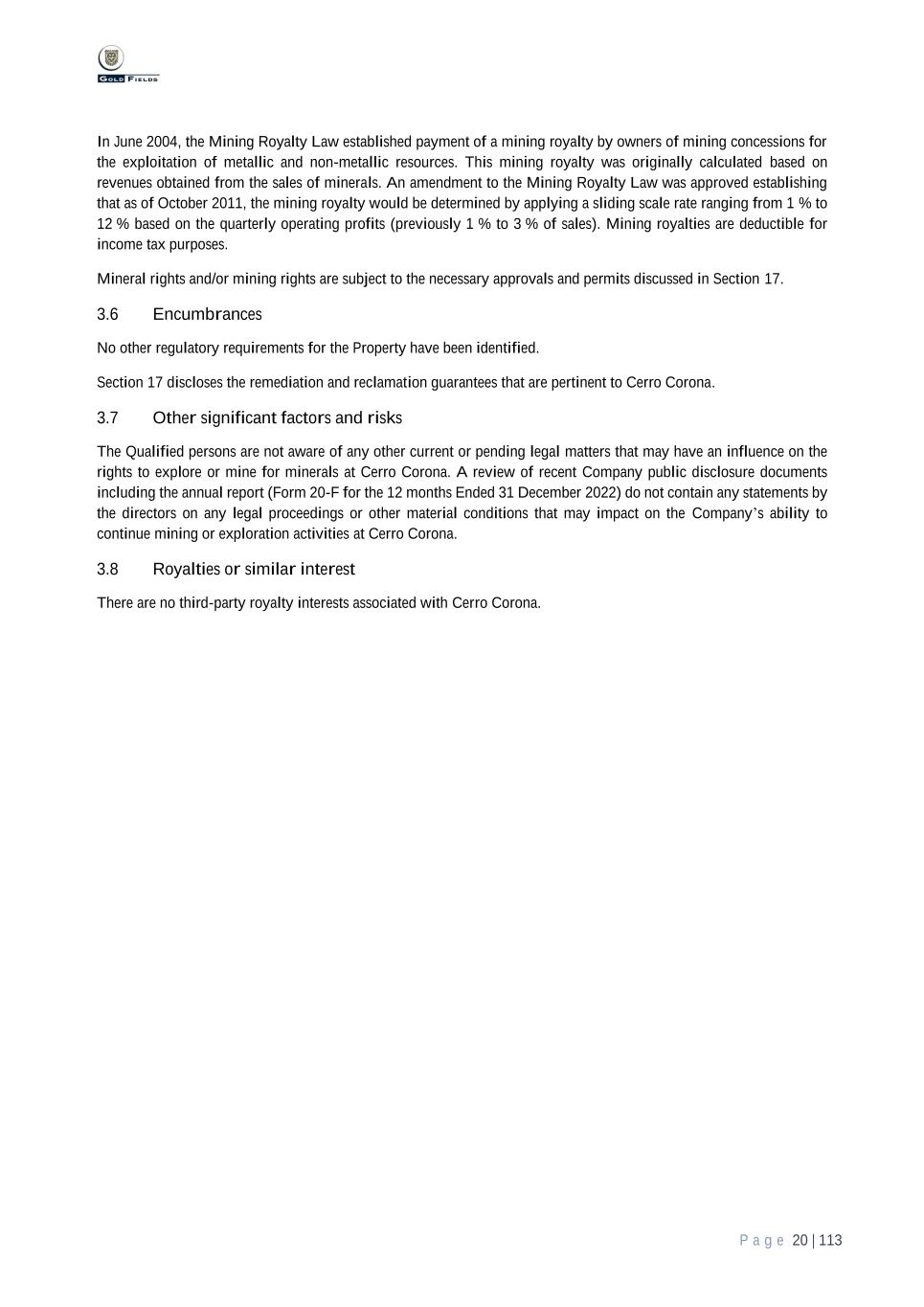
P a g e 20 | 113 In June 2004, the Mining Royalty Law established payment of a mining royalty by owners of mining concessions for the exploitation of metallic and non-metallic resources. This mining royalty was originally calculated based on revenues obtained from the sales of minerals. An amendment to the Mining Royalty Law was approved establishing that as of October 2011, the mining royalty would be determined by applying a sliding scale rate ranging from 1 % to 12 % based on the quarterly operating profits (previously 1 % to 3 % of sales). Mining royalties are deductible for income tax purposes. Mineral rights and/or mining rights are subject to the necessary approvals and permits discussed in Section 17. 3.6 Encumbrances No other regulatory requirements for the Property have been identified. Section 17 discloses the remediation and reclamation guarantees that are pertinent to Cerro Corona. 3.7 Other significant factors and risks The Qualified persons are not aware of any other current or pending legal matters that may have an influence on the rights to explore or mine for minerals at Cerro Corona. A review of recent Company public disclosure documents including the annual report (Form 20-F for the 12 months Ended 31 December 2022) do not contain any statements by the directors on any legal proceedings or other material conditions that may impact on the Company’s ability to continue mining or exploration activities at Cerro Corona. 3.8 Royalties or similar interest There are no third-party royalty interests associated with Cerro Corona.
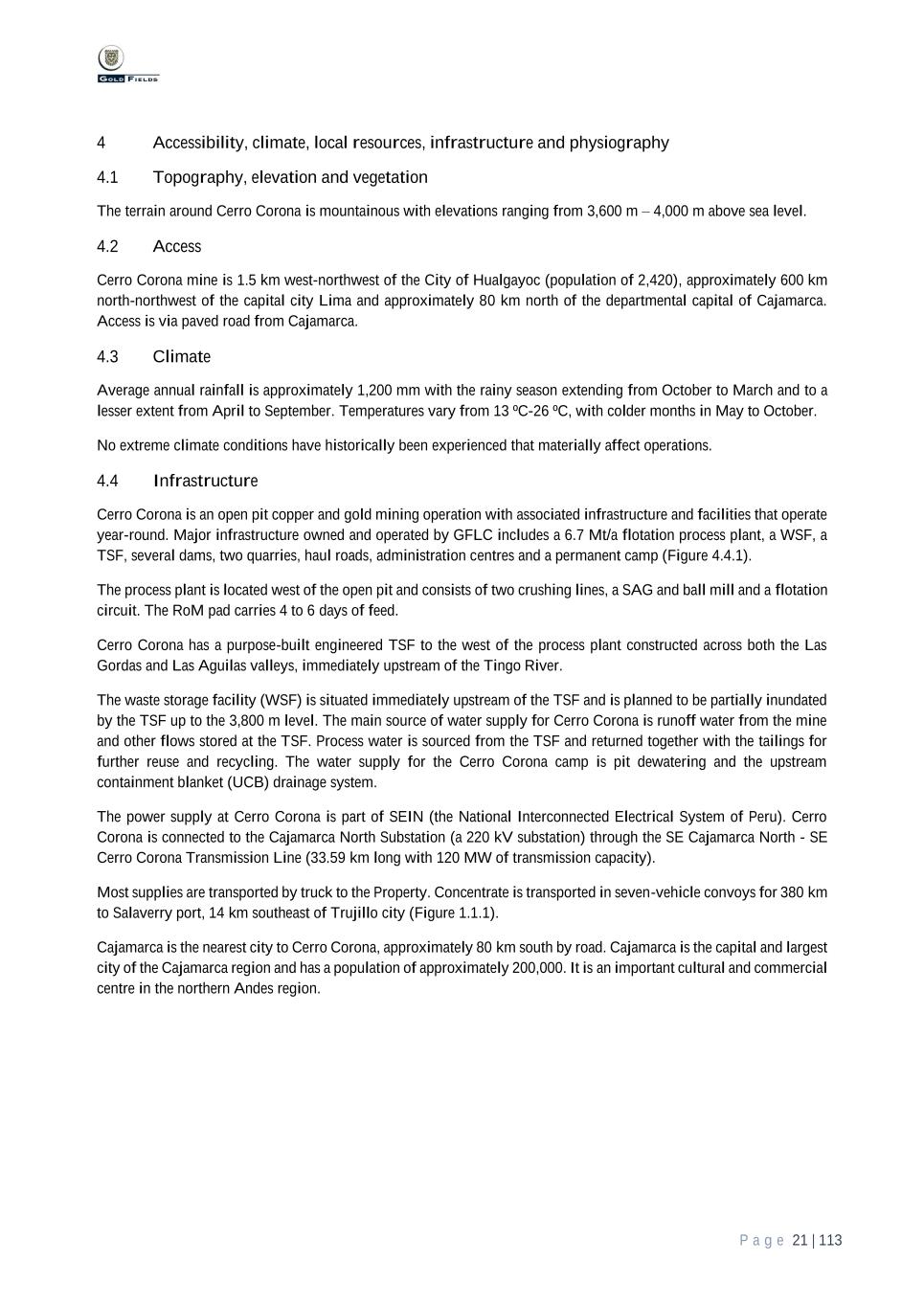
P a g e 21 | 113 4 Accessibility, climate, local resources, infrastructure and physiography 4.1 Topography, elevation and vegetation The terrain around Cerro Corona is mountainous with elevations ranging from 3,600 m – 4,000 m above sea level. 4.2 Access Cerro Corona mine is 1.5 km west-northwest of the City of Hualgayoc (population of 2,420), approximately 600 km north-northwest of the capital city Lima and approximately 80 km north of the departmental capital of Cajamarca. Access is via paved road from Cajamarca. 4.3 Climate Average annual rainfall is approximately 1,200 mm with the rainy season extending from October to March and to a lesser extent from April to September. Temperatures vary from 13 ºC-26 ºC, with colder months in May to October. No extreme climate conditions have historically been experienced that materially affect operations. 4.4 Infrastructure Cerro Corona is an open pit copper and gold mining operation with associated infrastructure and facilities that operate year-round. Major infrastructure owned and operated by GFLC includes a 6.7 Mt/a flotation process plant, a WSF, a TSF, several dams, two quarries, haul roads, administration centres and a permanent camp (Figure 4.4.1). The process plant is located west of the open pit and consists of two crushing lines, a SAG and ball mill and a flotation circuit. The RoM pad carries 4 to 6 days of feed. Cerro Corona has a purpose-built engineered TSF to the west of the process plant constructed across both the Las Gordas and Las Aguilas valleys, immediately upstream of the Tingo River. The waste storage facility (WSF) is situated immediately upstream of the TSF and is planned to be partially inundated by the TSF up to the 3,800 m level. The main source of water supply for Cerro Corona is runoff water from the mine and other flows stored at the TSF. Process water is sourced from the TSF and returned together with the tailings for further reuse and recycling. The water supply for the Cerro Corona camp is pit dewatering and the upstream containment blanket (UCB) drainage system. The power supply at Cerro Corona is part of SEIN (the National Interconnected Electrical System of Peru). Cerro Corona is connected to the Cajamarca North Substation (a 220 kV substation) through the SE Cajamarca North - SE Cerro Corona Transmission Line (33.59 km long with 120 MW of transmission capacity). Most supplies are transported by truck to the Property. Concentrate is transported in seven-vehicle convoys for 380 km to Salaverry port, 14 km southeast of Trujillo city (Figure 1.1.1). Cajamarca is the nearest city to Cerro Corona, approximately 80 km south by road. Cajamarca is the capital and largest city of the Cajamarca region and has a population of approximately 200,000. It is an important cultural and commercial centre in the northern Andes region.
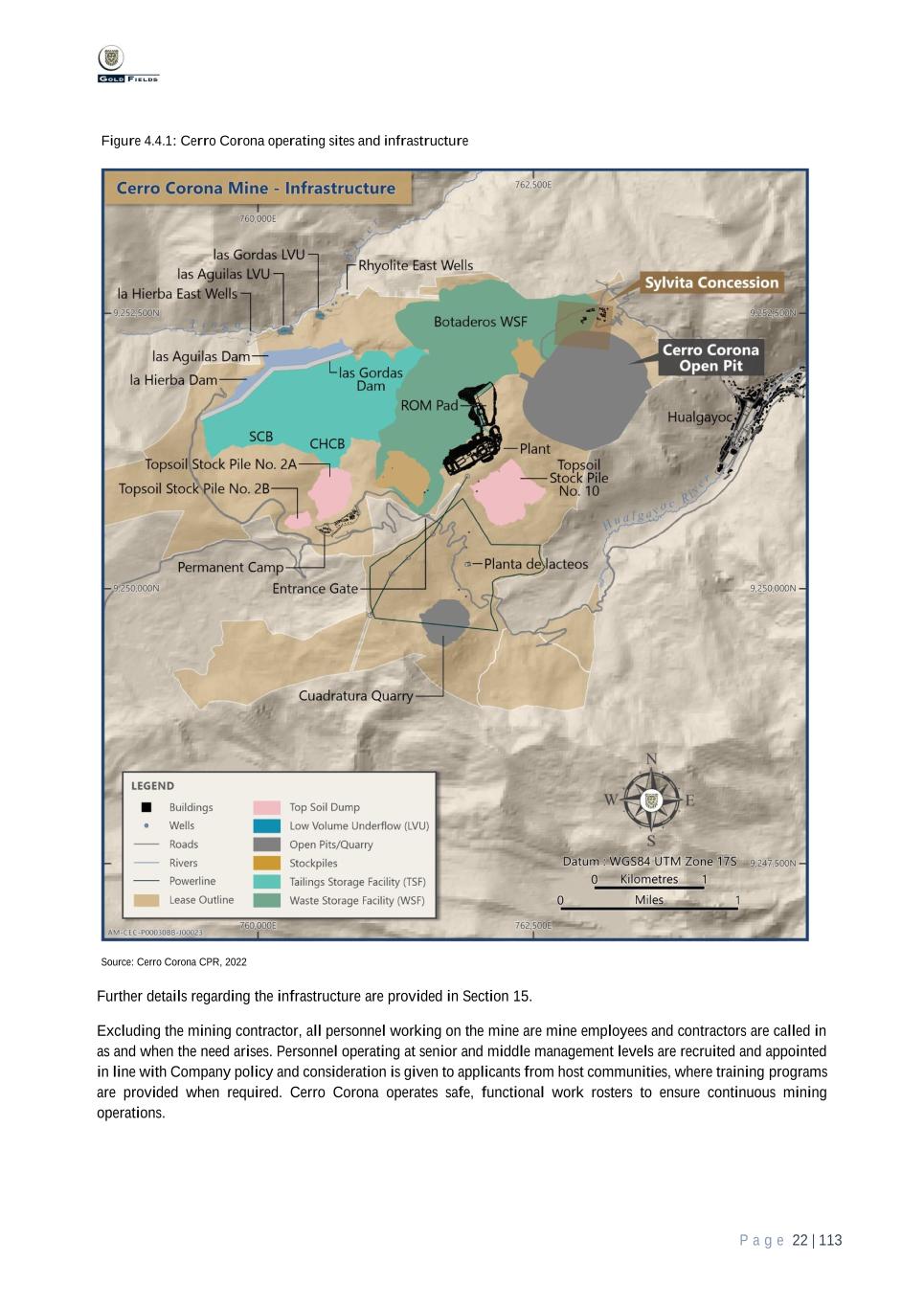
P a g e 22 | 113 Figure 4.4.1: Cerro Corona operating sites and infrastructure Source: Cerro Corona CPR, 2022 Further details regarding the infrastructure are provided in Section 15. Excluding the mining contractor, all personnel working on the mine are mine employees and contractors are called in as and when the need arises. Personnel operating at senior and middle management levels are recruited and appointed in line with Company policy and consideration is given to applicants from host communities, where training programs are provided when required. Cerro Corona operates safe, functional work rosters to ensure continuous mining operations.
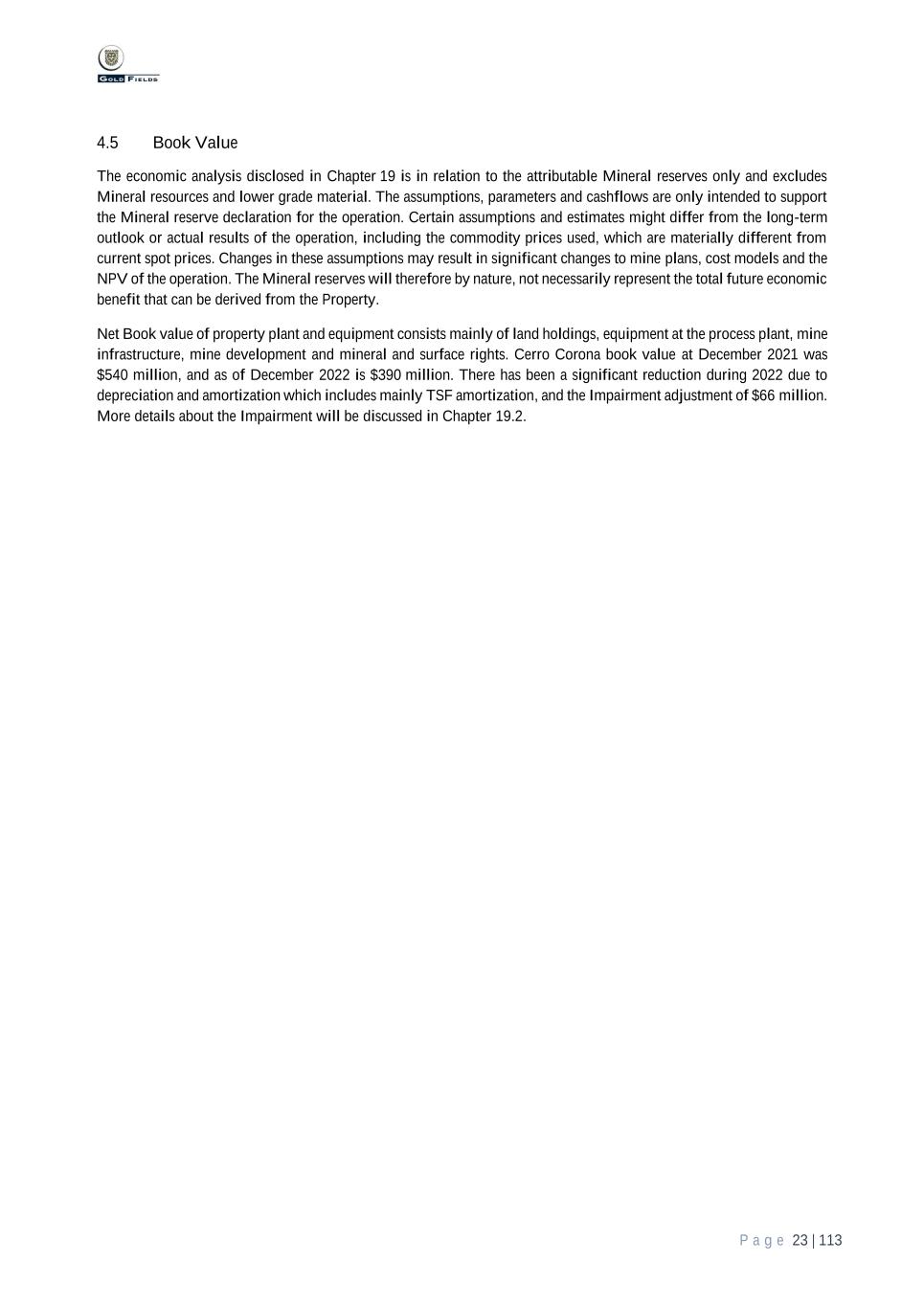
P a g e 23 | 113 4.5 Book Value The economic analysis disclosed in Chapter 19 is in relation to the attributable Mineral reserves only and excludes Mineral resources and lower grade material. The assumptions, parameters and cashflows are only intended to support the Mineral reserve declaration for the operation. Certain assumptions and estimates might differ from the long-term outlook or actual results of the operation, including the commodity prices used, which are materially different from current spot prices. Changes in these assumptions may result in significant changes to mine plans, cost models and the NPV of the operation. The Mineral reserves will therefore by nature, not necessarily represent the total future economic benefit that can be derived from the Property. Net Book value of property plant and equipment consists mainly of land holdings, equipment at the process plant, mine infrastructure, mine development and mineral and surface rights. Cerro Corona book value at December 2021 was $540 million, and as of December 2022 is $390 million. There has been a significant reduction during 2022 due to depreciation and amortization which includes mainly TSF amortization, and the Impairment adjustment of $66 million. More details about the Impairment will be discussed in Chapter 19.2.

P a g e 24 | 113 5 History Exploration by BRGM in 1979 identified porphyry style mineralisation in the Cerro Corona area. Sampling by the Gubbins Group during 1992 and 1993 identified gold mineralisation in the leached cap of the Cerro Corona deposit. Copper-gold porphyry mineralisation was discovered through the drilling of nine diamond core (DD) holes and completion of an exploration campaign add it into the mineralised zone. From 1994 to 1996, Barrick Gold drilled 140 reverse circulation (RC) drillholes (for 9,476 m) and 118 DD holes (for 35,254 m) and completed a draft feasibility study. From 1997 to 1998, RGC Limited drilled six DD holes (for 2,760 m) and completed a preliminary feasibility study. In 2001, Minproc completed a further feasibility study, from which a Mineral reserve of ~95 Mt was reported. In 2003, Gold Fields signed a definitive agreement with Sociedad Minera Corona S.A. for the purchase of an 80 % interest in the Cerro Corona deposit and adjoining mining concessions. The Environmental Impact Assessment (EIA) was approved in December 2005 and the purchase transaction for the Property was completed in January 2006. Mine construction commenced in May 2006 and building of the Las Gordas tailings dam and quarrying for the relevant construction material commenced in 2007. The mine has been in production since August 2008 and utilises open pit mining and sulphide flotation to produce an auriferous copper concentrate. Gold Fields increased its economic interest in Cerro Corona to 98.6 % in 2012 and to 99.53 % in 2013. A feasibility study for the LOM extension to 2030 was completed in 2019. The recent production performance of Cerro Corona is summarised in Table 12.2.2. A total of 637 holes for 118,958 m have been drilled at Cerro Corona from 1993 to 2022. The 2020 drilling campaign was not executed due to the COVID-19 pandemic. Further details on the recent exploration activities at Cerro Corona are provided in Section 7.

P a g e 25 | 113 6 Geological setting, mineralisation and deposit 6.1 Geological setting • The Cerro Corona copper-gold porphyry is one of 14 known porphyry copper-gold-molybdenum deposits and 19 epithermal gold-silver deposits located in the Cajamarca Metallogenic Province (CMP) of northern Peru. There are two well-mineralised districts within the CMP: • The Yanacocha district in the south of the province, which is host to what once was the largest producing gold mine in South America. • The Hualgayoc mining district in the north, which is one of the oldest mining districts in Peru and is best known for its historic silver production and more recent base metal production. The Hualgayoc district has been an important silver producing area since Inca times, with more than 50 Moz of silver and significant amounts of lead, zinc and copper produced from vein and manto type deposits since the Spanish conquest in the 16th century. The Hualgayoc mining town was established in 1771. The porphyry and epithermal deposits in the CMP are part of the extensive Miocene metallogenic belt of central and northern Peru. This belt is rapidly becoming recognised for its prolific gold metallogeny and is host to some of the largest gold mines recently discovered and exploited in South America. These mines include Yanacocha (>40 Moz Au), Pierina (9 Moz Au), Lagunas Norte (previously known as Alta Chicama, >12 Moz Au) and now Cerro Corona (>6 Moz AuEq.). The oldest rocks are Paleozoic to Mesozoic platform sedimentary rocks, and include Lower to Upper Cretaceous strata, beginning with sandstone of the Gollarisquizga Formation, overlain by increasingly calcareous strata of the Inca, Chulec, Pariatambo, Yumagual and Mujarrun Formations and ending with the Cajamarca Formation. These are unconformably overlain by a thick and extensive sequence of volcanic rocks of Eocene to Miocene age known colloquially as the Calipuy Volcanics (Figure 6.1.1). The trend of the Andean fold belt is cut by a series of northeast- trending trans-Andean faults, some with a sinistral sense of movement. These northeast-trending structures have been identified as a 30–40 km wide belt called the Chicama-Yanacocha Corridor. Figure 6.1.1: Cerro Corona regional geology Source: Cerro Corona CPR, 2022
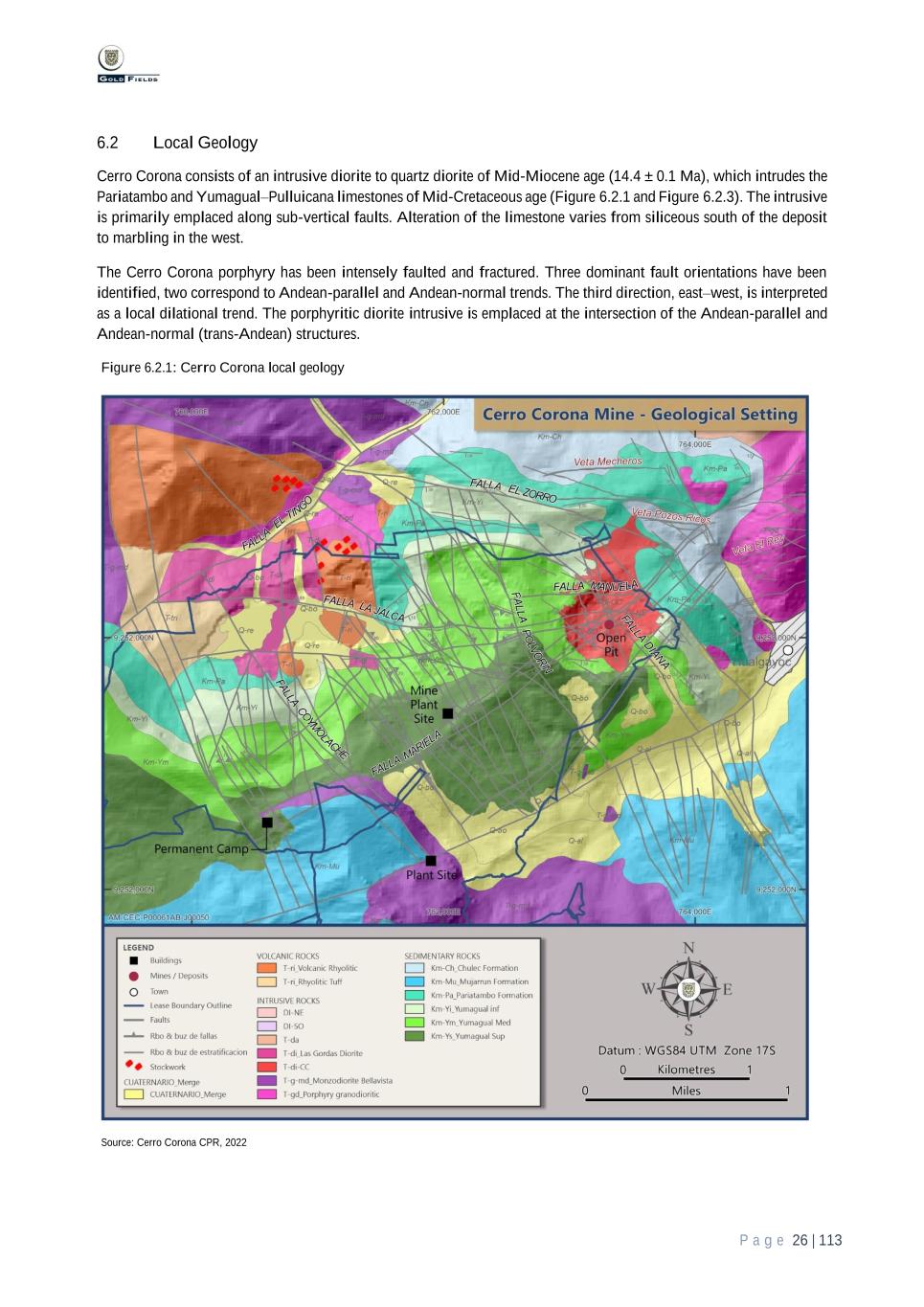
P a g e 26 | 113 6.2 Local Geology Cerro Corona consists of an intrusive diorite to quartz diorite of Mid-Miocene age (14.4 ± 0.1 Ma), which intrudes the Pariatambo and Yumagual–Pulluicana limestones of Mid-Cretaceous age (Figure 6.2.1 and Figure 6.2.3). The intrusive is primarily emplaced along sub-vertical faults. Alteration of the limestone varies from siliceous south of the deposit to marbling in the west. The Cerro Corona porphyry has been intensely faulted and fractured. Three dominant fault orientations have been identified, two correspond to Andean-parallel and Andean-normal trends. The third direction, east–west, is interpreted as a local dilational trend. The porphyritic diorite intrusive is emplaced at the intersection of the Andean-parallel and Andean-normal (trans-Andean) structures. Figure 6.2.1: Cerro Corona local geology Source: Cerro Corona CPR, 2022

P a g e 27 | 113 Figure 6.2.2: Schematic stratigraphic column of Cajamarca district Source: Cerro Corona CPR, 2022

P a g e 28 | 113 Figure 6.2.3 : Geological section through the Cerro Corona pit looking north-west Source: Cerro Corona CPR, 2022 The trans-Andean fault trend has an orientation similar to the northeast–southwest-trending Chicama-Yanacocha Corridor. At Cerro Corona, this direction is referred to as the Mariela Fault trend. The Mariela Fault was identified as a northeast–southwest-oriented fault cutting the peak of Cerro Corona Mountain, and this fault along with sub-parallel fault structures are important to understanding the distribution of fracturing, stockwork veining and mineralisation at Cerro Corona. A distinctive feature of the Mariela Fault trend is that it corresponds to a prevalent direction of sulphur flooding which extends from the intrusive diorite into the limestone at the south, resulting in a zone of intense sulphide concentration in limestone. The Andean-parallel fault direction at Cerro Corona is referred to as the Diana Fault trend. It has a northwest–southeast orientation and dips steeply to the northeast. 6.3 Mineralisation Cerro Corona is a copper-gold porphyry type deposit, with some epithermal facies at the top of its volcanic column, hosted by a sub-vertical, cylindrical-shape diorite porphyry (600-700 m in diameter). The intrusion has undergone significant meteoric processes at the top of the column, generating an upper level known as the leached cap, underlain by mixed and copper enriched zones which overlie the main hypogene portion of the deposit. The gold-only leached cap is free of copper, which is concentrated in the supergene enriched horizons. Around 80 % of the orebody is hypogene and the remaining 20 % is oxide or supergene, notwithstanding that most of the supergene and oxide ore has already been mined and the remnant ore is primary sulphide in nature. The Cerro Corona porphyry system is strongly altered, ranging from propylitic in the distal zones to predominantly argillic in the central zone. Varying proportions of clay-sericite are encountered and potassic alteration intensity increases with depth.

P a g e 29 | 113 The entire system contains a strongly developed stockwork system. The stockwork has an annular disposition within the porphyry, with a low-grade or barren zone in the central part. The upper oxidised zone of the porphyry system is up to 40 m thick and is characterised by the presence of iron oxides (goethite > jarosite > hematite + tenorite). The supergene zone contains chalcocite-covellite occurring as disseminated nodes and infill within fractures and quartz veins. Bornite occurs less frequently and on a local scale, copper sulphate is impregnated into the host rock. At depth, the hypogene zone is characterised by sulphide mineralisation as disseminated nodes, small patches, infill in fractures and within stockwork quartz veins. The mineralisation within the stockwork is mainly pyrite-marcasite- chalcopyrite + bornite + covellite + hematite + magnetite. The veins and veinlets have been classified into the following types: • Type A: Early veinlets, millimetre to centimetre-wide, containing magnetite-specular hematite-chalcopyrite- bornite-pyrite. • Type B: Intermediate-age, millimetre to centimetre wide, containing quartz-magnetite-specular hematite- chalcopyrite. • Type D: Late veinlets, centimetre to tens of centimetre-wide, containing quartz-pyrite-chalcopyrite. • Type M: Late magnetite-rich veins and veinlets clearly identified by their cross-cutting relationships with younger veining. Two low-grade or barren zones are present within the deposit. The “NE Barren Core” is located in the north-eastern quarter of the deposit and is irregular in shape, encompassing approximately 50,000 m² at the surface. The NE Barren Core is characterised by plagioclase-biotite ± quartz porphyry with large euhedral biotite and plagioclase phenocrysts in an aphanitic matrix. The porphyry has been subjected to argillic alteration of the plagioclase phenocrysts. Rare quartz veinlets contain minor pyrite and traces of chalcopyrite. Deeper drillhole intercepts around the NE Barren Core show weak secondary biotite alteration and incipient to moderate K-feldspar flooding, and discontinuous quartz veinlets containing weak pyrite-chalcopyrite ± specularite mineralisation. The contact relationship with the surrounding stockwork-veined and mineralised porphyry has not been demonstrated. The “SW Barren Core” is in the southwestern portion of the deposit. It is entirely enclosed by the mineralised annulus and encompasses an area approximately 200 m long in a north–south direction and 50-100 m wide in an east-west direction. The SW Barren Core is characterised in part by strongly altered intrusive diorite with strong quartz-pyrite veining and in part by the presence of plagioclase-biotite ± quartz porphyry similar in appearance to the weakly altered porphyry present in the NE Barren Core. No copper or gold mineralisation is present within the SW Barren Core except for a small high-grade zone at approximately 225 m depth in the central part of the barren zone. Hydrothermal breccias with quartz-pyrite dominant matrices have been identified in drill core near the inferred limits of the SW Barren Core but the precise contact relationship has not been established. The interpreted sequence of intrusions based on field mapping and extensive blast hole logging and sampling is shown in Figure 6.3.1. The Cerro Corona intrusive complex is defined by at least four mineralised intrusive pulses preceded by a former dry intrusion (intrusion 1 in Figure 6.3.1: Sequence of intrusions by mineralised halo interpretation). The first (barren) intrusion acted as a sealing layer for the surrounding sedimentary rocks, yielding only marbleisation and at the same time preventing later mineralising fluids from penetrating the limestones to generate skarn. The pulses have very diffuse contacts between them with subsequent alteration making it difficult to differentiate boundaries in the mapping process. Nevertheless, a previously executed a petrographic study on 30 samples well distributed in the mine did not find significant differences between them. This supports the idea that all intrusions came from a single magma chamber with slight differences due to magmatic differentiation.

P a g e 30 | 113 Figure 6.3.1: Sequence of intrusions by mineralised halo interpretation Source: Cerro Corona CPR, 2022 The footprint of metal distribution is in the outer portion of each intrusion and the most recent and best preserved is pulse 5 in the southwest of the deposit. Pulse 5 cross-cuts all the former ones (Figure 6.3.1). All pulses are intensively mineralised on their external crust preserving a barren or lower grade core in the central portion. The annular shape of the mineralisation distributed in the outer part of the intrusive bodies results from violent quenching of the external halo during rapid magma ascent to the surface. This causes intense fracturing and dilational intrusions at the contact zone, creating permeability and then allowing the flow of hydrothermal fluids responsible for the alteration and hypogene mineralisation throughout the shattered portion of the rock (outer halos). Cores remained barren or at most poorly mineralised except for rare structures which allowed the flow of alteration and mineralising fluids to the inner part of the pulses without significant extension and economic potential. Although structural activity has played a key role by preparing the geological setting prior to ore emplacement allowing porphyritic intrusions and subsequent hydrothermal flow, surface mapping shows that there is no significant movement or disruption of the orebodies caused by fault displacement. Figure 6.3.1 shows that the orebodies are not disrupted by faulting but are truncated by each other.

P a g e 31 | 113 7 Exploration 7.1 Exploration at Cerro Corona Latest exploration efforts at Cerro Corona in 2021 were focused on investigation low resistivity geophysical anomalies located on the southwest wall of the pit at the contact between the porphyry and the host calcareous sequences of the lower Yumagual-Pariatambo. In 2022, 16 Diamond drillholes were drilled to test geological continuity and increase knowledge on structural complexity on West and North pit areas. 7.2 Drilling 7.2.1 Type and extent Most of the resource definition drilling was carried out by Barrick Gold (1994) and GFLC from 2010 (Table 7.2.1). The majority of deep drilling into the hypogene mineralisation utilised diamond core (DD). In 2012, GFLC drilled 6,713 m to define mineralisation below the final pit design as it was defined at the time. A further 1,524 m was drilled for hydrogeological investigations. In 2013, GFLC drilled an additional 1,456 m for hydrogeological and construction investigations and a further 2,572 m in 2014 for geological and geotechnical purposes. A total of 2,858 m of drilling was completed in late 2015 and 2016 to improve confidence in the modelled metal distribution definition of mineralised bodies. The 2017 drilling program totalling 2,042 m was focused mainly on geotechnical and hydrological investigations. The 2018 campaign included 4,246 m and in 2019 a total of 10,595 m of drilling was completed in two phases. The 2020 drilling campaign was curtailed due to COVID-19 pandemic restrictions. During 2021 GFLC drilled 8,005 m in two phases to cover three objectives: the first to confirm the projection of arsenic-rich structures at depth in the western sector of the porphyry, the second to obtain additional geotechnical information and the third primarily for exploration, testing resistivity anomalies at depth and confirming skarn mineralization at the contact between porphyry and limestone sequences in southwest. In 2022 a total of 3,750 m was drilled to obtain additional geological and geotechnical information within the pit. Table 7.2.1: Historical drilling by type and company Year Company Hole type Angle # holes Length (m) 1993 SMC DDH VERT 9 2,227.50 1994 Barrick DDH ANG 59 17,488.01 Barrick DDH VERT 59 17,765.97 Barrick RCD ANG 13 870.21 Barrick RCD VERT 127 8,606.07 Barrick RCD VERT 4 141.35 1997 RGC DDH ANG 6 2,760.30 2000 Minproc DDH ANG 1 115.00 Minproc DDH VERT 8 709.80 SMC RCD VERT 6 1,184.00 2003 Gold Fields DDH ANG 1 120.25 Gold Fields DDH VERT 3 380.00 2005 Gold Fields DDH VERT 5 1,128.00 Gold Fields RCD VERT 17 3,420.00 2006 Gold Fields DDH VERT 3 638.00 2007 Gold Fields DDH ANG 8 834.23 Gold Fields RCD VERT 4 842.00 2009 Gold Fields RCD ANG 2 60.00 Gold Fields RCD VERT 53 1,589.00 2010 Gold Fields DDH ANG 39 5,917.55 Gold Fields RCD VERT 2 406.00
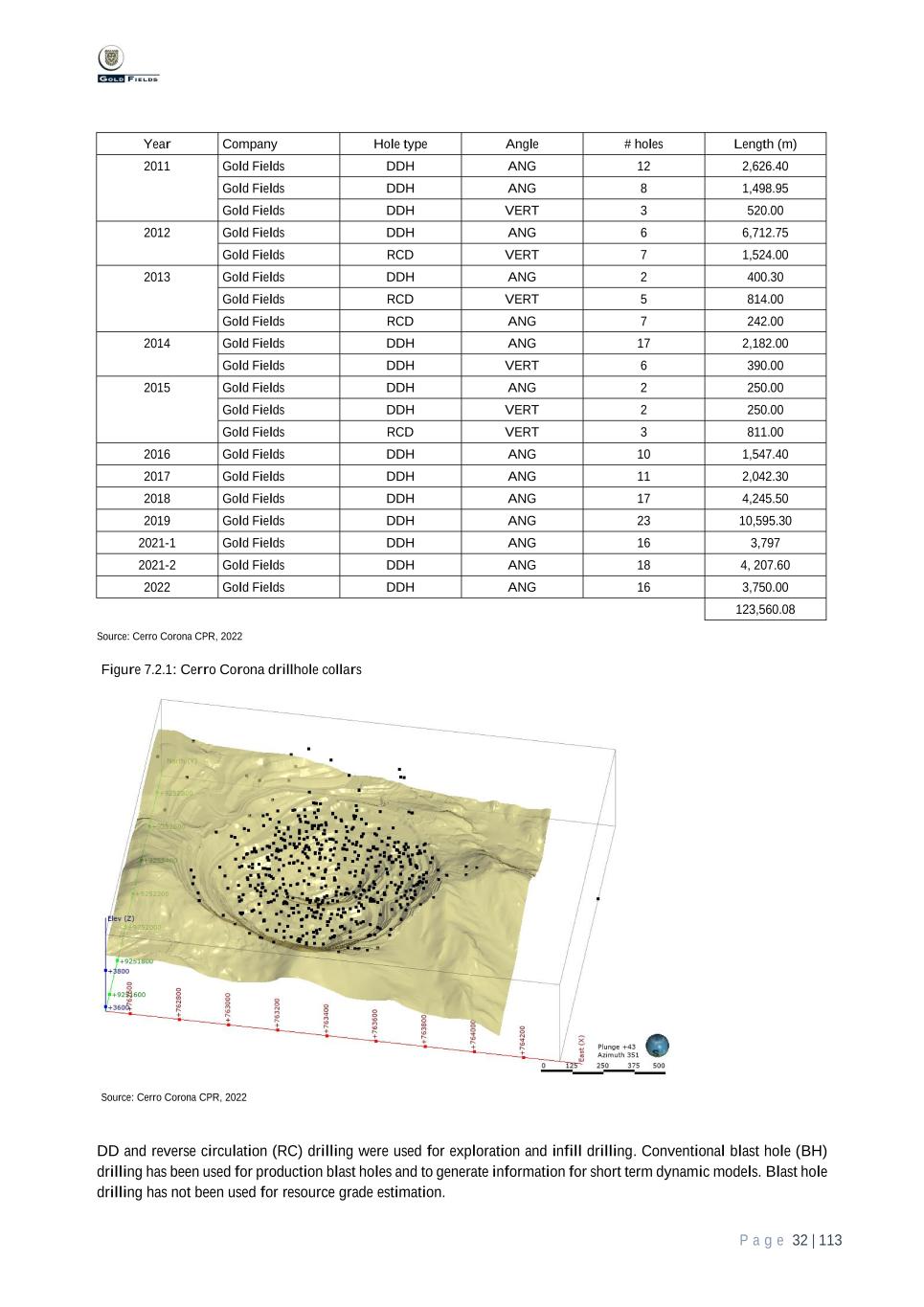
P a g e 32 | 113 Year Company Hole type Angle # holes Length (m) 2011 Gold Fields DDH ANG 12 2,626.40 Gold Fields DDH ANG 8 1,498.95 Gold Fields DDH VERT 3 520.00 2012 Gold Fields DDH ANG 6 6,712.75 Gold Fields RCD VERT 7 1,524.00 2013 Gold Fields DDH ANG 2 400.30 Gold Fields RCD VERT 5 814.00 Gold Fields RCD ANG 7 242.00 2014 Gold Fields DDH ANG 17 2,182.00 Gold Fields DDH VERT 6 390.00 2015 Gold Fields DDH ANG 2 250.00 Gold Fields DDH VERT 2 250.00 Gold Fields RCD VERT 3 811.00 2016 Gold Fields DDH ANG 10 1,547.40 2017 Gold Fields DDH ANG 11 2,042.30 2018 Gold Fields DDH ANG 17 4,245.50 2019 Gold Fields DDH ANG 23 10,595.30 2021-1 Gold Fields DDH ANG 16 3,797 2021-2 Gold Fields DDH ANG 18 4, 207.60 2022 Gold Fields DDH ANG 16 3,750.00 123,560.08 Source: Cerro Corona CPR, 2022 Figure 7.2.1: Cerro Corona drillhole collars Source: Cerro Corona CPR, 2022 DD and reverse circulation (RC) drilling were used for exploration and infill drilling. Conventional blast hole (BH) drilling has been used for production blast holes and to generate information for short term dynamic models. Blast hole drilling has not been used for resource grade estimation.

P a g e 33 | 113 Vertical and angled DD drilling was used in the exploratory stages to obtain accurate geological information and in infill drilling campaigns for geotechnical or structural information, including the orientation of structures. PQ diameter core was obtained at the start of drillholes or where a larger sample was needed (e.g., for geometallurgical testwork). HQ was the most common hole diameter with NQ mainly restricted to deep holes. RC drilling was typically used where the geology had already been assessed by previous DD drilling to increase data density for grade and metallurgical parameters. RC holes were drilled vertically at a 4.5 inch diameter. Exploration and resource drilling is not carried out on a regular grid but can be regarded as being nominally on a 35 m to 45 m spacing. Collar locations are shown in Figure 7.2.1. The BH drilling is on a 6 m by 5 m pattern. In the opinion of the Qualified person: a) All procedures and parameters applied to the surveys and investigations are appropriate for the style of mineralisation being prospected. b) The exploration programs have confirmed continuity of geology and controls on gold mineralisation in key areas. c) Based on the results of the 2022 exploration campaign a 2023 exploration budget has been approved. d) Individual drill results are not presented in this document but are included in the models supporting the Mineral resources and reserves. 7.2.2 Procedures For all drilling conducted by GFLC, DD core and RC chips are logged for lithology, alteration, mineralisation and geotechnical parameters at the drill rig. After field logging the drill core is transported to the core shed where a team of geologists complete detailed logging using the Cerro Corona digital logging system (Geospark®). Dedicated geotechnical staff complete detailed geotechnical logging. DD core recovery is usually around 99 %, except where there are open fractures, cavities or clayey horizons. RC sample recovery is assessed as high. For DD holes, the core is split with one half of the core collected for assaying and the other half stored as an archive sample. Splitting is carried out using a diamond saw with the cut made perpendicular to the orientation of main structures. Sampling is commonly at 2 m lengths but may vary between a minimum of 1 m and maximum of 3 m to honour geological variability. For RC holes, the drill rig uses a cyclone and splitter for sampling. Samples are taken at 2 m intervals with the drill cuttings (chips) split at the cyclone to obtain a 5-8 kg samples that are sent to the analytical laboratory. All BHs are logged and sampled in a single composite sample from the cone around the collar of the hole. The sample is collected by channelling perpendicular to the cone using hand shovels from opposite sides. Where required, a duplicate sample is taken from channels along the opposing direction. In both cases, samples must have a minimum weight of 5 kg representing about 0.6 % of the primary sample. DD half core and RC pulps and rejects are stored in the Cerro Corona core shed located at Cajamarca, where the sawing, sampling and logging is also conducted. In the case of the BHs, rejects are retained for around three months in a temporary warehouse on-site. Prior to drilling the DD and RC drill rigs are aligned to the planned azimuth and inclination of the hole. After a hole is completed, a downhole gyroscopic survey is carried out to measure deflection. Drillhole deviations are targeted to be below 0.12 °/m in azimuth and below 0.06 °/m in dip. Drillholes for hydrogeological investigation are not surveyed as they are all vertical. Downhole surveys are also not performed on production blast holes as the holes are vertical and typically drilled to 10 m to 20 m depth.

P a g e 34 | 113 7.2.3 Results In the opinion of the Qualified person: a) The drillhole surveys are adequate by type and length for the intended purpose. b) Utilising orientated core significantly enhances recorded information to assist with 3D modelling. c) The drillhole database and subsequent modelling aligns to core recovery losses and should not cause material errors. d) Post QA/QC screening and validation, exploration results are incorporated into the estimation of Mineral resources; the categorisation of Mineral resources is described in Chapter 11. e) Validated exploration results are used in the Mineral resource estimation. f) Individual exploration drillhole information is not viewed as significant or material to the Mineral resource and Mineral reserve reporting at Cerro Corona and consequently exploration data is not presented in its entirety. g) All exploration activities, including drilling, database management, validation and QA/QC, prior to incorporating relevant data into the resource modelling and estimation process, is viewed as sufficient, appropriate, technically assured and suitable to support Mineral resource estimates. h) All drilling and exploration field activities are supervised to ensure health and safety and maintain appropriate technical standards. 7.3 Hydrogeology Base-line hydrogeological studies have been carried out before and during the Cerro Corona operation to support mine drainage models and to maintain adequate operational conditions and the control of the phreatic surface. Simulation models allow prediction of drainage volumes and pore pressures on the slopes and analyse the influence of mining drainage to establish the water impact and the area of influence. At Cerro Corona hydrological studies have been carried out by: • Knight Piésold developed the EIA in 2005, which presents compiled data on hydraulic conductivity and storage coefficients obtained from cased and uncased boreholes and wells. • WMC completed 3 reports in 2006 characterisation characterising the hydrological, hydrogeological and hydrochemical baseline for mining planning. These included drilling piezometers and production wells as well as analysis of pumping tests to characterise supply to the camp and to design the pit drainage system. During the operational stage since 2008, ongoing hydrogeological investigations have been carried out to gather additional data on the subsoil to reduce the uncertainty in the conceptual hydrogeological model, supporting environmental instruments and operational projects as well as to predict the response of the system to the operation and the future needs of the main facilities. Additionally, between 2017 and 2019, further studies were carried out to evaluate the hydrogeological containment level for the in-pit TSF Project. These include the drilling and installation of additional piezometers, geophysical surveys, identification and mapping of karst forms, tracer tests and groundwater quality sampling. Current hydrogeological studies at Cerro Corona have allowed an update of the conceptual model and numerical modelling of flow and transport during operations supporting the expansion of operations to 2030, with the collection of low-grade material until 2025 and the use of the pit for the storage of tailings from 2026. This describes the functioning of the system both under natural conditions and during operation. The model also evaluates the influence of mining on the hydrogeological system, including the main components of the pit, WSF and TSF. This is supported by the hydrogeological data accumulated over time and the combined interpretation of geology data, spring inventory, inventory of karst forms, piezometry data, groundwater hydrochemistry supporting a robust model.
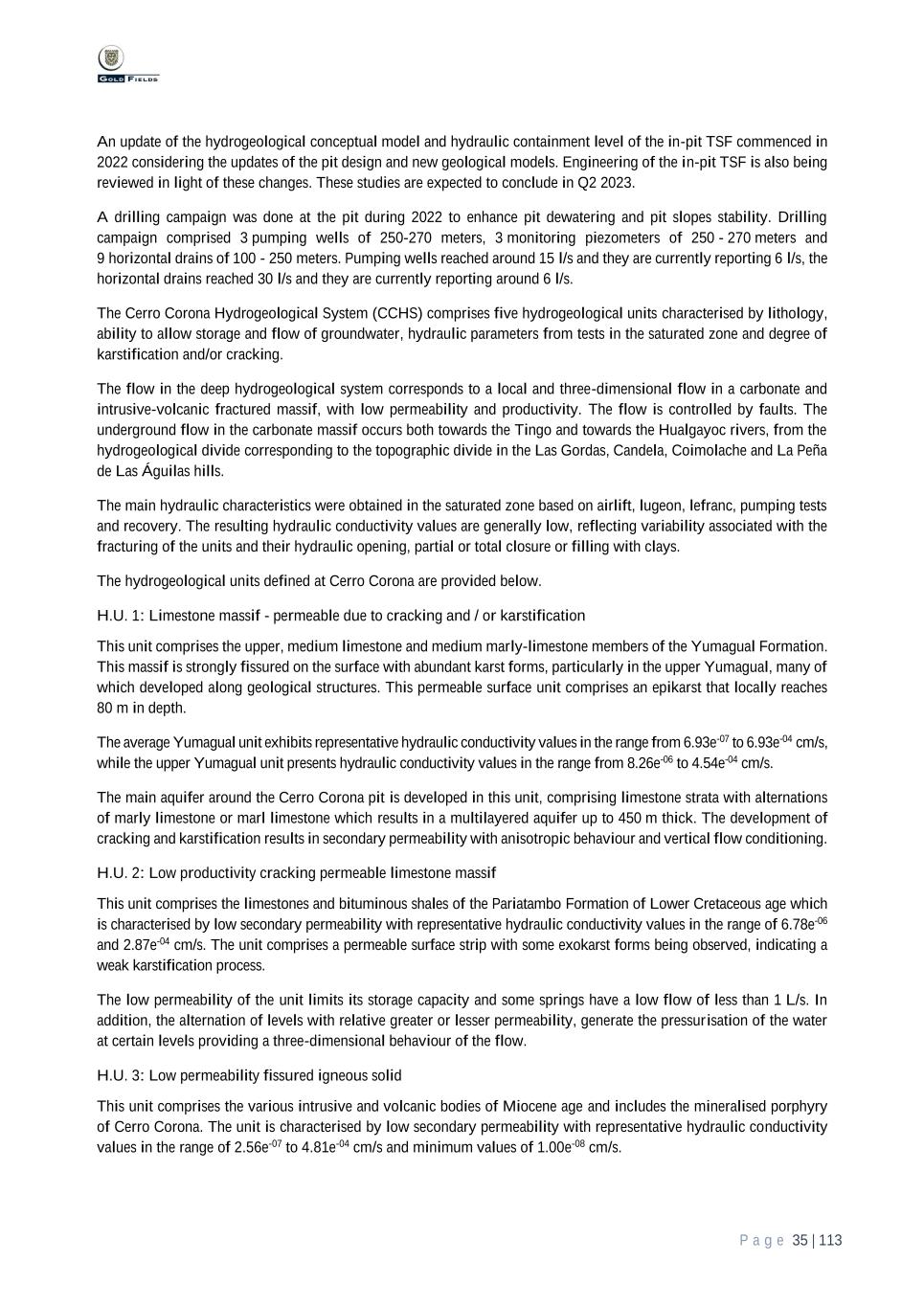
P a g e 35 | 113 An update of the hydrogeological conceptual model and hydraulic containment level of the in-pit TSF commenced in 2022 considering the updates of the pit design and new geological models. Engineering of the in-pit TSF is also being reviewed in light of these changes. These studies are expected to conclude in Q2 2023. A drilling campaign was done at the pit during 2022 to enhance pit dewatering and pit slopes stability. Drilling campaign comprised 3 pumping wells of 250-270 meters, 3 monitoring piezometers of 250 - 270 meters and 9 horizontal drains of 100 - 250 meters. Pumping wells reached around 15 l/s and they are currently reporting 6 l/s, the horizontal drains reached 30 l/s and they are currently reporting around 6 l/s. The Cerro Corona Hydrogeological System (CCHS) comprises five hydrogeological units characterised by lithology, ability to allow storage and flow of groundwater, hydraulic parameters from tests in the saturated zone and degree of karstification and/or cracking. The flow in the deep hydrogeological system corresponds to a local and three-dimensional flow in a carbonate and intrusive-volcanic fractured massif, with low permeability and productivity. The flow is controlled by faults. The underground flow in the carbonate massif occurs both towards the Tingo and towards the Hualgayoc rivers, from the hydrogeological divide corresponding to the topographic divide in the Las Gordas, Candela, Coimolache and La Peña de Las Águilas hills. The main hydraulic characteristics were obtained in the saturated zone based on airlift, lugeon, lefranc, pumping tests and recovery. The resulting hydraulic conductivity values are generally low, reflecting variability associated with the fracturing of the units and their hydraulic opening, partial or total closure or filling with clays. The hydrogeological units defined at Cerro Corona are provided below. H.U. 1: Limestone massif - permeable due to cracking and / or karstification This unit comprises the upper, medium limestone and medium marly-limestone members of the Yumagual Formation. This massif is strongly fissured on the surface with abundant karst forms, particularly in the upper Yumagual, many of which developed along geological structures. This permeable surface unit comprises an epikarst that locally reaches 80 m in depth. The average Yumagual unit exhibits representative hydraulic conductivity values in the range from 6.93e-07 to 6.93e-04 cm/s, while the upper Yumagual unit presents hydraulic conductivity values in the range from 8.26e-06 to 4.54e-04 cm/s. The main aquifer around the Cerro Corona pit is developed in this unit, comprising limestone strata with alternations of marly limestone or marl limestone which results in a multilayered aquifer up to 450 m thick. The development of cracking and karstification results in secondary permeability with anisotropic behaviour and vertical flow conditioning. H.U. 2: Low productivity cracking permeable limestone massif This unit comprises the limestones and bituminous shales of the Pariatambo Formation of Lower Cretaceous age which is characterised by low secondary permeability with representative hydraulic conductivity values in the range of 6.78e-06 and 2.87e-04 cm/s. The unit comprises a permeable surface strip with some exokarst forms being observed, indicating a weak karstification process. The low permeability of the unit limits its storage capacity and some springs have a low flow of less than 1 L/s. In addition, the alternation of levels with relative greater or lesser permeability, generate the pressurisation of the water at certain levels providing a three-dimensional behaviour of the flow. H.U. 3: Low permeability fissured igneous solid This unit comprises the various intrusive and volcanic bodies of Miocene age and includes the mineralised porphyry of Cerro Corona. The unit is characterised by low secondary permeability with representative hydraulic conductivity values in the range of 2.56e-07 to 4.81e-04 cm/s and minimum values of 1.00e-08 cm/s.

P a g e 36 | 113 Within the Cerro Corona intrusive, the main structures have low permeability due to clay fillings and/or fine matrix breccia and a reduced storage capacity. The drainage wells in the pit show low productivity with average flows usually below 1.5 L/s. The Cerro Corona intrusive also exhibits an irregular halo of contact metamorphism with rocks such as marble, skarns and calc-silicate rocks that also exhibit low secondary permeability. H.U. 4: Low permeability carbonate solid This group includes formations that have a greater proportion of marl or marly-limestone strata within the limestone stratigraphy, such as the middle marly and lower members of the Yumagual Formation and the Chulec Formation. They are characterised by low secondary permeability, with representative hydraulic conductivity values in the range of 1.53e-05 to 8.59e-04 cm/s, and minimum values of 2.63e-07 cm/s. The intercalation of marl strata with less permeability acts as an aquitard within the limestone massif and restricts the vertical flow and the recharge. Larger structures can however provide vertical connection between permeable levels. The springs associated with these units comprise flows of less than 0.1 L/s. The base of the deep hydrogeological system developed in the limestones corresponds to the Chulec Formation, due to the alternation of loamy limestone and shale which acts as aquitard. H.U. 5: Permeable detrital deposit with intergranular porosity This unit comprises the Quaternary alluvial, fluvio-alluvial and colluvial deposits which are developed in the bottom of the valleys of the Hualgayoc and Tingo Rivers. Their primary permeability depends on the content of fine particles such as silt and clay and are generally moderate to low with low productivity. Representative hydraulic conductivity values are in the range of 5.07e-04 to 4.58e-02 cm/s. In the opinion of the Qualified person: a) Cerro Corona has appropriate hydrological studies conducted at all relevant sites. b) Hydrology is not viewed as presenting a material risk to Cerro Corona or the Mineral resource and Mineral reserve estimates. c) Placement and storage of in-pit tailings is considered hydrologically viable. 7.4 Geotechnical Dedicated geotechnical data is collected for geotechnical pit design purposes. This includes logging of diamond drill core, and mapping of surface exposures. The geotechnical holes are planned along the pit periphery to intercept major and discrete structures that could have detrimental effects on slope stability. Representative samples are collected and sent to the laboratory for testing. Additional data collection on selected exploration holes also carried out to increase data density. Sampling for various geotechnical tests, primarily uniaxial compressive strength and triaxial compressive strengths is done according to mine sampling protocols in the slope management plan. The results are used to determine rock mass properties. The key assumptions for the rock mass properties are stated below: 1. The uniaxial compressive strength values are the 25th percentile values. 2. The adopted mi values are the 25th percentile values. 3. Rock mass properties were estimated using the Hoek Brown failure criteria. 4. To determine cohesion and frictional angles for two intervals of confining stress, a bilinear Mohr-Coulomb envelop was fitted on a nonlinear Hoek-Brown curve.

P a g e 37 | 113 In the opinion of the Qualified person a) Cerro Corona has completed all appropriate testing supporting the current life-of-mine reserve and continues to test all new significant discoveries. b) Geotechnical domains and lithologies are based on core logging and modelled by the Geology department. c) Sample testing is adequate for the purposes of this report. d) The quality of the sampling and laboratory testing is adequate to support the Mineral resource and Mineral reserve estimates. 7.5 Density Density data was initially collected by Barrick Gold and continued by GFLC. In 2008, GFLC developed a density sampling program from the available historical drill core. These samples were tested by the wax method at the Cerro Corona geotechnical laboratory. From 2013, the samples were tested by SGS by the wax method. Table 7.5.1: Density sample history (wax) Company Year No. samples Barrick 1996-1997 245 GFLC 2008 2,475 GFLC 2013 -2014 1,912 GFLC 2015 777 GFLC 2016 556 GFLC 2017 776 GFLC 2018 48 GFLC 2019 234 GFLC 2021 674 GFLC 2022 285 Total 7,982 Source: Cerro Corona CPR, 2022 The Qualified person considers that the quantity of samples is representative of the proposed open pit shell. Currently, half HQ drill core is sampled every 10 m (pit bench height) for testing using the paraffin wax coat method. Approximately 10 cm to 15 cm length pieces are weighed and dried, with the dried weight used to calculate the natural moisture content of each sample. The half core is then coated with paraffin wax and weighed again to determine the weight of the paraffin wax (the density of the wax is known). The sample is weighed again while suspended in water. The paraffin wax coat method is a widely used method for density measurement in resource and reserve assessments; however, joints and other open spaces in the rock mass are not fully represented in the core samples. In the opinion of the Qualified person, the bulk density testing is adequate for the intended purpose and the tonnage estimation based on the bulk densities appear to have little bias.
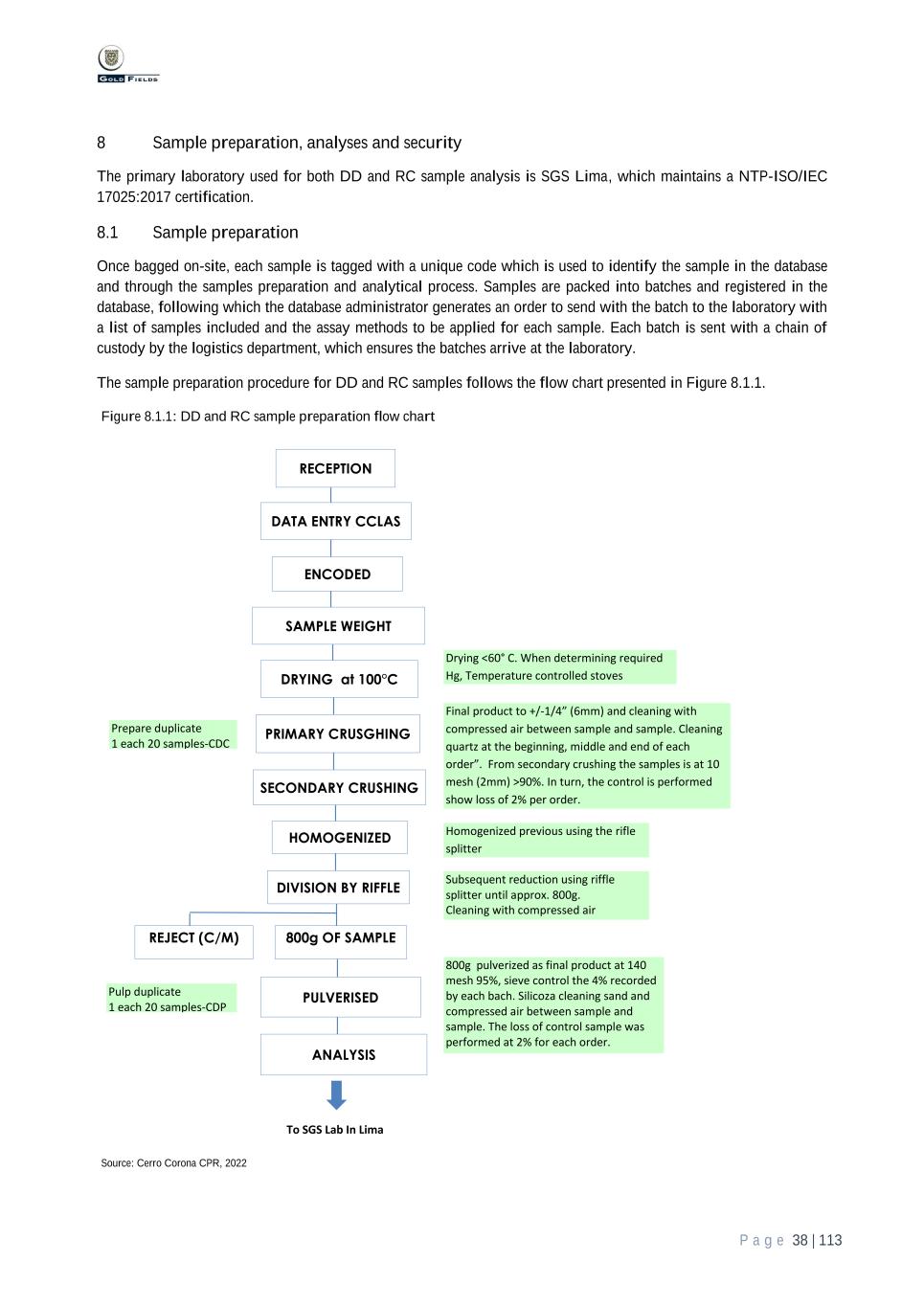
P a g e 38 | 113 8 Sample preparation, analyses and security The primary laboratory used for both DD and RC sample analysis is SGS Lima, which maintains a NTP-ISO/IEC 17025:2017 certification. 8.1 Sample preparation Once bagged on-site, each sample is tagged with a unique code which is used to identify the sample in the database and through the samples preparation and analytical process. Samples are packed into batches and registered in the database, following which the database administrator generates an order to send with the batch to the laboratory with a list of samples included and the assay methods to be applied for each sample. Each batch is sent with a chain of custody by the logistics department, which ensures the batches arrive at the laboratory. The sample preparation procedure for DD and RC samples follows the flow chart presented in Figure 8.1.1. Figure 8.1.1: DD and RC sample preparation flow chart Source: Cerro Corona CPR, 2022 DRYING at 100°C PRIMARY CRUSGHING SECONDARY CRUSHING HOMOGENIZED DIVISION BY RIFFLE PULVERISED ANALYSIS REJECT (C/M) 800g OF SAMPLE RECEPTION ENCODED DATA ENTRY CCLAS SAMPLE WEIGHT To SGS Lab In Lima Homogenized previous using the rifle splitter Subsequent reduction using riffle splitter until approx. 800g. Cleaning with compressed air 800g pulverized as final product at 140 mesh 95%, sieve control the 4% recorded by each bach. Silicoza cleaning sand and compressed air between sample and sample. The loss of control sample was performed at 2% for each order. Drying <60° C. When determining required Hg, Temperature controlled stoves Final product to +/-1/4” (6mm) and cleaning with compressed air between sample and sample. Cleaning quartz at the beginning, middle and end of each order”. From secondary crushing the samples is at 10 mesh (2mm) >90%. In turn, the control is performed show loss of 2% per order. Prepare duplicate 1 each 20 samples-CDC Pulp duplicate 1 each 20 samples-CDP
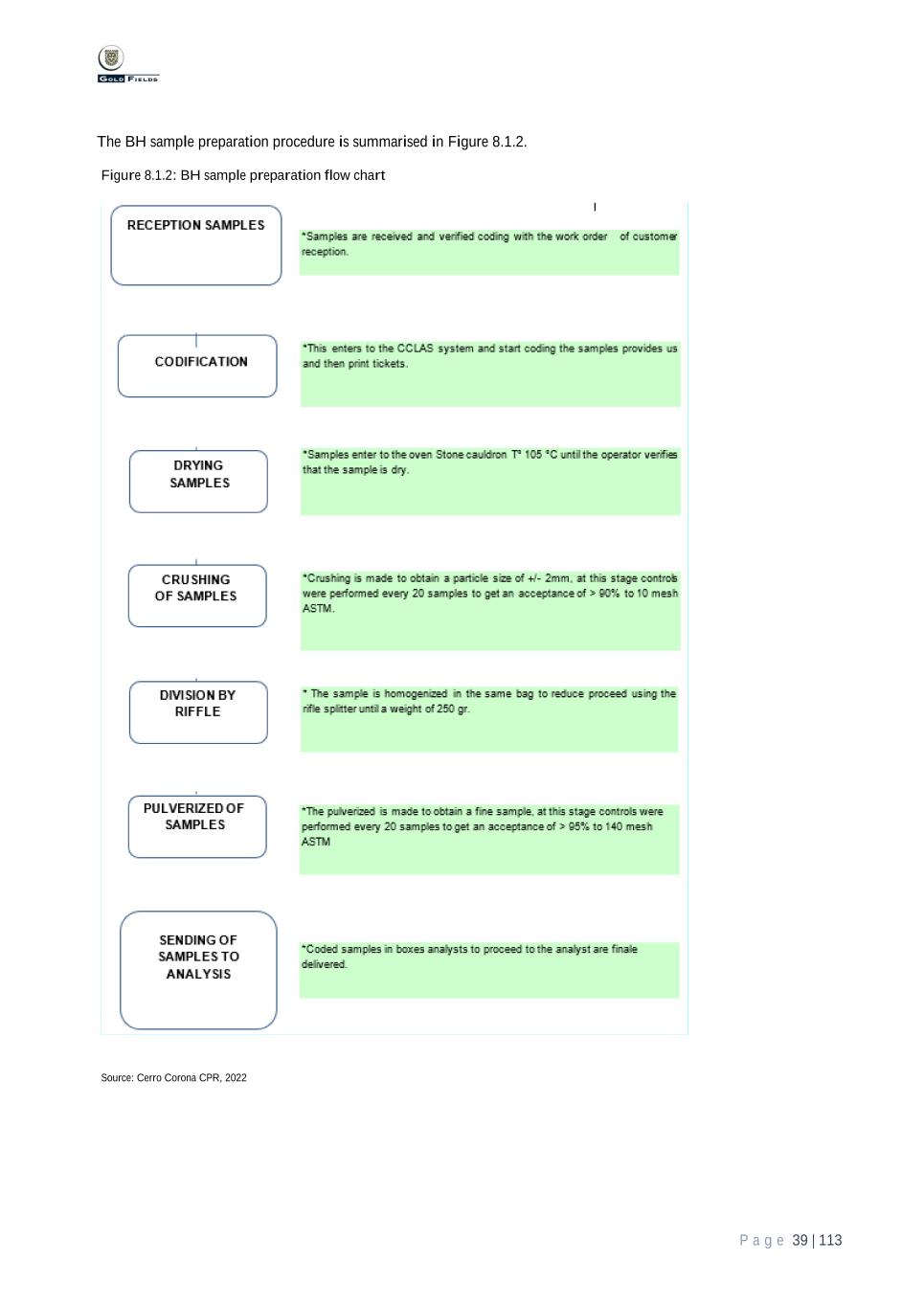
P a g e 39 | 113 The BH sample preparation procedure is summarised in Figure 8.1.2. Figure 8.1.2: BH sample preparation flow chart Source: Cerro Corona CPR, 2022

P a g e 40 | 113 8.2 Sample analysis A portion of each RC and DD pulp sample as required by each process is analysed by the methods detailed in Table 8.2.1. Table 8.2.1: Cerro Corona exploration sample analysis Variable Scheme Unit Detection limit Au* FAA515 ppm 0.005 Cu AAS41B % 0.001 CU_SS AAS73B % 0.001 Cu_CN AAS73B % 0.001 CU_R AAS73B % 0.001 As ICP40B ppm 3 Cu ICP40B ppm 0.5 Fe ICP40B % 0.01 S ICP40B % 0.01 S_Total CSA24V % 0.01 Sample Weight PMI_CH g 0.01 P_MEN10 PMI_M10 % 90 P_MEN140 PMI_M140 % 95 Note: * Assays with >5 ppm Au have a gravimetric finish. Source: Cerro Corona CPR, 2022 The primary laboratory used for BH sample analysis is the Cerro Corona facility managed on behalf of GFLC by SGS. All grade control BHs are analysed for gold, copper, total sulphur, arsenic, iron and oxide copper by the methods summarised in Table 8.2.2. Table 8.2.2: Cerro Corona grade control sample analysis Type Method Unit Detection limit Sample Weight PMI_CH g 5 P_MEN10 PMI_M10 % 90 P_MEN140 PMI_M140 % 95 Au* FAA515 g/t 0.01 Cu AAS41B % 0.001 Fe AAS41B % 0.01 S_Total CSA24V % 0.01 As AAS12CP ppm 15 CuOx CAA00C % 0.005 Moisture MN_HUM % 0.3 Note: * Assays with >5 ppm Au have a gravimetric finish. Source: Cerro Corona CPR, 2022 The Qualified person has reviewed the certificates and is of the opinion that the analytical laboratories are certificated and have effective process and protocol in place to ensure quality control and assurance and minimise any material errors.
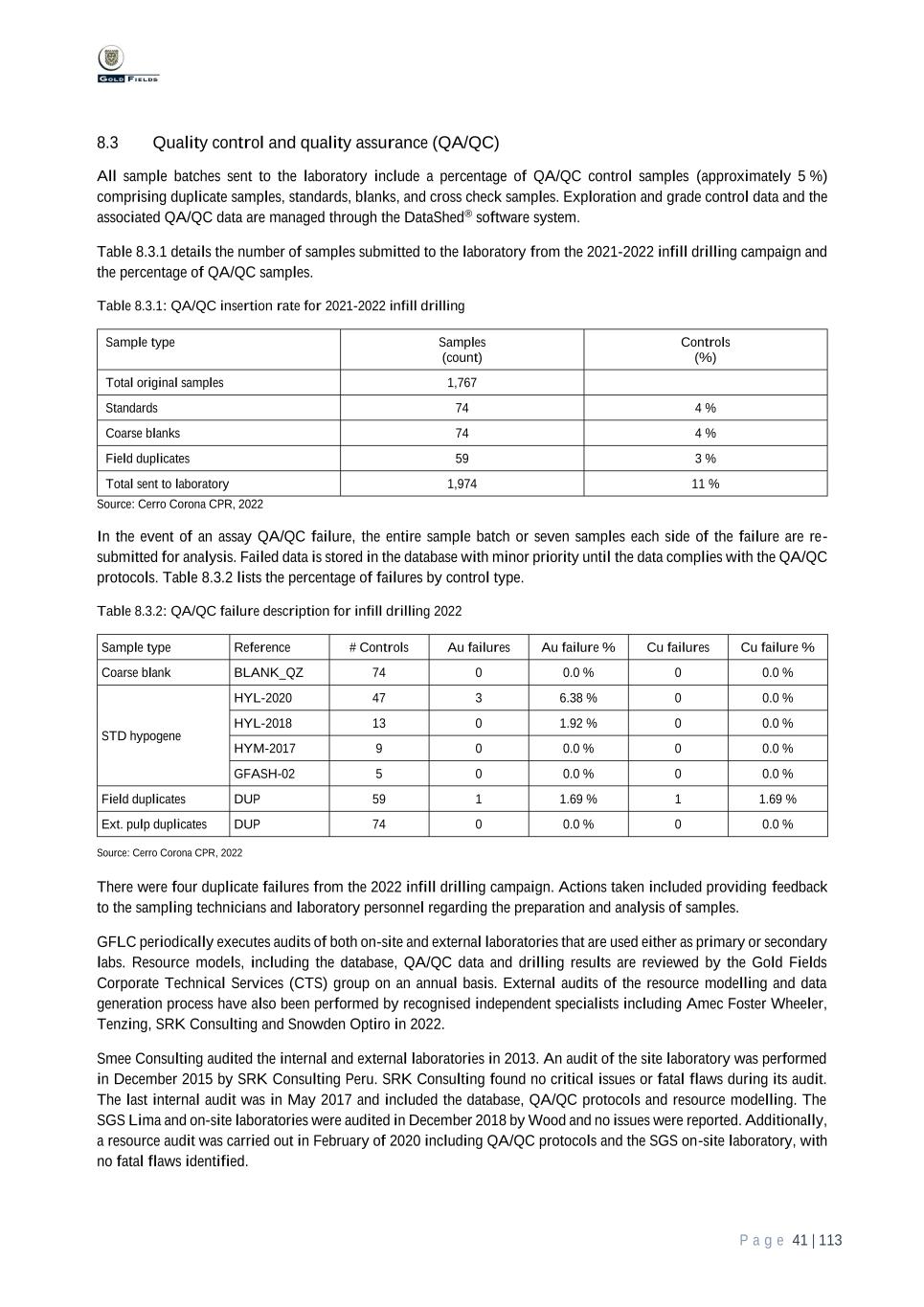
P a g e 41 | 113 8.3 Quality control and quality assurance (QA/QC) All sample batches sent to the laboratory include a percentage of QA/QC control samples (approximately 5 %) comprising duplicate samples, standards, blanks, and cross check samples. Exploration and grade control data and the associated QA/QC data are managed through the DataShed® software system. Table 8.3.1 details the number of samples submitted to the laboratory from the 2021-2022 infill drilling campaign and the percentage of QA/QC samples. Table 8.3.1: QA/QC insertion rate for 2021-2022 infill drilling Sample type Samples (count) Controls (%) Total original samples 1,767 Standards 74 4 % Coarse blanks 74 4 % Field duplicates 59 3 % Total sent to laboratory 1,974 11 % Source: Cerro Corona CPR, 2022 In the event of an assay QA/QC failure, the entire sample batch or seven samples each side of the failure are re- submitted for analysis. Failed data is stored in the database with minor priority until the data complies with the QA/QC protocols. Table 8.3.2 lists the percentage of failures by control type. Table 8.3.2: QA/QC failure description for infill drilling 2022 Sample type Reference # Controls Au failures Au failure % Cu failures Cu failure % Coarse blank BLANK_QZ 74 0 0.0 % 0 0.0 % STD hypogene HYL-2020 47 3 6.38 % 0 0.0 % HYL-2018 13 0 1.92 % 0 0.0 % HYM-2017 9 0 0.0 % 0 0.0 % GFASH-02 5 0 0.0 % 0 0.0 % Field duplicates DUP 59 1 1.69 % 1 1.69 % Ext. pulp duplicates DUP 74 0 0.0 % 0 0.0 % Source: Cerro Corona CPR, 2022 There were four duplicate failures from the 2022 infill drilling campaign. Actions taken included providing feedback to the sampling technicians and laboratory personnel regarding the preparation and analysis of samples. GFLC periodically executes audits of both on-site and external laboratories that are used either as primary or secondary labs. Resource models, including the database, QA/QC data and drilling results are reviewed by the Gold Fields Corporate Technical Services (CTS) group on an annual basis. External audits of the resource modelling and data generation process have also been performed by recognised independent specialists including Amec Foster Wheeler, Tenzing, SRK Consulting and Snowden Optiro in 2022. Smee Consulting audited the internal and external laboratories in 2013. An audit of the site laboratory was performed in December 2015 by SRK Consulting Peru. SRK Consulting found no critical issues or fatal flaws during its audit. The last internal audit was in May 2017 and included the database, QA/QC protocols and resource modelling. The SGS Lima and on-site laboratories were audited in December 2018 by Wood and no issues were reported. Additionally, a resource audit was carried out in February of 2020 including QA/QC protocols and the SGS on-site laboratory, with no fatal flaws identified.
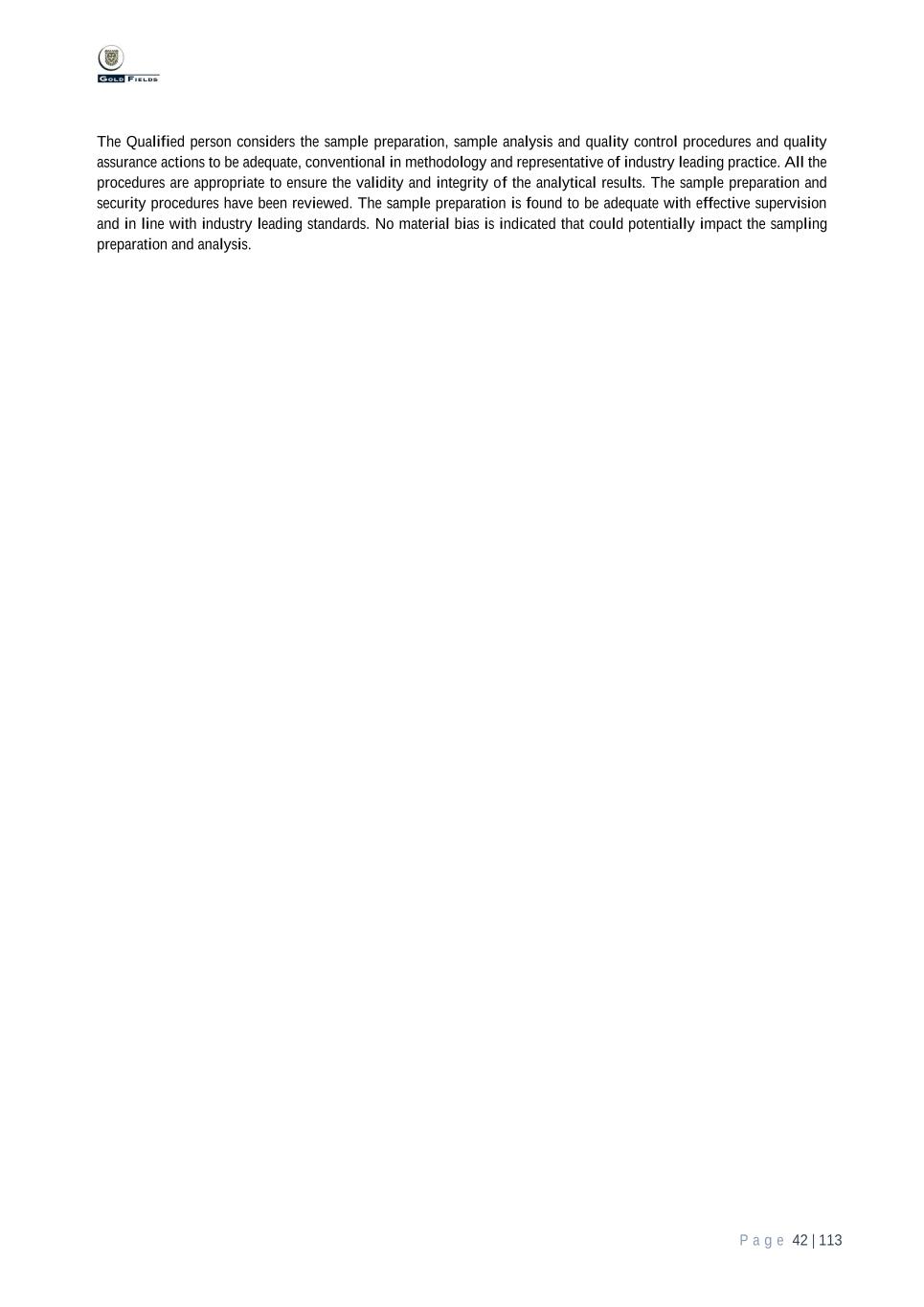
P a g e 42 | 113 The Qualified person considers the sample preparation, sample analysis and quality control procedures and quality assurance actions to be adequate, conventional in methodology and representative of industry leading practice. All the procedures are appropriate to ensure the validity and integrity of the analytical results. The sample preparation and security procedures have been reviewed. The sample preparation is found to be adequate with effective supervision and in line with industry leading standards. No material bias is indicated that could potentially impact the sampling preparation and analysis.

P a g e 43 | 113 9 Data verification The execution of mine and regional exploration programs is completed to industry best practice and is aligned with numerous standards and procedures developed by Cerro Corona and Gold Fields over a number of years. The process consists of procedures, audits and sign-off documents for all key elements that input into the generation of a Mineral resource model to ensure full compliance. The key components of the geological data acquisition framework include: • Validity – Controls to ensure the validity of key activities. • Accuracy – Controls to establish the accuracy of data inputs and outputs. • Completeness – Controls to ensure the completeness of the process followed. • Timing – Preventative and detective controls to identify potential risk and deviation of quality. • Segregation of Duties/Sign-off – Key members of the senior team are responsible for different aspects of the process. The Qualified person is of the opinion that the data verification process and protocols are adequate to minimise any material errors, are in line with industry leading standards and underpin the technical assurance and validity of the sampling results. 9.1 Drilling and sampling Cerro Corona has a set of procedures in place that describe and explain the standards to be maintained for the collection of sampling data. These standards include protocols for chip sampling, surface drilling and grade control sampling, which are consistent and in accordance with industry best practice, providing good control on the quality and consistency of the sampling. Sample governance includes the following steps: • Samples are tagged with a unique and consecutive numbers (Sample ID) which identifies the samples during the entire process. • Samples are grouped in batches according to the furnace capacity declared by the laboratory. • Batches are automatically registered by the Database Administrator, including QA/QC control samples, and a list is generated including the types of assays to be carried out on each batch. • The physical document is signed by the Project Geologist responsible for each batch. • On arrival at the laboratory, the Laboratory Supervisor receives the batches and verifies that all the samples are in optimal condition and are tagged as described in the documentation, which is then signed as a proof of acceptance. • After testing, the assay results are sent to the Project Geologist electronically and the results are downloaded from the QLab Database system administered by SGS. Production sample assay results are sent physically. 9.2 Data management Exploration and grade control data and associated QA/QC information are managed through Datashed® software, which is a front end to the SQL Database. The DataShed® interface includes features to assure data integrity including access permission, data quarantining and library lookup tables. A dedicated Database Administrator assures the integrity and management of the database. This administrator is assisted by the Senior Resource Geologist and the QA/QC Geologist in the database management (data entry, validation, development and quality control for the database). All exploration and resource development data, including grade control data, is stored in a centralised Microsoft SQL Server database.

P a g e 44 | 113 Pre-GFLC drillhole data including collar surveys, downhole surveys, assay data and geological logging have been verified in the database by GFLC using the following approaches: • Collar surveys: planned versus executed coordinates were compared to ensure accuracy of the hole location. • Downhole surveys: deviation was checked in terms of degrees per metre. Unacceptable measurements were given lower priority. • Assay data: 5 % of the data was cross-checked by comparing physical laboratory certificates with database contents to ensure its integrity. • Geological logging: historical drillholes inside the pit shell were relogged by GFLC. This relogging is yet to be completed for the holes below the pit shell. The Qualified person’s opinion of the data management is: • The data management process and protocols are adequate to minimise any material errors. • Regular validation of the database and data management process is aligned with standard industry practices and is monitored through the SOX risk assessment control matrix criteria. 9.3 Geological modelling The geological modelling is based on the exploration DD and grade control RC data. Pit mapping data, most commonly in the form of survey pick-ups of geological structures and reef boundary contacts, is incorporated into the structural interpretation. The orebodies at Cerro Corona are cut by numerous faults, which generally run perpendicular to the strike and are predominantly reverse faults. Initially, zoning and structural interpretation using borehole sections extracted from the drillhole database is carried out prior to modelling of the individual reef horizons at Cerro Corona. 3D wireframe planes of the structural discontinuities (faults) are constructed during the structural interpretation and all new drillholes are zoned. In the opinion of the Qualified person: • The geological modelling protocols are adequate to minimise material errors. • The controls have been reviewed and the adequacy is reasonable and material bias or errors are not expected. • The systems to reduce human and procedural errors, checks and balances are adequate and minimise the potential for any material errors. • The protocols are adequate as reviewed and the Mineral resource models are based on sound, verified data and the resource block models generated and provided to the planning engineers are deemed industry leading practice and appropriate for mine planning and scheduling.

P a g e 45 | 113 10 Mineral processing and metallurgical testing 10.1 Testing and procedures 10.1.1 Background The Cerro Corona processing facilities have been operating since 2008 following the completion of a Definitive Feasibility Study (DFS) by Minproc in 2004 and subsequent environmental regulatory permitting processes. The mining operations consists of the single Cerro Corona open pit. Mineralisation at Cerro Corona occurs as a disseminated deposit forming some millimetric veinlets between the silica veins and veinlets that make up the stockwork in argillic alteration zones 1, 2 and 3. In the potassic alteration zones, mineralisation occurs disseminated, both in the silica veinlets and in the quartz-feldspar matrix. In the silicification or silica alteration zones, the existing mineralisation appears disseminated in millimetric veinlets and as patches. The southwestern region of the Cerro Corona open pit contains elevated levels of arsenic mineralisation mainly in the intermediate benches of this sector and in a sector of the northern region, this arsenic mineralisation is closely associated with the copper and gold mineralisation. While this elevated arsenic material comprises a relatively limited area, its impact on flotation was unrecognised during the original feasibility studies. In the central part of the orebody mineralisation mainly consists of chalcopyrite, bornite in silica gangue and pyrite, which comprises the hypogene or primary ore zone. Almost all the entire remaining Mineral reserve is hypogene mineralisation. Historically mined supergene and gold- oxide stockpiles have since been processed and sold. The remaining Mineral reserve is in the form of ex-pit hypogene ores, and existing low-grade hypogene stockpiles. The volume of remaining Cerro Corona Mineral reserves is constrained to the available remaining tailings capacity associated with: • The existing TSF as currently designed. • The capacity of the future in-pit TSF, that will become available once mining of the Cerro Corona pit is completed to contain tailings from processing stockpiled lower grade ores, with the containment volume limited due to existing open pit and local groundwater’s hydrogeological considerations. 10.1.2 Original feasibility studies During the original feasibility studies prior to the acquisition of Cerro Corona by Gold Fields, significant testwork was undertaken, which formed the basis of the original design of the as-built mine and process plant facility. Actual experience with the geology of the excavated mine and operation of the as-built plant has led to several key changes since the DFS, including: • The identification of an elevated arsenic mineralisation zone. • Some changes to the as-built plant design to reduce construction costs. • A change to the rougher circuit flotation regime, with an increase in pH to depress pyrite, prior to concentrate regrind and cleaner flotation to reduce load on the cleaning circuit. The copper and gold recovery estimation models used for cutoff grade (NSR) determination are still based on those developed during the original feasibility study however, they have been factored (down) based on actual plant experience subsequently obtained. Additional recovery models have been developed in 2022 specifically for longer- term stockpiled material, based on actual plant operating experience whilst recently processing the stockpiled material. 10.1.3 Production control sampling In advance of ore excavation, the site’s geometallurgical department undertakes testwork on blast hole samples, including mineralogical analysis using an on-site QEMSCAN analyser and rougher flotation.

P a g e 46 | 113 The result from this routine testing is used to guide short-term mine planning and mill feed blend optimisation. 10.2 Plant sampling and reconciliation Metallurgical samples are collected by Cerro Corona personnel and since 2007 have been assayed at the on-site laboratory managed by SGS, which maintains a NTP-ISO/IEC 17025:2017 certification. Metallurgical samples used for daily metal accounting are 12-hour shift composites. All of these are automatically sampled by Courier 6SL equipment. At the end of every shift, these samples are delivered to the on-site SGS laboratory by Cerro Corona metallurgical operators for copper, gold and iron analysis. Other data to prepare metallurgical balance reports including processed tonnage, moisture, filtered and shipped concentrate etc. is collected from the plant’s historical database (PI System) or is measured by the laboratory. A locked and password-protected Excel spread sheet is currently used as the official theoretical daily metal accounting report. Adjustments to the gold and iron balances are made based on the copper balance, considering the same concentration ratio for the three elements. Production accounting software from Datamine® is being tested at Cerro Corona. All data is fed into this platform and balance reports are generated daily. Adjustments in the grades values are validated with the JKSimMet methodology to verify the results of the adjustments. The reconciliation between these theoretical daily reports and physical production is prepared weekly. This reconciliation considers the shipped concentrate grades as the starting point and recalculates the head grades. Differences are lower than 5 % in recalculated grades. The same method is applied for the official monthly production report. All daily reports are saved in the Metallurgy network, to which only authorised personnel have access. IT oversees periodical backups to avoid data loss. In accordance with Gold Fields Plant Metal Accounting Standard, a gold and copper in circuit inventory is undertaken monthly to reconcile (by mass balance) the back-calculated gold and copper grades of the mill feed with the mill feed grade estimates obtained using daily plant samples and assays. The monthly variance between the assayed grade and the back-calculated grade is monitored, and an investigation is initiated if this variance exceeds the minimum allowable levels outlined in the Gold Fields Plant Metal Accounting Standard. The monthly metal reconciliation variances historically at Cerro Corona have been well within the prescribed limits for both copper and gold. The reconciliations are based upon assuming that final flotation concentrate generated is the final metal production output. 10.3 Relevant results 10.3.1 Sample head analyses and mineralogy Significant mineralogical and geometallurgical characterisation studies have been undertaken on Cerro Corona over the past ~15 years. A summary of the key geometallurgical domains defined and used by the mine is shown in Table 10.3.1. Table 10.3.1: Key minerals and principal sulphide assemblages in the different alteration types Alteration type Key minerals Principal sulphide assemblages Occurrence Silicification (SIL) Quartz, Iron (Fe) oxides- hydroxides Fe sulphides-chalcopyrite As intense stockwork around barren cores Argillic 1 (ARG1) Quartz, kaolinite, muscovite (illite), smectite Fe sulphides-chalcopyrite (±chalcocite+covellite) Upper parts of the deposit Argillic 2 (ARG2) Quartz, feldspars, montmorillonite, kaolinite, illite, carbonates Chalcopyrite-(Fe sulphides) Replacing locally K alteration Argillic 3 (ARG3) Quartz, montmorillonite muscovite (illite), chlorite Chalcopyrite-(Fe sulphides) Potassic (K) Quartz, K-feldspar, biotite, Fe Oxides (magnetite) Chalcopyrite-(Fe sulphides) Abundant in deep parts, and core of the quartz-diorite stocks Supergene enrichment (SSH, weathering facies rather than alteration) Quartz, feldspars, kaolinite, montmorillonite Chalcopyrite-chalcocite- covellite, (Fe sulphides) Supergene weathering, upper part of the deposit Source: Cerro Corona CPR, 2022
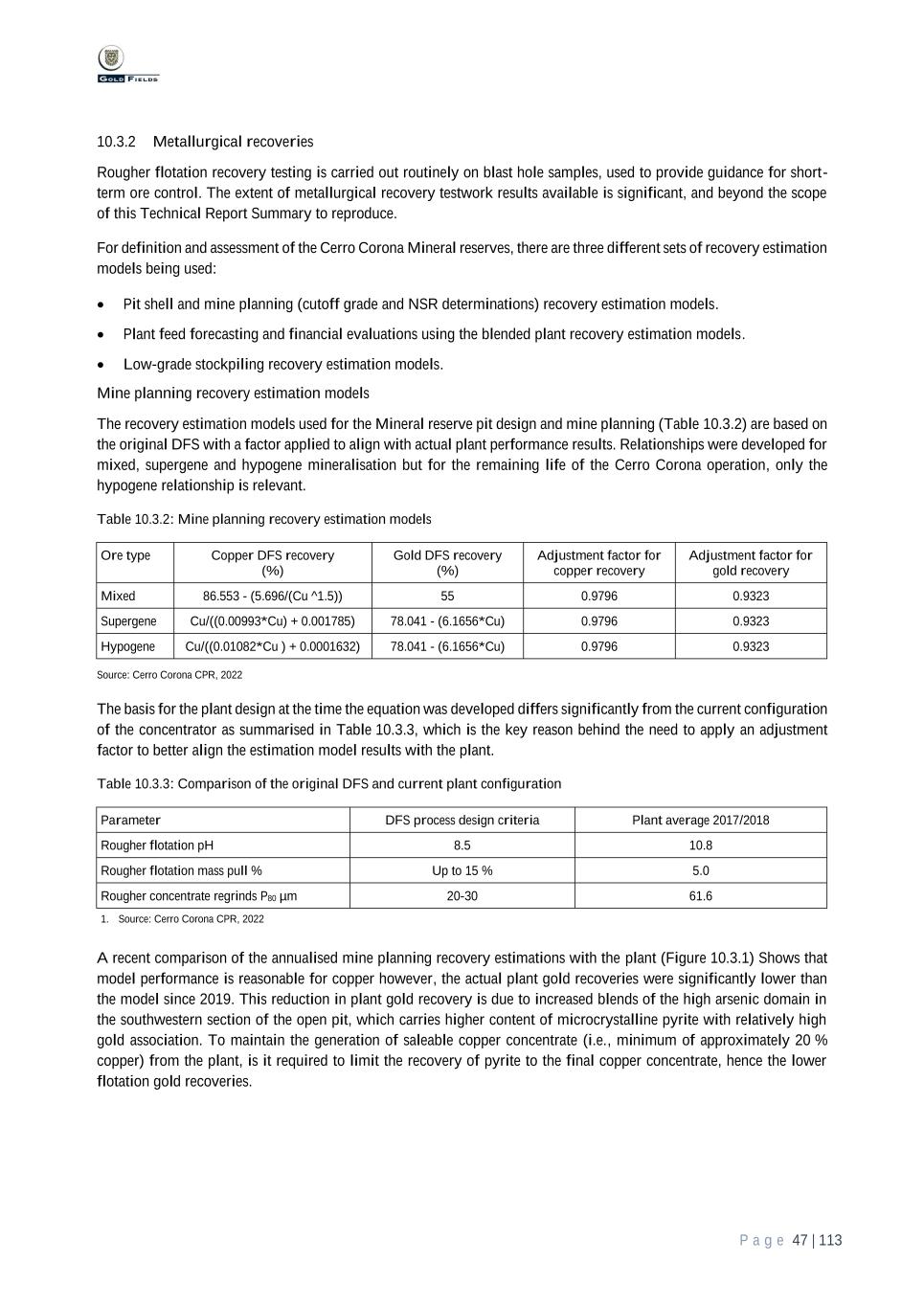
P a g e 47 | 113 10.3.2 Metallurgical recoveries Rougher flotation recovery testing is carried out routinely on blast hole samples, used to provide guidance for short- term ore control. The extent of metallurgical recovery testwork results available is significant, and beyond the scope of this Technical Report Summary to reproduce. For definition and assessment of the Cerro Corona Mineral reserves, there are three different sets of recovery estimation models being used: • Pit shell and mine planning (cutoff grade and NSR determinations) recovery estimation models. • Plant feed forecasting and financial evaluations using the blended plant recovery estimation models. • Low-grade stockpiling recovery estimation models. Mine planning recovery estimation models The recovery estimation models used for the Mineral reserve pit design and mine planning (Table 10.3.2) are based on the original DFS with a factor applied to align with actual plant performance results. Relationships were developed for mixed, supergene and hypogene mineralisation but for the remaining life of the Cerro Corona operation, only the hypogene relationship is relevant. Table 10.3.2: Mine planning recovery estimation models Ore type Copper DFS recovery (%) Gold DFS recovery (%) Adjustment factor for copper recovery Adjustment factor for gold recovery Mixed 86.553 - (5.696/(Cu ^1.5)) 55 0.9796 0.9323 Supergene Cu/((0.00993*Cu) + 0.001785) 78.041 - (6.1656*Cu) 0.9796 0.9323 Hypogene Cu/((0.01082*Cu ) + 0.0001632) 78.041 - (6.1656*Cu) 0.9796 0.9323 Source: Cerro Corona CPR, 2022 The basis for the plant design at the time the equation was developed differs significantly from the current configuration of the concentrator as summarised in Table 10.3.3, which is the key reason behind the need to apply an adjustment factor to better align the estimation model results with the plant. Table 10.3.3: Comparison of the original DFS and current plant configuration Parameter DFS process design criteria Plant average 2017/2018 Rougher flotation pH 8.5 10.8 Rougher flotation mass pull % Up to 15 % 5.0 Rougher concentrate regrinds P80 µm 20-30 61.6 1. Source: Cerro Corona CPR, 2022 A recent comparison of the annualised mine planning recovery estimations with the plant (Figure 10.3.1) Shows that model performance is reasonable for copper however, the actual plant gold recoveries were significantly lower than the model since 2019. This reduction in plant gold recovery is due to increased blends of the high arsenic domain in the southwestern section of the open pit, which carries higher content of microcrystalline pyrite with relatively high gold association. To maintain the generation of saleable copper concentrate (i.e., minimum of approximately 20 % copper) from the plant, is it required to limit the recovery of pyrite to the final copper concentrate, hence the lower flotation gold recoveries.
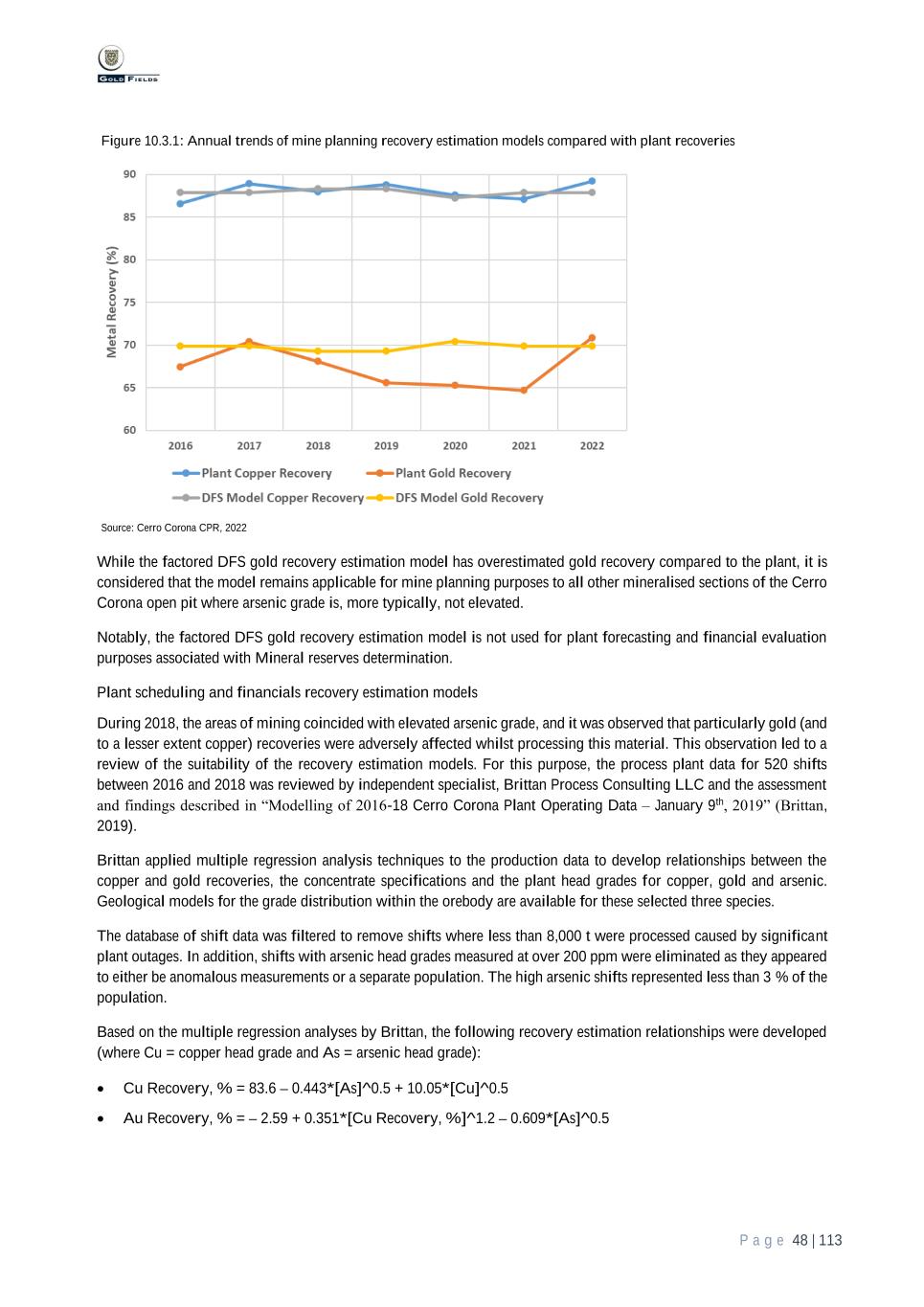
P a g e 48 | 113 Figure 10.3.1: Annual trends of mine planning recovery estimation models compared with plant recoveries Source: Cerro Corona CPR, 2022 While the factored DFS gold recovery estimation model has overestimated gold recovery compared to the plant, it is considered that the model remains applicable for mine planning purposes to all other mineralised sections of the Cerro Corona open pit where arsenic grade is, more typically, not elevated. Notably, the factored DFS gold recovery estimation model is not used for plant forecasting and financial evaluation purposes associated with Mineral reserves determination. Plant scheduling and financials recovery estimation models During 2018, the areas of mining coincided with elevated arsenic grade, and it was observed that particularly gold (and to a lesser extent copper) recoveries were adversely affected whilst processing this material. This observation led to a review of the suitability of the recovery estimation models. For this purpose, the process plant data for 520 shifts between 2016 and 2018 was reviewed by independent specialist, Brittan Process Consulting LLC and the assessment and findings described in “Modelling of 2016-18 Cerro Corona Plant Operating Data – January 9th, 2019” (Brittan, 2019). Brittan applied multiple regression analysis techniques to the production data to develop relationships between the copper and gold recoveries, the concentrate specifications and the plant head grades for copper, gold and arsenic. Geological models for the grade distribution within the orebody are available for these selected three species. The database of shift data was filtered to remove shifts where less than 8,000 t were processed caused by significant plant outages. In addition, shifts with arsenic head grades measured at over 200 ppm were eliminated as they appeared to either be anomalous measurements or a separate population. The high arsenic shifts represented less than 3 % of the population. Based on the multiple regression analyses by Brittan, the following recovery estimation relationships were developed (where Cu = copper head grade and As = arsenic head grade): • Cu Recovery, % = 83.6 – 0.443*[As]^0.5 + 10.05*[Cu]^0.5 • Au Recovery, % = – 2.59 + 0.351*[Cu Recovery, %]^1.2 – 0.609*[As]^0.5
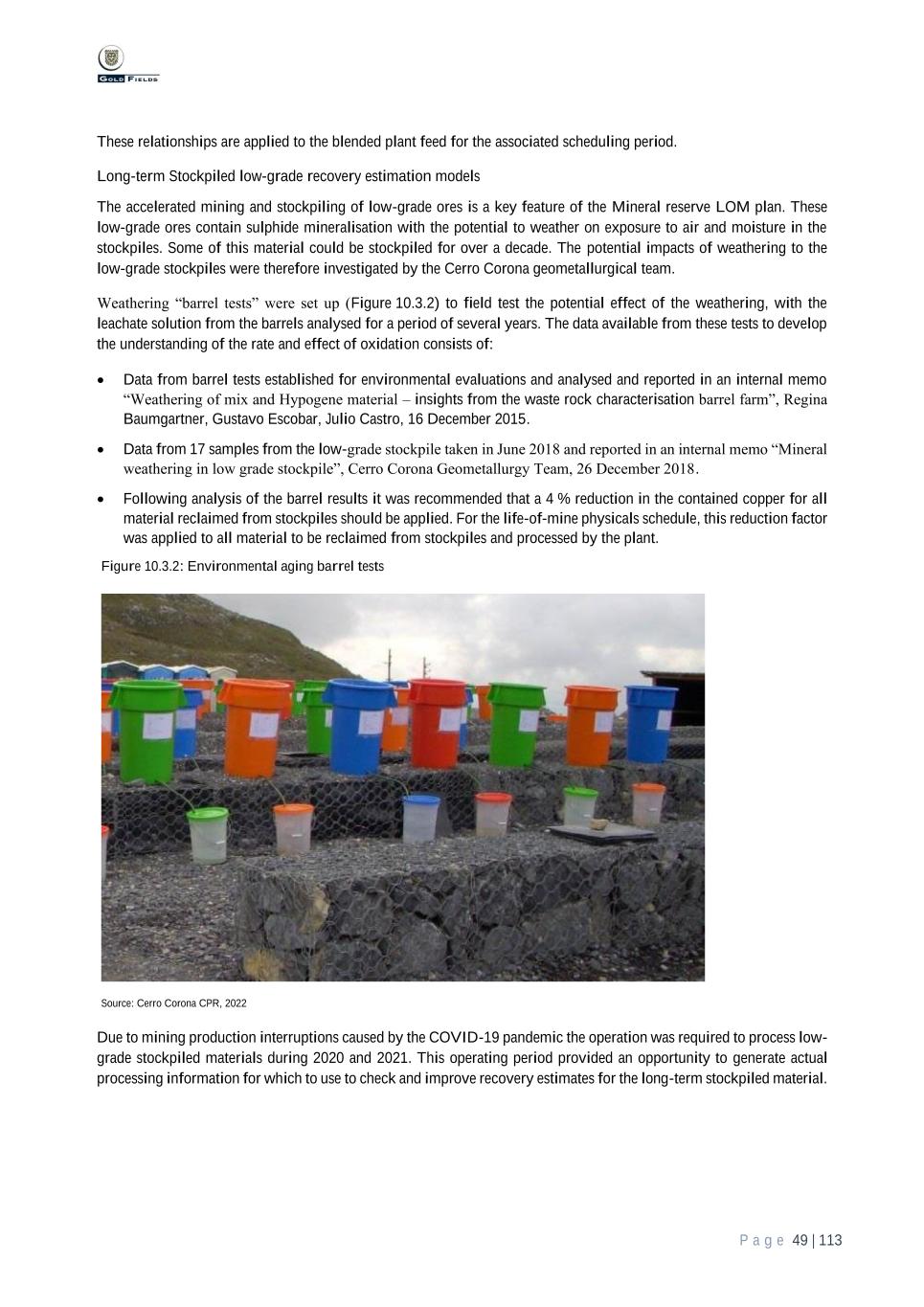
P a g e 49 | 113 These relationships are applied to the blended plant feed for the associated scheduling period. Long-term Stockpiled low-grade recovery estimation models The accelerated mining and stockpiling of low-grade ores is a key feature of the Mineral reserve LOM plan. These low-grade ores contain sulphide mineralisation with the potential to weather on exposure to air and moisture in the stockpiles. Some of this material could be stockpiled for over a decade. The potential impacts of weathering to the low-grade stockpiles were therefore investigated by the Cerro Corona geometallurgical team. Weathering “barrel tests” were set up (Figure 10.3.2) to field test the potential effect of the weathering, with the leachate solution from the barrels analysed for a period of several years. The data available from these tests to develop the understanding of the rate and effect of oxidation consists of: • Data from barrel tests established for environmental evaluations and analysed and reported in an internal memo “Weathering of mix and Hypogene material – insights from the waste rock characterisation barrel farm”, Regina Baumgartner, Gustavo Escobar, Julio Castro, 16 December 2015. • Data from 17 samples from the low-grade stockpile taken in June 2018 and reported in an internal memo “Mineral weathering in low grade stockpile”, Cerro Corona Geometallurgy Team, 26 December 2018. • Following analysis of the barrel results it was recommended that a 4 % reduction in the contained copper for all material reclaimed from stockpiles should be applied. For the life-of-mine physicals schedule, this reduction factor was applied to all material to be reclaimed from stockpiles and processed by the plant. Figure 10.3.2: Environmental aging barrel tests Source: Cerro Corona CPR, 2022 Due to mining production interruptions caused by the COVID-19 pandemic the operation was required to process low- grade stockpiled materials during 2020 and 2021. This operating period provided an opportunity to generate actual processing information for which to use to check and improve recovery estimates for the long-term stockpiled material.

P a g e 50 | 113 Brittan Process Consulting LLC was engaged in 2022 to undertake this analysis, which consisted of multilinear regression modelling of Cerro Corona plant operating data covering the period January 2020 – December 2021. The data included multiple plant operating variables averaged on a daily basis. The objectives were to update copper and gold recovery models, and to assess the effects on copper and gold recoveries of processing low-grade ore stockpiles with some arsenic. These stockpiles were blended intermittently with plant feed over the period February 2020 through May 2021. Restricting the significant variables to those logged for the Resource Model, the models developed were: Cu Recovery, % = 79.9 + 17.5*[Cu]0.5 – 60.0*[CuOX]/[Cu] – 0.239*[As]0.5 + 0.44*[SMEC] – 0.42*[KAOL] – 1.68*[ILLITA] R2 adj = 40.9 % Au Recovery, % = 41.7 + 0.00641*[Cu Recovery, %]2 – 1.93*[As]0.5 + 157*[CuOX] – 17.2*[Cu]/[Au] – 1.42*[Fe] + 0.045*[As] R2 adj = 59.8 % The effects of processing the low-grade stockpile ore on copper and gold recoveries is summarized in the Table 10.3.4. Copper and gold recoveries for the marginal ore stockpile with some arsenic are estimated to be nearly 4 % and 11 % lower respectively than those for regular plant feed ore. The recovery losses are considered to be due to a combination of the effect on copper flotation of the lower copper grade and the more oxidized state of the stockpile ore. Table 10.3.4: Stockpiled materials plant data analysis summary Period Feb 20 – May 21 Days with No Stockpile in Plant Feed* All Days Tons > 16 k All Data Days with Stockpile in Plant Feed Estimate for Stockpile Ore Only** Ave Cu % 0.443 0.413 0.385 0.316 Ave As ppm 47.5 81.3 88.4 104.3 CuSS/Cu 0.0367 0.0382 0.0399 0.0475 CuSS % 0.0163 0.0158 0.0154 0.0150 Cu Recovery % 87.4 86.1 85.7 83.6 Au Recovery % 66.3 61.8 59.9 55.3 Notes: * Excludes stockpile day reported and following two days ** Estimated from All Days Model. Cu and As grades are inferred grades Source: Cerro Corona CPR, 2022 These new stockpile copper and gold recovery models were subsequently applied to the operation’s production plan for the period whilst low-grade stockpiled materials are planned to be processed. 10.3.3 Ore hardness / mill throughput The ore hardness and throughput geometallurgical model for Cerro Corona has evolved over the years since commissioning of the process plant in 2008. The current, and most advanced, geometallurgical model consists of one that considers geochemistry (arsenic concentration), alteration and structural information, comprising seven domains as summarised in Table 10.3.5.
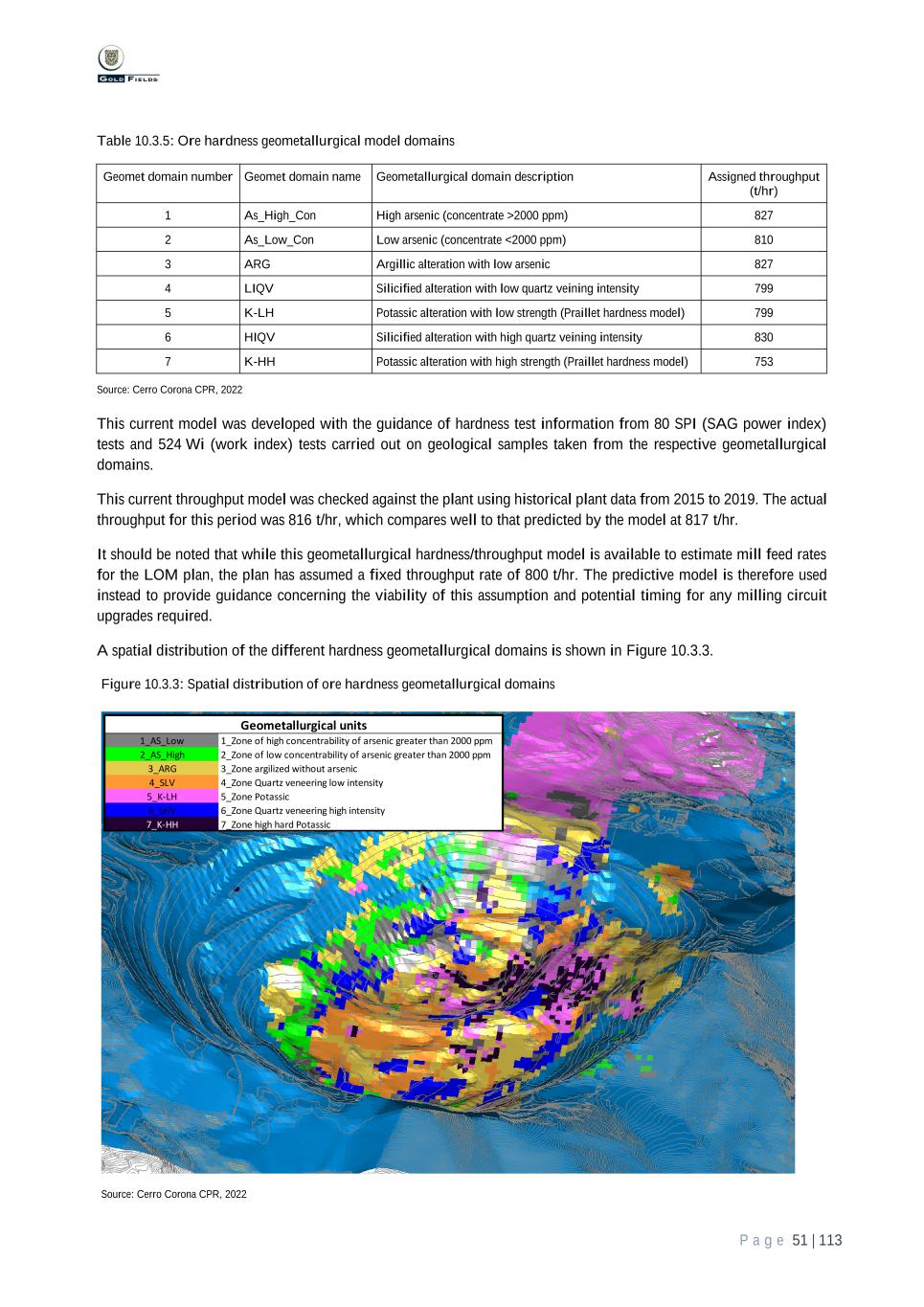
P a g e 51 | 113 Table 10.3.5: Ore hardness geometallurgical model domains Geomet domain number Geomet domain name Geometallurgical domain description Assigned throughput (t/hr) 1 As_High_Con High arsenic (concentrate >2000 ppm) 827 2 As_Low_Con Low arsenic (concentrate <2000 ppm) 810 3 ARG Argillic alteration with low arsenic 827 4 LIQV Silicified alteration with low quartz veining intensity 799 5 K-LH Potassic alteration with low strength (Praillet hardness model) 799 6 HIQV Silicified alteration with high quartz veining intensity 830 7 K-HH Potassic alteration with high strength (Praillet hardness model) 753 Source: Cerro Corona CPR, 2022 This current model was developed with the guidance of hardness test information from 80 SPI (SAG power index) tests and 524 Wi (work index) tests carried out on geological samples taken from the respective geometallurgical domains. This current throughput model was checked against the plant using historical plant data from 2015 to 2019. The actual throughput for this period was 816 t/hr, which compares well to that predicted by the model at 817 t/hr. It should be noted that while this geometallurgical hardness/throughput model is available to estimate mill feed rates for the LOM plan, the plan has assumed a fixed throughput rate of 800 t/hr. The predictive model is therefore used instead to provide guidance concerning the viability of this assumption and potential timing for any milling circuit upgrades required. A spatial distribution of the different hardness geometallurgical domains is shown in Figure 10.3.3. Figure 10.3.3: Spatial distribution of ore hardness geometallurgical domains Source: Cerro Corona CPR, 2022 1_AS_Low 1_Zone of high concentrability of arsenic greater than 2000 ppm 2_AS_High 2_Zone of low concentrability of arsenic greater than 2000 ppm 3_ARG 3_Zone argilized without arsenic 4_SLV 4_Zone Quartz veneering low intensity 5_K-LH 5_Zone Potassic 6_SHV 6_Zone Quartz veneering high intensity 7_K-HH 7_Zone high hard Potassic 8_WLM 8_Zone Wsate limestone and marble Geometallurgical units
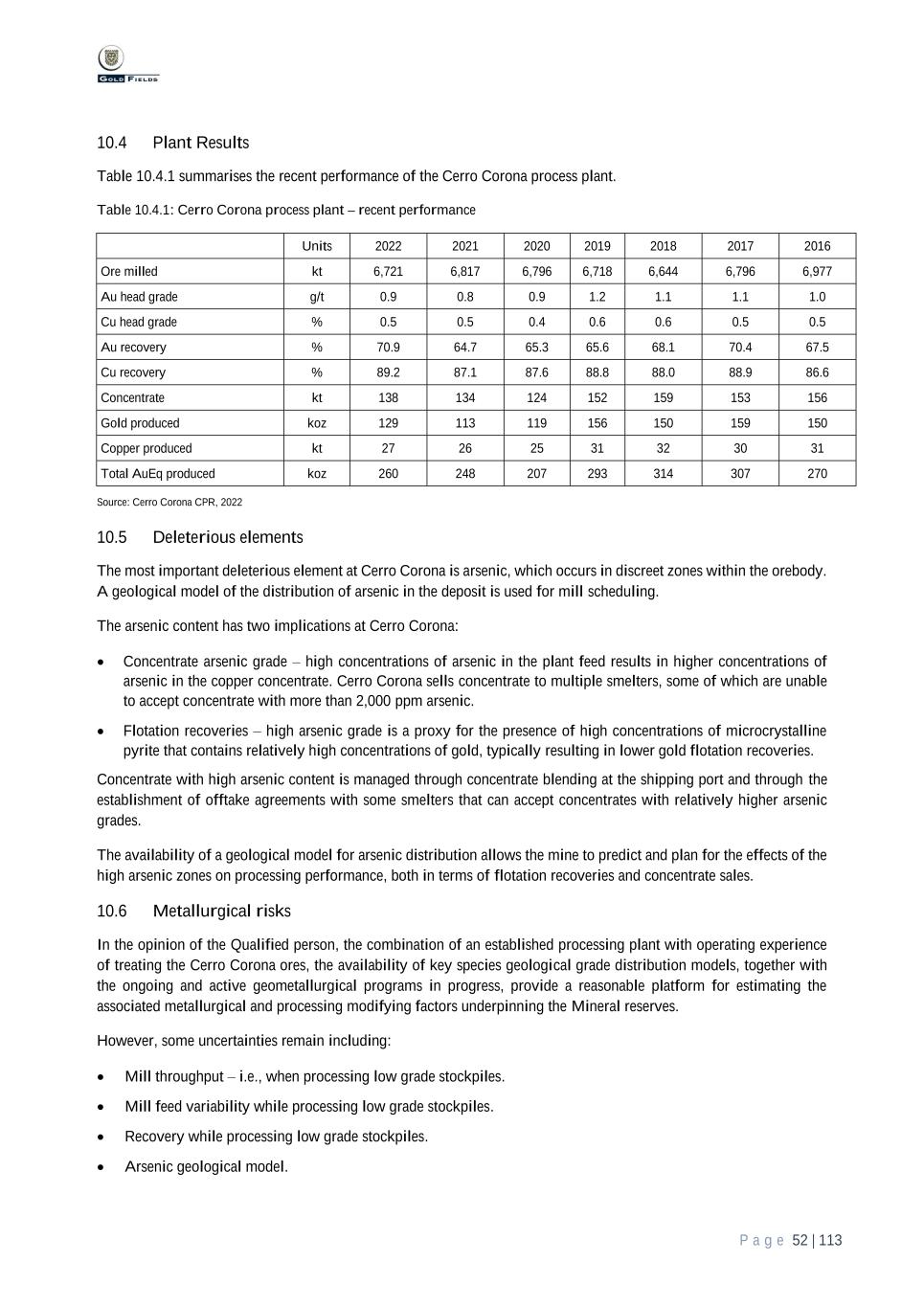
P a g e 52 | 113 10.4 Plant Results Table 10.4.1 summarises the recent performance of the Cerro Corona process plant. Table 10.4.1: Cerro Corona process plant – recent performance Units 2022 2021 2020 2019 2018 2017 2016 Ore milled kt 6,721 6,817 6,796 6,718 6,644 6,796 6,977 Au head grade g/t 0.9 0.8 0.9 1.2 1.1 1.1 1.0 Cu head grade % 0.5 0.5 0.4 0.6 0.6 0.5 0.5 Au recovery % 70.9 64.7 65.3 65.6 68.1 70.4 67.5 Cu recovery % 89.2 87.1 87.6 88.8 88.0 88.9 86.6 Concentrate kt 138 134 124 152 159 153 156 Gold produced koz 129 113 119 156 150 159 150 Copper produced kt 27 26 25 31 32 30 31 Total AuEq produced koz 260 248 207 293 314 307 270 Source: Cerro Corona CPR, 2022 10.5 Deleterious elements The most important deleterious element at Cerro Corona is arsenic, which occurs in discreet zones within the orebody. A geological model of the distribution of arsenic in the deposit is used for mill scheduling. The arsenic content has two implications at Cerro Corona: • Concentrate arsenic grade – high concentrations of arsenic in the plant feed results in higher concentrations of arsenic in the copper concentrate. Cerro Corona sells concentrate to multiple smelters, some of which are unable to accept concentrate with more than 2,000 ppm arsenic. • Flotation recoveries – high arsenic grade is a proxy for the presence of high concentrations of microcrystalline pyrite that contains relatively high concentrations of gold, typically resulting in lower gold flotation recoveries. Concentrate with high arsenic content is managed through concentrate blending at the shipping port and through the establishment of offtake agreements with some smelters that can accept concentrates with relatively higher arsenic grades. The availability of a geological model for arsenic distribution allows the mine to predict and plan for the effects of the high arsenic zones on processing performance, both in terms of flotation recoveries and concentrate sales. 10.6 Metallurgical risks In the opinion of the Qualified person, the combination of an established processing plant with operating experience of treating the Cerro Corona ores, the availability of key species geological grade distribution models, together with the ongoing and active geometallurgical programs in progress, provide a reasonable platform for estimating the associated metallurgical and processing modifying factors underpinning the Mineral reserves. However, some uncertainties remain including: • Mill throughput – i.e., when processing low grade stockpiles. • Mill feed variability while processing low grade stockpiles. • Recovery while processing low grade stockpiles. • Arsenic geological model.

P a g e 53 | 113 11 Mineral resource estimates 11.1 Mineral resource estimation criteria 11.1.1 Geological database The Cerro Corona database used for the Mineral resource estimate contained 656 drillholes totalling 123,586 m of drilling and 56,788 analytical results for gold and 57,048,169 analytical results for copper (Table 11.1.1). Table 11.1.1: Database used for Mineral resource estimate Drilling campaign Drillhole count Drillhole length (m) Au samples Cu samples Historical 634 118,477 56,788 57,048 2021 phase II 22 5,108 2,121 2,121 Total 656 123,586 58,909 59,169 Source: Cerro Corona CPR, 2022 The database also contained drillhole information, collar survey, lithological records, core recovery and sample intervals. As data were loaded into the database, a series of validation routines were completed to ensure that geological, survey and assay data was correctly input into the database. 11.1.2 Core recovery For the selection of the sampling intervals, a cutoff was not considered to determine if the interval is used in the estimation; however, it could be considered as a cutoff 95 % of recovery which is the value that is considered at the moment of accepting the drillhole as valid. 11.1.3 Domain classification The geological interpretation considered the various lithologies and grade shells for gold and copper in the Cerro Corona deposit for the construction of the geological model. The grade shells for gold and copper were geological domains to characterise economic material defined by composites >0.3 g/t Au and >0.2 % Cu. These grade shells were limited to the dioritic domain. 11.1.4 Geological modelling Geological modelling was completed using the implicit modelling methodology in Leapfrog Geo software V2022.1. This software uses the contacts and intercepts in the geological database and creates solids for each geological domain. These solids are then used for coding in the block model. The topography used in the model was unmined topography acquired at the beginning of the project but the correct depletions were incorporated. 11.1.5 Assay compositing Validated samples from long-term drilling programs were composited using the compositing procedures in the Datamine Studio RM Pro® software. Table 11.1.1 shows the number of samples used in the model. The raw data is composited along the drillhole with a constant length of 5 m and a tolerance of 25 %. The composites are then selected by gold and copper domains without tolerance (hard data for validation purposes) and with tolerance in distance according to the contact analysis performed by domain (soft data). Finally, it is the soft data that is used in the estimation of grades. 11.1.6 Evaluation of outliers Outliers were determined for each gold and copper domain and by element estimated using histograms, identifying population breaks in the cumulative probability graphs and calibrating with mine reconciliation results for grades and fine content. The analysis was focused on the last decile and between the 97th and 99th percentiles.
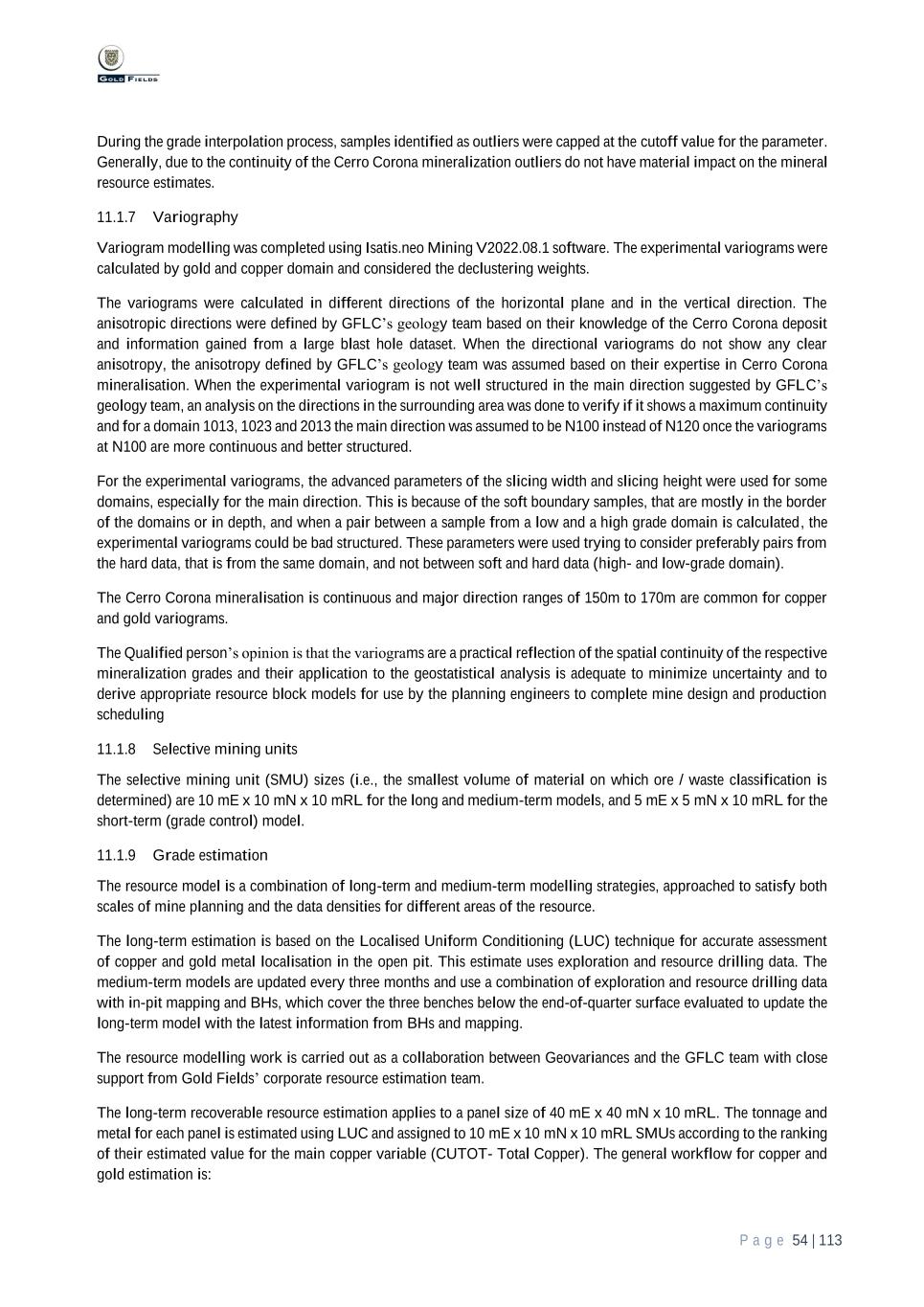
P a g e 54 | 113 During the grade interpolation process, samples identified as outliers were capped at the cutoff value for the parameter. Generally, due to the continuity of the Cerro Corona mineralization outliers do not have material impact on the mineral resource estimates. 11.1.7 Variography Variogram modelling was completed using Isatis.neo Mining V2022.08.1 software. The experimental variograms were calculated by gold and copper domain and considered the declustering weights. The variograms were calculated in different directions of the horizontal plane and in the vertical direction. The anisotropic directions were defined by GFLC’s geology team based on their knowledge of the Cerro Corona deposit and information gained from a large blast hole dataset. When the directional variograms do not show any clear anisotropy, the anisotropy defined by GFLC’s geology team was assumed based on their expertise in Cerro Corona mineralisation. When the experimental variogram is not well structured in the main direction suggested by GFLC’s geology team, an analysis on the directions in the surrounding area was done to verify if it shows a maximum continuity and for a domain 1013, 1023 and 2013 the main direction was assumed to be N100 instead of N120 once the variograms at N100 are more continuous and better structured. For the experimental variograms, the advanced parameters of the slicing width and slicing height were used for some domains, especially for the main direction. This is because of the soft boundary samples, that are mostly in the border of the domains or in depth, and when a pair between a sample from a low and a high grade domain is calculated, the experimental variograms could be bad structured. These parameters were used trying to consider preferably pairs from the hard data, that is from the same domain, and not between soft and hard data (high- and low-grade domain). The Cerro Corona mineralisation is continuous and major direction ranges of 150m to 170m are common for copper and gold variograms. The Qualified person’s opinion is that the variograms are a practical reflection of the spatial continuity of the respective mineralization grades and their application to the geostatistical analysis is adequate to minimize uncertainty and to derive appropriate resource block models for use by the planning engineers to complete mine design and production scheduling 11.1.8 Selective mining units The selective mining unit (SMU) sizes (i.e., the smallest volume of material on which ore / waste classification is determined) are 10 mE x 10 mN x 10 mRL for the long and medium-term models, and 5 mE x 5 mN x 10 mRL for the short-term (grade control) model. 11.1.9 Grade estimation The resource model is a combination of long-term and medium-term modelling strategies, approached to satisfy both scales of mine planning and the data densities for different areas of the resource. The long-term estimation is based on the Localised Uniform Conditioning (LUC) technique for accurate assessment of copper and gold metal localisation in the open pit. This estimate uses exploration and resource drilling data. The medium-term models are updated every three months and use a combination of exploration and resource drilling data with in-pit mapping and BHs, which cover the three benches below the end-of-quarter surface evaluated to update the long-term model with the latest information from BHs and mapping. The resource modelling work is carried out as a collaboration between Geovariances and the GFLC team with close support from Gold Fields’ corporate resource estimation team. The long-term recoverable resource estimation applies to a panel size of 40 mE x 40 mN x 10 mRL. The tonnage and metal for each panel is estimated using LUC and assigned to 10 mE x 10 mN x 10 mRL SMUs according to the ranking of their estimated value for the main copper variable (CUTOT- Total Copper). The general workflow for copper and gold estimation is:
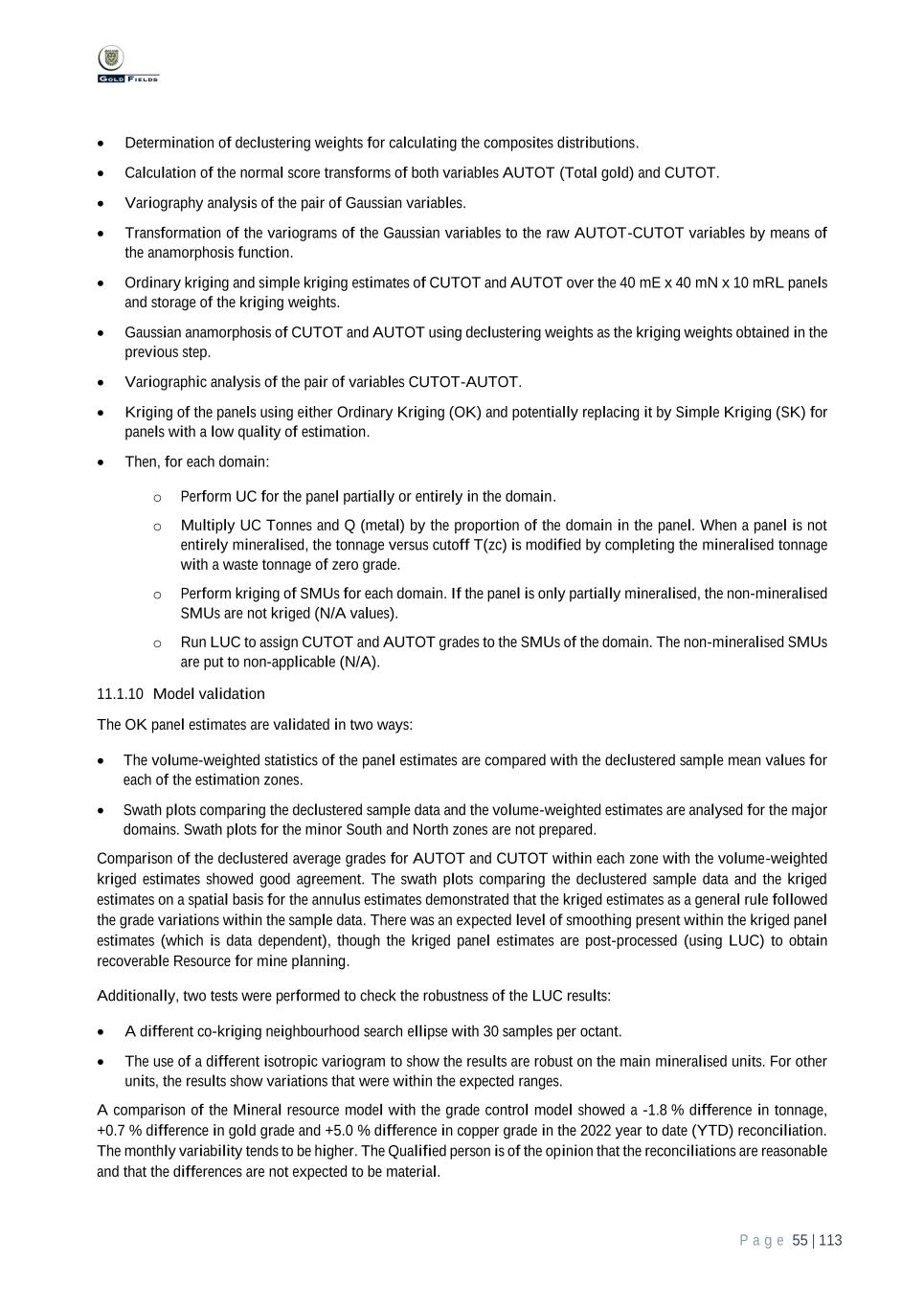
P a g e 55 | 113 • Determination of declustering weights for calculating the composites distributions. • Calculation of the normal score transforms of both variables AUTOT (Total gold) and CUTOT. • Variography analysis of the pair of Gaussian variables. • Transformation of the variograms of the Gaussian variables to the raw AUTOT-CUTOT variables by means of the anamorphosis function. • Ordinary kriging and simple kriging estimates of CUTOT and AUTOT over the 40 mE x 40 mN x 10 mRL panels and storage of the kriging weights. • Gaussian anamorphosis of CUTOT and AUTOT using declustering weights as the kriging weights obtained in the previous step. • Variographic analysis of the pair of variables CUTOT-AUTOT. • Kriging of the panels using either Ordinary Kriging (OK) and potentially replacing it by Simple Kriging (SK) for panels with a low quality of estimation. • Then, for each domain: o Perform UC for the panel partially or entirely in the domain. o Multiply UC Tonnes and Q (metal) by the proportion of the domain in the panel. When a panel is not entirely mineralised, the tonnage versus cutoff T(zc) is modified by completing the mineralised tonnage with a waste tonnage of zero grade. o Perform kriging of SMUs for each domain. If the panel is only partially mineralised, the non-mineralised SMUs are not kriged (N/A values). o Run LUC to assign CUTOT and AUTOT grades to the SMUs of the domain. The non-mineralised SMUs are put to non-applicable (N/A). 11.1.10 Model validation The OK panel estimates are validated in two ways: • The volume-weighted statistics of the panel estimates are compared with the declustered sample mean values for each of the estimation zones. • Swath plots comparing the declustered sample data and the volume-weighted estimates are analysed for the major domains. Swath plots for the minor South and North zones are not prepared. Comparison of the declustered average grades for AUTOT and CUTOT within each zone with the volume-weighted kriged estimates showed good agreement. The swath plots comparing the declustered sample data and the kriged estimates on a spatial basis for the annulus estimates demonstrated that the kriged estimates as a general rule followed the grade variations within the sample data. There was an expected level of smoothing present within the kriged panel estimates (which is data dependent), though the kriged panel estimates are post-processed (using LUC) to obtain recoverable Resource for mine planning. Additionally, two tests were performed to check the robustness of the LUC results: • A different co-kriging neighbourhood search ellipse with 30 samples per octant. • The use of a different isotropic variogram to show the results are robust on the main mineralised units. For other units, the results show variations that were within the expected ranges. A comparison of the Mineral resource model with the grade control model showed a -1.8 % difference in tonnage, +0.7 % difference in gold grade and +5.0 % difference in copper grade in the 2022 year to date (YTD) reconciliation. The monthly variability tends to be higher. The Qualified person is of the opinion that the reconciliations are reasonable and that the differences are not expected to be material.

P a g e 56 | 113 The grade control model had a YTD difference with the process plant of -2.0 % in tonnage, -3.8 % in gold and -4.3 % in copper, with often higher variability in the month-by-month data. This indicates that the grade control model is sufficiently reliable as a reference for the Mineral resource model. 11.1.11 Cutoff grades Cutoff grades are influenced by the operating strategy, design and scheduling, and are therefore calculated annually. As Cerro Corona is a polymetallic deposit, a net smelter return (NSR) cutoff is used rather than a grade cutoff. The NSR ($/t ore) is the revenue expected from the mill feed, taking into consideration mill recoveries, metal prices, gross royalties, transport costs of the concentrate to the smelter, treatment and refining charges and other deductions at the smelter. The NSR cutoff refers to the revenue that a block of ground ($/t ore) must be able to generate to cover these costs and qualify as ore. The NSR cutoff is calculated for the material within the pit shell using the following formula: NSR (g1, g2) = [g1*P1*SR1*(V1 – TCRC1)] + [g2*P2*SR2*(V2 – TCRC2)] Where: • g is metal grade (0.34 % Cu and 0.51 g/t Au) • P is the metal plant recovery (%) • SR is the metal smelter recovery (%) • V is the metal price per unit sold ($/lb or $/oz) • TCRC is the applicable smelting, refining, royalty and transport charges ($/lb or $/oz) Gold Fields conducts an annual review of metal prices for Mineral resource and Mineral reserve reporting to monitor any significant changes that would warrant re-calibrating the price deck for strategic and business planning purposes. This review takes into account prevailing economic, commodity price and exchange rate trends, together with market consensus forecasts and Gold Fields’ strategy and expectations for the mine operations. The recommended resource gold price of $1,600/oz and copper price of $3.60/lb is based on consideration of the following elements and rationale: • Ensuring Mineral resources are not too volatile year-on-year with protection against possible downside scenarios if the gold price falls up to ~25 % in a specific year. • Ensuring sufficient margin at prices incrementally lower than current spot price ranges and mitigating the risk of inflation. • The resource gold price premium to the reserve price is circa 13 % and the differential is in general alignment to Gold Fields’ peer group and industry standard practice. • The Mineral resource price premium provides information on each operation’s potential at higher gold prices and indicates possible future site infrastructure and mining footprint requirements. • The Qualified person has relied on information provided by the Registrant in preparing its findings and conclusions regarding commodity price and foreign currency exchange rate assumptions. • The NSR cutoff value used for the open pit Mineral resource estimate is $16.382/t ore.
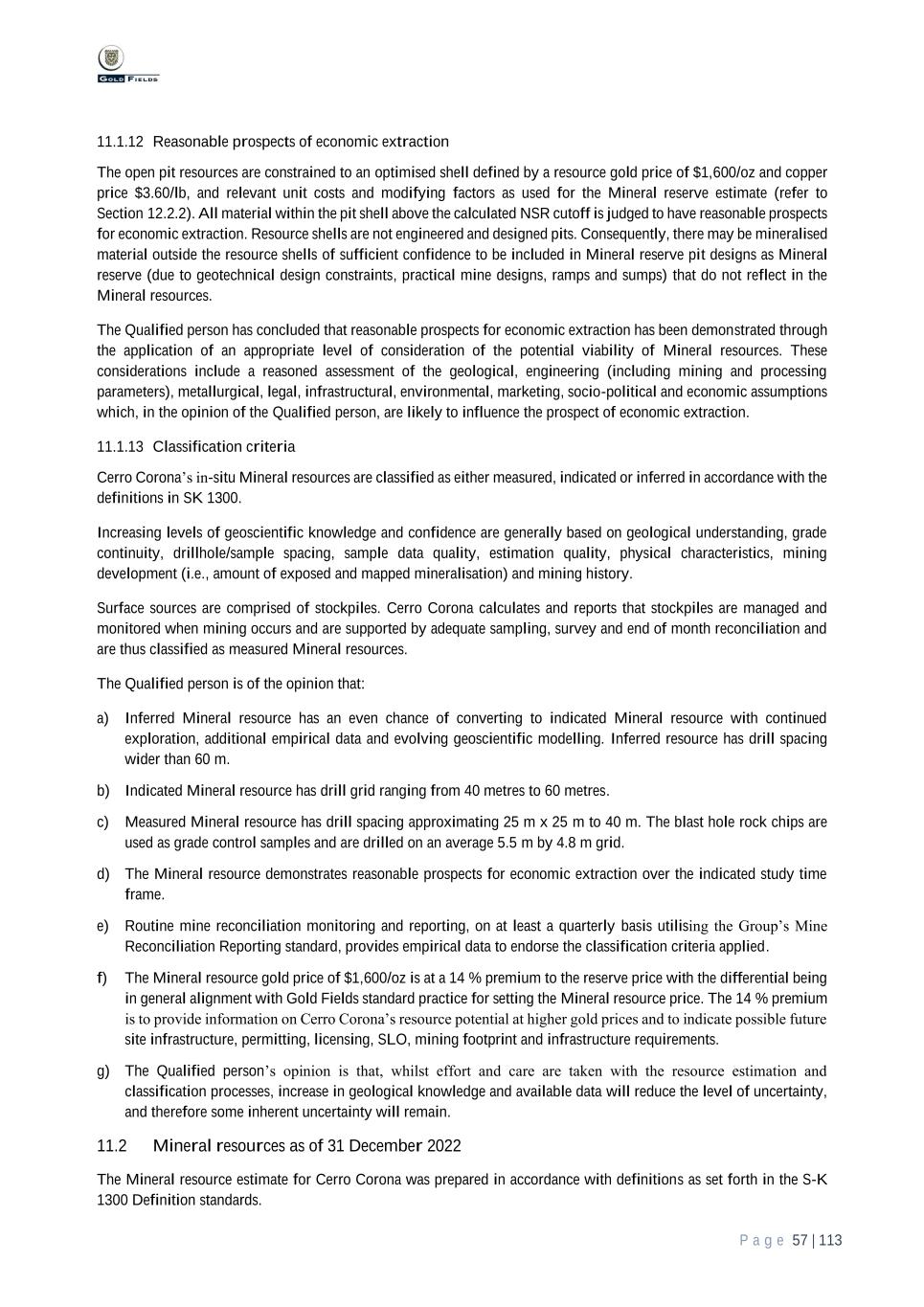
P a g e 57 | 113 11.1.12 Reasonable prospects of economic extraction The open pit resources are constrained to an optimised shell defined by a resource gold price of $1,600/oz and copper price $3.60/lb, and relevant unit costs and modifying factors as used for the Mineral reserve estimate (refer to Section 12.2.2). All material within the pit shell above the calculated NSR cutoff is judged to have reasonable prospects for economic extraction. Resource shells are not engineered and designed pits. Consequently, there may be mineralised material outside the resource shells of sufficient confidence to be included in Mineral reserve pit designs as Mineral reserve (due to geotechnical design constraints, practical mine designs, ramps and sumps) that do not reflect in the Mineral resources. The Qualified person has concluded that reasonable prospects for economic extraction has been demonstrated through the application of an appropriate level of consideration of the potential viability of Mineral resources. These considerations include a reasoned assessment of the geological, engineering (including mining and processing parameters), metallurgical, legal, infrastructural, environmental, marketing, socio-political and economic assumptions which, in the opinion of the Qualified person, are likely to influence the prospect of economic extraction. 11.1.13 Classification criteria Cerro Corona’s in-situ Mineral resources are classified as either measured, indicated or inferred in accordance with the definitions in SK 1300. Increasing levels of geoscientific knowledge and confidence are generally based on geological understanding, grade continuity, drillhole/sample spacing, sample data quality, estimation quality, physical characteristics, mining development (i.e., amount of exposed and mapped mineralisation) and mining history. Surface sources are comprised of stockpiles. Cerro Corona calculates and reports that stockpiles are managed and monitored when mining occurs and are supported by adequate sampling, survey and end of month reconciliation and are thus classified as measured Mineral resources. The Qualified person is of the opinion that: a) Inferred Mineral resource has an even chance of converting to indicated Mineral resource with continued exploration, additional empirical data and evolving geoscientific modelling. Inferred resource has drill spacing wider than 60 m. b) Indicated Mineral resource has drill grid ranging from 40 metres to 60 metres. c) Measured Mineral resource has drill spacing approximating 25 m x 25 m to 40 m. The blast hole rock chips are used as grade control samples and are drilled on an average 5.5 m by 4.8 m grid. d) The Mineral resource demonstrates reasonable prospects for economic extraction over the indicated study time frame. e) Routine mine reconciliation monitoring and reporting, on at least a quarterly basis utilising the Group’s Mine Reconciliation Reporting standard, provides empirical data to endorse the classification criteria applied. f) The Mineral resource gold price of $1,600/oz is at a 14 % premium to the reserve price with the differential being in general alignment with Gold Fields standard practice for setting the Mineral resource price. The 14 % premium is to provide information on Cerro Corona’s resource potential at higher gold prices and to indicate possible future site infrastructure, permitting, licensing, SLO, mining footprint and infrastructure requirements. g) The Qualified person’s opinion is that, whilst effort and care are taken with the resource estimation and classification processes, increase in geological knowledge and available data will reduce the level of uncertainty, and therefore some inherent uncertainty will remain. 11.2 Mineral resources as of 31 December 2022 The Mineral resource estimate for Cerro Corona was prepared in accordance with definitions as set forth in the S-K 1300 Definition standards.

P a g e 58 | 113 Based on the geological model, grade model, parameters for establishing prospects for economic extraction, and the resource classification discussed in this section, the in-situ Mineral resources for Cerro Corona are summarised in Table 11.2.1. The in-situ Mineral resources are stated exclusive of Mineral reserves to comply with S-K 1300 regulations and comprise approximately 40.5 Mt of measured and indicated Mineral resources with average gold and copper grades of 0.51 g/t and 0.34 % respectively. There is an additional 0.2 Mt in-situ inferred Mineral resources with a gold and copper grades of 0.38 g/t and 0.33 % respectively. The Mineral resources are 99.53 % attributable to Gold Fields and are net of production depletion up to 31 December 2022. All grades and tonnages reported are in-situ without any modifying factors applied, though modifying factors are applied in deriving the whittle shell which is used to constrain the Resources. Table 11.2.1: Cerro Corona – summary of attributable gold and copper Mineral resources at the end of the fiscal year ended 31 December 2022 based on a gold price of $1,600/oz and copper price of $3.60/lb Resources (exclusive of Mineral reserves) NSR Cutoff Metallurgical recovery Amount/ Grade Amount Grade Amount (kt) Au/ (g/t) Au/ (koz) Cu/ (%) Cu/ (Mlbs) ($/t) Au/ (%) Cu/ (%) Open pit Mineral resources OP measured Mineral resources 33,250 0.51 547 0.34 249 16.4 75.9 88.5 OP indicated Mineral resources 7,265 0.48 113 0.31 50 16.4 76.1 88.2 OP measured + indicated Mineral resources 40,515 0.51 660 0.34 300 16.4 75.9 – 76.1 88.2 – 88.5 OP inferred Mineral resources 145 0.38 2 0.33 1 16.4 76.0 88.4 Stockpile Mineral resources SP measured Mineral resources – oxides SP measured Mineral resources – sulphide SP indicated Mineral resources SP measured + indicated Mineral resources SP inferred Mineral resources Total Cerro Corona Mineral resources Total measured Mineral resources 2022 33,250 0.51 547 0.34 249 Total indicated Mineral resources 2022 7,265 0.48 113 0.31 50 Total measured + indicated Mineral resources 2022 40,515 0.51 660 0.34 300 Total inferred Mineral resources 2022 145 0.38 2 0.33 1 Total M+I Mineral resources 2021 37,454 0.46 557 0.32 264 Total Inferred Mineral resources 2021 300 0.37 4 0.30 2 Total M+I Year on year difference (%) 8 % 10 % 19 % 5 % 13 % Total Inferred Year on year difference (%) -52 % 1 % -51 % 12 % -46 % Notes: a) Mineral resources are exclusive of Mineral reserves. Rounding of figures may result in minor computational discrepancies. b) Mineral resources categories are assigned with consideration given to geological complexity, grade variance, drillhole intersection spacing and proximity of mining development. c) Mineral resources quoted as diluted in-situ metric tonnes and grades. Metallurgical recovery factors have not been applied to the estimates. The approximate metallurgical recovery factors are 88 % to copper and 76 % to gold. The metallurgical recovery is the ratio, expressed as a percentage, of the mass of the specific mineral product recovered from ore treated at the process plant to its total specific mineral content before treatment. Cerro Corona mining operations vary according to the mix of the source material (e.g., oxide, transitional, fresh and ore type blend). d) The metal prices used for the 2022 Mineral resources are based on a gold price of $1,600 per ounce and a copper price of $3.60 per pound. Open pit Mineral resources at the South American operations are similarly based on revenue factor 1.0 pits, appropriate mine design and extraction schedules. The gold price used for Mineral resources approximates 14 % higher than the selected Mineral reserve price based on the three-year trailing average ($1,789.45 per oz) to end December 2022, calculated on a monthly basis of the London afternoon fixing price of gold. e) The cutoff grade may vary per mine, depending on the respective costs, depletion schedule, ore type, expected mining dilution and expected mining recovery. The average cutoff grade value applied to the Mineral resources is: $16.382/t. f) The Mineral resources are based on initial assessments at the resource gold price of $1,600/oz and copper price of $3.60/lb consider estimates of all Cerro Corona costs, the impact of modifying factors such as mining dilution and mining recovery, processing recovery and royalties. Mineral resources are also tested through the application of Environmental, Social and Governance (ESG) criteria to demonstrate reasonable prospects for economic extraction. g) The Mineral resources are estimated at a point in time and can be affected by changes in the gold price, US Dollar currency exchange rates, permitting, legislation, costs and operating parameters. h) Cerro Corona is 99.53 % attributable to Gold Fields and is entitled to mine all declared material located within the property's mineral leases and all necessary statutory mining authorisations and permits are in place or have reasonable expectation of being granted. Source: Cerro Corona CPR, 2022
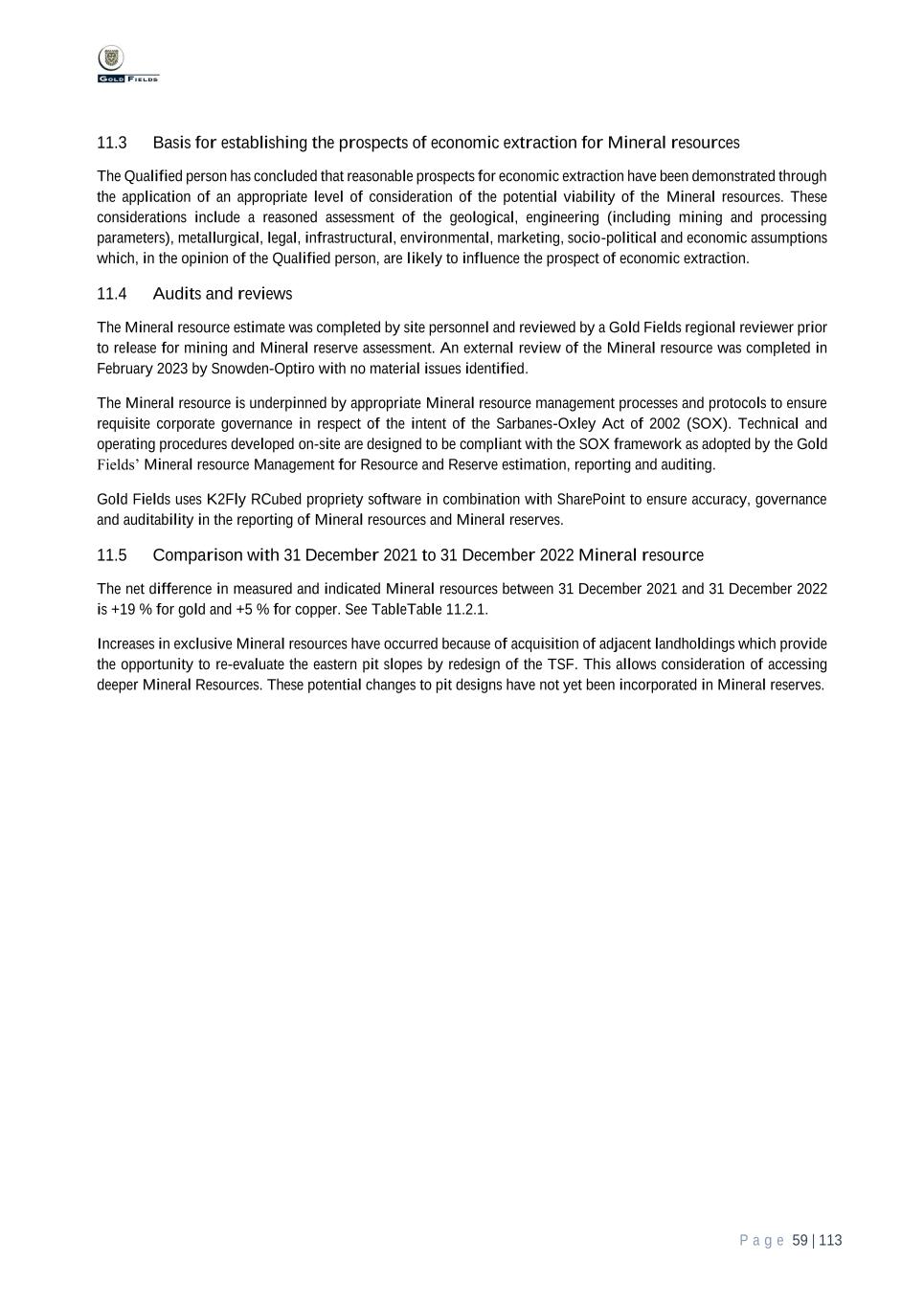
P a g e 59 | 113 11.3 Basis for establishing the prospects of economic extraction for Mineral resources The Qualified person has concluded that reasonable prospects for economic extraction have been demonstrated through the application of an appropriate level of consideration of the potential viability of the Mineral resources. These considerations include a reasoned assessment of the geological, engineering (including mining and processing parameters), metallurgical, legal, infrastructural, environmental, marketing, socio-political and economic assumptions which, in the opinion of the Qualified person, are likely to influence the prospect of economic extraction. 11.4 Audits and reviews The Mineral resource estimate was completed by site personnel and reviewed by a Gold Fields regional reviewer prior to release for mining and Mineral reserve assessment. An external review of the Mineral resource was completed in February 2023 by Snowden-Optiro with no material issues identified. The Mineral resource is underpinned by appropriate Mineral resource management processes and protocols to ensure requisite corporate governance in respect of the intent of the Sarbanes-Oxley Act of 2002 (SOX). Technical and operating procedures developed on-site are designed to be compliant with the SOX framework as adopted by the Gold Fields’ Mineral resource Management for Resource and Reserve estimation, reporting and auditing. Gold Fields uses K2Fly RCubed propriety software in combination with SharePoint to ensure accuracy, governance and auditability in the reporting of Mineral resources and Mineral reserves. 11.5 Comparison with 31 December 2021 to 31 December 2022 Mineral resource The net difference in measured and indicated Mineral resources between 31 December 2021 and 31 December 2022 is +19 % for gold and +5 % for copper. See TableTable 11.2.1. Increases in exclusive Mineral resources have occurred because of acquisition of adjacent landholdings which provide the opportunity to re-evaluate the eastern pit slopes by redesign of the TSF. This allows consideration of accessing deeper Mineral Resources. These potential changes to pit designs have not yet been incorporated in Mineral reserves.
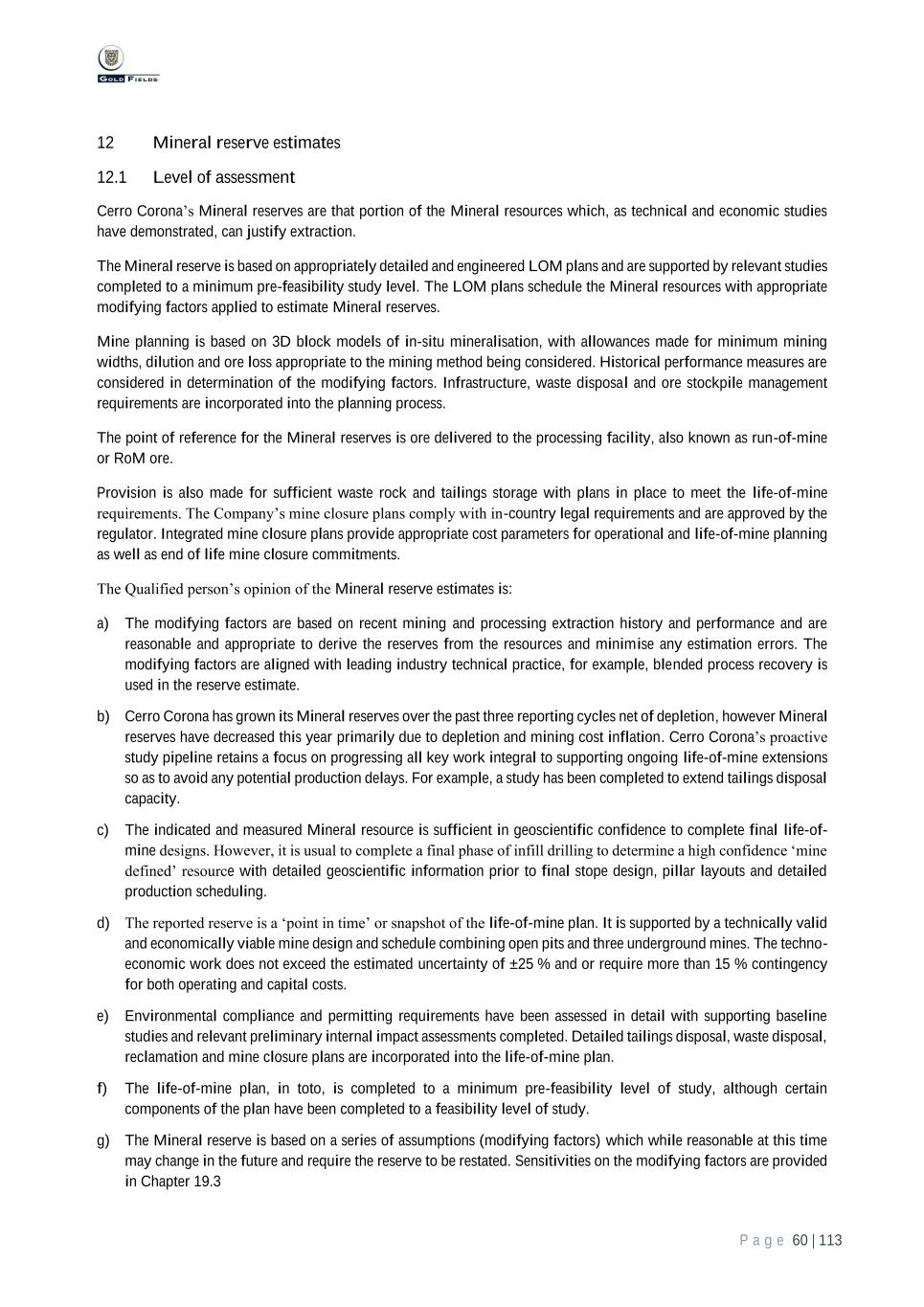
P a g e 60 | 113 12 Mineral reserve estimates 12.1 Level of assessment Cerro Corona’s Mineral reserves are that portion of the Mineral resources which, as technical and economic studies have demonstrated, can justify extraction. The Mineral reserve is based on appropriately detailed and engineered LOM plans and are supported by relevant studies completed to a minimum pre-feasibility study level. The LOM plans schedule the Mineral resources with appropriate modifying factors applied to estimate Mineral reserves. Mine planning is based on 3D block models of in-situ mineralisation, with allowances made for minimum mining widths, dilution and ore loss appropriate to the mining method being considered. Historical performance measures are considered in determination of the modifying factors. Infrastructure, waste disposal and ore stockpile management requirements are incorporated into the planning process. The point of reference for the Mineral reserves is ore delivered to the processing facility, also known as run-of-mine or RoM ore. Provision is also made for sufficient waste rock and tailings storage with plans in place to meet the life-of-mine requirements. The Company’s mine closure plans comply with in-country legal requirements and are approved by the regulator. Integrated mine closure plans provide appropriate cost parameters for operational and life-of-mine planning as well as end of life mine closure commitments. The Qualified person’s opinion of the Mineral reserve estimates is: a) The modifying factors are based on recent mining and processing extraction history and performance and are reasonable and appropriate to derive the reserves from the resources and minimise any estimation errors. The modifying factors are aligned with leading industry technical practice, for example, blended process recovery is used in the reserve estimate. b) Cerro Corona has grown its Mineral reserves over the past three reporting cycles net of depletion, however Mineral reserves have decreased this year primarily due to depletion and mining cost inflation. Cerro Corona’s proactive study pipeline retains a focus on progressing all key work integral to supporting ongoing life-of-mine extensions so as to avoid any potential production delays. For example, a study has been completed to extend tailings disposal capacity. c) The indicated and measured Mineral resource is sufficient in geoscientific confidence to complete final life-of- mine designs. However, it is usual to complete a final phase of infill drilling to determine a high confidence ‘mine defined’ resource with detailed geoscientific information prior to final stope design, pillar layouts and detailed production scheduling. d) The reported reserve is a ‘point in time’ or snapshot of the life-of-mine plan. It is supported by a technically valid and economically viable mine design and schedule combining open pits and three underground mines. The techno- economic work does not exceed the estimated uncertainty of ±25 % and or require more than 15 % contingency for both operating and capital costs. e) Environmental compliance and permitting requirements have been assessed in detail with supporting baseline studies and relevant preliminary internal impact assessments completed. Detailed tailings disposal, waste disposal, reclamation and mine closure plans are incorporated into the life-of-mine plan. f) The life-of-mine plan, in toto, is completed to a minimum pre-feasibility level of study, although certain components of the plan have been completed to a feasibility level of study. g) The Mineral reserve is based on a series of assumptions (modifying factors) which while reasonable at this time may change in the future and require the reserve to be restated. Sensitivities on the modifying factors are provided in Chapter 19.3
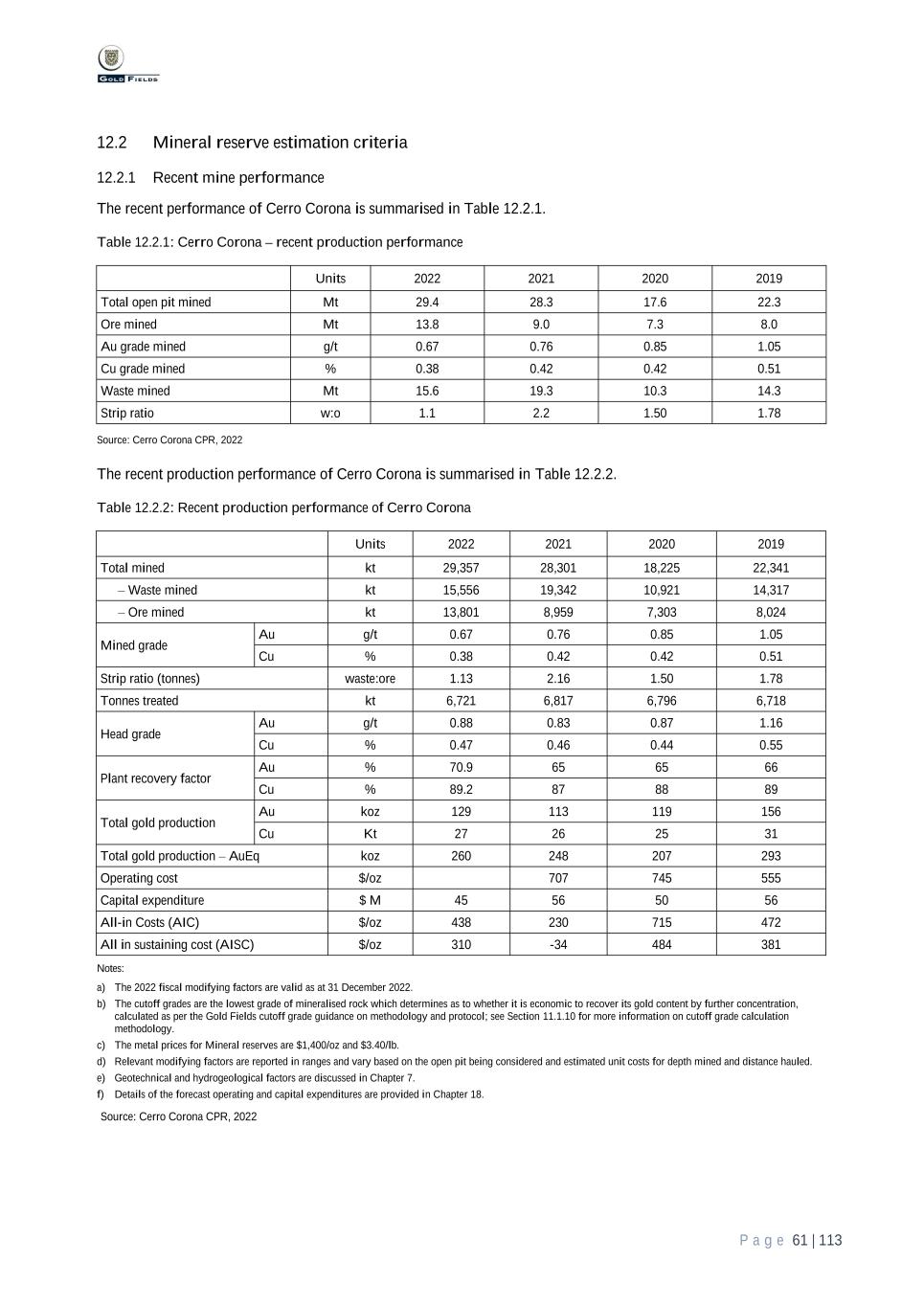
P a g e 61 | 113 12.2 Mineral reserve estimation criteria 12.2.1 Recent mine performance The recent performance of Cerro Corona is summarised in Table 12.2.1. Table 12.2.1: Cerro Corona – recent production performance Units 2022 2021 2020 2019 Total open pit mined Mt 29.4 28.3 17.6 22.3 Ore mined Mt 13.8 9.0 7.3 8.0 Au grade mined g/t 0.67 0.76 0.85 1.05 Cu grade mined % 0.38 0.42 0.42 0.51 Waste mined Mt 15.6 19.3 10.3 14.3 Strip ratio w:o 1.1 2.2 1.50 1.78 Source: Cerro Corona CPR, 2022 The recent production performance of Cerro Corona is summarised in Table 12.2.2. Table 12.2.2: Recent production performance of Cerro Corona Units 2022 2021 2020 2019 Total mined kt 29,357 28,301 18,225 22,341 – Waste mined kt 15,556 19,342 10,921 14,317 – Ore mined kt 13,801 8,959 7,303 8,024 Mined grade Au g/t 0.67 0.76 0.85 1.05 Cu % 0.38 0.42 0.42 0.51 Strip ratio (tonnes) waste:ore 1.13 2.16 1.50 1.78 Tonnes treated kt 6,721 6,817 6,796 6,718 Head grade Au g/t 0.88 0.83 0.87 1.16 Cu % 0.47 0.46 0.44 0.55 Plant recovery factor Au % 70.9 65 65 66 Cu % 89.2 87 88 89 Total gold production Au koz 129 113 119 156 Cu Kt 27 26 25 31 Total gold production – AuEq koz 260 248 207 293 Operating cost $/oz 707 745 555 Capital expenditure $ M 45 56 50 56 All-in Costs (AIC) $/oz 438 230 715 472 All in sustaining cost (AISC) $/oz 310 -34 484 381 Notes: a) The 2022 fiscal modifying factors are valid as at 31 December 2022. b) The cutoff grades are the lowest grade of mineralised rock which determines as to whether it is economic to recover its gold content by further concentration, calculated as per the Gold Fields cutoff grade guidance on methodology and protocol; see Section 11.1.10 for more information on cutoff grade calculation methodology. c) The metal prices for Mineral reserves are $1,400/oz and $3.40/lb. d) Relevant modifying factors are reported in ranges and vary based on the open pit being considered and estimated unit costs for depth mined and distance hauled. e) Geotechnical and hydrogeological factors are discussed in Chapter 7. f) Details of the forecast operating and capital expenditures are provided in Chapter 18. Source: Cerro Corona CPR, 2022

P a g e 62 | 113 12.2.2 Key assumptions and parameters The assumptions and parameters considered in the Mineral reserve estimate are summarised in Table 12.2.3 and are derived from historical performance. Table 12.2.3: Key technical modifying factors for mine planning Units December 2022 December 2021 December 2020 December 2019 Gold price $/oz 1,400 1,300 1,300 1,200 Copper price $/lb 3.4 2.8 2.8 2.8 Gold royalty % 0.02 0.02 0.02 0.02 Copper royalty % 12.41 12.41 12.41 12.41 Dilution % 0 0 0 0 Mining recovery % 98 98 98 98 Mine call factor % 100 100 100 100 Plant recovery (Au) % 68 68 68 68 Plant recovery (Cu) % 87 87 86 88 NSR (Au) % 16.38 14.99 14.97 14.45 NSR (Cu) % 16.38 14.99 14.97 14.44 Processing throughput Mt/a 6.7 6.7 6.7 6.7 Mining cost $/t rock 3.14 3.12 3.53 3.225 Processing cost $/t ore 8.97 7.57 7.64 7.603 Stockpiles reclaim cost $t ore 0.30 0.29 0.29 0.3 Sustaining capital cost $/t ore 2.00 1.99 2.00 1.92 G&A cost $/t ore 5.68 5.71 5.82 5.57 Pit wall angles degrees 49 49 51 51 Bench height m 10 10 10 10 Source: Cerro Corona CPR, 2022 Geotechnical and hydrogeological factors are discussed in Section 7. Mining costs include all costs of ore and overburden mining and is divided into drill and blast ($0.61/t), loading ($0.22/bcm for ore and $0.335/bcm for waste), haulage ($0.712/bcm-km for ore <1 km, $0.405/bcm-km for ore >1 km, $0.705/bcm-km for waste <1 km and $0.401/bcm-km for waste>1 km), mining supervision ($0.47/t) and other mining- related costs such as road maintenance ($0.34/t) and general earthworks ($0.20/t). The Cerro Corona mine life is currently limited by the TSF storage capacity, however there is sufficient TSF capacity to support the current LOM plan. As disclosed in Section 11.1.11, Gold Fields conducts an annual review of metal prices for Mineral resource and Mineral reserve reporting to monitor any significant changes that would warrant re-calibrating the price deck for strategic and business planning purposes. This review considers prevailing economic, commodity price and exchange rate trends, together with market consensus forecasts and Gold Fields’ strategy and expectations for the mine operations. The recommended reserve gold price is $1,400/oz and copper price is $3.40/lb. Refer to Chapter 16 for more pricing detail. 12.2.3 Cutoff grades As with the Mineral resource cutoff grade, the Mineral reserve cutoff is determined on a NSR basis. The cutoff value is influenced by the operating strategy, design and scheduling, and are therefore calculated annually. The cutoff value used for the open pit Mineral reserve estimate are calculated using the same methodology described in Section 11.1.11. The NSR cutoff value used for the open pit Mineral reserve estimate is $16.382/t ore.

P a g e 63 | 113 Notes: a) The cutoffs are estimated based on the reserve price and reserve modifying factors and are not expected to change materially over the life-of-mine reserve. b) The cutoff grades, price and modifying factors are incorporated in the estimation of the reserve shell. c) The Qualified person is of the opinion that the design of the selected reserve shells used in the reserve estimation minimises estimation errors. 12.2.4 Mine design Open pit mining is by conventional drill and blast, with truck and excavator operations. Further details on the mining methods are provided in Section 13. Open pit planning involves the input of economic parameters and physical constraints into optimisation software (Geovia Whittle) to generate a series of nested pits from which a pit is selected for design. The optimal shell selected is limited to a maximum of 38.1 Mt of ore to align with the forecast LOM tailings storage capacity. Detailed design is then undertaken to confirm the mineability of the optimised shell. The process is iterated until an acceptable level of correlation is achieved between the optimised pit shell and detailed design. Due to the requirement that engineered and designed pit shells are practical and consider geotechnical stability, access ramps, sumps and other design criteria, some mineralised material of sufficient confidence to be considered Mineral reserve may be included in the Mineral reserve even though it does not reflect in the Mineral resource which is based only on optimised shells. Similarly, some Mineral resources above the Reserve cutoff grade may be excluded from the Mineral reserve. 12.2.5 Mining schedule A time-based economic evaluation is undertaken of the completed mining and processing schedule to ensure economic viability over the reserve life with the requisite rehabilitation and end of life mine closure costs also incorporated into the financial assessment. Refer to Chapter 19.1 for details on the life-of-mine cost schedule. The Qualified person is of the opinion that the mine plan and schedule incorporate appropriate assessment of all relevant technical, environmental, social and financial aspects to ensure the Mineral reserve complies with the SK rule instructions and requirements. After reasonable assessment there is no unresolved material matter that could have a significant impact on the mines ability to execute the life-of-mine plan. The mine plan and schedule incorporate consideration of the following key criteria: • Production depletion up to 31 December 2022. • Application of cutoff grades to determine mineable ore. • Application of appropriate modifying factors to convert resource to reserve. • Allocation of suitable mining equipment and costs. • Incorporation of realistic mining rates and efficiencies. • Practical and realistic mine design and mining methods. • Integrated production scheduling taking account of capacities, constraints and bottlenecks. • Integrated project management and execution. • Security of water and energy for the life-of-mine. • Provision for mine rehabilitation and mine closure costs. • Consideration of all environmental, social and legal aspects to enable life-of-mine plan execution. • Appropriate life-of-mine tail end management.

P a g e 64 | 113 • Security of current and future land tenure and agreements, permits and licenses. • Life of mine cashflow model and economic viability. 12.2.6 Classification criteria Cerro Corona’s Mineral reserves are classified as either proven or probable in accordance with the definitions in SK 1300. Mineral reserve statements include only measured and indicated Mineral resources modified to produce Mineral reserves contained in the LOM plan. In general, a proven Mineral reserve is derived from a measured Mineral resource and existing stockpiles. The probable Mineral reserve is derived from indicated Mineral resource material. 12.2.7 Economic assessment The basis for establishing economic viability is discussed in Section 19. 12.3 Mineral reserves as of 31 December 2022 The Cerro Corona Mineral reserves as of 31 December 2022 are summarised in Table 12.3.1. The Mineral reserves are 99.53 % attributable to Gold Fields and are net of production depletion up to 31 December 2022. The Mineral reserves are reported in terms of RoM grades and tonnages delivered to the processing facility and are therefore fully diluted. Table 12.3.1: Cerro Corona - summary of attributable gold and copper Mineral reserves at the end of the fiscal year ended 31 December 2022 based on a gold price of $1,400/oz and copper price of $3.40/lb Amount/ Grade Amount Grade Amount Cutoff grades/ Metallurgical recovery (Kt) Au/ (g/t) Au/ (koz) Cu/ (%) Cu/ (Mlb) ($/t NSR) Au/ (%) Cu/ (%) Open Pit Mineral reserves OP proven Mineral reserves 34,705 0.56 623 0.37 284 16.4 75.8 88.8 OP probable Mineral reserves 2,006 0.47 30 0.33 14 16.4 76.0 88.3 OP total Mineral reserves 36,711 0.55 653 0.37 298 16.4 75.8 – 76.0 88.3 – 88.8 Stockpile Mineral reserves SP proven Mineral reserves 13,185 0.52 219 0.34 100 16.4 75.9 88.5 SP probable Mineral reserves SP total Mineral reserves 13,185 0.52 219 0.34 100 16.4 75.9 88.5 Total Mineral reserves Total proven Mineral reserves 47,890 0.55 842 0.36 384 Total probable Mineral reserves 2,006 0.47 30 0.33 14 Total Cerro Corona Mineral reserves 2022 49,896 0.54 872 0.36 398 Total Cerro Corona Mineral reserves 2021 58,020 0.59 1,103 0.37 474 Year-on-year difference (%) -14 % -8 % -21 % -2 % -16 % Notes: a) Rounding of figures may result in minor computational discrepancies. b) Refer to Table 12.5.1 for year-on-year Mineral reserve comparison. c) Mineral reserve quoted as mill delivered metric tonnes and ROM grades, inclusive of all mining dilutions and gold losses except mill recovery. Metallurgical recovery factors have not been applied to the Mineral reserve figures. The approximate metallurgical recovery factors are 76 % for gold and 89 % for copper. The metallurgical recovery is the ratio, expressed as a percentage, of the mass of the specific mineral product recovered from ore treated at the process plant to its total specific mineral content before treatment. The recoveries for Cerro Corona vary according to the mix of the source material (e.g., oxide, transitional fresh and ore type blend) and method of treatment. d) The metal prices used for the 2022 life-of-mine (LOM) Mineral reserves are based on a gold price of $1,400/ounce and copper price of $3.40/lb. Open pit Mineral reserves at Cerro Corona are based on optimised pits and appropriate mine design and extraction schedules. The gold price and copper price used for Mineral reserves is detailed in Chapter 16 Marketing. e) Dilution relates to planned and unplanned waste and/or low-grade material being mined and delivered to the process plant. Ranges are given for those operations that have multiple orebody styles and mining methodologies. The mine dilution factors are 0 %. f) The mining recovery factor relates to the proportion or percentage of ore mined from the defined orebody at the gold price used for the declaration of Mineral reserves. This percentage will vary from mining area to mining area and reflects planned and scheduled reserves against actual tonnes, grade and metal mined, with all modifying factors and mining constraints applied. The mining recovery factors are 98 %. g) The cutoff grade may vary per mine, depending on the respective costs, depletion schedule, ore type, expected mining dilution and expected mining recovery. The average NSR cutoff value applied in the planning process is $16.382/t.
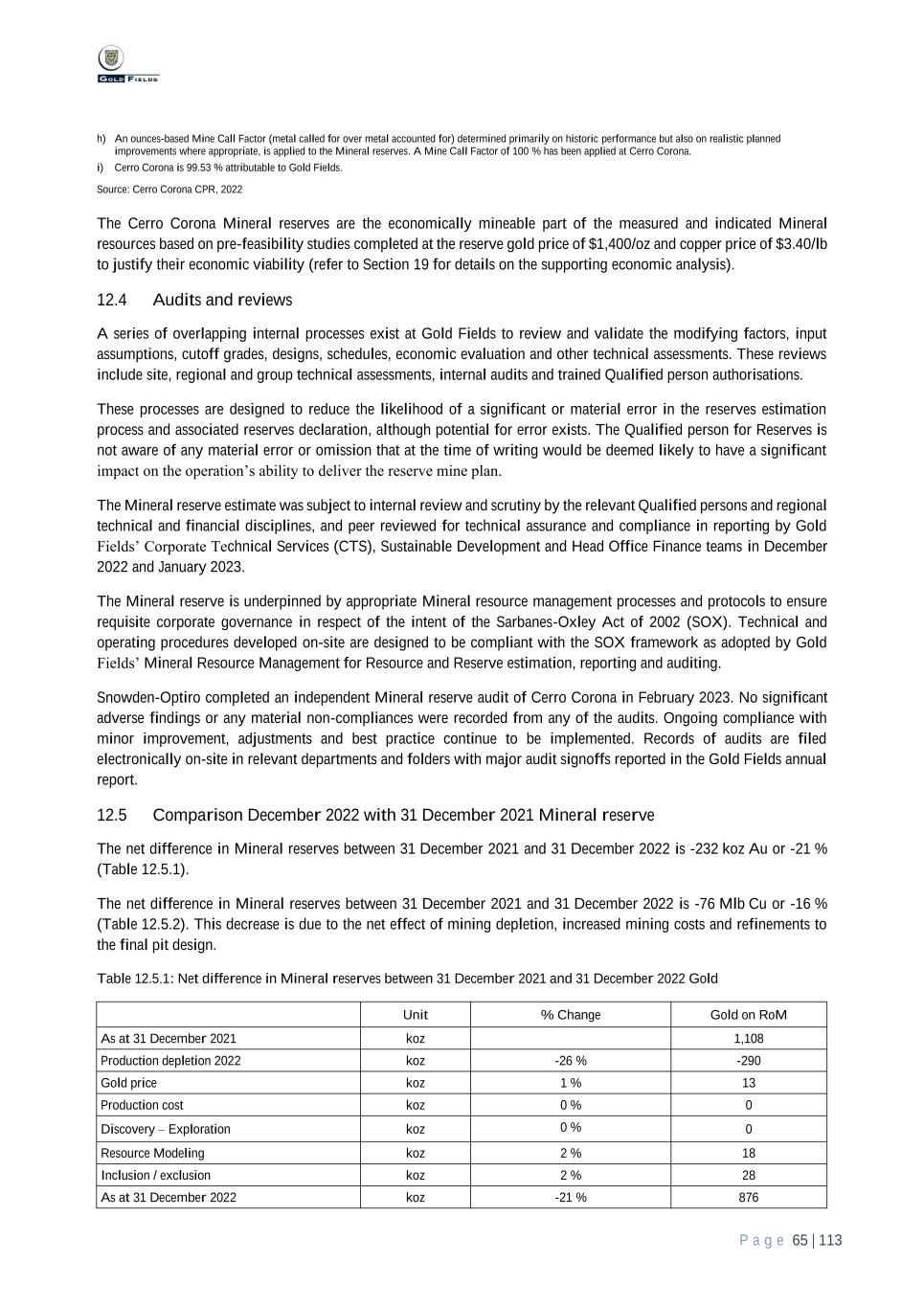
P a g e 65 | 113 h) An ounces-based Mine Call Factor (metal called for over metal accounted for) determined primarily on historic performance but also on realistic planned improvements where appropriate, is applied to the Mineral reserves. A Mine Call Factor of 100 % has been applied at Cerro Corona. i) Cerro Corona is 99.53 % attributable to Gold Fields. Source: Cerro Corona CPR, 2022 The Cerro Corona Mineral reserves are the economically mineable part of the measured and indicated Mineral resources based on pre-feasibility studies completed at the reserve gold price of $1,400/oz and copper price of $3.40/lb to justify their economic viability (refer to Section 19 for details on the supporting economic analysis). 12.4 Audits and reviews A series of overlapping internal processes exist at Gold Fields to review and validate the modifying factors, input assumptions, cutoff grades, designs, schedules, economic evaluation and other technical assessments. These reviews include site, regional and group technical assessments, internal audits and trained Qualified person authorisations. These processes are designed to reduce the likelihood of a significant or material error in the reserves estimation process and associated reserves declaration, although potential for error exists. The Qualified person for Reserves is not aware of any material error or omission that at the time of writing would be deemed likely to have a significant impact on the operation’s ability to deliver the reserve mine plan. The Mineral reserve estimate was subject to internal review and scrutiny by the relevant Qualified persons and regional technical and financial disciplines, and peer reviewed for technical assurance and compliance in reporting by Gold Fields’ Corporate Technical Services (CTS), Sustainable Development and Head Office Finance teams in December 2022 and January 2023. The Mineral reserve is underpinned by appropriate Mineral resource management processes and protocols to ensure requisite corporate governance in respect of the intent of the Sarbanes-Oxley Act of 2002 (SOX). Technical and operating procedures developed on-site are designed to be compliant with the SOX framework as adopted by Gold Fields’ Mineral Resource Management for Resource and Reserve estimation, reporting and auditing. Snowden-Optiro completed an independent Mineral reserve audit of Cerro Corona in February 2023. No significant adverse findings or any material non-compliances were recorded from any of the audits. Ongoing compliance with minor improvement, adjustments and best practice continue to be implemented. Records of audits are filed electronically on-site in relevant departments and folders with major audit signoffs reported in the Gold Fields annual report. 12.5 Comparison December 2022 with 31 December 2021 Mineral reserve The net difference in Mineral reserves between 31 December 2021 and 31 December 2022 is -232 koz Au or -21 % (Table 12.5.1). The net difference in Mineral reserves between 31 December 2021 and 31 December 2022 is -76 Mlb Cu or -16 % (Table 12.5.2). This decrease is due to the net effect of mining depletion, increased mining costs and refinements to the final pit design. Table 12.5.1: Net difference in Mineral reserves between 31 December 2021 and 31 December 2022 Gold Unit % Change Gold on RoM As at 31 December 2021 koz 1,108 Production depletion 2022 koz -26 % -290 Gold price koz 1 % 13 Production cost koz 0 % 0 Discovery – Exploration koz 0 % 0 Resource Modeling koz 2 % 18 Inclusion / exclusion koz 2 % 28 As at 31 December 2022 koz -21 % 876
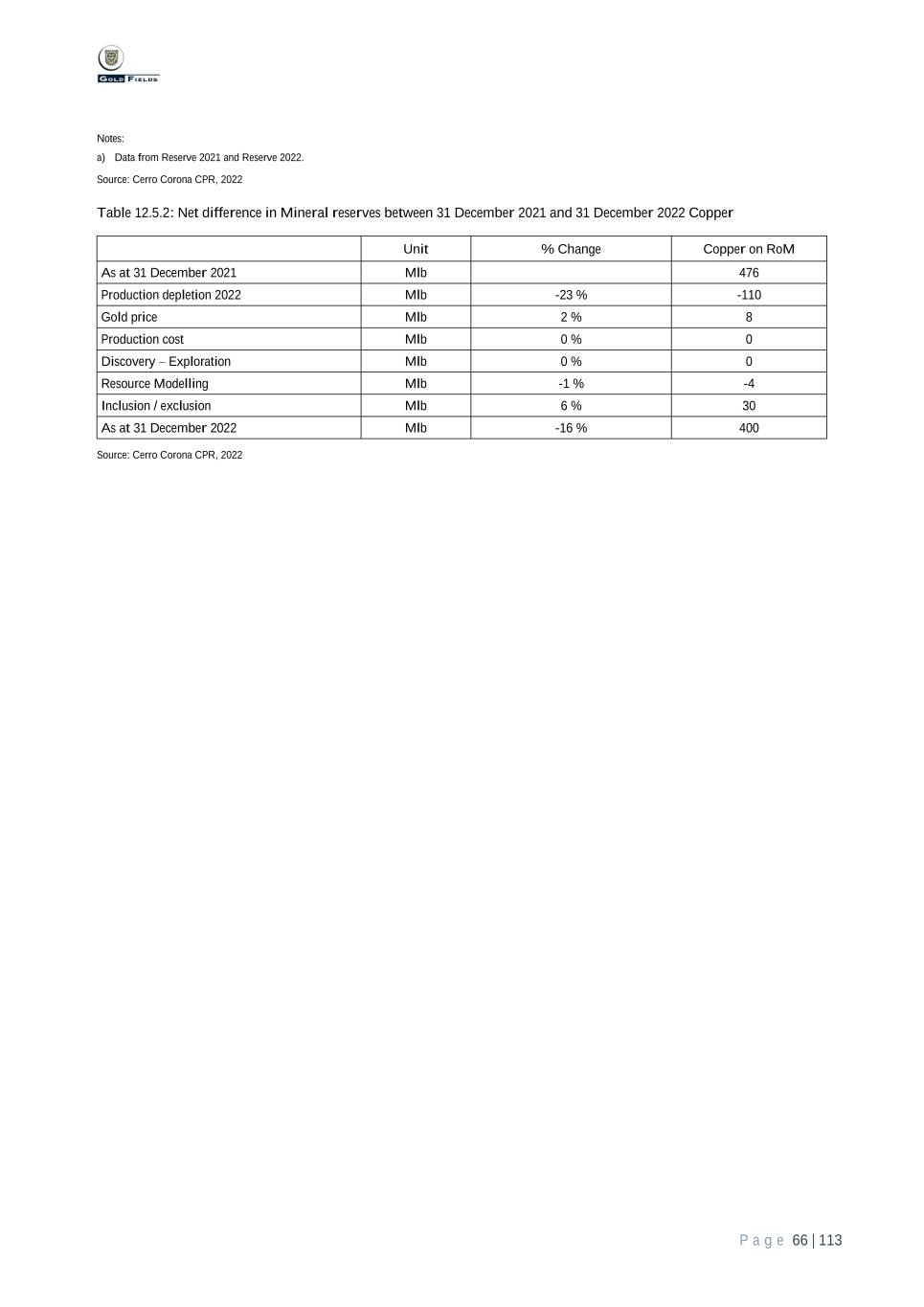
P a g e 66 | 113 Notes: a) Data from Reserve 2021 and Reserve 2022. Source: Cerro Corona CPR, 2022 Table 12.5.2: Net difference in Mineral reserves between 31 December 2021 and 31 December 2022 Copper Unit % Change Copper on RoM As at 31 December 2021 Mlb 476 Production depletion 2022 Mlb -23 % -110 Gold price Mlb 2 % 8 Production cost Mlb 0 % 0 Discovery – Exploration Mlb 0 % 0 Resource Modelling Mlb -1 % -4 Inclusion / exclusion Mlb 6 % 30 As at 31 December 2022 Mlb -16 % 400 Source: Cerro Corona CPR, 2022

P a g e 67 | 113 13 Mining Methods 13.1 Methods The Cerro Corona open pit is mined by conventional drill and blast methods with truck and excavator fleets. Mining benches are generally 10 m high in limestone, silica and potassic units. Haul roads have 10 % of maximum gradient configuration. All material requires drill and blast with varying powder factors according to rock hardness using 200 mm diameter production BHs. The operations quarry is being mined to provide limestone for the tailing’s facility construction. A proportion of the clay waste removed from the pit is also used for this purpose. All operation and maintenance of mining equipment is completed by the mining contractor. The new mining contractor has flexibility relating to its mining fleet and is committed to mobilising a fleet of 55 t trucks as the material movement rate increases. Since the start of GFLC’s involvement in 2008, planned annual total tonnes have been achieved. The Qualified person’s opinion is that the Mineral reserve modifying factors including strip ratios and the open pit cutoff grades are realistic and appropriate for life-of-mine planning. Further, the mining fleet configuration, equipment specifications, practical mining rates, selective mining unit dimensions, mining dilution and mining recovery assumptions and inputs to the mine design and schedule are suitable in support of the Mineral reserve estimates and present no material risk. 13.2 Mine design and planning factors. Technical and economic factors associated with the mine design and plan is provided in Section 12.2.2. Accelerated mining based on nine separate pit stages will exceed processing rates and allow for tailings generated in the future to be placed in the pit.
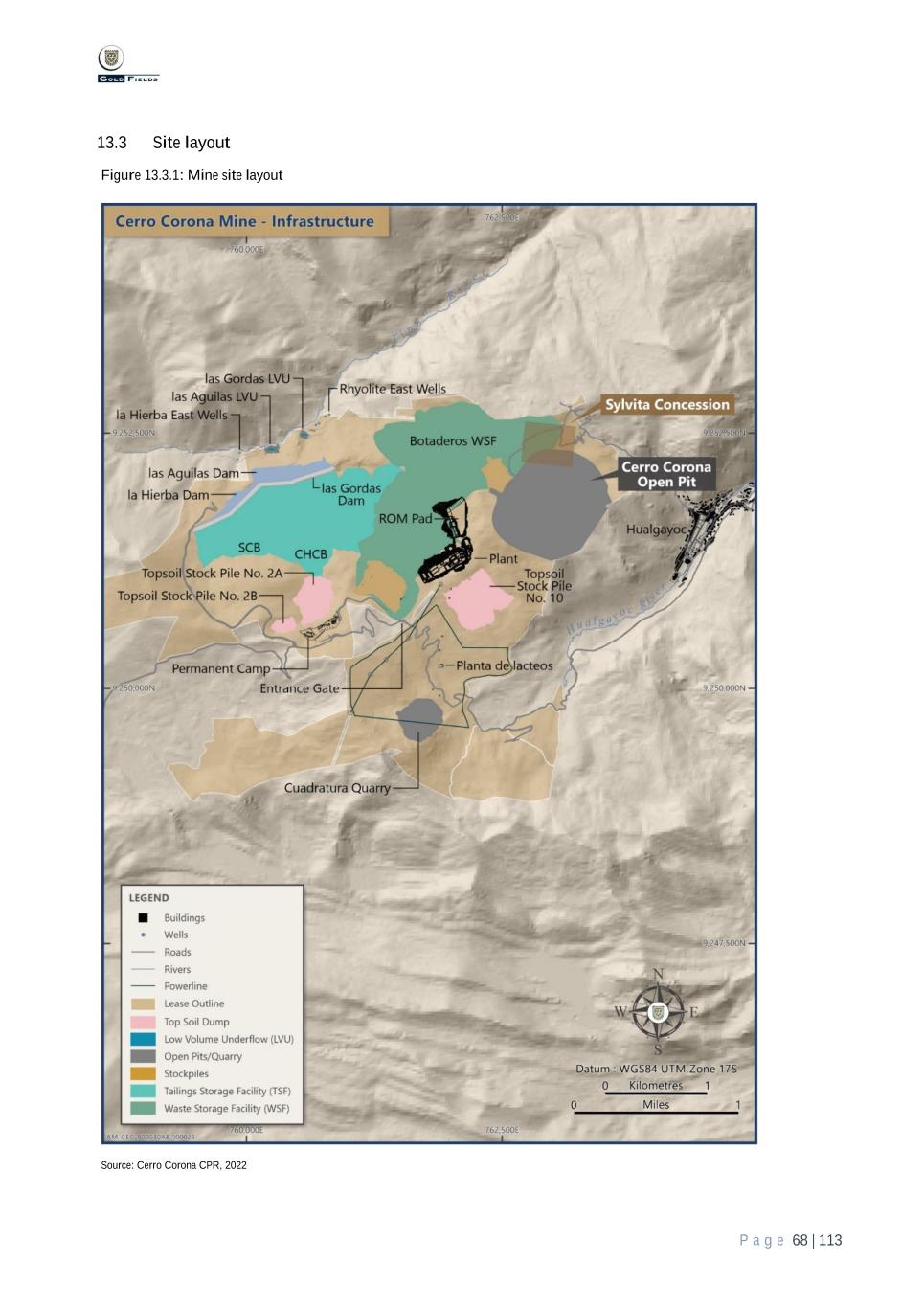
P a g e 68 | 113 13.3 Site layout Figure 13.3.1: Mine site layout Source: Cerro Corona CPR, 2022

P a g e 69 | 113 13.4 Equipment and labour requirements Load and haul activities are carried out by 11 x 40 t trucks, 13 x 45 t trucks, 23 x 55 t trucks and 5 excavators with a bucket capacity varying between 4.8 and 6 m³. 13.5 Final mine layout Figure 13.5.1: Final mine outline life-of-mine reserve Source: Cerro Corona CPR, 2022
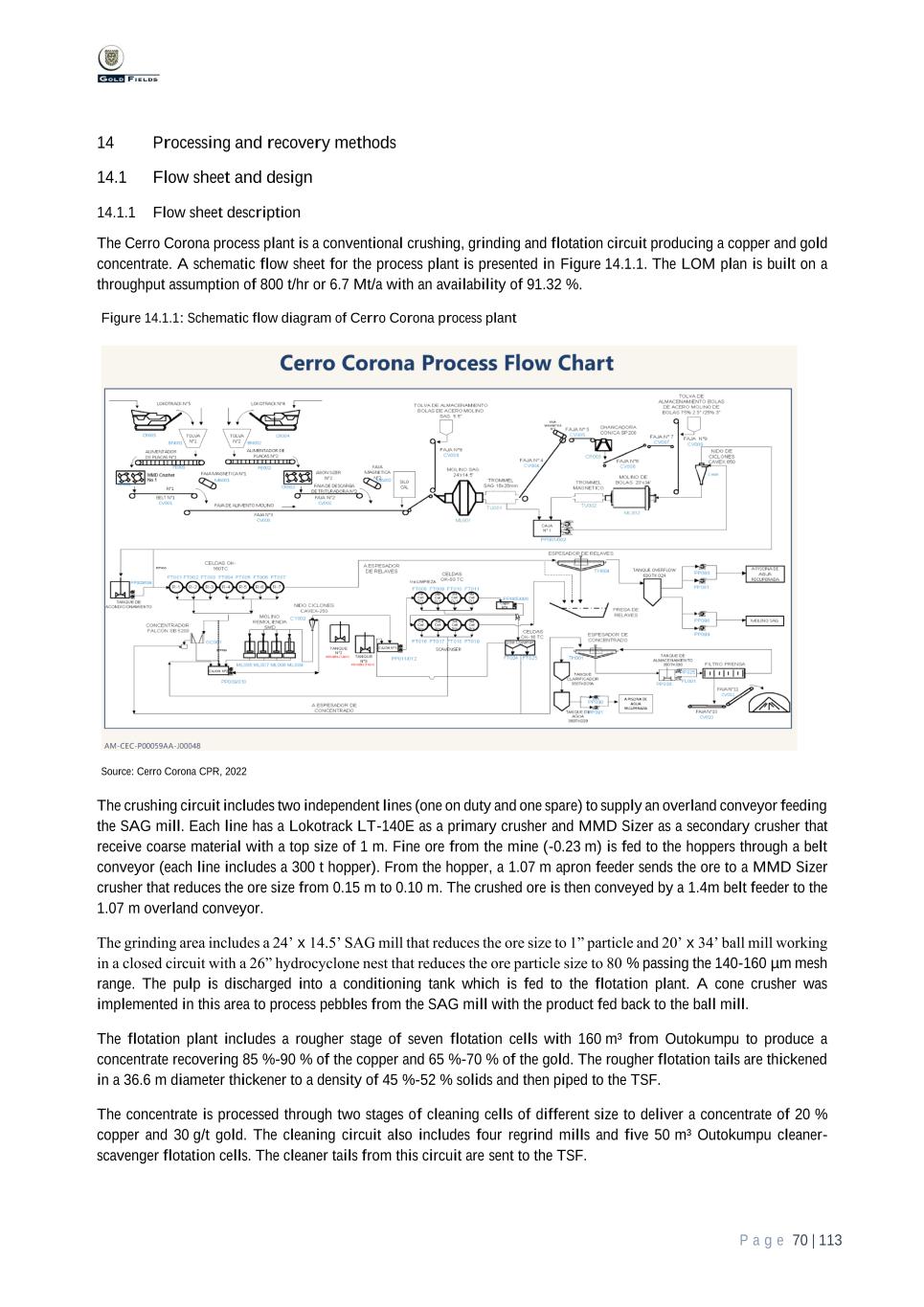
P a g e 70 | 113 14 Processing and recovery methods 14.1 Flow sheet and design 14.1.1 Flow sheet description The Cerro Corona process plant is a conventional crushing, grinding and flotation circuit producing a copper and gold concentrate. A schematic flow sheet for the process plant is presented in Figure 14.1.1. The LOM plan is built on a throughput assumption of 800 t/hr or 6.7 Mt/a with an availability of 91.32 %. Figure 14.1.1: Schematic flow diagram of Cerro Corona process plant Source: Cerro Corona CPR, 2022 The crushing circuit includes two independent lines (one on duty and one spare) to supply an overland conveyor feeding the SAG mill. Each line has a Lokotrack LT-140E as a primary crusher and MMD Sizer as a secondary crusher that receive coarse material with a top size of 1 m. Fine ore from the mine (-0.23 m) is fed to the hoppers through a belt conveyor (each line includes a 300 t hopper). From the hopper, a 1.07 m apron feeder sends the ore to a MMD Sizer crusher that reduces the ore size from 0.15 m to 0.10 m. The crushed ore is then conveyed by a 1.4m belt feeder to the 1.07 m overland conveyor. The grinding area includes a 24’ x 14.5’ SAG mill that reduces the ore size to 1” particle and 20’ x 34’ ball mill working in a closed circuit with a 26” hydrocyclone nest that reduces the ore particle size to 80 % passing the 140-160 µm mesh range. The pulp is discharged into a conditioning tank which is fed to the flotation plant. A cone crusher was implemented in this area to process pebbles from the SAG mill with the product fed back to the ball mill. The flotation plant includes a rougher stage of seven flotation cells with 160 m³ from Outokumpu to produce a concentrate recovering 85 %-90 % of the copper and 65 %-70 % of the gold. The rougher flotation tails are thickened in a 36.6 m diameter thickener to a density of 45 %-52 % solids and then piped to the TSF. The concentrate is processed through two stages of cleaning cells of different size to deliver a concentrate of 20 % copper and 30 g/t gold. The cleaning circuit also includes four regrind mills and five 50 m³ Outokumpu cleaner- scavenger flotation cells. The cleaner tails from this circuit are sent to the TSF.
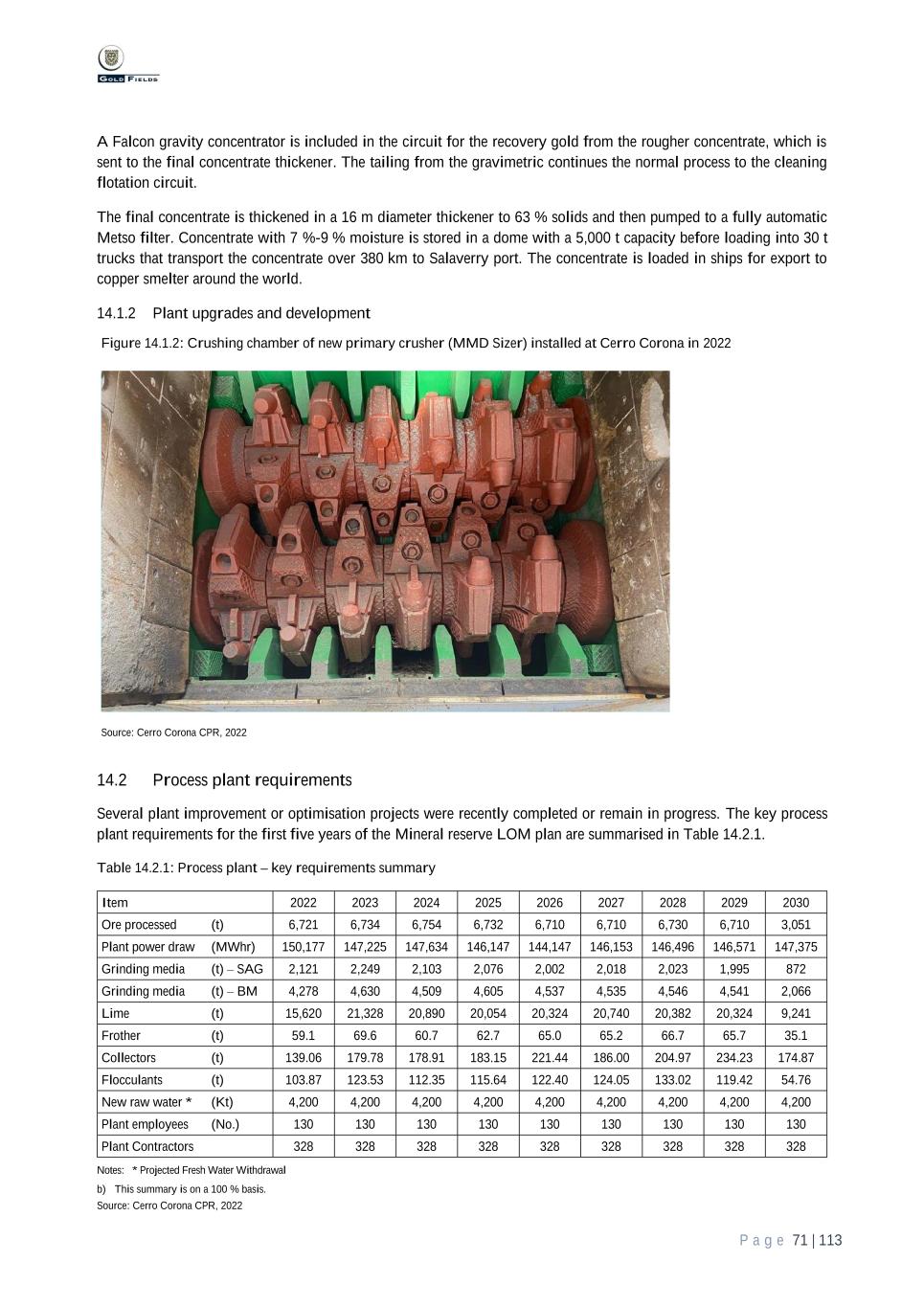
P a g e 71 | 113 A Falcon gravity concentrator is included in the circuit for the recovery gold from the rougher concentrate, which is sent to the final concentrate thickener. The tailing from the gravimetric continues the normal process to the cleaning flotation circuit. The final concentrate is thickened in a 16 m diameter thickener to 63 % solids and then pumped to a fully automatic Metso filter. Concentrate with 7 %-9 % moisture is stored in a dome with a 5,000 t capacity before loading into 30 t trucks that transport the concentrate over 380 km to Salaverry port. The concentrate is loaded in ships for export to copper smelter around the world. 14.1.2 Plant upgrades and development Figure 14.1.2: Crushing chamber of new primary crusher (MMD Sizer) installed at Cerro Corona in 2022 Source: Cerro Corona CPR, 2022 14.2 Process plant requirements Several plant improvement or optimisation projects were recently completed or remain in progress. The key process plant requirements for the first five years of the Mineral reserve LOM plan are summarised in Table 14.2.1. Table 14.2.1: Process plant – key requirements summary Item 2022 2023 2024 2025 2026 2027 2028 2029 2030 Ore processed (t) 6,721 6,734 6,754 6,732 6,710 6,710 6,730 6,710 3,051 Plant power draw (MWhr) 150,177 147,225 147,634 146,147 144,147 146,153 146,496 146,571 147,375 Grinding media (t) – SAG 2,121 2,249 2,103 2,076 2,002 2,018 2,023 1,995 872 Grinding media (t) – BM 4,278 4,630 4,509 4,605 4,537 4,535 4,546 4,541 2,066 Lime (t) 15,620 21,328 20,890 20,054 20,324 20,740 20,382 20,324 9,241 Frother (t) 59.1 69.6 60.7 62.7 65.0 65.2 66.7 65.7 35.1 Collectors (t) 139.06 179.78 178.91 183.15 221.44 186.00 204.97 234.23 174.87 Flocculants (t) 103.87 123.53 112.35 115.64 122.40 124.05 133.02 119.42 54.76 New raw water * (Kt) 4,200 4,200 4,200 4,200 4,200 4,200 4,200 4,200 4,200 Plant employees (No.) 130 130 130 130 130 130 130 130 130 Plant Contractors 328 328 328 328 328 328 328 328 328 Notes: * Projected Fresh Water Withdrawal b) This summary is on a 100 % basis. Source: Cerro Corona CPR, 2022

P a g e 72 | 113 Gravity circuit reconfiguration The existing Falcon gravity concentrator was recently reconfigured for incorporation into the concentrate regrind circuit recirculating load instead of being fed rougher concentrate. This provides an opportunity for multiple passes of coarse gold to be presented to the concentrator due to recirculation of gold through the regrind circuit hydrocyclones, with the aim to increase gravity recovery. Replacement of Abon Sizers with MMD Sizers Replacement of both Abon Sizers with upgraded MMD Sizers with higher hardness rock crushing capacity was completed during 2021 and 2022. SAG mill grates configuration change During 2019 and 2020, Cerro Corona engaged Fluor to review the set-up and performance of the comminution circuit. One of the recommendations made to increase capacity of the circuit was to increase the aperture and open area of the SAG mill discharge grates. Following trials undertaken in 2020 and 2021, all the discharge grates were replaced with larger apertures of 45-50 x 34 mm, targeting a throughput increase of approximately 4 t/hr. 14.3 Processing risks 14.3.1 Major equipment failure Industrial mineral processing plants consist of a series of dedicated unit processes, e.g., crushing, grinding, flotation, thickening and filtration. There is inherent risk associated with catastrophic failure of one (or more) of the key equipment items associated with these unit processes, whereby such failure could lead to a significant period of plant downtime until repairs are completed, resulting in the inability of the processing plan to be achieved and/or higher operational costs incurred than anticipated. Catastrophic failures could be associated with the structural, mechanical, or electrical components of the key processing equipment items. Key equipment items could include the crushers, grinding mills, or flotation tanks. Risk minimisation activities to reduce the likelihood of such occurrences adopted by Cerro Corona include: • Dedicated on-site maintenance department which undertakes condition monitoring activities, preventative maintenance and repairs. • Critical spares (e.g., spare mill motors, bearings and gearboxes). • Contingency operational plans (e.g., engage a contract/mobile crushing plant, flotation cell by-passing). • Fire suppression systems. • Insurances. Decisions associated with asset management, critical spares, insurances, etc. are outside the responsibility and accountability of the Qualified person, and some inherent risk and uncertainty associated with catastrophic failure of processing equipment remains. 14.3.2 Plant operational management The processing facilities are managed and operated by dedicated teams of personnel who are required to make many operational and maintenance decisions every day. These decisions can directly impact the performance of the plant while processing the future ore reserves. For example, a decision to process ores at a higher throughput could result in a coarser grind size from the grinding circuit, resulting in a lowering of the plant recoveries.
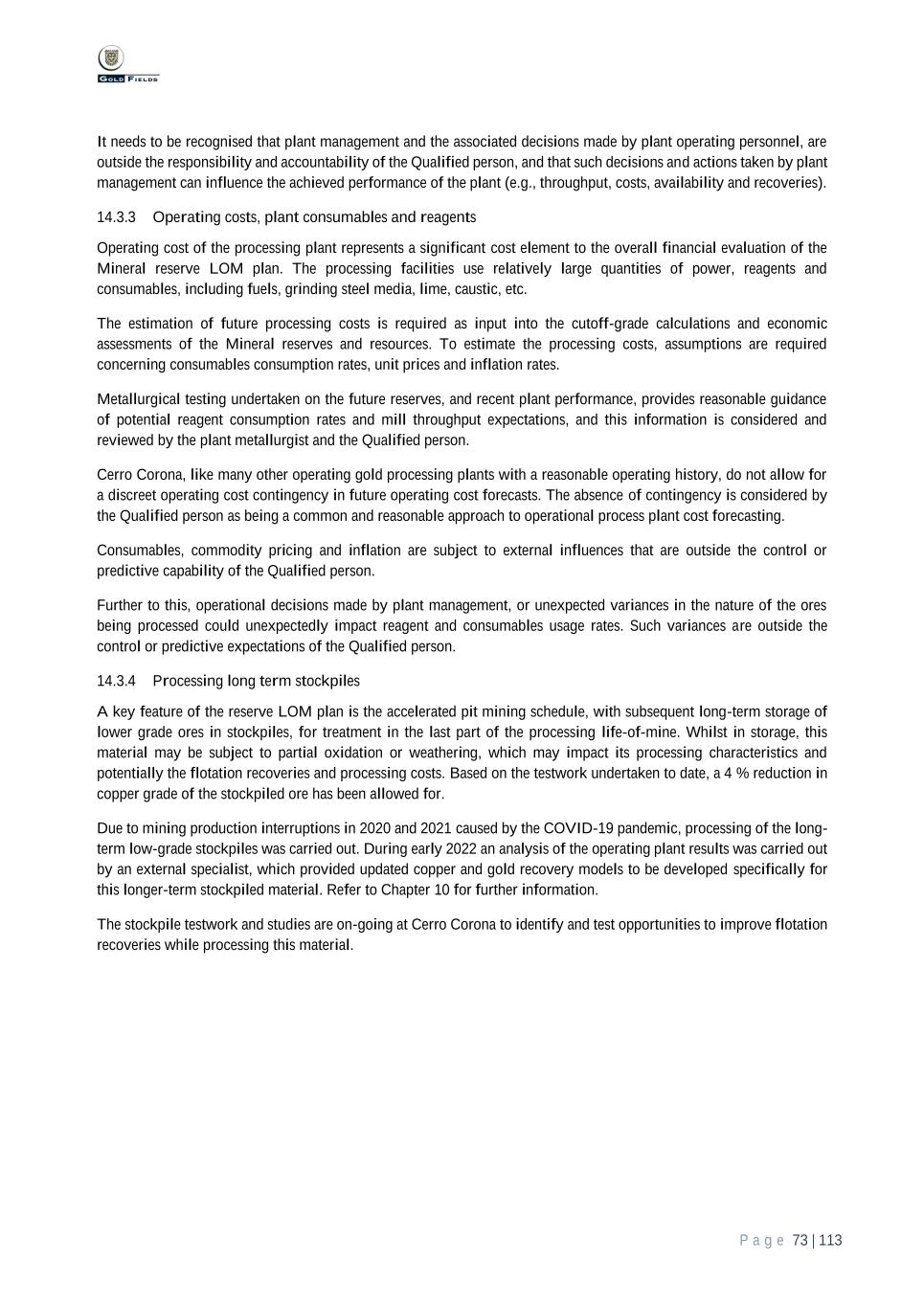
P a g e 73 | 113 It needs to be recognised that plant management and the associated decisions made by plant operating personnel, are outside the responsibility and accountability of the Qualified person, and that such decisions and actions taken by plant management can influence the achieved performance of the plant (e.g., throughput, costs, availability and recoveries). 14.3.3 Operating costs, plant consumables and reagents Operating cost of the processing plant represents a significant cost element to the overall financial evaluation of the Mineral reserve LOM plan. The processing facilities use relatively large quantities of power, reagents and consumables, including fuels, grinding steel media, lime, caustic, etc. The estimation of future processing costs is required as input into the cutoff-grade calculations and economic assessments of the Mineral reserves and resources. To estimate the processing costs, assumptions are required concerning consumables consumption rates, unit prices and inflation rates. Metallurgical testing undertaken on the future reserves, and recent plant performance, provides reasonable guidance of potential reagent consumption rates and mill throughput expectations, and this information is considered and reviewed by the plant metallurgist and the Qualified person. Cerro Corona, like many other operating gold processing plants with a reasonable operating history, do not allow for a discreet operating cost contingency in future operating cost forecasts. The absence of contingency is considered by the Qualified person as being a common and reasonable approach to operational process plant cost forecasting. Consumables, commodity pricing and inflation are subject to external influences that are outside the control or predictive capability of the Qualified person. Further to this, operational decisions made by plant management, or unexpected variances in the nature of the ores being processed could unexpectedly impact reagent and consumables usage rates. Such variances are outside the control or predictive expectations of the Qualified person. 14.3.4 Processing long term stockpiles A key feature of the reserve LOM plan is the accelerated pit mining schedule, with subsequent long-term storage of lower grade ores in stockpiles, for treatment in the last part of the processing life-of-mine. Whilst in storage, this material may be subject to partial oxidation or weathering, which may impact its processing characteristics and potentially the flotation recoveries and processing costs. Based on the testwork undertaken to date, a 4 % reduction in copper grade of the stockpiled ore has been allowed for. Due to mining production interruptions in 2020 and 2021 caused by the COVID-19 pandemic, processing of the long- term low-grade stockpiles was carried out. During early 2022 an analysis of the operating plant results was carried out by an external specialist, which provided updated copper and gold recovery models to be developed specifically for this longer-term stockpiled material. Refer to Chapter 10 for further information. The stockpile testwork and studies are on-going at Cerro Corona to identify and test opportunities to improve flotation recoveries while processing this material.
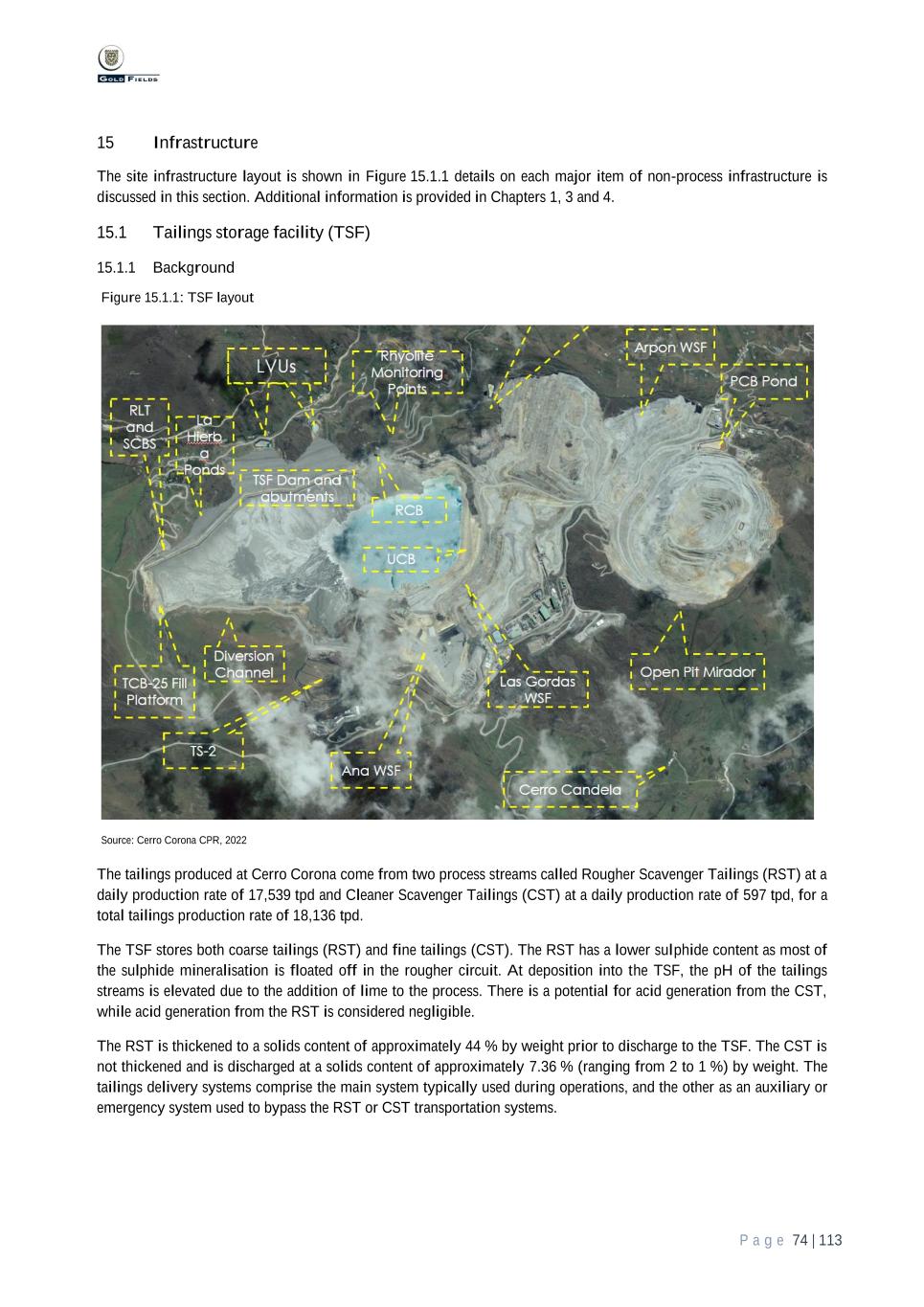
P a g e 74 | 113 15 Infrastructure The site infrastructure layout is shown in Figure 15.1.1 details on each major item of non-process infrastructure is discussed in this section. Additional information is provided in Chapters 1, 3 and 4. 15.1 Tailings storage facility (TSF) 15.1.1 Background Figure 15.1.1: TSF layout Source: Cerro Corona CPR, 2022 The tailings produced at Cerro Corona come from two process streams called Rougher Scavenger Tailings (RST) at a daily production rate of 17,539 tpd and Cleaner Scavenger Tailings (CST) at a daily production rate of 597 tpd, for a total tailings production rate of 18,136 tpd. The TSF stores both coarse tailings (RST) and fine tailings (CST). The RST has a lower sulphide content as most of the sulphide mineralisation is floated off in the rougher circuit. At deposition into the TSF, the pH of the tailings streams is elevated due to the addition of lime to the process. There is a potential for acid generation from the CST, while acid generation from the RST is considered negligible. The RST is thickened to a solids content of approximately 44 % by weight prior to discharge to the TSF. The CST is not thickened and is discharged at a solids content of approximately 7.36 % (ranging from 2 to 1 %) by weight. The tailings delivery systems comprise the main system typically used during operations, and the other as an auxiliary or emergency system used to bypass the RST or CST transportation systems.

P a g e 75 | 113 The TSF is located northwest of the process plant site (Figure 4.4.1) and serves as a source for water which is reclaimed from the deposited tailings and precipitation. The TSF includes a dam that impounds deposited tailing, tailing delivery and water reclaim systems and water diversion and seepage mitigation structures. In addition, diversion structures have been constructed along the southeast side of the TSF to divert surface water flows around the TSF (Figure 15.1.2). Figure 15.1.2: TSF overview looking west Source: Cerro Corona CPR, 2022 The TSF was designed by MWH Peru S.A., now part of Stantec International LLC (Stantec). Stantec (Vancouver) is the Engineer of Record (EoR). The TSF includes a rockfill dam with a low-permeability core and filter and transition zones that extend across the Las Aguilas, Las Gordas and La Hierba valleys to impound the deposited tailing and water within the TSF. The Rhyolite Ridge forms the eastern abutment of the Las Gordas portion of the TSF dam. The TSF design includes the following seepage containment blankets and Low Volume Underflow (LVU) facilities designed to mitigate seepage from the facility: • Upstream Containment Blanket (UCB) – a compacted clay barrier placed along the upstream face of the adjacent. • Las Gordas WSF to reduce seepage flows from the TSF to the Las Gordas WSF. • Rhyolite Containment Blanket (RCB) – a compacted clay barrier and drainage system placed between the TSF and the Rhyolite Ridge abutment of the TSF to reduce seepage flows through the Rhyolite Ridge. • LVU facilities – two seepage collection structures located downstream of the TSF near the base of the Las Gordas and Las Aguilas valleys designed to collect seepage flows from the TSF. Each facility includes a grout curtain to prevent subsurface bypass of the facilities, a pond to collect seepage water, and a pumping system to allow for pump back of captured seepage flows to the TSF. The optimised TSF dam design was developed to store a minimum of 113 Mt of tailings up to elevation 3,801 m. An ultimate TSF dam crest elevation of 3,803 m is required to store this quantity while complying with the adopted design criteria.

P a g e 76 | 113 The TSF design followed relevant international and local regulatory requirements, including those of the Peruvian Ministry of Energy and Mines (MEM), the Mining Association of Canada (MAC 2019), the Canadian Dam Association (CDA 2014) and the International Commission on Large Dams (ICOLD). Since 2018, the TSF has been operated per the ANCOLD Guidelines. As a result, the TSF has an Extreme Consequence Rating per CDA and ANCOLD. The remaining low permeability (clay) material requirements for the TSF wall construction and RCB to RL 3,803 mRL will continue to be sourced from altered argillic waste rock mined from the open pit. However, clay sources are limited for Zone 1 (clay core, Figure 15.1.3) during the final years of the LOM plan. Therefore, zone 1 material has been sourced from the oxide ore stockpile. Figure 15.1.3 Typical TSF embankment cross-section Source: Cerro Corona CPR, 2022 The RCB is located along the north-eastern edge of the TSF, on the upstream face of the rhyolite ridge. A portion of the TSF dam will be built on top of the RCB in some areas to achieve containment within the TSF reservoir up to an elevation of 3,803 m. The RCB includes a low permeability upstream layer (Zone 7, intermediate permeability material). The perpendicular thickness of the low-permeability blanket decreases from approximately 15 m near the base of the RCB to nearly 7 m at the upper crest of the RCB to keep the seepage gradient below 10. In addition, a compacted rockfill (Zone 2B) lies above a low-permeability blanket to provide continuity between the TSF dam and the RCB. The width of the compacted rockfill decreases from 20 m to 10 m over the length of the RCB. The Cerro Corona TSF is a priority facility and needs to conform to the Global Industry Standard on Tailings Management (GISTM) by August 2023. A gap analysis has been completed, and the GISTM conformance program is underway in collaboration with the EoR. As of the end of December 2022, approximately 92.2 Mt of tailings has been deposited, yielding a remaining storage capacity of approximately 20.8 Mt. The operation of an in-pit TSF following the completion of mining will provide an additional 31.2 Mt of tailings storage up to an elevation of 3,690 masl from 2026 to 2030. The commissioning of the in-pit TSF will be preceded by accelerated mining and stockpiling of ore until 2025. Post-2025, the open pit will be filled with tailings generated through processing the stockpiled ore. The in-pit facility was designed to achieve hydraulic containment during the operational and closure phases. The in-pit TSF tailings surface and reclaim pond elevation will be at 3,690 m. Therefore, the maximum level of hydraulic containment is 3,690 masl.
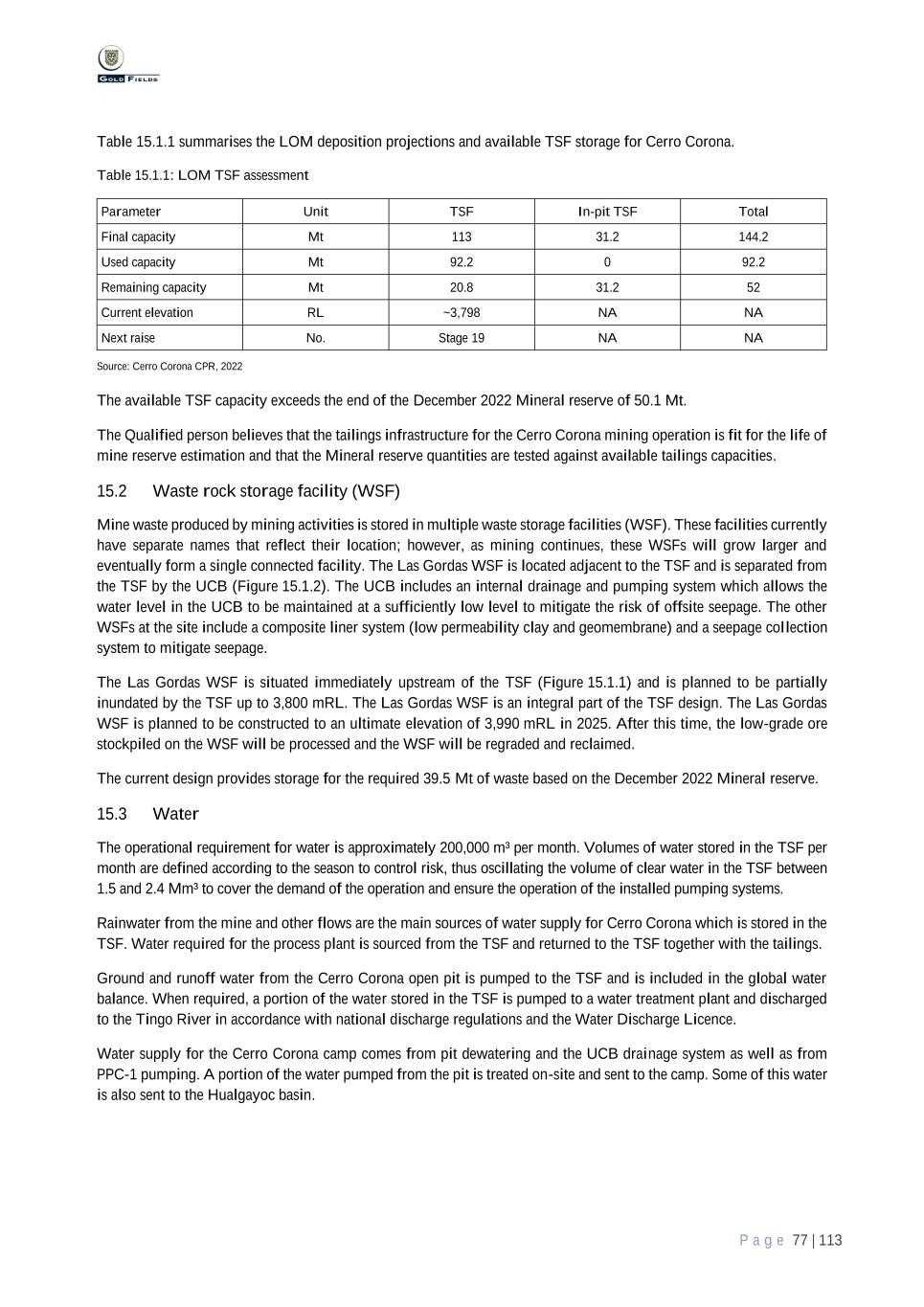
P a g e 77 | 113 Table 15.1.1 summarises the LOM deposition projections and available TSF storage for Cerro Corona. Table 15.1.1: LOM TSF assessment Parameter Unit TSF In-pit TSF Total Final capacity Mt 113 31.2 144.2 Used capacity Mt 92.2 0 92.2 Remaining capacity Mt 20.8 31.2 52 Current elevation RL ~3,798 NA NA Next raise No. Stage 19 NA NA Source: Cerro Corona CPR, 2022 The available TSF capacity exceeds the end of the December 2022 Mineral reserve of 50.1 Mt. The Qualified person believes that the tailings infrastructure for the Cerro Corona mining operation is fit for the life of mine reserve estimation and that the Mineral reserve quantities are tested against available tailings capacities. 15.2 Waste rock storage facility (WSF) Mine waste produced by mining activities is stored in multiple waste storage facilities (WSF). These facilities currently have separate names that reflect their location; however, as mining continues, these WSFs will grow larger and eventually form a single connected facility. The Las Gordas WSF is located adjacent to the TSF and is separated from the TSF by the UCB (Figure 15.1.2). The UCB includes an internal drainage and pumping system which allows the water level in the UCB to be maintained at a sufficiently low level to mitigate the risk of offsite seepage. The other WSFs at the site include a composite liner system (low permeability clay and geomembrane) and a seepage collection system to mitigate seepage. The Las Gordas WSF is situated immediately upstream of the TSF (Figure 15.1.1) and is planned to be partially inundated by the TSF up to 3,800 mRL. The Las Gordas WSF is an integral part of the TSF design. The Las Gordas WSF is planned to be constructed to an ultimate elevation of 3,990 mRL in 2025. After this time, the low-grade ore stockpiled on the WSF will be processed and the WSF will be regraded and reclaimed. The current design provides storage for the required 39.5 Mt of waste based on the December 2022 Mineral reserve. 15.3 Water The operational requirement for water is approximately 200,000 m³ per month. Volumes of water stored in the TSF per month are defined according to the season to control risk, thus oscillating the volume of clear water in the TSF between 1.5 and 2.4 Mm³ to cover the demand of the operation and ensure the operation of the installed pumping systems. Rainwater from the mine and other flows are the main sources of water supply for Cerro Corona which is stored in the TSF. Water required for the process plant is sourced from the TSF and returned to the TSF together with the tailings. Ground and runoff water from the Cerro Corona open pit is pumped to the TSF and is included in the global water balance. When required, a portion of the water stored in the TSF is pumped to a water treatment plant and discharged to the Tingo River in accordance with national discharge regulations and the Water Discharge Licence. Water supply for the Cerro Corona camp comes from pit dewatering and the UCB drainage system as well as from PPC-1 pumping. A portion of the water pumped from the pit is treated on-site and sent to the camp. Some of this water is also sent to the Hualgayoc basin.
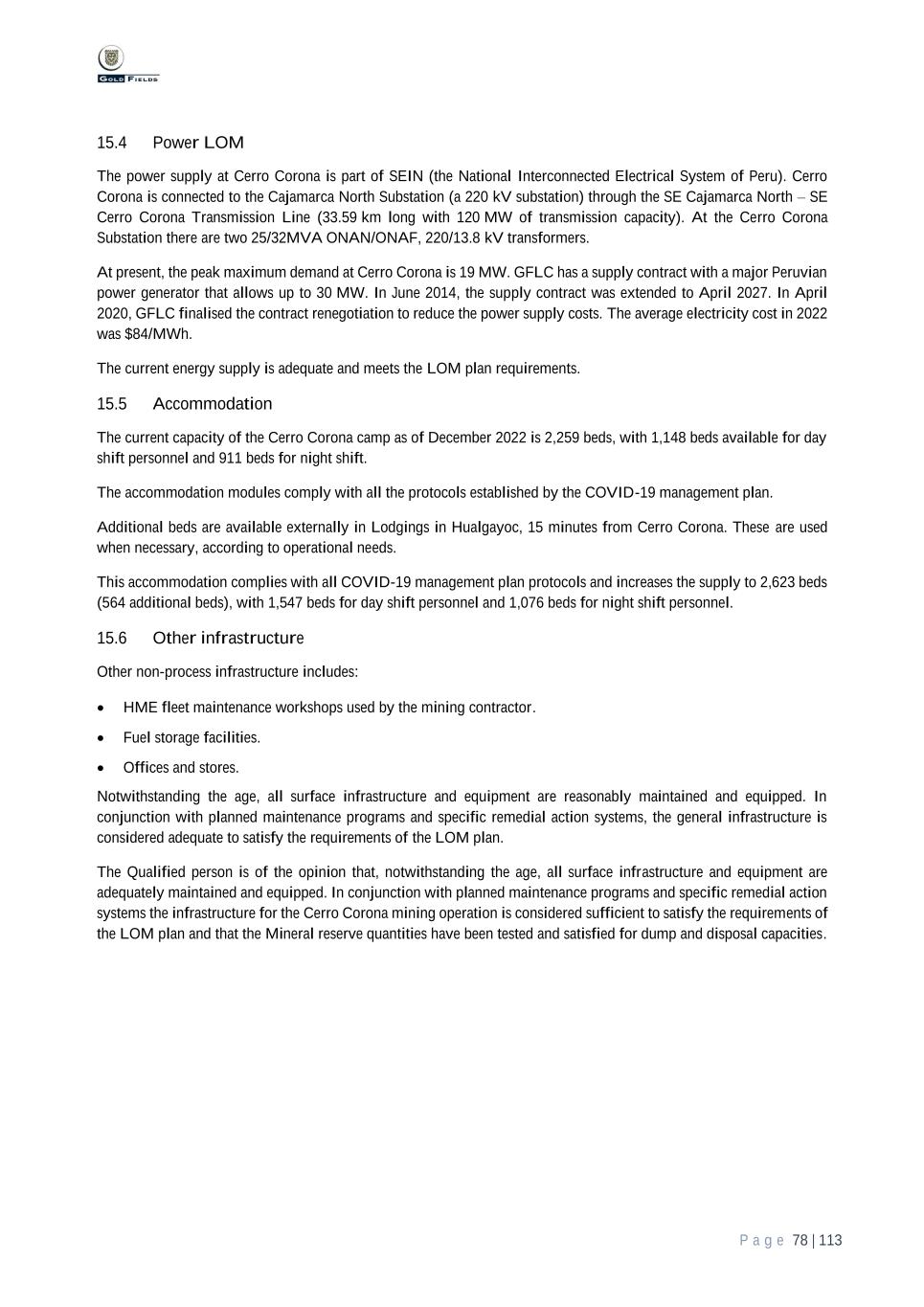
P a g e 78 | 113 15.4 Power LOM The power supply at Cerro Corona is part of SEIN (the National Interconnected Electrical System of Peru). Cerro Corona is connected to the Cajamarca North Substation (a 220 kV substation) through the SE Cajamarca North – SE Cerro Corona Transmission Line (33.59 km long with 120 MW of transmission capacity). At the Cerro Corona Substation there are two 25/32MVA ONAN/ONAF, 220/13.8 kV transformers. At present, the peak maximum demand at Cerro Corona is 19 MW. GFLC has a supply contract with a major Peruvian power generator that allows up to 30 MW. In June 2014, the supply contract was extended to April 2027. In April 2020, GFLC finalised the contract renegotiation to reduce the power supply costs. The average electricity cost in 2022 was $84/MWh. The current energy supply is adequate and meets the LOM plan requirements. 15.5 Accommodation The current capacity of the Cerro Corona camp as of December 2022 is 2,259 beds, with 1,148 beds available for day shift personnel and 911 beds for night shift. The accommodation modules comply with all the protocols established by the COVID-19 management plan. Additional beds are available externally in Lodgings in Hualgayoc, 15 minutes from Cerro Corona. These are used when necessary, according to operational needs. This accommodation complies with all COVID-19 management plan protocols and increases the supply to 2,623 beds (564 additional beds), with 1,547 beds for day shift personnel and 1,076 beds for night shift personnel. 15.6 Other infrastructure Other non-process infrastructure includes: • HME fleet maintenance workshops used by the mining contractor. • Fuel storage facilities. • Offices and stores. Notwithstanding the age, all surface infrastructure and equipment are reasonably maintained and equipped. In conjunction with planned maintenance programs and specific remedial action systems, the general infrastructure is considered adequate to satisfy the requirements of the LOM plan. The Qualified person is of the opinion that, notwithstanding the age, all surface infrastructure and equipment are adequately maintained and equipped. In conjunction with planned maintenance programs and specific remedial action systems the infrastructure for the Cerro Corona mining operation is considered sufficient to satisfy the requirements of the LOM plan and that the Mineral reserve quantities have been tested and satisfied for dump and disposal capacities.

P a g e 79 | 113 16 Market studies 16.1 Preliminary market study A review of metal prices for planning purposes is undertaken annually to monitor any significant changes in price trends or exchange rates that would warrant re-calibrating the price deck before the Strategic Planning process transitions into the Business Planning cycle. This review of the metal price deck has taken account of the prevailing economic, commodity price and exchange rate (Fx) trends, together with market consensus forecasts, in addition to consideration of the Gold Fields’ strategy and expectations for the operations. Our strategy is to (1) mitigate annual volatility by holding planning metal prices as long as warranted to support stability in mine planning, notably regarding the underground MSO and open pit shell selections; (2) maintain appropriate margins on spot and long-term price forecasts to support the Group’s BSC metrics; (3) protect against accelerating mining sector inflation and, (4) to confirm a separate gold price to be used specifically for the Operational Pan (budget) revenue streams and cashflows in Q3 each year. The outcome of the pricing analysis was to use a gold price of $1,400/oz for Mineral reserves and $1,600/oz for gold Mineral resources for the disclosure of estimates. Table 16.1.1: Reserve and Resource metal prices Metal Unit December 2022 Metal price Deck Mineral reserve 31 Dec 2022 Mineral resource 31 Dec 2022 Gold $/oz 1,400 1,600 Copper $/lb 3.40 3.60 Source: Cerro Corona CPR, 2022 The above price deck comparison to market long-term forecasts assessed at the time of analysis is consistent with the Registrants approach to retaining good discipline in support of the Company strategy; this approach ensures Gold Fields’ Mineral resources and reserves are not too volatile year-on-year and that the company is protected against possible downside scenarios if the gold price falls up to ~25 % in any specific year. Ensuring sufficient flying height to maintain our margins at prices that could be incrementally lower than the spot price ranges seen in 2022 is also important. Equally, with annual mining sector inflation estimated at $30-40/oz, we need to ensure we mitigate this escalation risk in the life-of-mine plans and Mineral reserve estimates. Sensitivity analysis on gold price for project financial evaluation is done to provide flexibility/range analysis for all regional studies and site growth opportunities and investment purposes. The Mineral resource gold price premium to the Mineral reserve price is circa 14 % and the differential is in general alignment to our peer group and industry standard practice. The Mineral resource price premium is to provide information on each operation’s potential at higher gold prices and to indicate possible future site infrastructure and mining footprint requirements. Gold Fields may periodically use commodity or derivative instruments to protect against low gold prices with respect to its production. Variations in gold price, currency fluctuations and world economics can potentially impact on the revenue received. No derivative instruments are in place for Cerro Corona at the date of this report. Most of the gold production is used for jewellery and for investment purposes, in the latter case because the market views it as a store of value against inflation. In addition, certain physical properties of gold, including its malleability, ductility, electric conductivity, resistance to corrosion and reflectivity, make it the metal of choice in several industrial and electronic applications.
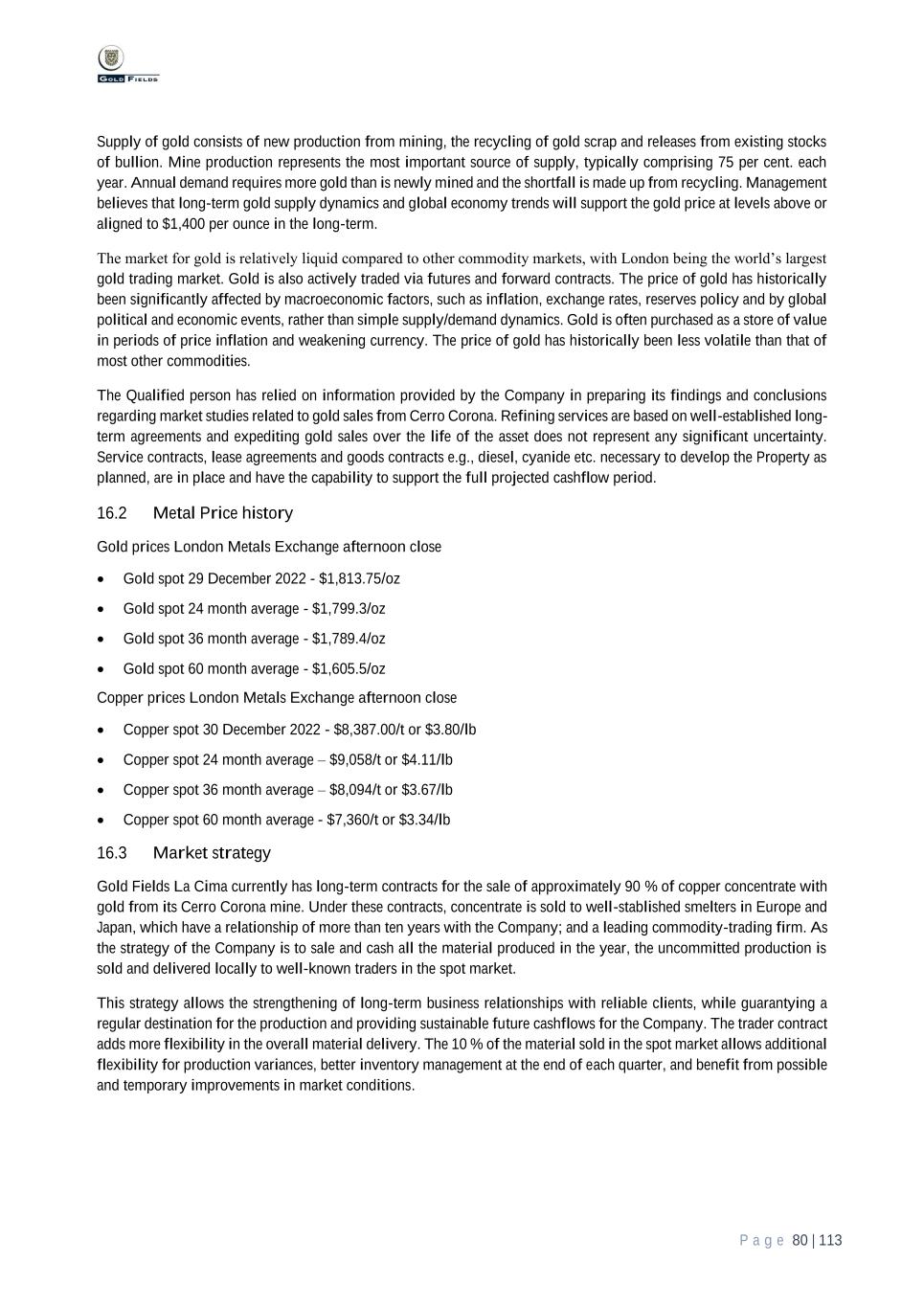
P a g e 80 | 113 Supply of gold consists of new production from mining, the recycling of gold scrap and releases from existing stocks of bullion. Mine production represents the most important source of supply, typically comprising 75 per cent. each year. Annual demand requires more gold than is newly mined and the shortfall is made up from recycling. Management believes that long-term gold supply dynamics and global economy trends will support the gold price at levels above or aligned to $1,400 per ounce in the long-term. The market for gold is relatively liquid compared to other commodity markets, with London being the world’s largest gold trading market. Gold is also actively traded via futures and forward contracts. The price of gold has historically been significantly affected by macroeconomic factors, such as inflation, exchange rates, reserves policy and by global political and economic events, rather than simple supply/demand dynamics. Gold is often purchased as a store of value in periods of price inflation and weakening currency. The price of gold has historically been less volatile than that of most other commodities. The Qualified person has relied on information provided by the Company in preparing its findings and conclusions regarding market studies related to gold sales from Cerro Corona. Refining services are based on well-established long- term agreements and expediting gold sales over the life of the asset does not represent any significant uncertainty. Service contracts, lease agreements and goods contracts e.g., diesel, cyanide etc. necessary to develop the Property as planned, are in place and have the capability to support the full projected cashflow period. 16.2 Metal Price history Gold prices London Metals Exchange afternoon close • Gold spot 29 December 2022 - $1,813.75/oz • Gold spot 24 month average - $1,799.3/oz • Gold spot 36 month average - $1,789.4/oz • Gold spot 60 month average - $1,605.5/oz Copper prices London Metals Exchange afternoon close • Copper spot 30 December 2022 - $8,387.00/t or $3.80/lb • Copper spot 24 month average – $9,058/t or $4.11/lb • Copper spot 36 month average – $8,094/t or $3.67/lb • Copper spot 60 month average - $7,360/t or $3.34/lb 16.3 Market strategy Gold Fields La Cima currently has long-term contracts for the sale of approximately 90 % of copper concentrate with gold from its Cerro Corona mine. Under these contracts, concentrate is sold to well-stablished smelters in Europe and Japan, which have a relationship of more than ten years with the Company; and a leading commodity-trading firm. As the strategy of the Company is to sale and cash all the material produced in the year, the uncommitted production is sold and delivered locally to well-known traders in the spot market. This strategy allows the strengthening of long-term business relationships with reliable clients, while guarantying a regular destination for the production and providing sustainable future cashflows for the Company. The trader contract adds more flexibility in the overall material delivery. The 10 % of the material sold in the spot market allows additional flexibility for production variances, better inventory management at the end of each quarter, and benefit from possible and temporary improvements in market conditions.
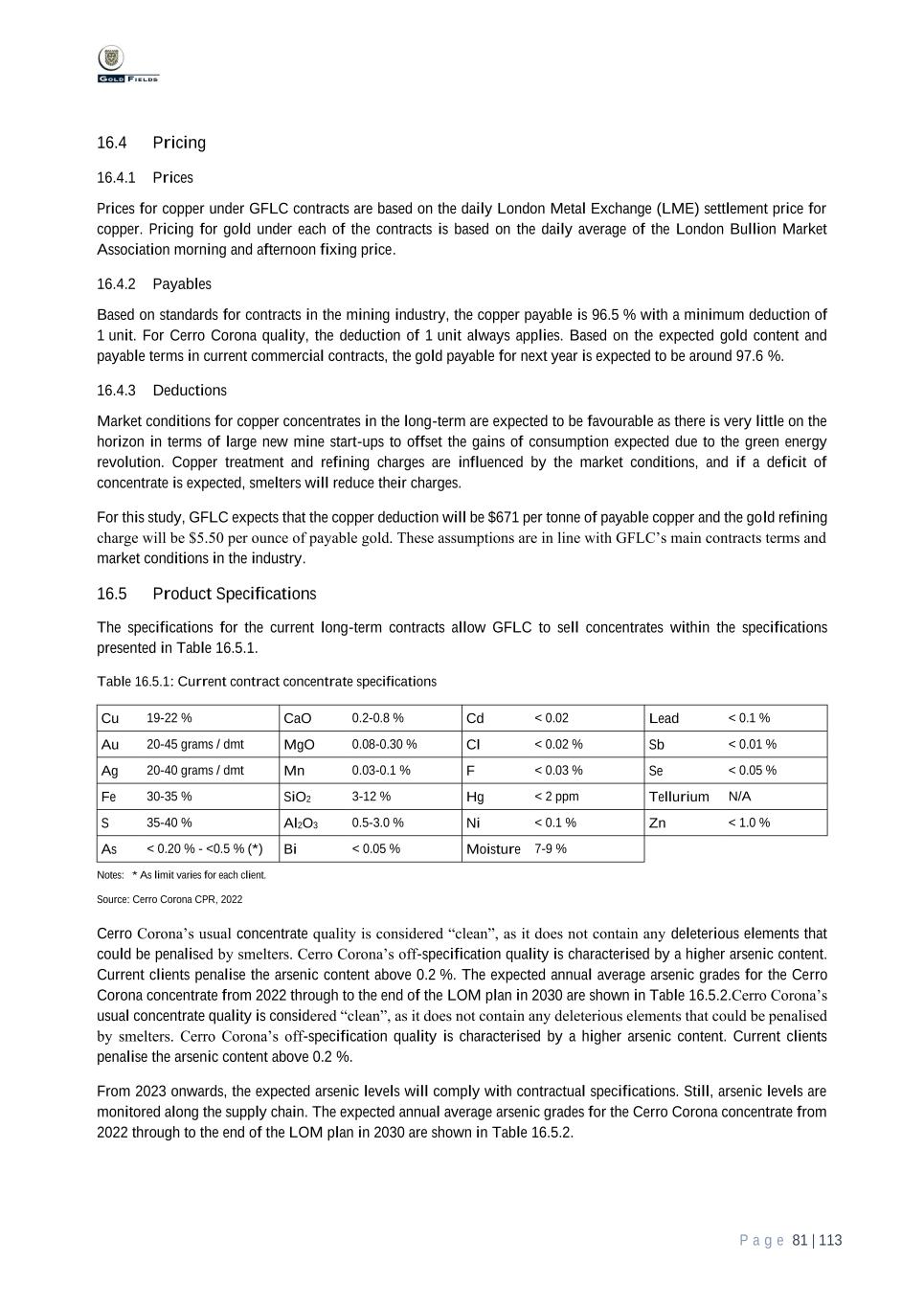
P a g e 81 | 113 16.4 Pricing 16.4.1 Prices Prices for copper under GFLC contracts are based on the daily London Metal Exchange (LME) settlement price for copper. Pricing for gold under each of the contracts is based on the daily average of the London Bullion Market Association morning and afternoon fixing price. 16.4.2 Payables Based on standards for contracts in the mining industry, the copper payable is 96.5 % with a minimum deduction of 1 unit. For Cerro Corona quality, the deduction of 1 unit always applies. Based on the expected gold content and payable terms in current commercial contracts, the gold payable for next year is expected to be around 97.6 %. 16.4.3 Deductions Market conditions for copper concentrates in the long-term are expected to be favourable as there is very little on the horizon in terms of large new mine start-ups to offset the gains of consumption expected due to the green energy revolution. Copper treatment and refining charges are influenced by the market conditions, and if a deficit of concentrate is expected, smelters will reduce their charges. For this study, GFLC expects that the copper deduction will be $671 per tonne of payable copper and the gold refining charge will be $5.50 per ounce of payable gold. These assumptions are in line with GFLC’s main contracts terms and market conditions in the industry. 16.5 Product Specifications The specifications for the current long-term contracts allow GFLC to sell concentrates within the specifications presented in Table 16.5.1. Table 16.5.1: Current contract concentrate specifications Cu 19-22 % CaO 0.2-0.8 % Cd < 0.02 Lead < 0.1 % Au 20-45 grams / dmt MgO 0.08-0.30 % Cl < 0.02 % Sb < 0.01 % Ag 20-40 grams / dmt Mn 0.03-0.1 % F < 0.03 % Se < 0.05 % Fe 30-35 % SiO2 3-12 % Hg < 2 ppm Tellurium N/A S 35-40 % Al2O3 0.5-3.0 % Ni < 0.1 % Zn < 1.0 % As < 0.20 % - <0.5 % (*) Bi < 0.05 % Moisture 7-9 % Notes: * As limit varies for each client. Source: Cerro Corona CPR, 2022 Cerro Corona’s usual concentrate quality is considered “clean”, as it does not contain any deleterious elements that could be penalised by smelters. Cerro Corona’s off-specification quality is characterised by a higher arsenic content. Current clients penalise the arsenic content above 0.2 %. The expected annual average arsenic grades for the Cerro Corona concentrate from 2022 through to the end of the LOM plan in 2030 are shown in Table 16.5.2.Cerro Corona’s usual concentrate quality is considered “clean”, as it does not contain any deleterious elements that could be penalised by smelters. Cerro Corona’s off-specification quality is characterised by a higher arsenic content. Current clients penalise the arsenic content above 0.2 %. From 2023 onwards, the expected arsenic levels will comply with contractual specifications. Still, arsenic levels are monitored along the supply chain. The expected annual average arsenic grades for the Cerro Corona concentrate from 2022 through to the end of the LOM plan in 2030 are shown in Table 16.5.2.

P a g e 82 | 113 Table 16.5.2: Average Cerro Corona concentrate arsenic grades 2023 2024 2025 2026 2027 2028 2029 2030 Arsenic ppm 811 1,002 248 707 1,287 1,542 1,560 1,560 Source: Cerro Corona CPR, 2022 The copper grade in concentrate is predicted to be above 21 % for 2023 onwards. Until 2030, Cerro Corona’s copper concentrates will continue to have their quality characterised by a high gold content (Table 16.5.3). Table 16.5.3: Gold concentrate grades 2023 2024 2025 2026 2027 2028 2029 2030 Gold grade (g/t) 30.3 25.3 22.6 21.8 22.3 19.9 23.4 50.1 Source: Cerro Corona CPR, 2022 Because of these characteristics, Cerro Corona’s concentrates will be in demand by copper smelters that recover gold. The expected quality is in line with current contractual specifications. 16.6 Distribution, storage and shipping GFLC transports concentrates from Cerro Corona to the warehouse at Salaverry port using Transporte Rodrigo Carranza’s (TRC) fleet of 30 wmt trucks organised in groups of 7 trucks per convoy. To dispatch an average of 500 wmt per day, three convoys are deployed six days a week. The inland freight is managed in a long-term contract and is adjusted every six months based on the exchange rate, the inflation rate and the cost of fuel. Concentrates are stored in the Salaverry warehouse and loaded through Salaverry port. Salaverry Terminal International S.A (STI) offers storage services, use of the port and loading services by rotainers at a fee of $15.669/TM. The ocean freight for shipments to the Far East and Europe are managed through a contract of affreightment that are negotiated annually. These contracts allow GFLC to comply with its shipping schedule and commitments with clients.

P a g e 83 | 113 17 Environmental studies, permitting and plans, negotiations, or agreements with local individuals or groups Climate change is an integral part of the Mineral reserve generation process and incorporating relevant costs associated with climate change, primarily decarbonisation, mitigation and adaptation to the changing climate, is a key theme for the Company. Integration of these key elements into the Mineral reserve process is being carried out progressively and simultaneously across all of Gold Fields’ sites. 17.1 Permitting Cerro Corona’s Environmental Impact Assessment (EIA) was approved in December 2005 allowing development activities until the approval of the operation permit (“Concesión de beneficio”) by the General Mining Bureau (GMB). The construction permit was approved in February 2006 and the Certificate of Mining issued in December 2007. The process plant and ancillary facilities were constructed, inspected and approved by GMB. Since December 2015, the National Service for Environmental Certification for Sustainable Investment (SENACE) has been authorised to review and approve EIA studies for projects with national or multi-regional influence that may generate significant environmental impacts. SENACE is a public specialised office which falls under the Ministry of the Environment. Several components of the Cerro Corona construction and operations plans were modified from the plans submitted to the EIA and GMB. In this regard, eight modifications to the original EIA and thirteen Supporting Technical Reports (STR) applicable for new components or modifications that do not involve significant environmental impacts were submitted to and approved by the regulators. The eighth modification to the EIA (EIA 8) was approved by the authorities during Q4 2019, allowing an increase in the footprint of the open pit, expansion of the TSF to 3,803 masl and expansion of WSF at Arpon and Ana. An in-pit TSF will be included in the ninth modification of the EIA (EIA 9) for approval before construction commences. Compliance with EIA 9 and other permits derived from it is required before March 2026 when the first tailings material will be deposited into the open pit and is supported by a comprehensive permit application process to the regulator with approval expected by Q2 2023. Gold Fields has obtained the following permits and approvals for its operation in Cerro Corona: • Cerro Corona EIA (2005). • Certificate for archaeological clearance (CIRA) for the whole Cerro Corona surface area. • Approval of modifications to the Cerro Corona EIA, as follows: o Quarries (2007). o Optimisation update (2008). o Storage, transportation and shipping of concentrate at Salaverry port (2010). o New Oxides Processing Plant (2011)1. o Modification of the route for ore concentrate and materials transportation (2012). o Optimisation project and update (2013). o 7th modification that includes optimisation of mining operations (2016). o 8th modification that includes the WSF expansion (Arpon and Ana). • Thirteen STR (last approved in 2022). • Water use and discharge permits. 1 The implementation of the oxides processing plant was dismissed by Gold Fields after this EIA update approval; however, other components and commitments of this EIA update are still applicable to Cerro Corona.
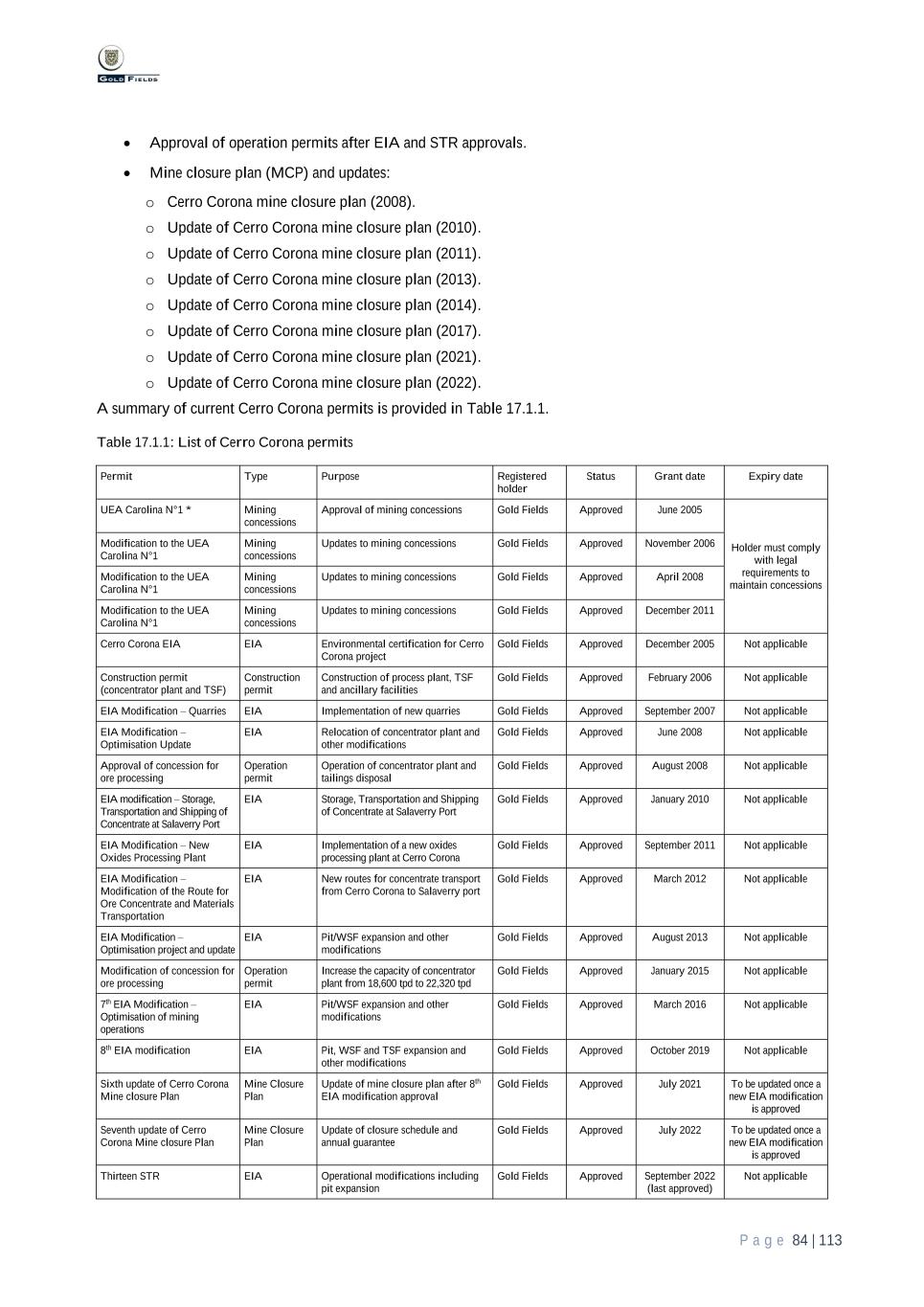
P a g e 84 | 113 • Approval of operation permits after EIA and STR approvals. • Mine closure plan (MCP) and updates: o Cerro Corona mine closure plan (2008). o Update of Cerro Corona mine closure plan (2010). o Update of Cerro Corona mine closure plan (2011). o Update of Cerro Corona mine closure plan (2013). o Update of Cerro Corona mine closure plan (2014). o Update of Cerro Corona mine closure plan (2017). o Update of Cerro Corona mine closure plan (2021). o Update of Cerro Corona mine closure plan (2022). A summary of current Cerro Corona permits is provided in Table 17.1.1. Table 17.1.1: List of Cerro Corona permits Permit Type Purpose Registered holder Status Grant date Expiry date UEA Carolina N°1 * Mining concessions Approval of mining concessions Gold Fields Approved June 2005 Holder must comply with legal requirements to maintain concessions Modification to the UEA Carolina N°1 Mining concessions Updates to mining concessions Gold Fields Approved November 2006 Modification to the UEA Carolina N°1 Mining concessions Updates to mining concessions Gold Fields Approved April 2008 Modification to the UEA Carolina N°1 Mining concessions Updates to mining concessions Gold Fields Approved December 2011 Cerro Corona EIA EIA Environmental certification for Cerro Corona project Gold Fields Approved December 2005 Not applicable Construction permit (concentrator plant and TSF) Construction permit Construction of process plant, TSF and ancillary facilities Gold Fields Approved February 2006 Not applicable EIA Modification – Quarries EIA Implementation of new quarries Gold Fields Approved September 2007 Not applicable EIA Modification – Optimisation Update EIA Relocation of concentrator plant and other modifications Gold Fields Approved June 2008 Not applicable Approval of concession for ore processing Operation permit Operation of concentrator plant and tailings disposal Gold Fields Approved August 2008 Not applicable EIA modification – Storage, Transportation and Shipping of Concentrate at Salaverry Port EIA Storage, Transportation and Shipping of Concentrate at Salaverry Port Gold Fields Approved January 2010 Not applicable EIA Modification – New Oxides Processing Plant EIA Implementation of a new oxides processing plant at Cerro Corona Gold Fields Approved September 2011 Not applicable EIA Modification – Modification of the Route for Ore Concentrate and Materials Transportation EIA New routes for concentrate transport from Cerro Corona to Salaverry port Gold Fields Approved March 2012 Not applicable EIA Modification – Optimisation project and update EIA Pit/WSF expansion and other modifications Gold Fields Approved August 2013 Not applicable Modification of concession for ore processing Operation permit Increase the capacity of concentrator plant from 18,600 tpd to 22,320 tpd Gold Fields Approved January 2015 Not applicable 7th EIA Modification – Optimisation of mining operations EIA Pit/WSF expansion and other modifications Gold Fields Approved March 2016 Not applicable 8th EIA modification EIA Pit, WSF and TSF expansion and other modifications Gold Fields Approved October 2019 Not applicable Sixth update of Cerro Corona Mine closure Plan Mine Closure Plan Update of mine closure plan after 8th EIA modification approval Gold Fields Approved July 2021 To be updated once a new EIA modification is approved Seventh update of Cerro Corona Mine closure Plan Mine Closure Plan Update of closure schedule and annual guarantee Gold Fields Approved July 2022 To be updated once a new EIA modification is approved Thirteen STR EIA Operational modifications including pit expansion Gold Fields Approved September 2022 (last approved) Not applicable

P a g e 85 | 113 Permit Type Purpose Registered holder Status Grant date Expiry date Plan for adaptation to new Peruvian Water Quality Standards and discharge limits EIA Environmental certification for new water treatment plant for TSF discharge required to remove sulphates for compliance of water quality standards in Tingo River Gold Fields Approved September 2021 Not applicable Water license Las Gordas and Las Aguilas creeks Water use Water storage at TSF and supply for operations Gold Fields Approved August 2008 Not applicable Water license borehole PPC -1 Water use Water supply for operations Gold Fields Approved September 2008 Not applicable Water license – pit dewatering Water use Pit dewatering and water supply for operations Gold Fields Approved November 2008 Not applicable Notes: * UEA: Administrative and Economic Unit (group of mining concessions). a) The Qualified person has selected significant permits to demonstrate permitting. b) The Qualified person is of the opinion that the licenses are in good standing and that any current or future licensing can and will be obtained for the Mineral reserve or the Mineral resource. c) The Qualified person is of the opinion that Cerro Corona has a good standing with licensing authorities, community groups and that licensing is not expected to be material to Mineral reserves or Mineral resources. d) Cerro Corona is conducting continuous rehabilitation and has a large closure liability. The Qualified person is of the opinion that the closure estimates and duration are reasonable and practical and that appropriate funding provisions are in place to expedite all obligations. Source: Cerro Corona CPR, 2022 According to the Peruvian regulations the mine closure plan is guaranteed annually by a bond letter. The total amount of bond guarantees submitted to the MEM by 2022 (issued by Banco de Crédito del Perú and Scotiabank) is $80 M. The total amount of the guarantee is completed progressively (yearly) up to the last year of operations according to the schedule and calculations approved by MEM in the closure plan. 17.2 Environmental studies Environmental management by Cerro Corona since construction is conducted with a rigorous Environmental Management System (EMS). Cerro Corona first obtained ISO 14001:2004 certification in 2009. Since 2011, Cerro Corona has been certified in accordance with ISO 14001:2004 and OHSAS 18001:2007 or ISO 45001 standards and has established an integrated Safety, Occupational Health and Environmental Management System, which subscribes to international best practices and Peruvian legal requirements. In May 2022 and November 2022, Cerro Corona completed the annual external audits of its integrated management system with a recommendation that the mine maintains ISO 14001:2004, ISO 45001:2018 and ISO 50001:2011 certifications. Several environmental studies have been completed in the area, most of which are compiled and submitted to the authorities as support for the EIA processes. The following lists summarises the studies completed in recent years: • Hydrogeological characterisation of Cerro Corona and numeric (predictive) models. • Climate change vulnerability assessment and adaptation plan. • Environmental monitoring (air, water, soil, noise, vibration, biodiversity, weather). • Environmental geochemical tests onsite. • Environmental geochemical models for Cerro Corona. • Air quality and noise modelling. • Water balance at catchment level. • Operational water balance. • Hydrologic studies. • Onsite pilot test of covers for mine closure. • Pre-feasibility level mine closure plan.
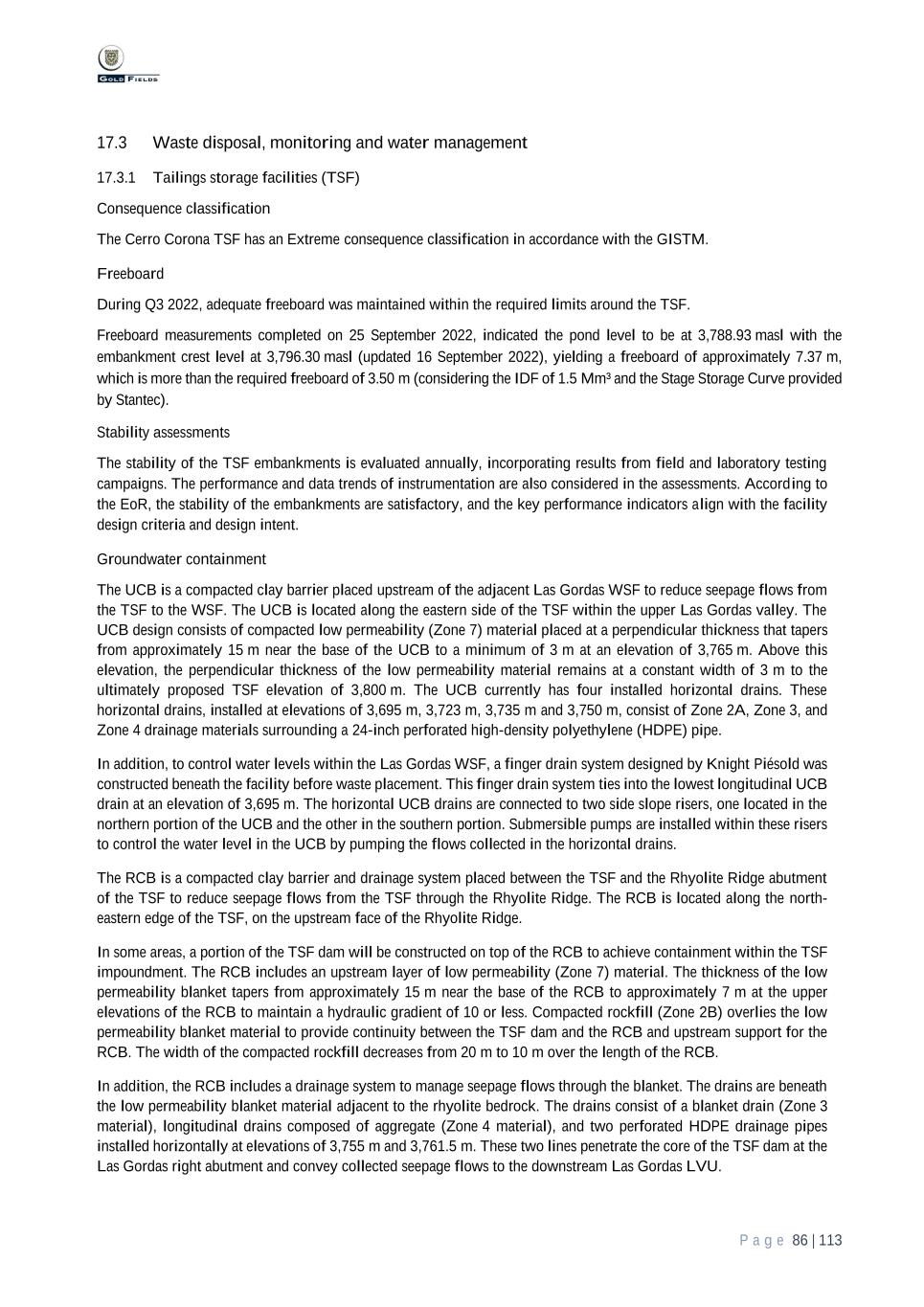
P a g e 86 | 113 17.3 Waste disposal, monitoring and water management 17.3.1 Tailings storage facilities (TSF) Consequence classification The Cerro Corona TSF has an Extreme consequence classification in accordance with the GISTM. Freeboard During Q3 2022, adequate freeboard was maintained within the required limits around the TSF. Freeboard measurements completed on 25 September 2022, indicated the pond level to be at 3,788.93 masl with the embankment crest level at 3,796.30 masl (updated 16 September 2022), yielding a freeboard of approximately 7.37 m, which is more than the required freeboard of 3.50 m (considering the IDF of 1.5 Mm³ and the Stage Storage Curve provided by Stantec). Stability assessments The stability of the TSF embankments is evaluated annually, incorporating results from field and laboratory testing campaigns. The performance and data trends of instrumentation are also considered in the assessments. According to the EoR, the stability of the embankments are satisfactory, and the key performance indicators align with the facility design criteria and design intent. Groundwater containment The UCB is a compacted clay barrier placed upstream of the adjacent Las Gordas WSF to reduce seepage flows from the TSF to the WSF. The UCB is located along the eastern side of the TSF within the upper Las Gordas valley. The UCB design consists of compacted low permeability (Zone 7) material placed at a perpendicular thickness that tapers from approximately 15 m near the base of the UCB to a minimum of 3 m at an elevation of 3,765 m. Above this elevation, the perpendicular thickness of the low permeability material remains at a constant width of 3 m to the ultimately proposed TSF elevation of 3,800 m. The UCB currently has four installed horizontal drains. These horizontal drains, installed at elevations of 3,695 m, 3,723 m, 3,735 m and 3,750 m, consist of Zone 2A, Zone 3, and Zone 4 drainage materials surrounding a 24-inch perforated high-density polyethylene (HDPE) pipe. In addition, to control water levels within the Las Gordas WSF, a finger drain system designed by Knight Piésold was constructed beneath the facility before waste placement. This finger drain system ties into the lowest longitudinal UCB drain at an elevation of 3,695 m. The horizontal UCB drains are connected to two side slope risers, one located in the northern portion of the UCB and the other in the southern portion. Submersible pumps are installed within these risers to control the water level in the UCB by pumping the flows collected in the horizontal drains. The RCB is a compacted clay barrier and drainage system placed between the TSF and the Rhyolite Ridge abutment of the TSF to reduce seepage flows from the TSF through the Rhyolite Ridge. The RCB is located along the north- eastern edge of the TSF, on the upstream face of the Rhyolite Ridge. In some areas, a portion of the TSF dam will be constructed on top of the RCB to achieve containment within the TSF impoundment. The RCB includes an upstream layer of low permeability (Zone 7) material. The thickness of the low permeability blanket tapers from approximately 15 m near the base of the RCB to approximately 7 m at the upper elevations of the RCB to maintain a hydraulic gradient of 10 or less. Compacted rockfill (Zone 2B) overlies the low permeability blanket material to provide continuity between the TSF dam and the RCB and upstream support for the RCB. The width of the compacted rockfill decreases from 20 m to 10 m over the length of the RCB. In addition, the RCB includes a drainage system to manage seepage flows through the blanket. The drains are beneath the low permeability blanket material adjacent to the rhyolite bedrock. The drains consist of a blanket drain (Zone 3 material), longitudinal drains composed of aggregate (Zone 4 material), and two perforated HDPE drainage pipes installed horizontally at elevations of 3,755 m and 3,761.5 m. These two lines penetrate the core of the TSF dam at the Las Gordas right abutment and convey collected seepage flows to the downstream Las Gordas LVU.
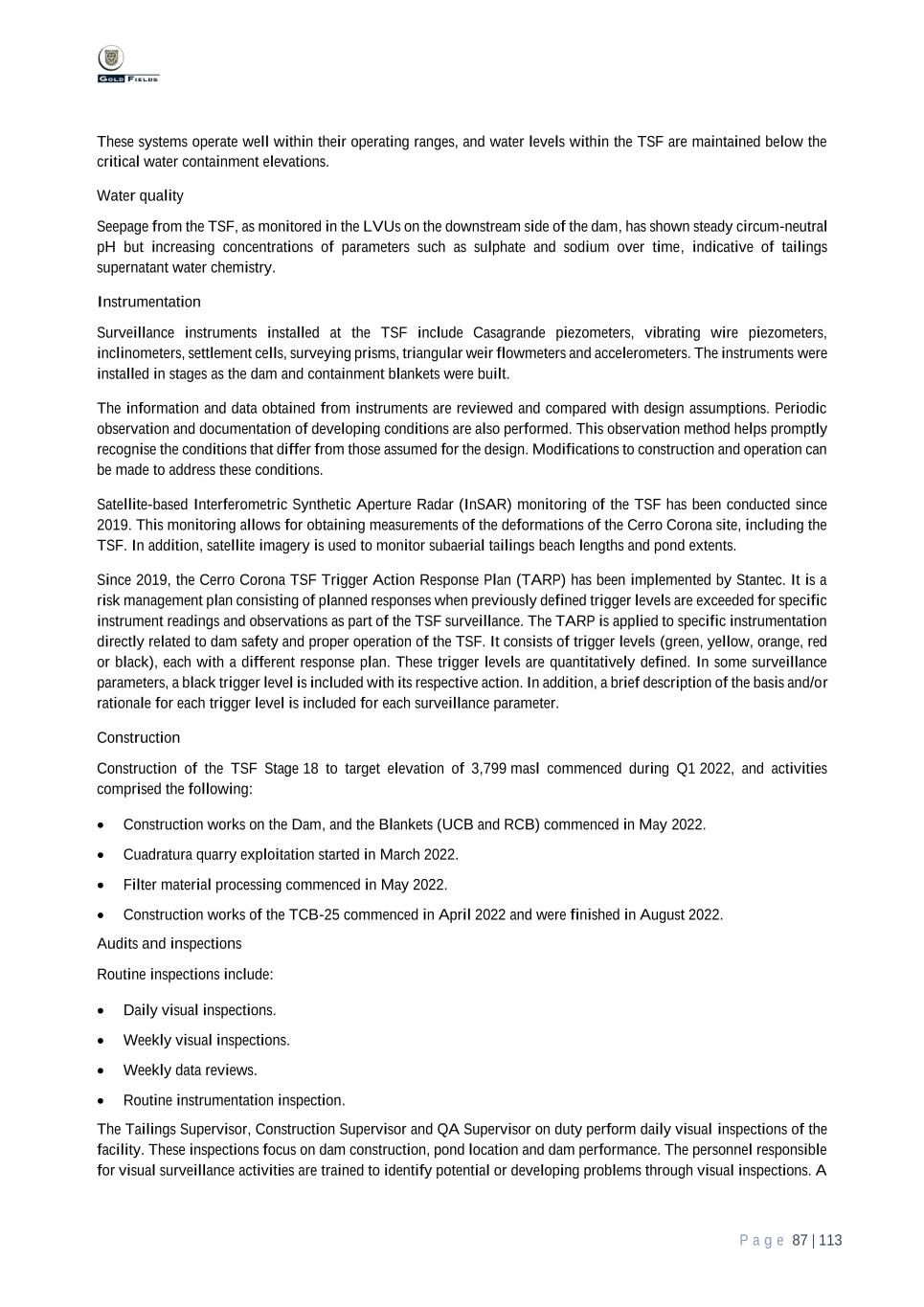
P a g e 87 | 113 These systems operate well within their operating ranges, and water levels within the TSF are maintained below the critical water containment elevations. Water quality Seepage from the TSF, as monitored in the LVUs on the downstream side of the dam, has shown steady circum-neutral pH but increasing concentrations of parameters such as sulphate and sodium over time, indicative of tailings supernatant water chemistry. Instrumentation Surveillance instruments installed at the TSF include Casagrande piezometers, vibrating wire piezometers, inclinometers, settlement cells, surveying prisms, triangular weir flowmeters and accelerometers. The instruments were installed in stages as the dam and containment blankets were built. The information and data obtained from instruments are reviewed and compared with design assumptions. Periodic observation and documentation of developing conditions are also performed. This observation method helps promptly recognise the conditions that differ from those assumed for the design. Modifications to construction and operation can be made to address these conditions. Satellite-based Interferometric Synthetic Aperture Radar (InSAR) monitoring of the TSF has been conducted since 2019. This monitoring allows for obtaining measurements of the deformations of the Cerro Corona site, including the TSF. In addition, satellite imagery is used to monitor subaerial tailings beach lengths and pond extents. Since 2019, the Cerro Corona TSF Trigger Action Response Plan (TARP) has been implemented by Stantec. It is a risk management plan consisting of planned responses when previously defined trigger levels are exceeded for specific instrument readings and observations as part of the TSF surveillance. The TARP is applied to specific instrumentation directly related to dam safety and proper operation of the TSF. It consists of trigger levels (green, yellow, orange, red or black), each with a different response plan. These trigger levels are quantitatively defined. In some surveillance parameters, a black trigger level is included with its respective action. In addition, a brief description of the basis and/or rationale for each trigger level is included for each surveillance parameter. Construction Construction of the TSF Stage 18 to target elevation of 3,799 masl commenced during Q1 2022, and activities comprised the following: • Construction works on the Dam, and the Blankets (UCB and RCB) commenced in May 2022. • Cuadratura quarry exploitation started in March 2022. • Filter material processing commenced in May 2022. • Construction works of the TCB-25 commenced in April 2022 and were finished in August 2022. Audits and inspections Routine inspections include: • Daily visual inspections. • Weekly visual inspections. • Weekly data reviews. • Routine instrumentation inspection. The Tailings Supervisor, Construction Supervisor and QA Supervisor on duty perform daily visual inspections of the facility. These inspections focus on dam construction, pond location and dam performance. The personnel responsible for visual surveillance activities are trained to identify potential or developing problems through visual inspections. A

P a g e 88 | 113 key aspect of monitoring is the repetitive observation of the same feature to assess changes and their rate of change (e.g., crack extension, increased seepage, etc.). Engineer of Record (EoR) reviews The EoR performs quarterly inspections, attends quarterly meetings, and prepares quarterly EoR Reports for the TSF. For example, Stantec performed the 2022 Q3 EoR inspection on 12 September 2022. In general, conditions appear similar to the 2022 Q1 inspection. Surveillance data indicate the continued performance of the TSF Dam and containment blankets with no signs of slumping, cracking, uncontrolled seepage or piping. In addition, monitoring data generally indicates readings within the “Green” TARP threshold with no significant changes in readings. No new dam safety deficiencies were identified in 2022 Q3. However, one existing non-conformance was marked as complete as follows: • NC-001 – Consequence Classification – Stantec completed the Consequence Classification for the TSF Dam, including developing estimates of Potential Loss of Life (PLL) and Population and Risk (PAR) and classified the dam considering ANCOLD, CDA, and GISTM Guidelines. For all three guidelines, the recommended dam classification is “Extreme”. IGTRB IGTRB Meeting No. 54 was held during 2021 Q3. The IGTRB provided a final report following the meeting. IGTRB Meeting No. 55 was scheduled for Q4 2022 due to scheduling conflicts with the IGTRB. Third-Party Reviews Ausenco performed the external audit in December 2021. a) GFLC contracted SRK Consulting to perform a Dam Safety Review (DSR) of the Cerro Corona TSF. SRK visited the Cerro Corona Mine during the week of 12 September 2022, and met with staff from Stantec and GLFC and inspected the site. SRK is scheduled to submit the draft DSR report in 2022 Q4. The Qualified person has the opinion: a) That the procedures, monitoring and water management practices are adequate in support of the life-of-mine Mineral reserve estimate. b) The TSFs at Cerro Corona are being well managed from a dam safety and governance perspective. 17.3.2 Waste rock dumps The Factor of Safety (FoS) criteria, selected for long-term surface and deep stability, were obtained from waste rock deposit guidance documents based on risk-based approaches which classify the waste rock deposit according to the probability and factors related to the consequence. This document was produced by Stantec. The waste materials destined for disposal contain a high concentration of sulphur, mainly diorites with a rapid oxidative tendency, reaching hyperacid conditions (pH <3.5) in very short periods of time so they will control the chemistry of the resulting contact water. The behaviour over time of the diorites, in their different degrees of alteration, are responsible for the final water quality of the reservoir. The sectorised geochemical modelling determined the areas of the reservoir with the highest degree of acid drainage generation, allowing a sectorised management for its control in operation and closure, with the Gordas / Facilities sector being the major generator of acid drainage. Cerro Corona has identified incidences of acid mine drainage (AMD) generation, and the risk of potential short-term and long-term AMD issues at Cerro Corona. Cerro Corona commissioned additional technical studies during 2015 to 2022 to identify the steps required to prevent or mitigate the potentially material AMD impacts, but none of these studies have allowed the mine to generate a reliable estimate of the total potential closure cost. Cerro Corona continues to investigate technical solutions to better inform appropriate short- and long-term mitigation strategies for AMD management and to work towards a reasonable cost estimate of these potential issues.
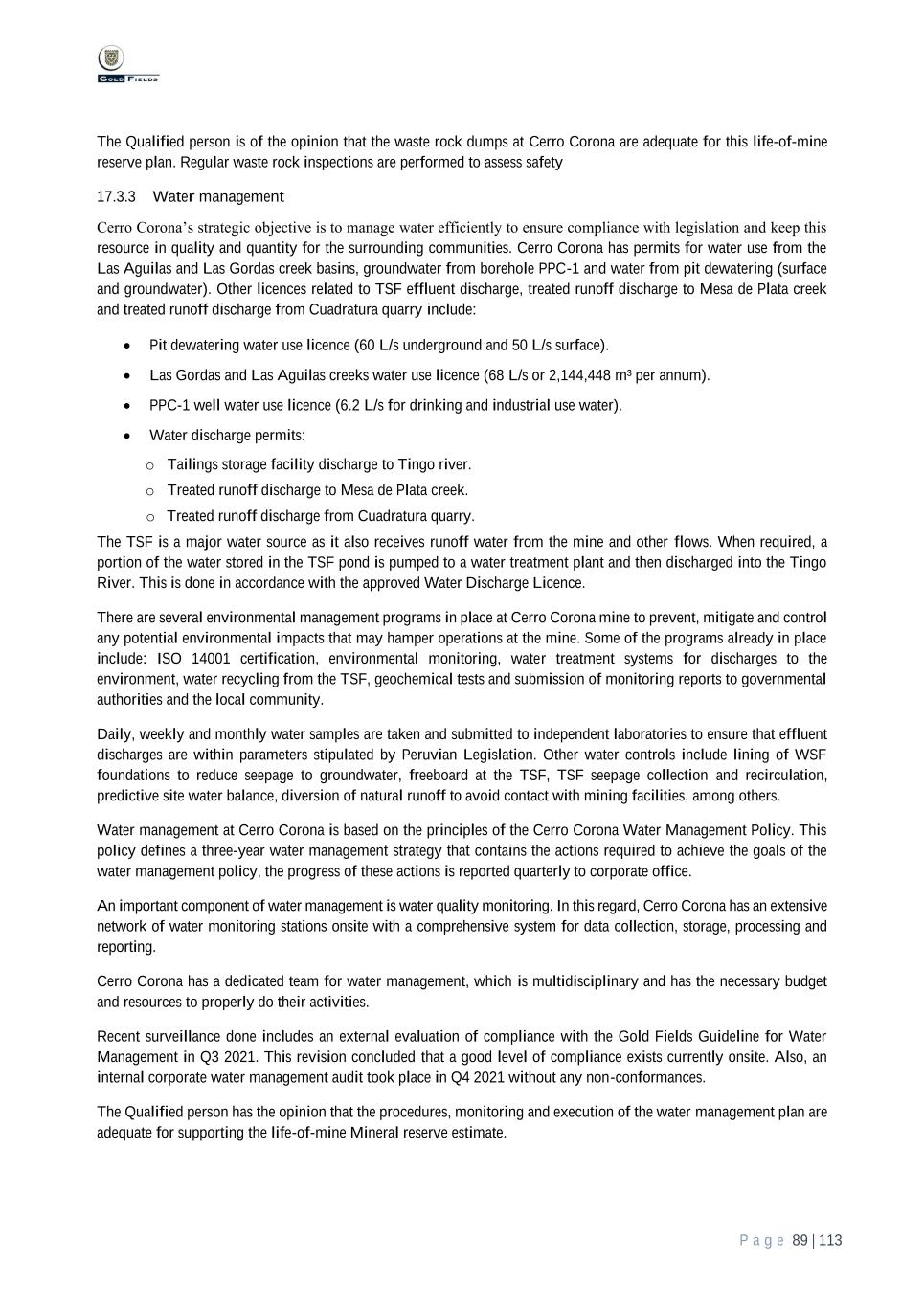
P a g e 89 | 113 The Qualified person is of the opinion that the waste rock dumps at Cerro Corona are adequate for this life-of-mine reserve plan. Regular waste rock inspections are performed to assess safety 17.3.3 Water management Cerro Corona’s strategic objective is to manage water efficiently to ensure compliance with legislation and keep this resource in quality and quantity for the surrounding communities. Cerro Corona has permits for water use from the Las Aguilas and Las Gordas creek basins, groundwater from borehole PPC-1 and water from pit dewatering (surface and groundwater). Other licences related to TSF effluent discharge, treated runoff discharge to Mesa de Plata creek and treated runoff discharge from Cuadratura quarry include: • Pit dewatering water use licence (60 L/s underground and 50 L/s surface). • Las Gordas and Las Aguilas creeks water use licence (68 L/s or 2,144,448 m³ per annum). • PPC-1 well water use licence (6.2 L/s for drinking and industrial use water). • Water discharge permits: o Tailings storage facility discharge to Tingo river. o Treated runoff discharge to Mesa de Plata creek. o Treated runoff discharge from Cuadratura quarry. The TSF is a major water source as it also receives runoff water from the mine and other flows. When required, a portion of the water stored in the TSF pond is pumped to a water treatment plant and then discharged into the Tingo River. This is done in accordance with the approved Water Discharge Licence. There are several environmental management programs in place at Cerro Corona mine to prevent, mitigate and control any potential environmental impacts that may hamper operations at the mine. Some of the programs already in place include: ISO 14001 certification, environmental monitoring, water treatment systems for discharges to the environment, water recycling from the TSF, geochemical tests and submission of monitoring reports to governmental authorities and the local community. Daily, weekly and monthly water samples are taken and submitted to independent laboratories to ensure that effluent discharges are within parameters stipulated by Peruvian Legislation. Other water controls include lining of WSF foundations to reduce seepage to groundwater, freeboard at the TSF, TSF seepage collection and recirculation, predictive site water balance, diversion of natural runoff to avoid contact with mining facilities, among others. Water management at Cerro Corona is based on the principles of the Cerro Corona Water Management Policy. This policy defines a three-year water management strategy that contains the actions required to achieve the goals of the water management policy, the progress of these actions is reported quarterly to corporate office. An important component of water management is water quality monitoring. In this regard, Cerro Corona has an extensive network of water monitoring stations onsite with a comprehensive system for data collection, storage, processing and reporting. Cerro Corona has a dedicated team for water management, which is multidisciplinary and has the necessary budget and resources to properly do their activities. Recent surveillance done includes an external evaluation of compliance with the Gold Fields Guideline for Water Management in Q3 2021. This revision concluded that a good level of compliance exists currently onsite. Also, an internal corporate water management audit took place in Q4 2021 without any non-conformances. The Qualified person has the opinion that the procedures, monitoring and execution of the water management plan are adequate for supporting the life-of-mine Mineral reserve estimate.

P a g e 90 | 113 17.4 Social and community Apart from those considered in the social closure plan approved in the VIII MEIA in force (Modification of the Environmental Impact Study), there are no agreements that oblige Cerro Corona to serve landowners or community entrepreneurs once mining activities are completed. As part of Gold Fields' strategy, in 2022 Cerro Corona achieved 30.27 % employment of host community labor (794 people) exceeding the target, while 13 % of total purchases involved host community companies ($31 million) reaching the internal target. In addition, 181 local companies were given the opportunity to participate in Cerro Corona's various services. In addition, 183 jobs in projects executed outside the mine were completed in 2022. During 2022, the main objectives of the sustainable development program focused on the development of projects related to infrastructure, agriculture, livestock, genetic improvement and veterinary service as well as water supply for communities in the direct area of influence, support for educational projects, technical training, university scholarships and professional internship program with the participation of Cerro Corona's main contractors. Likewise, contributions were made to the communities and implementation of local health centers and health posts against COVID-19. A total of $5.8 million was invested in SED projects focused mainly on infrastructure investments and productive projects. GFLC implemented a forest buffer zone in 02 sectors adjacent to the Arpón and Cantera Facilidades components of the operation. 17.5 Mine closure Cerro Corona submitted its mine closure plan (MCP) in December 2006, obtaining approval from MEM in June 2008. However, due to subsequent modifications of the EIA, several updates to the MCP were completed. The last approved MCP was received in July 2022. The plan has been developed in accordance with legal requirements and Gold Fields guidance, which aligns with the International Council on Mining and Metals (ICMM) guidance The Mine Closure Plan determines the mine closure requirements and calculates the financial or closure cost liability associated with closure. The MCP approved by MEM includes stakeholder engagement, decontamination, dismantling, re-profiling and revegetation of land or landforms, maintenance and monitoring, including post closure water monitoring (after rehabilitation is completed) including the activities for final and progressive closure of all Cerro Corona facilities and its operations at Salaverry port. Specifically these include: • Waste rock storage facility: Cover of the facility with low permeability materials, drainage layer and topsoil for revegetation. Implementation of channels for surface drainage. • Open pit: Pit lake formation after conclusion of mining. • Concentrator plant: Decommissioning, demolition and covering the area with topsoil for revegetation. • Other facilities: Decommissioning, demolition and covering the area with topsoil for revegetation. • The mine closure activities are designed to achieve physical and geochemical stability of all the components of the mine. The MCP also includes an environmental monitoring plan at key locations for the post closure stage. In addition, the plan includes a schedule for site inspections during post closure to verify the condition of rehabilitated areas. • Cerro Corona originally developed their closure cost estimate using the Standardised Reclamation Cost Estimator (SRCE) model. Closure costs are reviewed every year to reflect actual and proposed disturbances and changes in closure requirements. The closure cost estimate, developed for asset retirement obligation purposes, is updated and reviewed, externally, every two years by an independent consultant, and reviewed annually as part of the Group financial assurance. • The total cost approved by MEM for the Cerro Corona MCP is $152.1 million. According to the Peruvian regulations, this amount is guaranteed yearly. In the case of Cerro Corona, it is guaranteed by a bond letter which is revised progressively up to the last year of operations according to the schedule and calculations approved by MEM in the MCP.
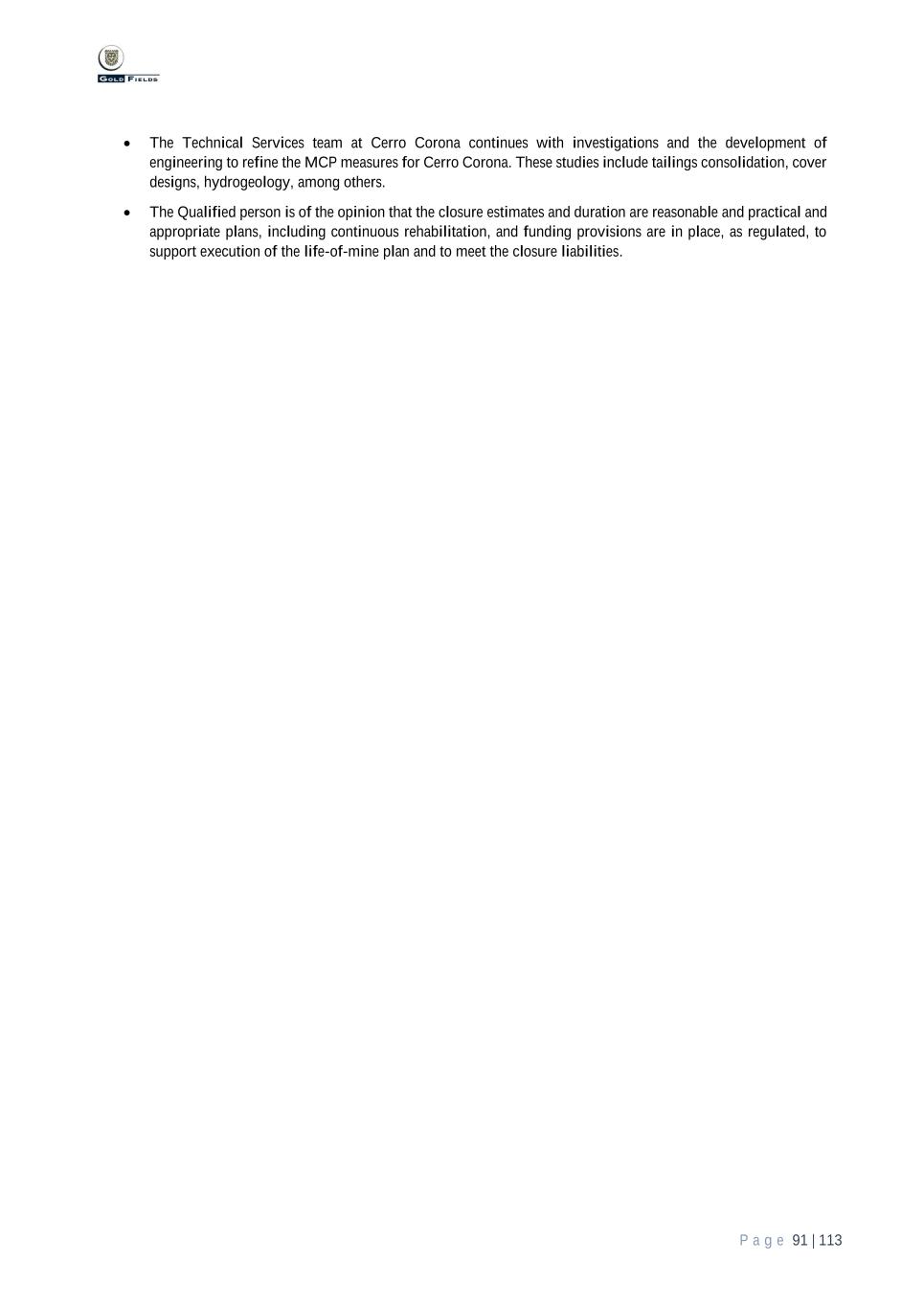
P a g e 91 | 113 • The Technical Services team at Cerro Corona continues with investigations and the development of engineering to refine the MCP measures for Cerro Corona. These studies include tailings consolidation, cover designs, hydrogeology, among others. • The Qualified person is of the opinion that the closure estimates and duration are reasonable and practical and appropriate plans, including continuous rehabilitation, and funding provisions are in place, as regulated, to support execution of the life-of-mine plan and to meet the closure liabilities.

P a g e 92 | 113 18 Capital and operating costs 18.1 Capital costs The capital expenditures are based on detailed requirements for the next two years based on the 2023 and 2024 approved budgets and have an order of accuracy of ±10 %. Capital estimates beyond two years are based on pre- feasibility or better estimates for infrastructure and development requirements for individual projects with nominal allowances made for general overheads and processing capital requirements. As it can be seen in the capital forecast, 90 % of the capital will be expended during the next 3 years, The major capital items at Cerro Corona are related to the ongoing raising of the TSF, construction of containment blankets, the WSF and the in-pit tailings facility. The LOM capital expenditure forecast was updated and approved in October 2022 as part of the 2023 budget process. Table 18.1.1 summarises the forecast of sustaining and project capital expenditures for Cerro Corona. Table 18.1.1: Capital costs forecast Cost item Units 2023 2024 2025 2026 2027 2028 2029 2030 Mining MP&Dev $ million - - - - - - - - Mining Capital Works (WSF) $ million 1.9 - - - - - - - Processing (incl. TSFs) $ million 22.5 10.1 23.2 - - - - - G&A Capital – Sustaining $ million 20.1 6.8 1.6 3.0 1.4 1.7 0.8 0.2 Exploration $ million - - - - - - - - Total Capital $ million 44.5 16.9 24.8 3.0 1.4 1.7 0.8 0.2 Notes: a) The operating costs are based on the life-of-mine schedule for proven and probable reserves and are on a 100 % basis. b) No inferred Mineral resource is included in the life-of-mine processing schedule or techno-economic evaluation. c) Exploration costs required to replace depleted reserves are not included in this techno-economic assessment. d) No inferred Mineral resource is included in the life-of-mine processing schedule or techno-economic evaluation. e) Costs are first principles based on the Mineral reserve life-of-mine schedule. f) This capital cost summary estimate is for the Mineral reserve life-of-mine schedule. Source: Cerro Corona CPR, 2022 18.2 Operating Cost Operating costs are based on the 2022 actual costs and the 2023 operational budget to 2030, and overheads and mining rates. Operating costs main assumptions: • Cerro Corona’s mining operations are based on a contractor mining, which means that mining costs are mainly driven by contract rates. These vary depending on the volume of material mined, pit depth and other factors considered during the tender process. In addition, Cerro Corona’s owner mining and technical services costs and dayworks are included in the mining cost. • Mining costs beyond 2025 considers the re handling of ore from low grade stockpiles to the process plant. Additional activities like roads maintenance and dayworks are also considered. • Processing costs, which includes power and tailings costs, are based on 2022 actual costs and 2023 and 2024 approved budgets. For costs beyond 2025, forecasts are based on 2024 budget and main consumables market prices projections, like energy, diesel and grinding media. • The G&A cost is made up of onsite and offsite overhead costs. This cost includes all service departments on the mine, including IT & communications, camp, warehouses, community affairs, environment, safety and protection services. Offsite costs include Lima office overhead costs, including human resources, commercial, legal, finance, corporate affairs and general management. As well as mine costs, these costs have been estimated based on 2022 actuals costs, and the approved 2023 and 2024 budgets. For costs beyond 2025, cost

P a g e 93 | 113 forecasts are based on 2024 budget and taking into consideration a reduction associated to the end of mining and reduction of ounces produced. The operating costs forecast is summarised in Table 18.2.1. Table 18.2.1: Operating costs forecast. Operating Cost Units 2023 2024 2025 2026 2027 2028 2029 2030 Mining $ million 82.1 71.8 56.0 15.7 14.5 15.1 15,5 6.3 Processing $ million 62.3 62.5 63.0 63.9 65.5 64.8 65.5 29.4 G&A Operating $ million 61.5 57.3 53.8 45.2 41.5 39.8 40.4 17.7 Other operating costs $ million 13.3 10.3 7.1 2.4 2.5 0.2 0.0 7.1 Operating costs $ million 219.1 201.9 179.9 127.3 124.1 119.9 121.4 60.5 Notes: a) The operating costs are based on the life-of-mine schedule for proven and probable reserves and are on a 100 % basis. b) No inferred Mineral resource is included in the life-of-mine processing schedule or techno-economic evaluation. c) Exploration costs required to replace depleted reserves are not included in this techno-economic assessment. d) No inferred Mineral resource is included in the life-of-mine processing schedule or techno-economic evaluation. e) Costs are first principles based on the Mineral reserve life-of-mine schedule. f) This operating cost summary estimate is for the Mineral reserve life-of-mine schedule. Source: Cerro Corona CPR, 2022 18.3 Closure cost The Cerro Corona mine closure cost is estimated at $152.1 million, excluding Peruvian taxes. This amount includes closure costs for facilities such as the Cerro Corona pit, waste dumps, tailings dam, and infrastructure removal, as well as post-closure monitoring, maintenance costs, and indirect costs. Table 18.3.1: Post LOM costs 100 % basis Sources Units 2031 2032 2033 2034 2035 2035 onwards Post reserve LOM closure $ million 10.5 4.4 3.2 5.1 7.5 6.4 Property holding costs $ million 115.0 Notes: a) Closure costs are presented from 2031 onwards. Source: Cerro Corona CPR, 2022 The Qualified person’s opinion on capital and operating costs is summarised below: a) The financial schedule is wired to the life-of-mine plan to ensure the provision of capital is linked to when the major budgeted items require to be funded. The capital and operating costs applied are appropriate to derive a realistic. and meaningful life-of-mine financial model in support of the Mineral reserve estimate. b) The capital, operating and closure cost estimation levels of accuracy meet the minimum pre-feasibility study requirements at an estimated accuracy of ±25 % and require no more than 15 % contingency. The specific engineering estimation methods have an accuracy equal to or better than this range. c) Cerro Corona has improved capital estimation and capital delivery through the application of Group Capital Standards and capital projects review by a select team with improved implementation planning. Gold Fields also perform post investment reviews across all major capital studies and share key learnings. d) Gold Fields’ two-year business planning cycle captures operating and capital costs along with key physicals and revenue. The business plans are internally reviewed, presented to the Executive Committee for approval, prior to sanctioning by the Gold Fields board of directors. The business plans are aligned with the Registrant’s strategic direction and equate to the first two years of the life-of-mine plan. e) Capital expenditure, once sanctioned, must follow the company capital reporting standard. Monthly and quarterly reviews are held to assess capital programs, operating unit costs, mine physicals, plan execution and revenue streams.

P a g e 94 | 113 f) Operating unit costs are based on recent valid historical performance and where necessary take account of future changing circumstances that are anticipated to impact future operating costs.

P a g e 95 | 113 19 Economic analysis 19.1 Key inputs and assumptions The Cerro Corona economic analysis is based on: • All assumptions in real terms (without inflation), figures as at the valuation date of 31 December 2022. • Peruvian government royalties: between 1.5 % and 2 % of revenues but based on operating margin, consistent with the relevant legislation. • Taxable income is calculated in terms of local relevant legislation. • A real base case discount rate which is determined by Gold Fields Corporate Finance annually. • The discounted cashflow (DCF) applied to post-tax, pre-finance cashflows and reported in financial years. The input parameters for the economic analysis are: • The Mineral reserves disclosed in Section 12.3. No inferred Mineral resources are included in the economic analysis. • The mining and processing schedule disclosed in Section 12.2. • Process recoveries disclosed in Section 12.2. • Capital costs disclosed in Section 18.1. • Operating costs disclosed in Section 18.2. • A reserve gold price of $1,400/oz and copper price of $3.40/lb as discussed in Section 12.2. • A real discount rate of 8.1 %. • A corporate tax rate of 29.5 %. The LOM physical, operating cost and capital cost inputs including rehabilitation, leasing and closure costs, and revenue assumptions for the economic analysis to 2030 are summarised in Table 19.1.1. The attributable (99.53 %) gold and copper, free-cashflow (FCF) and Net Present Value (NPV) for the Cerro Corona LOM Mineral reserve is summarised in Table 19.1.2. Cerro Corona’s post-tax NPV of the Mineral reserves based on discounting the cashflow in Table 19.1.1 at an 8.1 % discount rate is $192 million. Given the mine is currently cashflow positive, the IRR and payback period are not relevant measures for the Cerro Corona property.

P a g e 96 | 113 Table 19.1.1: LOM physical, operating cost and capital cost inputs and revenue assumptions Sources Units 2023 2024 2025 2026 2027 2028 2029 2030 LOM Open Pit (Gold) LOM Processed Koz 131.1 102.1 89.4 - - - - - 322.6 Recovery % 68.4 68.0 69.6 - - - - - 68.6 Sold Koz 128.0 99.6 87.3 - - - - - 314.9 Stockpiles (Gold) LOM Processed Koz - - - 62.0 46.5 46.9 61.1 50.7 267.2 Recovery % - - - 67.9 68.9 61.6 61.9 63.1 64.5 Sold Koz - - - 61.2 46.1 46.7 59.6 49.5 263.1 Open Pit (Copper) LOM Processed Koz 151.5 141.2 138.3 - - - - - 431.0 Recovery % 87.5 87.3 88.7 - - - - - 85.9 Sold Koz 144.2 134.4 131.7 - - - - - 410.3 Stockpiles (Copper) LOM Processed Koz - - - 99.7 73.0 82.3 91.1 35.4 381.5 Recovery % - - - 87.4 86.5 84.3 83.0 72.3 83.8 Sold Koz - - - 95.9 70.6 80.1 86.7 33.7 367.0 Total Sold (Gold) Koz 128.0 99.6 87.3 61.2 46.1 46.7 59.6 49.5 578.0 Total Sold (Copper) Kt 26.9 25.1 24.6 17.9 13.2 15.0 16.2 6.3 145.2 Total Sold (Gold Equiv Oz) Koz 272.2 234.0 219.0 157.1 116.7 126.8 146.3 83.2 1,355.2 Costs, Revenue and Cashflow Revenue $ million 362.3 310.2 289.5 207.7 154.3 167.2 193.6 112.0 1,797.0 Operating Costs $ million 219.1 201.9 179.9 127.3 124.1 119.9 121.4 60.5 1,154.1 Capital Costs $ million 44.5 16.9 24.8 3.0 1.4 1.7 0.8 0.2 93.2 Other $ million 14.7 13.1 12.6 8.9 8.4 8.5 6.7 4.0 76.8 Royalties (~1 % sales) $ million 3.6 3.1 2.9 2.1 1.5 1.7 1.9 1.1 18.0 Interest (if applicable) $ million - - - - - - - - - Total Costs (Excl Tax) $ million 281.9 235.0 220.2 141.3 135.3 131.8 130.8 65.7 1342.0 Taxes (Income tax) $ million 44.3 29.0 21.1 - - - - - 94.4 Cashflow $ million 39.4 43.6 46.3 22.3 0.0 27.4 60.1 38.4 247.8 Discounted cashflow at 8.1 % (NPV) $ million 37.9 38.8 38.1 16.9 0.0 17.8 36.2 21.4 192.0 Notes: b) This table is based on the life-of-mine schedule for proved and probable Mineral reserves only and is on a 100 % basis. a) The Mineral resource and exploration required to replace depletion is not included in this techno-economic assessment. b) No inferred Mineral resources are included in the life-of-mine processing schedule or techno-economic evaluation. Source: Cerro Corona CPR, 2022 Table 19.1.2: Gold Fields 99.53 % Attributable Gold, FCF and NPV Sources Units 2023 2024 2025 2026 2027 2028 2029 2030 LOM 99.53 % Attributable Gold koz 127.4 99.2 86.8 61.0 45.9 46.5 59.3 49.3 575.3 99.53 % Attributable Copper kt 26.8 25.0 24.5 17.8 13.1 14.9 16.1 6.3 144.4 99.53 % Cashflow $ million 39.2 43.4 46.1 22.2 0.4 27.2 59.5 38.3 276.5 Discounted cashflow at 8.1 % (NPV) $ million 191 Source: Cerro Corona CPR, 2022 Table 19.1.3:Breakdown of ESG expenditure included in Table 18.1.1, Table 18.2.1 and Table 19.1.1 Sources Units 2023 2024 2025 2026 2027 2028 2029 2030 2031-Onw Progressive Closure* koz - - 15.3 38.8 24.5 9.4 13.3 14.7 37.2 Notes: * Costs included in capital costs (Table 18.1.1, Table 18.2.1 and Table 19.1.1). Source: Cerro Corona CPR, 2022
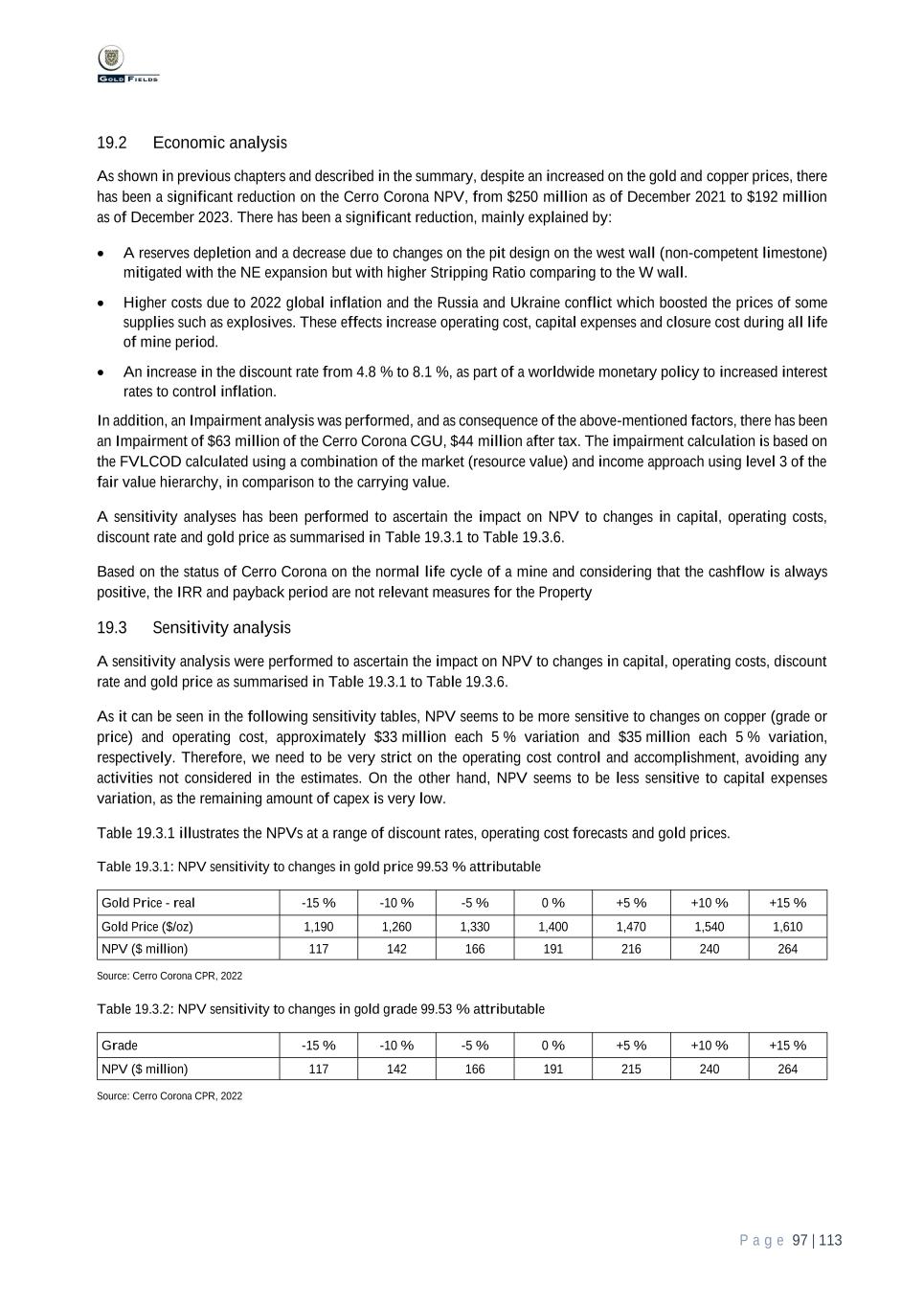
P a g e 97 | 113 19.2 Economic analysis As shown in previous chapters and described in the summary, despite an increased on the gold and copper prices, there has been a significant reduction on the Cerro Corona NPV, from $250 million as of December 2021 to $192 million as of December 2023. There has been a significant reduction, mainly explained by: • A reserves depletion and a decrease due to changes on the pit design on the west wall (non-competent limestone) mitigated with the NE expansion but with higher Stripping Ratio comparing to the W wall. • Higher costs due to 2022 global inflation and the Russia and Ukraine conflict which boosted the prices of some supplies such as explosives. These effects increase operating cost, capital expenses and closure cost during all life of mine period. • An increase in the discount rate from 4.8 % to 8.1 %, as part of a worldwide monetary policy to increased interest rates to control inflation. In addition, an Impairment analysis was performed, and as consequence of the above-mentioned factors, there has been an Impairment of $63 million of the Cerro Corona CGU, $44 million after tax. The impairment calculation is based on the FVLCOD calculated using a combination of the market (resource value) and income approach using level 3 of the fair value hierarchy, in comparison to the carrying value. A sensitivity analyses has been performed to ascertain the impact on NPV to changes in capital, operating costs, discount rate and gold price as summarised in Table 19.3.1 to Table 19.3.6. Based on the status of Cerro Corona on the normal life cycle of a mine and considering that the cashflow is always positive, the IRR and payback period are not relevant measures for the Property 19.3 Sensitivity analysis A sensitivity analysis were performed to ascertain the impact on NPV to changes in capital, operating costs, discount rate and gold price as summarised in Table 19.3.1 to Table 19.3.6. As it can be seen in the following sensitivity tables, NPV seems to be more sensitive to changes on copper (grade or price) and operating cost, approximately $33 million each 5 % variation and $35 million each 5 % variation, respectively. Therefore, we need to be very strict on the operating cost control and accomplishment, avoiding any activities not considered in the estimates. On the other hand, NPV seems to be less sensitive to capital expenses variation, as the remaining amount of capex is very low. Table 19.3.1 illustrates the NPVs at a range of discount rates, operating cost forecasts and gold prices. Table 19.3.1: NPV sensitivity to changes in gold price 99.53 % attributable Gold Price - real -15 % -10 % -5 % 0 % +5 % +10 % +15 % Gold Price ($/oz) 1,190 1,260 1,330 1,400 1,470 1,540 1,610 NPV ($ million) 117 142 166 191 216 240 264 Source: Cerro Corona CPR, 2022 Table 19.3.2: NPV sensitivity to changes in gold grade 99.53 % attributable Grade -15 % -10 % -5 % 0 % +5 % +10 % +15 % NPV ($ million) 117 142 166 191 215 240 264 Source: Cerro Corona CPR, 2022

P a g e 98 | 113 Table 19.3.3: NPV sensitivity to changes in copper price 99.53 % attributable Copper Price – real -15 % -10 % -5 % 0 % +5 % +10 % +15 % Copper Price ($/lb) 2.9 3.1 3.2 3.4 3.6 3.7 3.9 NPV ($ million) 92 124 158 191 224 257 290 Source: Cerro Corona CPR, 2022 Table 19.3.4: NPV sensitivity to changes in copper grade 99.53 % attributable Grade -15 % -10 % -5 % 0 % +5 % +10 % +15 % NPV ($ million) 107 135 163 191 219 246 274 Source: Cerro Corona CPR, 2022 Table 19.3.5: NPV sensitivity to changes in capital costs 99.53 % attributable Capital costs -15 % -10 % -5 % 0 % +5 % +10 % +15 % NPV ($ million) 203 199 195 191 187 183 179 Source: Cerro Corona CPR, 2022 Table 19.3.6: NPV sensitivity to changes in operating costs 99.53 % attributable Operating costs -15 % -10 % -5 % 0 % +5 % +10 % +15 % NPV ($ million) 297 262 226 191 155 120 85 Source: Cerro Corona CPR, 2022 Table 19.3.7: NPV sensitivity to changes in discount rate 99.53 % attributable Discount rate 6.9 % 7.3 % 7.7 % 8.1 % 8.5 % 8.9 % 9.3 % NPV ($ million) 197 195 193 191 189 187 185 Source: Cerro Corona CPR, 2022 The Qualified person’s opinion is that: a) The key assumptions, input parameters and methods applied to the economic analysis are realistic, appropriate and suitable for life-of-mine financial modelling. b) The techno-economic model is correctly based on the relevant Mineral reserve mine plan physicals. c) The recent historic assumptions used to test the Mineral reserve economic assumptions are appropriate. d) The material assumptions have been found to be valid and used correctly in the techno-economic studies. The discounted cashflow confirms economic viability with a NPV of $192 million at a discount rate of 8.1 %. e) The techno-economic study for the Mineral reserves excludes all inferred Mineral resource material.

P a g e 99 | 113 20 Adjacent properties There are two adjacent properties in proximity of Cerro Corona: • The Tantahuatay open pit gold mine 6 km to the northwest operated by Minera Coimolache S.A. since 2011. • El Zorro operated by Minera San Nicolas, which is in the process of closing. Tantahuatay and El Zorro are high sulphidation epithermal-type deposits. At Tantahuatay, the epithermal mineralisation overprints a skarn hosting copper sulphide mineralisation at depth. The Qualified person is unable to verify publicly disclosed information pertaining to these adjacent properties. The Qualified person notes that the information relating to these adjacent properties is not necessarily indicative of the mineralisation within the Cerro Corona property that is the subject of this Technical Report Summary.

P a g e 100 | 113 21 Other relevant data and information The current LOM strategy is to transition to in-pit tailings. Once tailings are placed in the open pit for storage, any remaining open pit Mineral resources and Mineral reserves will become sterilised. However, alternative tailings solutions are being investigated. The Qualified person is not aware of any additional information or explanation that should be disclosed to provide a more complete and balanced presentation of the value of the Cerro Corona Property. The content of this Technical Report Summary is deemed to provide all appropriate and relevant information that is viewed as material to enable a full understanding of the technical and economic aspects of the Property in support of the Mineral resources and Mineral reserves disclosure. Gold Fields’ commitment to materiality, transparency and competency in its Mineral resources and Mineral reserves disclosure to regulators and in the public domain is of paramount importance to the Qualified person and the Registrants Executive Committee and Board of Directors continue to endorse the company’s internal and external review and audit assurance protocols. This Technical Report Summary should be read in totality to gain a full understanding of Cerro Corona’s Mineral resource and Mineral reserve estimation and reporting process, including data integrity, estimation methodologies, modifying factors, mining and processing capacity and capability, confidence in the estimates, economic analysis, risk and uncertainty and overall projected property value. However, to ensure consolidated coverage of the Company’s primary internal controls in generating Mineral resource and Mineral reserve estimates the following key point summary is provided: a) A comprehensive quality assurance and quality control (QA/QC) protocol is embedded at Cerro Corona and all Gold Fields operations. It draws on industry leading practice for data acquisition and utilises national standards authority accredited laboratories which are regularly reviewed. Analytical QA/QC is maintained and monitored through the submission of sample blanks, certified reference material and duplicates and umpire laboratory checks. b) Corporate Technical Services (CTS), based in Perth, comprises subject matter experts across the disciplines of geology, resource estimation, geotechnical, mining, engineering, modernisation, capital projects, processing, metallurgy, tailings management and Mineral resource and reserve reporting governance. The CTS team budget for regular site visits to all operating mines when emphasis is placed on-site inspection and direct engagement with the technical staff to drive protocols and standards and enable on-site training and upskilling. CTS provides technical oversight and guidance to the operating Regions and mines and ensures an additional level of assurance to the Mineral resource and Mineral reserve estimates to supplement the mine sites and Regional technical teams. c) Independent audit review of fixed infrastructure is conducted annually with the appointed insurance auditor focused on plant, machinery and mine infrastructure risks. An effective structural and corrosion maintenance program with benchmark inspections is in place supported by equipment condition monitoring major critical component spares. Focus areas include the primary jaw crusher, ball mill shell or motor failure, structural failure of plant or conveyor, process tank failure and large transformer failure. Critical spares are well resourced and there are no large items not supported by on-site spares holdings. d) Mobile equipment is largely owned and well maintained by the mining contractor and there is some spare capacity in most of the fleets or, alternatively, hire units are readily available in the region. e) Processing controls include the preparation of quarterly plant metal accounting reconciliation reports by the mine sites which are reviewed by the Regional Metallurgical Manager and VP Metallurgy in the CTS team. Any monthly reconciliation variance outside the limits provided within the Gold Fields Plant Metal Accounting Standard is flagged for follow up assessment and remediation if warranted.

P a g e 101 | 113 f) Cerro Corona has a tailings management plan that promotes risk minimisation to operators and stakeholders over the lifecycle of each tailings storage facility (TSF). Cerro Corona’s TSF’s are operated in accordance with the company TSF Management Guidelines which are aligned with the International Council on Metals & Mining’s (ICMM) Position Statement on preventing catastrophic failure of TSFs (December 2016). Active TSFs are subject to an independent, external audit every three years, as well as regular inspections and formal dam safety reviews by formally appointed Engineers of Record (EoR). Further improvements in tailings management are expected through achievement of compliance with the new independently developed Global Industry Standard for Tailings Management (GISTM) issued in 2020. g) The integration of Environmental, Social and Governance (ESG) themes into the estimation process continues as an important consideration for modifying factors, reasonable prospects for economic extraction (RPEE) assessments and to underpin the integrity of the Mineral resources and Mineral reserves. The company’s ESG Charter, issues and priorities are fully considered in the life-of-mine plan with particular emphasis on tailings management, integrated mine closure planning, security of energy and water and the social and regulatory license to operate. h) Gold Fields also follows an embedded process of third-party reviews to provide expert independent assurance regarding Mineral resource and Mineral reserve estimates and compliance with relevant reporting rules and codes. In line with Gold Fields policy, every material property is reviewed by an independent third-party on average no less than once every three years, or when triggered by a material year-on-year change. Certificates of compliance are received from the companies that conduct the external audits which are also configured to drive continuous improvement in the estimation process. i) Importantly, Gold Fields endorses a well embedded risk and control matrix (RACM) configured to provide an annual assessment of the effectiveness of the registrants’ internal controls concerning the life of mine planning process and Mineral resource and reserve estimation and reporting. j) The internal controls include coverage of the following (inter alia): i Reasonableness of parameters and assumptions used in the Mineral resource and reserve estimation process. ii Reasonableness of the interpretations applied to the geological model and estimation techniques. iii Integrity in the mine design and scheduling, including reasonableness of the mine planning assumptions, modifying factors, cut-off grades, mining and processing methods and supporting key technical inputs such as year on year reconciliation, geotechnical, mining equipment, infrastructure, water, energy, and economic analysis. iv Provision of the necessary skills, experience and expertise at the mine sites and the Regions to undertake and complete the work with the required level of technical ability and competency, including professional registration as a Qualified person. v Alignment with the SK 1300 rule (guidance and instruction) for the reporting of Mineral resources and reserves. vi Review of the disclosure of the registrants’ Mineral resources and reserves process. k) Because of its inherent limitations, internal controls may not prevent or detect all errors or misstatements. Also, projections of any valuation of effectiveness to future periods are subject to risk that controls may become inadequate because of changes in conditions, or that the degree of compliance with policies and procedures may deteriorate. RCubed© is a proprietary cloud-based reporting system adopted by Gold Fields in 2021 to enhance the level governance and data security concerning Mineral resource and reserve reporting across all company properties. It ensures transparency and auditability for all data verification checks, information stage gating, the approvals process and confirmation of Qualified person credentials. The RCubed© reporting system is being incorporated into the SOX RACM matrix to support the Mineral resource and Mineral reserve reporting.

P a g e 102 | 113 22 Interpretation and conclusions 22.1 Conclusions The Mineral reserves currently support an 8 year LOM plan that values the Cerro Corona operation at $192 million at a gold price of $1,400/oz and copper price of $3.40/lb, and a discount rate of 8.1 %. During 2022, there has been a worldwide inflationary environment that boosted costs and interest rates. In addition, Mineral reserves have decreased due to depletion and geotechnical issues in the pit that have necessitated changes in the mine plan. As a consequence of these two effects and together with other minor changes, an impairment was necessitated at Cerro Corona. Strict cost control and avoidance of major changes to the mining plan will be necessary to avoid future impairments. Climate change is an integral part of the Mineral reserve generation process and incorporating relevant costs associated with climate change, primarily decarbonisation, mitigation and adaptation to the changing climate, is a key theme for the Company. Integration of these key elements into the Mineral reserve process is being carried out progressively and simultaneously across all of Gold Fields’ sites. The Qualified person considers that, with respect to all material technical-economic matters, Gold Fields has undertaken the necessary studies to ensure compliance with SK 1300, in terms of the level of disclosure. The Qualified person verifies that the information included in this Technical Report Summary is appropriate, based on current information available, legislation and corporate guidance. 22.2 Risks The Mineral reserve estimates contained in this report should not be interpreted as assurances of the economic life or the future profitability of Cerro Corona. Mineral reserves are estimates based on the factors and assumptions described herein, thus future Mineral reserve estimates may need to be revised. For example, if production costs increase or product prices decrease, a portion of the current Mineral resources, from which the Mineral reserves are derived, may become uneconomic and would therefore result in a lower estimate of Mineral reserves. The LOM plans include forward-looking technical and economic parameters and involve a number of risks and uncertainties that could cause actual results to differ materially. The LOM plan for Cerro Corona has been reviewed in detail for appropriateness, reasonableness and viability, including the existence of and justification for departure from historical performance. The Qualified person considers that the TEP and FM are based on sound reasoning, engineering judgement and technically achievable mine plan, within the context of the risk associated with the gold mining industry. Climate change is an integral part of the Mineral reserve generation process and incorporating relevant costs associated with climate change, primarily decarbonisation, mitigation and adaptation to the changing climate, is a key theme for the Company. Integration of these key elements into the Mineral reserve process is being carried out progressively and simultaneously across all of Gold Fields’ sites. The business of gold mining by its nature involves significant risks and hazards, including environmental hazards and industrial accidents. Hazards associated with Gold Fields’ mining operations include: • Ground and surface water pollution because of spillage or seepage from tailings storage facilities, heap leach processing operations and the use of hazardous substances to facilitate the gold extraction process. • Contractor mining performance. • Incidents associated with the operation of large waste and ore transportation equipment. • Incidents associated with blasting operations. • Failure of the open pit walls. • Failure of a TSF embankment and inundation of downstream areas.

P a g e 103 | 113 • Production disruptions due to inclement weather. • Incidents associated with operating waste rock dumps, production stockpiles and associated crushing and conveyor equipment. The operation may also be subject to actions by labour groups or other interested parties who object to perceived conditions at the mines or to the perceived environmental impact. These actions may delay or halt production or may create negative publicity. They include amongst others: • The inability of the operation to hire and retain sufficient technically skilled employees may result in its business being adversely affected. • Power stoppages, fluctuations and power cost increases may adversely affect the financial viability of the operation. • Illegal mining operations in the vicinity of the Property could disrupt mining operations. There are however no illegal operations on-site due to the stable relationship the operation has with the surrounding community. The occurrence of any of these hazards could delay or impact production, increase production costs and result in liability for Cerro Corona. Financial risks are assessed through sensitivity analysis. Risk assessments are completed as part of the risk management protocols in Gold Fields governance practices. The aim is to identify and rank project risks based on the probability of an event occurring and the consequences should that event occur. The risk assessment framework is outlined in the Gold Fields Risk Assessment Standard. The top operational risks from the latest risk assessment completed in 2020 are summarised in Table 22.2.1. Table 22.2.1: Cerro Corona risk register – top operational risks Area Risk description 1 Social Interruption of operations by local communities due to social expectation and/ or erroneous perceptions of the community about to the LOM 2030 project. 2 Plant Reduced process plant availability beyond its design life. 4 Legal / Regulation Delay in obtaining permits due to extended review by government institutions and/or erroneous social perceptions based on the communications plan (required by law to this project) driven by third parties. 3 Geotechnical Geotechnical failure of the east wall affecting the haulage ramp during mining. 5 Environmental Seepage from the in-pit TSF during the operation and/or closure of the flooded open pit from above the hydraulic containment level. 6 Environmental Closure activities affected by the lower hydraulic containment level: 7 TSF dam / pit Deformation of the 3,803 mRL TSF embankment resulting in the release of tailings and/or water from the TSF pond. 8 Operational Lower than expected metallurgical recovery either from the RoM ore or from low-grade ore after oxidation on stockpiles. 9 TSF dam / pit Reduction in available capacity (3,803 mRL TSF) due to final tailings density being lower than the projected value. 10 Operational The reclaimed water from the in-pit TSF has a high solids load resulting in additional pumping costs. 11 Operational Operator absenteeism due to the COVID-19 pandemic resulting in a delay to the mining sequence and WSF construction schedule Source: Cerro Corona CPR, 2022

P a g e 104 | 113 23 Recommendations The Qualified person is of the opinion that the Mineral reserve and Mineral resource are reasonable estimates. The drilling programs along with the extraction schedule are reasonable estimates and do not warrant further phases of work.

P a g e 105 | 113 24 References The Cerro Corona Competent Person Report 31 December 2022 for Mineral resources and Mineral reserves is referred to in this document as “Cerro Corona CPR, 2022”. The Cerro Corona CPR, 2022 has written consent by the Qualified persons in Table 2.5.1 for the Mineral reserve and Mineral resource to be publicly disclosed in this format against the SK 1302 regulations.
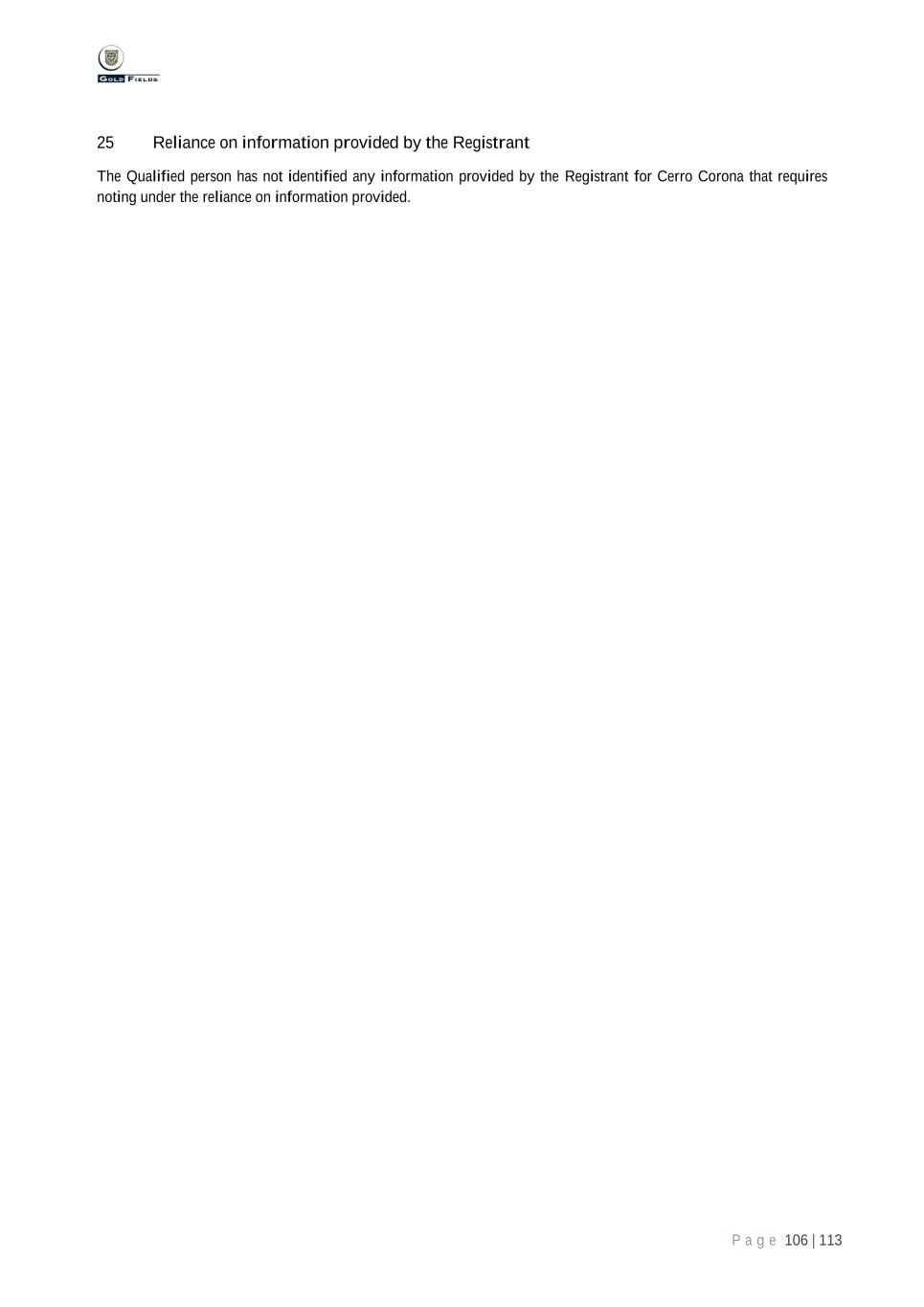
P a g e 106 | 113 25 Reliance on information provided by the Registrant The Qualified person has not identified any information provided by the Registrant for Cerro Corona that requires noting under the reliance on information provided.

P a g e 107 | 113 26 Definitions 26.1 Adequate geological evidence When used in the context of Mineral resource determination, means evidence that is sufficient to establish geological and grade or quality continuity with reasonable certainty. 26.2 Conclusive geological evidence When used in the context of Mineral resource determination, means evidence that is sufficient to test and confirm geological and grade or quality continuity. 26.3 Cutoff grade Is the grade (i.e., the concentration of metal or mineral in rock) that determines the destination of the material during mining. For purposes of establishing “prospects of economic extraction,” the cutoff grade is the grade that distinguishes material deemed to have no economic value (it will not be mined in underground mining or if mined in surface mining, its destination will be the waste dump) from material deemed to have economic value (its ultimate destination during mining will be a processing facility). Other terms used in similar fashion as cutoff grade include net smelter return, pay limit and break-even stripping ratio. 26.4 Development stage issuer Is an issuer that is engaged in the preparation of Mineral reserves for extraction on at least one Material property. 26.5 Development stage property Is a property that has Mineral reserves disclosed, pursuant to this subpart, but no material extraction. 26.6 Economically viable When used in the context of Mineral reserve determination, means that the Qualified person has determined, using a discounted cashflow analysis, or has otherwise analytically determined, that extraction of the Mineral reserve is economically viable under reasonable Investment and market assumptions. 26.7 Exploration results Are data and information generated by mineral exploration programs (i.e., programs consisting of sampling, drilling, trenching, analytical testing, assaying and other similar activities undertaken to locate, investigate, define or delineate a mineral prospect or mineral deposit) that are not part of a disclosure of Mineral resources or Mineral reserves. A Registrant must not use exploration results alone to derive estimates of tonnage, grade and production rates, or in an assessment of economic viability. 26.8 Exploration stage issuer Is an issuer that has no Material property with Mineral reserves disclosed. 26.9 Exploration stage property Is a property that has no Mineral reserves disclosed. 26.10 Exploration target Is a statement or estimate of the exploration potential of a mineral deposit in a defined geological setting where the statement or estimate, quoted as a range of tonnage and a range of grade (or quality), relates to mineralisation for which there has been insufficient exploration to estimate a Mineral resource.

P a g e 108 | 113 26.11 Feasibility study Is a comprehensive technical and economic study of the selected development option for a mineral project, which includes detailed assessments of all applicable Modifying factors, as defined by this section, together with any other relevant operational factors, and detailed financial analysis that are necessary to demonstrate, at the time of reporting, that extraction is Economically viable. The results of the study may serve as the basis for a final decision by a proponent or financial institution to proceed with, or finance, the development of the project. 1. A feasibility study is more comprehensive, and with a higher degree of accuracy, than a Preliminary feasibility study (or pre-feasibility study). It must contain mining, infrastructure and process designs completed with sufficient rigor to serve as the basis for an investment decision or to support project financing. 2. The confidence level in the results of a feasibility study is higher than the confidence level in the results of a Preliminary feasibility study (or pre-feasibility study). Terms such as full, final, comprehensive, bankable, or definitive feasibility study are equivalent to a feasibility study. 26.12 Final market study Is a comprehensive study to determine and support the existence of a readily accessible market for the mineral. It must, at a minimum, include product specifications based on final geologic and metallurgical testing, supply and demand forecasts, historical prices for the preceding five or more years, estimated long term prices, evaluation of competitors (including products and estimates of production volumes, sales and prices), customer evaluation of product specifications and market entry strategies or sales contracts. The study must provide justification for all assumptions, which must include assumptions concerning the Material contracts required to develop and sell the Mineral reserves. 26.13 Indicated Mineral resource. Is that part of a Mineral resource for which quantity and grade or quality are estimated on the basis of Adequate geological evidence and sampling. The level of geological certainty associated with an indicated Mineral resource is sufficient to allow a Qualified person to apply Modifying factors in sufficient detail to support mine planning and evaluation of the economic viability of the deposit. Because an indicated Mineral resource has a lower level of confidence than the level of confidence of a Measured Mineral resource, an indicated Mineral resource may only be converted to a Probable Mineral reserve. 26.14 Inferred Mineral resource. Is that part of a Mineral resource for which quantity and grade or quality are estimated on the basis of Limited geological evidence and sampling. The level of geological uncertainty associated with an inferred Mineral resource is too high to apply relevant technical and economic factors likely to influence the prospects of economic extraction in a manner useful for evaluation of economic viability. Because an inferred Mineral resource has the lowest level of geological confidence of all Mineral resources, which prevents the application of the Modifying factors in a manner useful for evaluation of economic viability, an inferred Mineral resource may not be considered when assessing the economic viability of a mining project and may not be converted to a Mineral reserve. 26.15 Initial assessment Is a preliminary technical and economic study of the economic potential of all or parts of mineralisation to support the disclosure of Mineral resources. The initial assessment must be prepared by a Qualified person and must include appropriate assessments of reasonably assumed technical and economic factors, together with any other relevant operational factors, that are necessary to demonstrate at the time of reporting that there are reasonable prospects for economic extraction. An initial assessment is required for disclosure of Mineral resources but cannot be used as the basis for disclosure of Mineral reserves.

P a g e 109 | 113 26.16 Investment and market assumptions When used in the context of Mineral reserve determination, includes all assumptions made about the prices, exchange rates, interest and discount rates, sales volumes and costs that are necessary to determine the economic viability of the Mineral reserves. The Qualified person must use a price for each commodity that provides a reasonable basis for establishing that the project is Economically viable. 26.17 Limited geological evidence When used in the context of Mineral resource determination, means evidence that is only sufficient to establish that geological and grade or quality continuity are more likely than not. 26.18 Material Has the same meaning as under Part 230.405 or Part 240.12b-2. The term material, when used to qualify a requirement for the furnishing of information as to any subject, limits the information required to those matters to which there is a substantial likelihood that a reasonable investor would attach importance in determining whether to purchase the security registered. 26.19 Material of economic interest When used in the context of Mineral resource determination, includes mineralisation, including dumps and tailings, mineral brines and other resources extracted on or within the earth's crust. It does not include oil and gas resources resulting from oil and gas producing activities, as defined in Part 210.4-10(a)(16)(i) of this chapter, gases (e.g., helium and carbon dioxide), geothermal fields and water. 26.20 Measured Mineral resource. Is that part of a Mineral resource for which quantity and grade or quality are estimated on the basis of Conclusive geological evidence and sampling. The level of geological certainty associated with a measured Mineral resource is sufficient to allow a Qualified person to apply Modifying factors, as defined in this section, in sufficient detail to support detailed mine planning and final evaluation of the economic viability of the deposit. Because a measured Mineral resource has a higher level of confidence than the level of confidence of either an Indicated Mineral resource or an Inferred Mineral resource, a measured Mineral resource may be converted to a Proven Mineral reserve or to a Probable Mineral reserve. 26.21 Mineral reserve Is an estimate of tonnage and grade or quality of Indicated Mineral resources and Measured Mineral resources that, in the opinion of the Qualified person, can be the basis of an Economically viable project. More specifically, it is the economically mineable part of a measured or Indicated Mineral resource, which includes diluting materials and allowances for losses that may occur when the material is mined or extracted. 26.22 Mineral resource Is a concentration or occurrence of Material of economic interest in or on the Earth's crust in such form, grade or quality and quantity that there are reasonable prospects for economic extraction. A Mineral resource is a reasonable estimate of mineralisation, considering relevant factors such as Cutoff grade, likely mining dimensions, location or continuity, that, with the assumed and justifiable technical and economic conditions, is likely to, in whole or in part, become economically extractable. It is not merely an inventory of all mineralisation drilled or sampled.

P a g e 110 | 113 26.23 Modifying factors Are the factors that a Qualified person must apply to Indicated Mineral resources and Measured Mineral resources and then evaluate to establish the economic viability of Mineral reserves. A Qualified person must apply and evaluate modifying factors to convert Measured Mineral resources and Indicated Mineral resources to Proven Mineral reserves and Probable Mineral reserves. These factors include but are not restricted to: Mining; processing; metallurgical; infrastructure; economic; marketing; legal; environmental compliance; plans, negotiations, or agreements with local individuals or groups; and governmental factors. The number, type and specific characteristics of the modifying factors applied will necessarily be a function of and depend upon the mineral, mine, property, or project. 26.24 Preliminary feasibility study (or pre-feasibility study) Is a comprehensive study of a range of options for the technical and economic viability of a mineral project that has advanced to a stage where a Qualified person has determined (in the case of underground mining) a preferred mining method, or (in the case of surface mining) a pit configuration, and in all cases has determined an effective method of mineral processing and an effective plan to sell the product. 1. A pre-feasibility study includes a financial analysis based on reasonable assumptions, based on appropriate testing, about the Modifying factors and the evaluation of any other relevant factors that are sufficient for a Qualified person to determine if all or part of the Indicated Mineral resources and Measured Mineral resources may be converted to Mineral reserves at the time of reporting. The financial analysis must have the level of detail necessary to demonstrate, at the time of reporting, that extraction is Economically viable. 2. A pre-feasibility study is less comprehensive and results in a lower confidence level than a Feasibility study. A pre-feasibility study is more comprehensive and results in a higher confidence level than an Initial assessment. 26.25 Preliminary market study Is a study that is sufficiently rigorous and comprehensive to determine and support the existence of a readily accessible market for the mineral. It must, at a minimum, include product specifications based on preliminary geologic and metallurgical testing, supply and demand forecasts, historical prices for the preceding five or more years, estimated long term prices, evaluation of competitors (including products and estimates of production volumes, sales and prices), customer evaluation of product specifications and market entry strategies. The study must provide justification for all assumptions. It can, however, be less rigorous and comprehensive than a final market study, which is required for a full Feasibility study. 26.26 Probable Mineral reserve Is the economically mineable part of an Indicated Mineral resource and, in some cases, a Measured Mineral resource. 26.27 Production stage issuer Is an issuer that is engaged in material extraction of Mineral reserves on at least one Material property. 26.28 Production stage property Is a property with material extraction of Mineral reserves. 26.29 Proven Mineral reserve. Is the economically mineable part of a Measured Mineral resource and can only result from conversion of a Measured Mineral resource.

P a g e 111 | 113 26.30 Qualified person Is an individual who is: 1. A mineral industry professional with at least five years of Relevant experience in the type of mineralisation and type of deposit under consideration and in the specific type of activity that person is undertaking on behalf of the Registrant; and 2. An eligible member or licensee in good standing of a recognised professional organisation at the time the technical report is prepared. For an organisation to be a recognised professional organisation, it must: i Be either: A. An organisation recognised within the mining industry as a reputable professional association; or B. A board authorised by U.S. federal, state, or foreign statute to regulate professionals in the mining, geoscience, or related field. ii Admit eligible members primarily based on their academic qualifications and experience. iii Establish and require compliance with professional standards of competence and ethics. iv Require or encourage continuing professional development. v Have and apply disciplinary powers, including the power to suspend or expel a member regardless of where the member practices or resides; and vi Provide a public list of members in good standing. 26.31 Relevant experience Means, for purposes of determining whether a party is a Qualified person, that the party has experience in the specific type of activity that the person is undertaking on behalf of the Registrant. If the Qualified person is preparing or supervising the preparation of a technical report concerning Exploration results, the relevant experience must be in exploration. If the Qualified person is estimating, or supervising the estimation of Mineral resources, the relevant experience must be in the estimation, assessment and evaluation of Mineral resources and associated technical and economic factors likely to influence the prospect of economic extraction. If the Qualified person is estimating, or supervising the estimation of Mineral reserves, the relevant experience must be in engineering and other disciplines required for the estimation, assessment, evaluation and economic extraction of Mineral reserves. 1. Relevant experience also means, for purposes of determining whether a party is a Qualified person, that the party has experience evaluating the specific type of mineral deposit under consideration (e.g., coal, metal, base metal, industrial mineral, or mineral brine). The type of experience necessary to qualify as relevant is a facts and circumstances determination. For example, experience in a high-nugget, vein-type mineralisation such as tin or tungsten would likely be relevant experience for estimating Mineral resources for vein-gold mineralisation, whereas experience in a low grade disseminated gold deposit likely would not be relevant. Note 1 to paragraph (1) of the definition of relevant experience: It is not always necessary for a person to have five years' experience in each type of deposit to be an eligible Qualified person if that person has relevant experience in similar deposit types. For example, a person with 20 years' experience in estimating Mineral resources for a variety of metalliferous hard-rock deposit types may not require as much as five years of specific experience in porphyry- copper deposits to act as a Qualified person. Relevant experience in the other deposit types could count towards the experience in relation to porphyry-copper deposits. 2. For a Qualified person providing a technical report for Exploration results or Mineral resource estimates, relevant experience also requires, in addition to experience in the type of mineralisation, sufficient experience with the sampling and analytical techniques, as well as extraction and processing techniques, relevant to the mineral deposit under consideration. Sufficient experience means that level of experience necessary to be able to identify, with substantial confidence, problems that could affect the reliability of data and issues associated with processing.

P a g e 112 | 113 3. For a Qualified person applying the Modifying factors, as defined by this section, to convert Mineral resources to Mineral reserves, relevant experience also requires: i Sufficient knowledge and experience in the application of these factors to the mineral deposit under consideration; and ii Experience with the geology, geostatistics, mining, extraction and processing that is applicable to the type of mineral and mining under consideration.
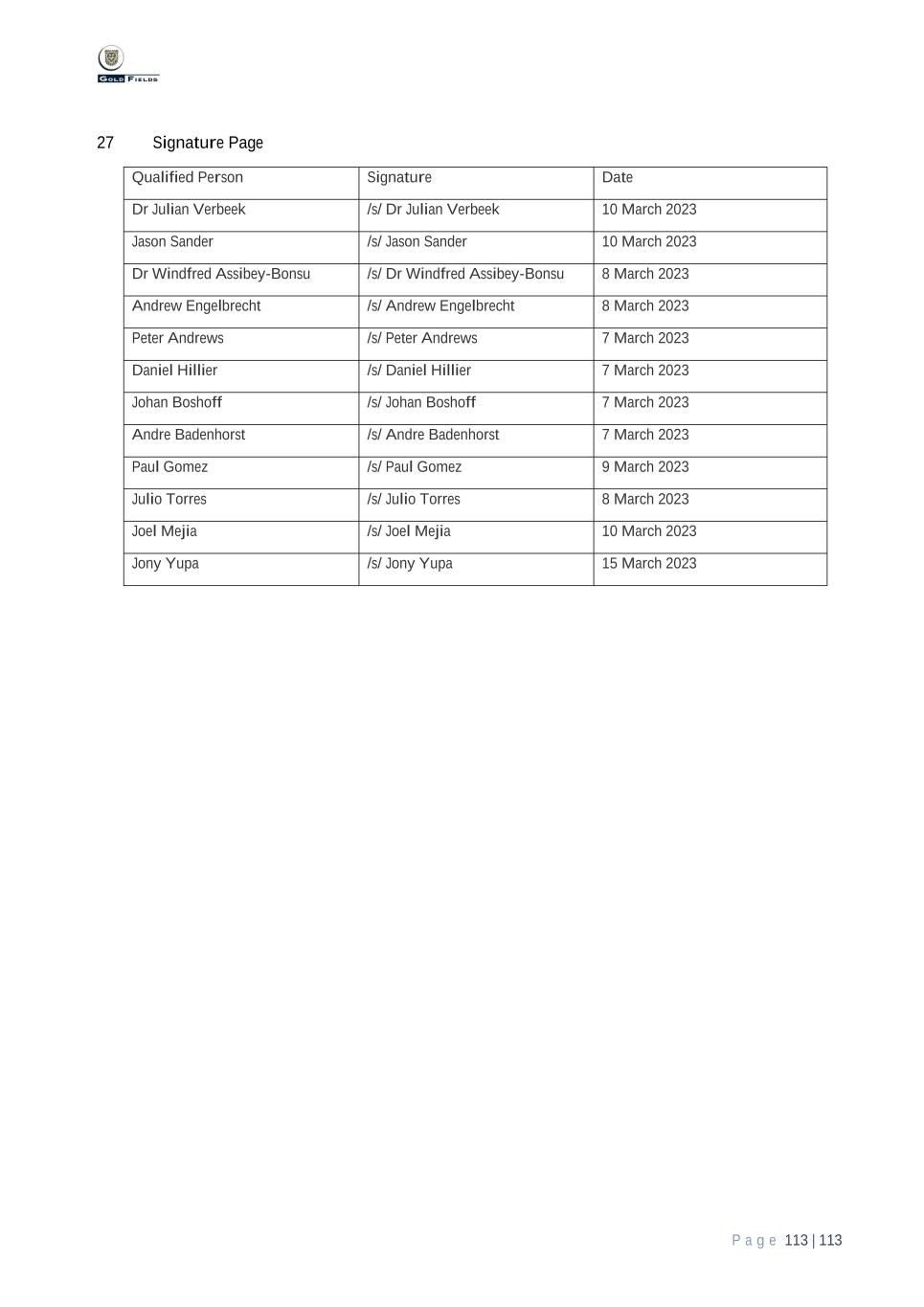
P a g e 113 | 113 27 Signature Page Qualified Person Signature Date Dr Julian Verbeek /s/ Dr Julian Verbeek 10 March 2023 Jason Sander /s/ Jason Sander 10 March 2023 Dr Windfred Assibey-Bonsu /s/ Dr Windfred Assibey-Bonsu 8 March 2023 Andrew Engelbrecht /s/ Andrew Engelbrecht 8 March 2023 Peter Andrews /s/ Peter Andrews 7 March 2023 Daniel Hillier /s/ Daniel Hillier 7 March 2023 Johan Boshoff /s/ Johan Boshoff 7 March 2023 Andre Badenhorst /s/ Andre Badenhorst 7 March 2023 Paul Gomez /s/ Paul Gomez 9 March 2023 Julio Torres /s/ Julio Torres 8 March 2023 Joel Mejia /s/ Joel Mejia 10 March 2023 Jony Yupa /s/ Jony Yupa 15 March 2023